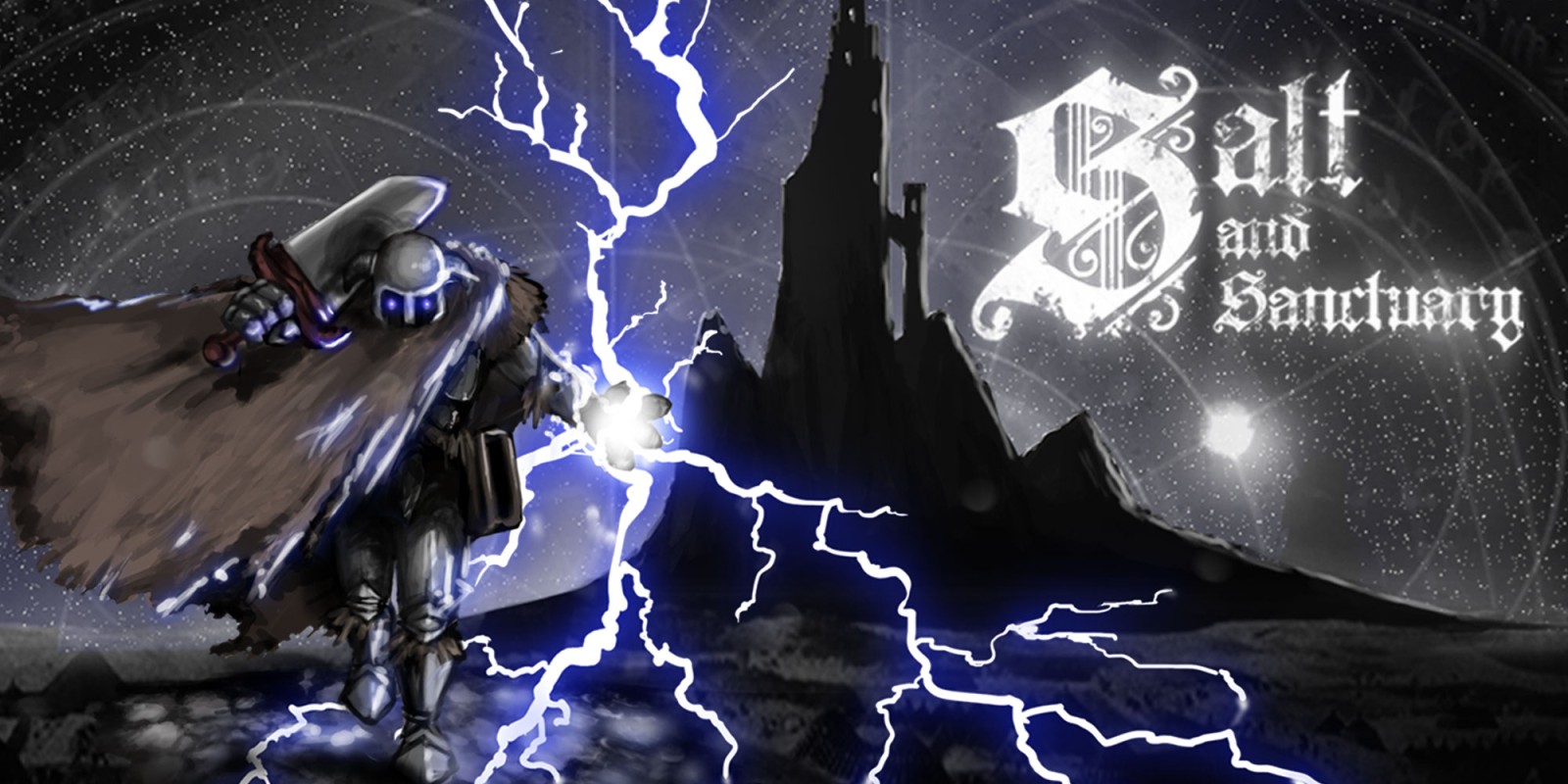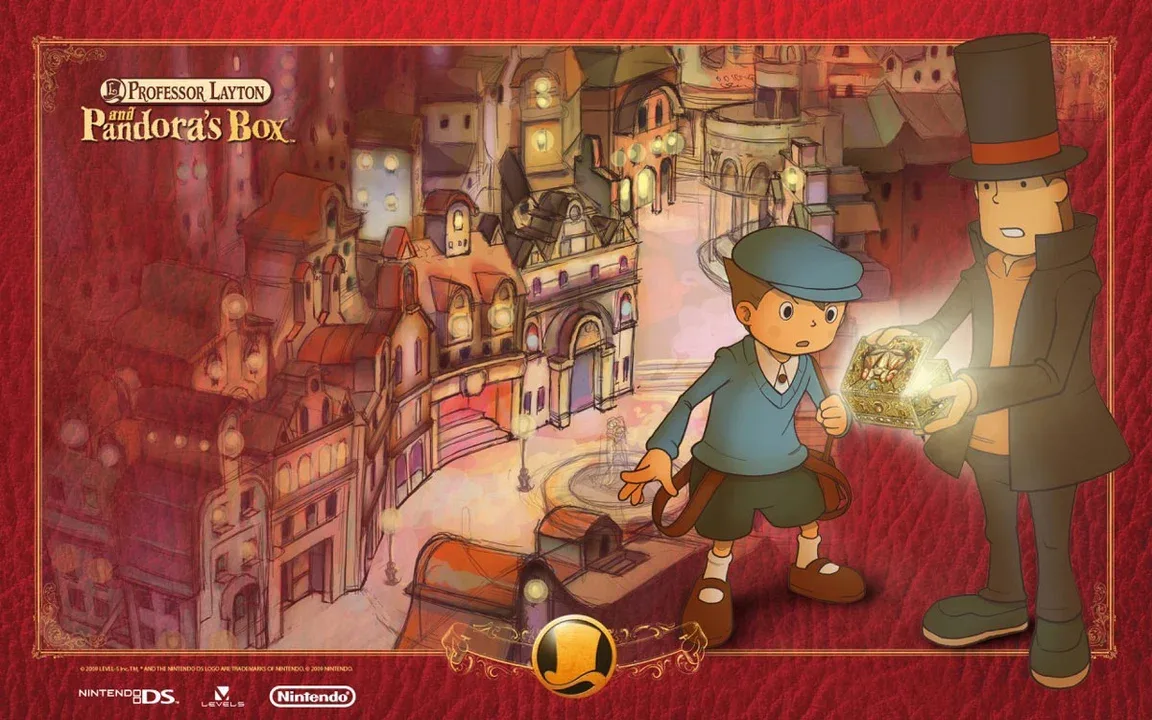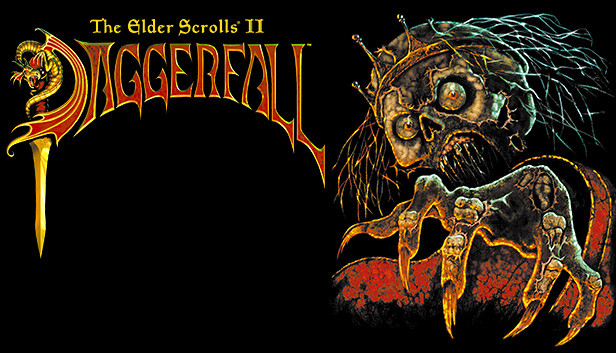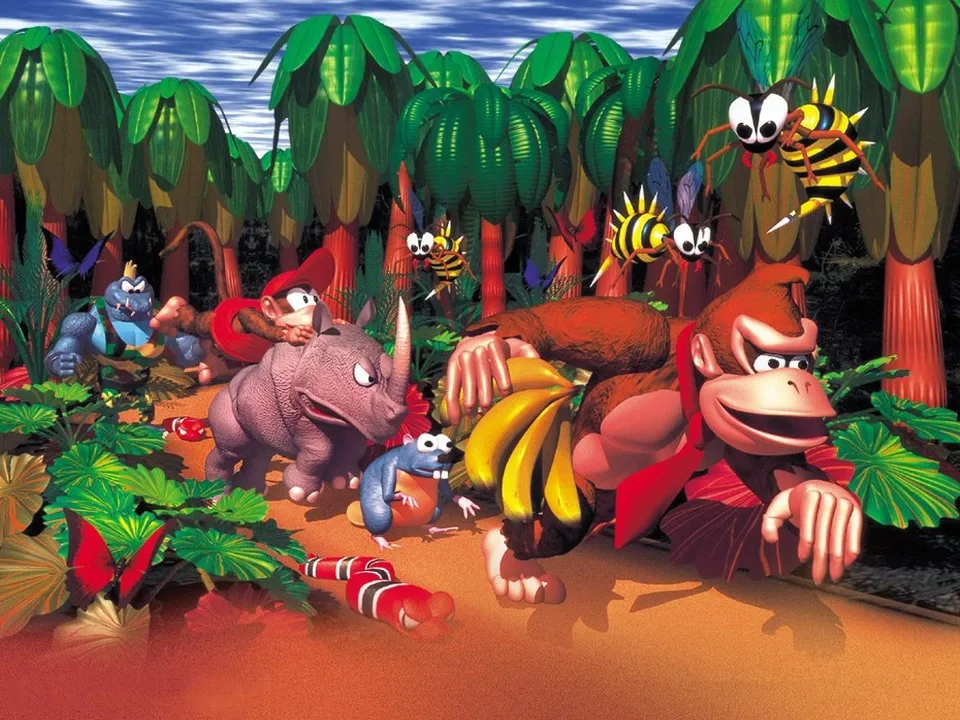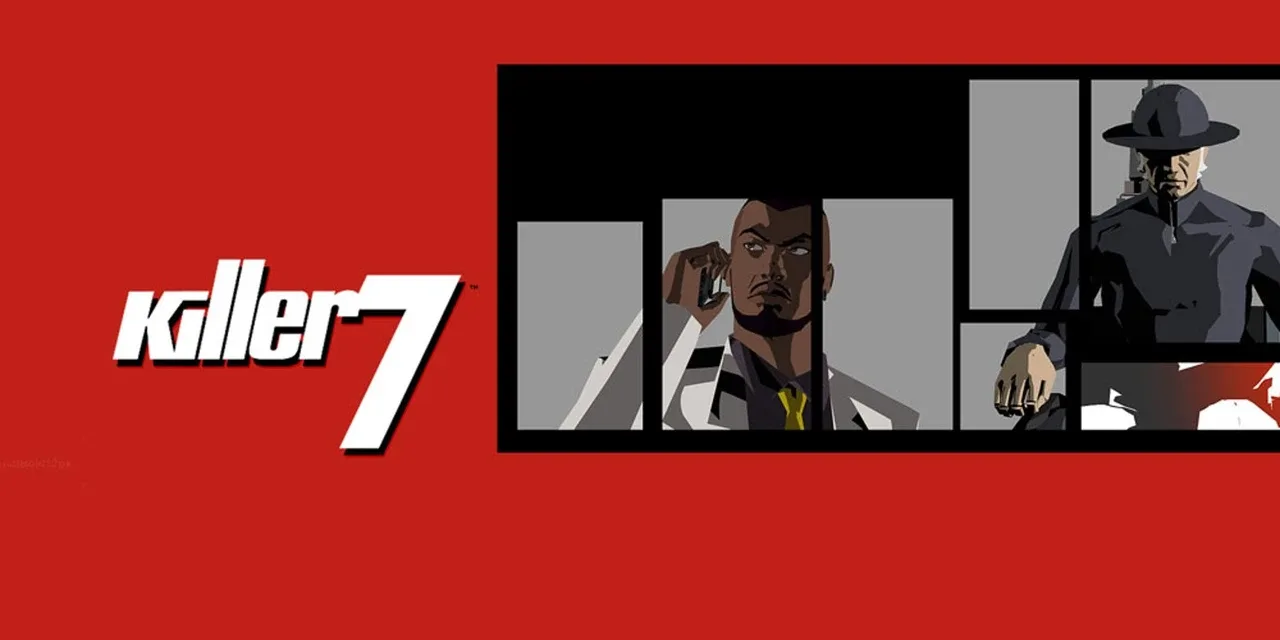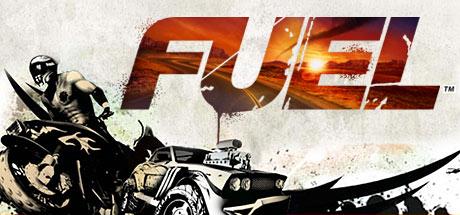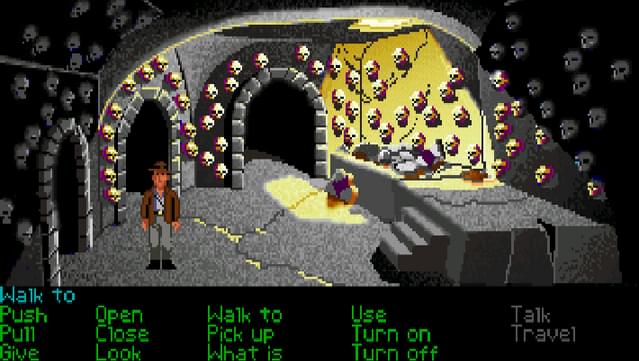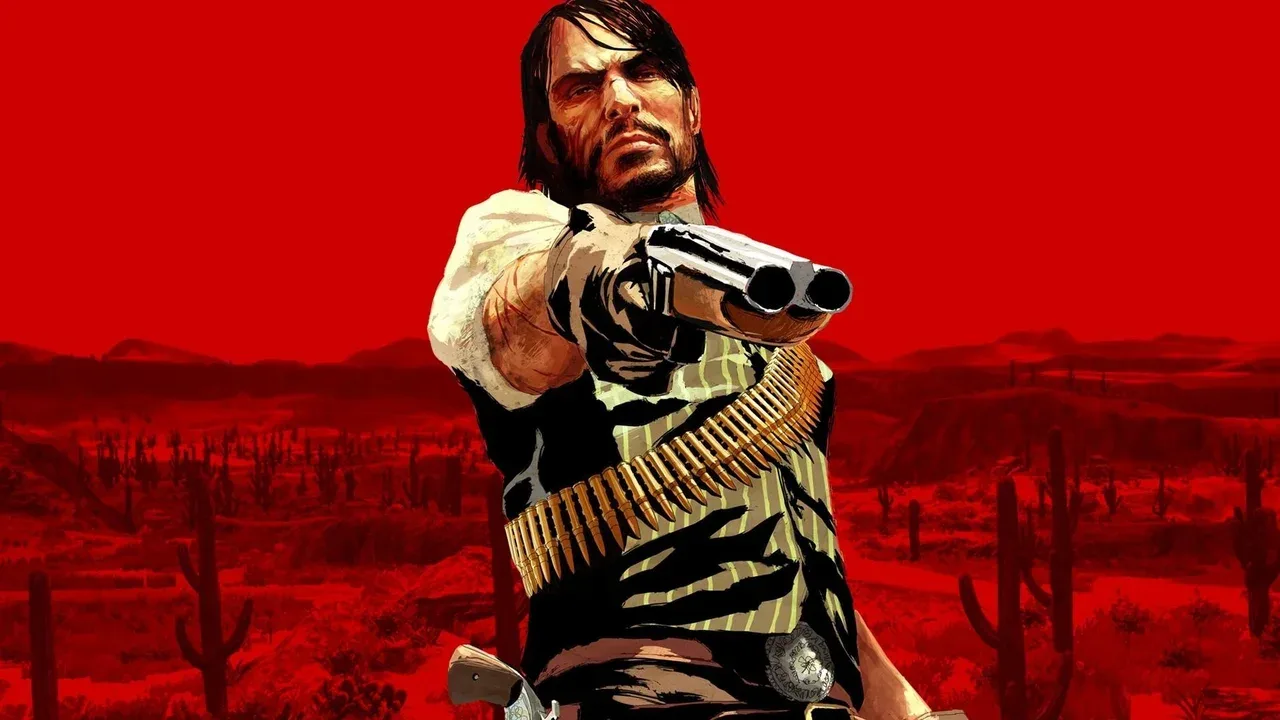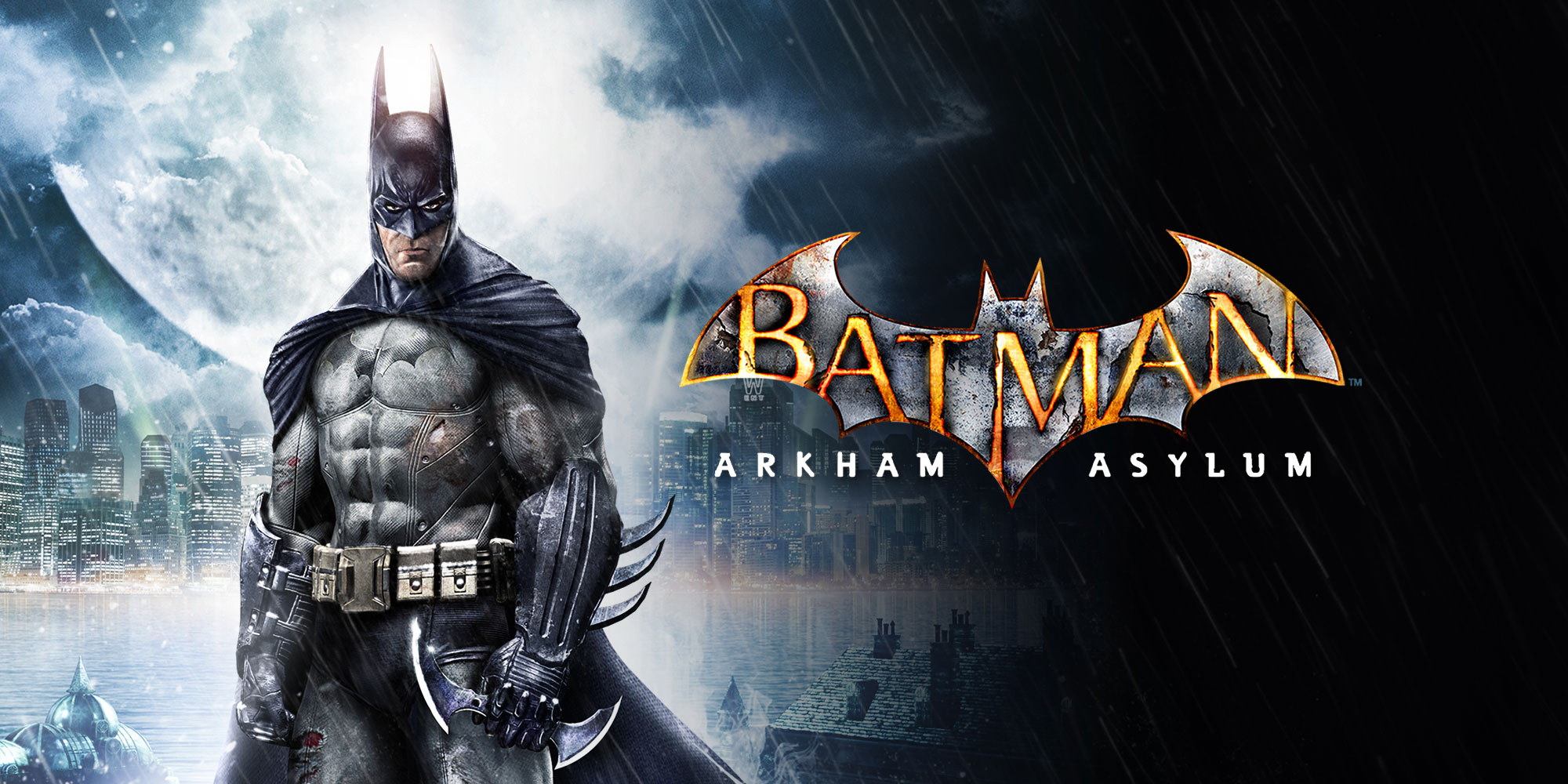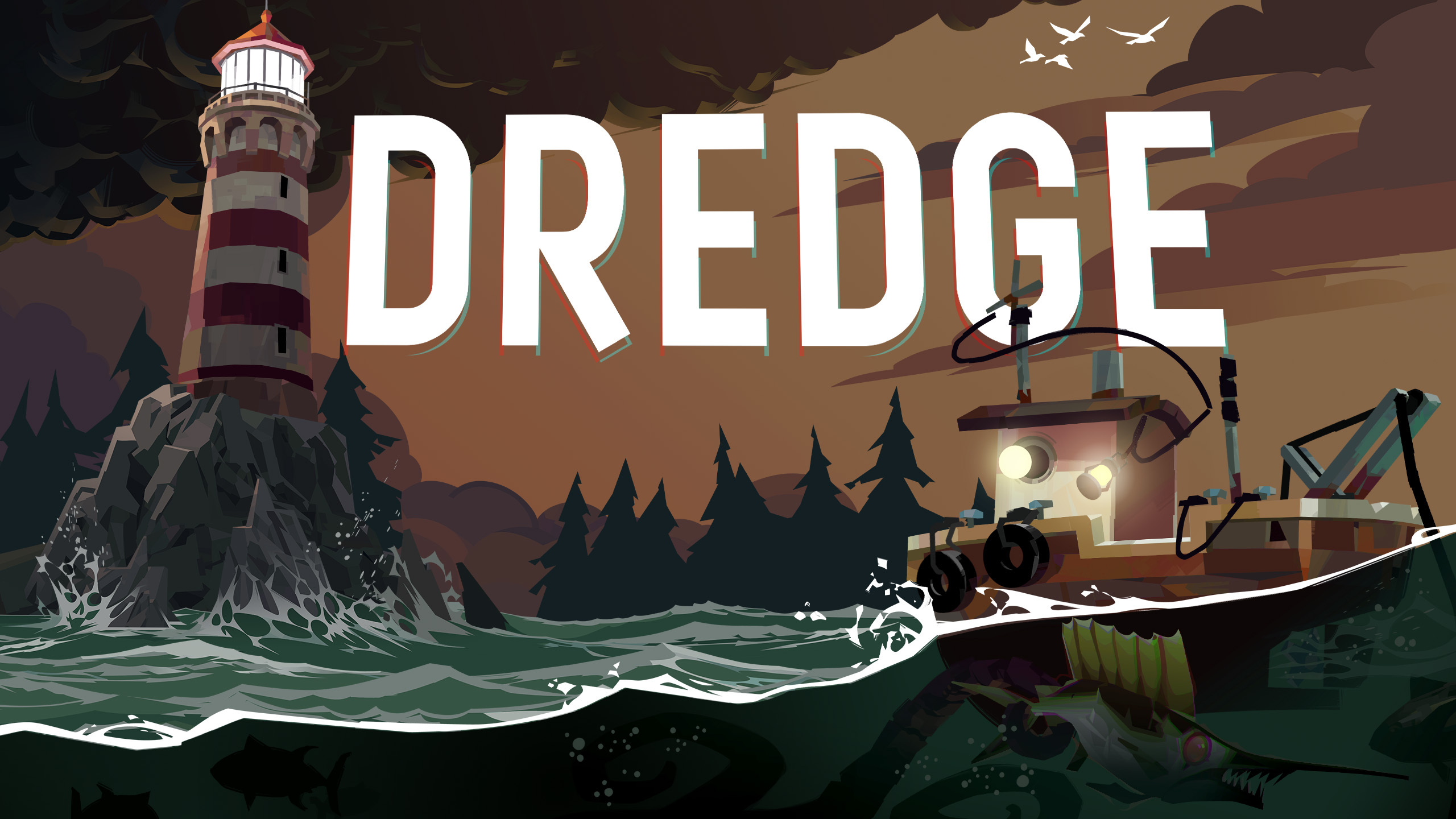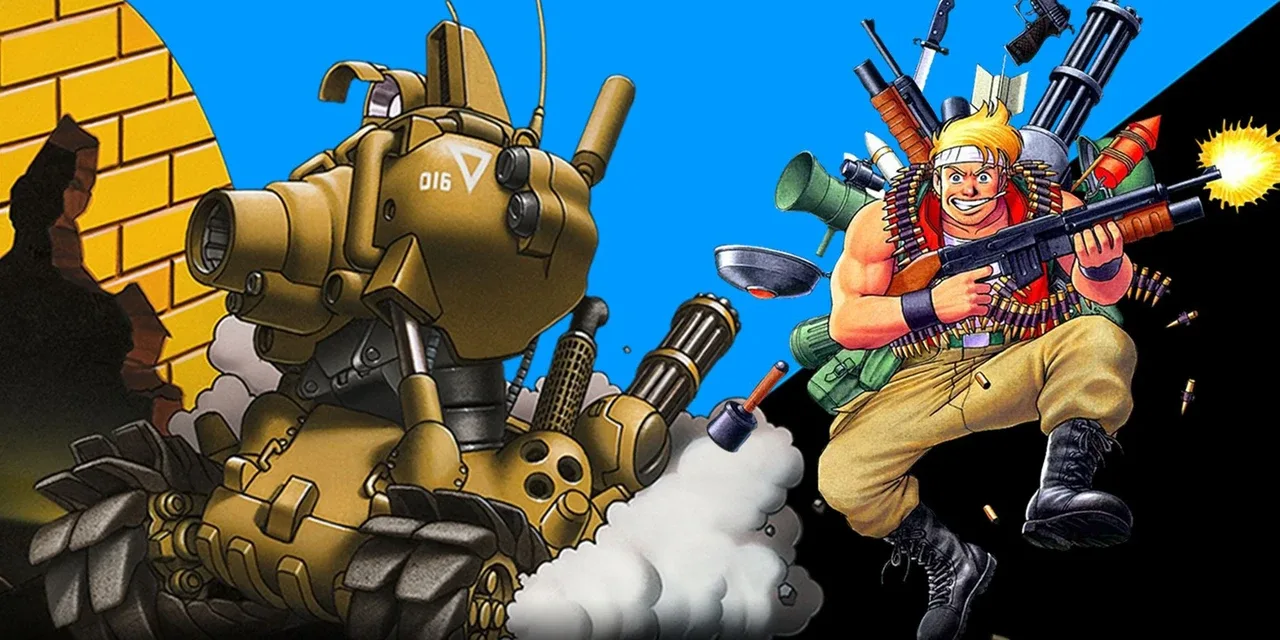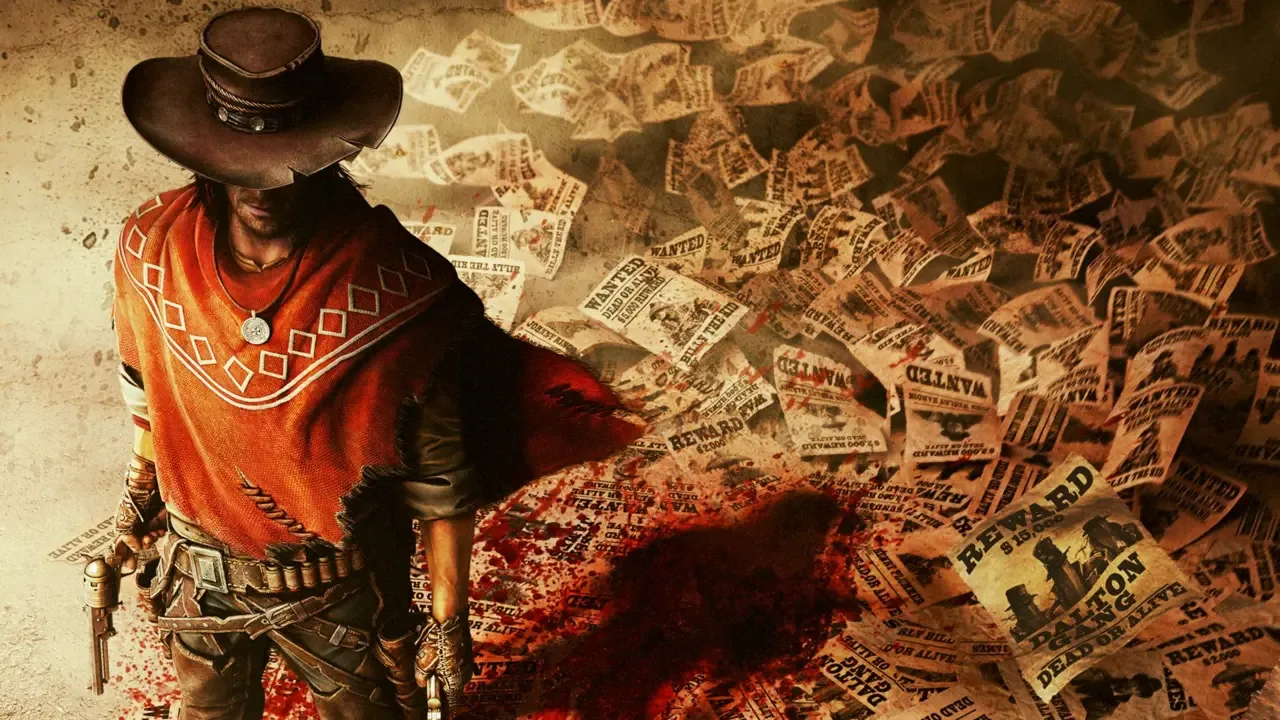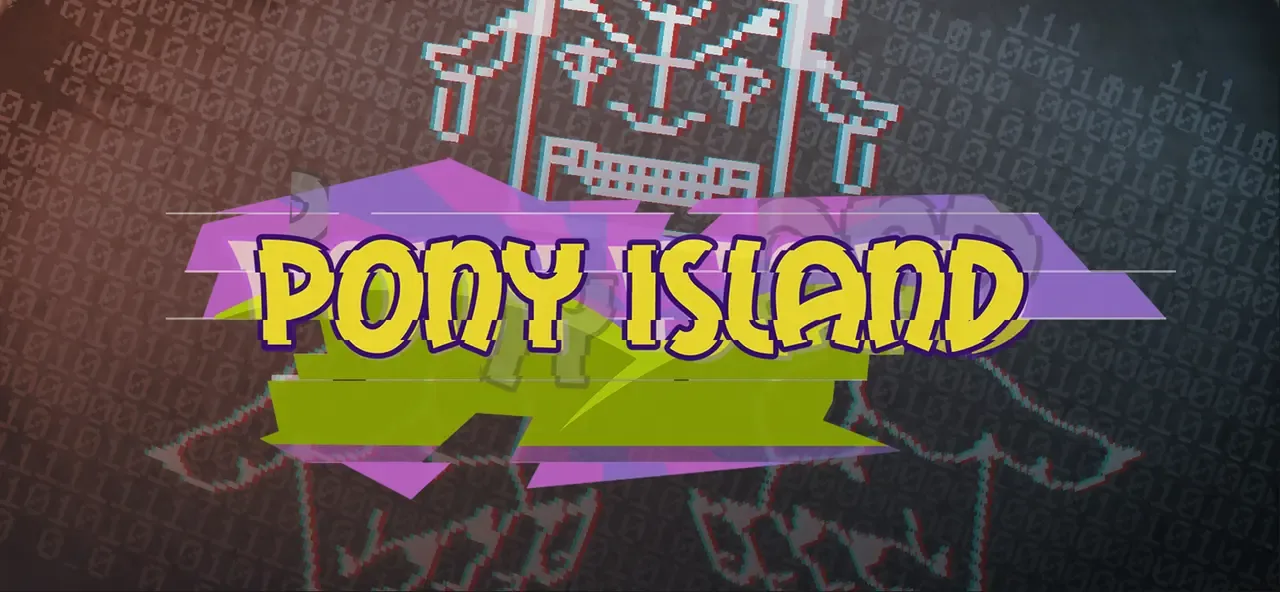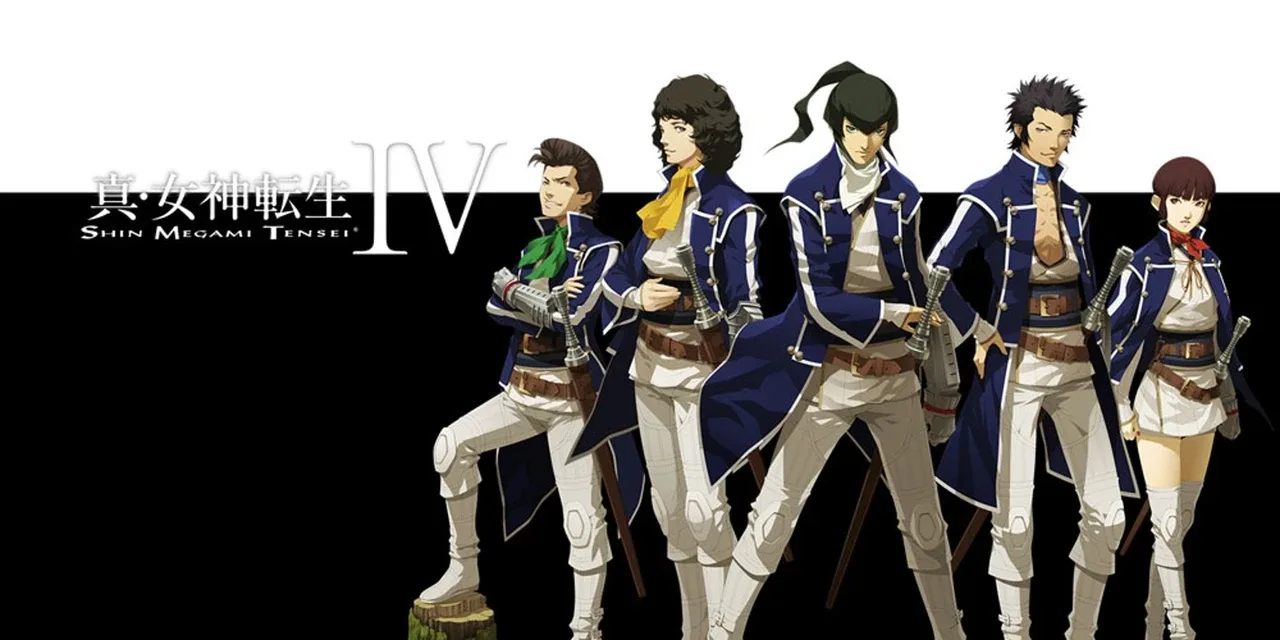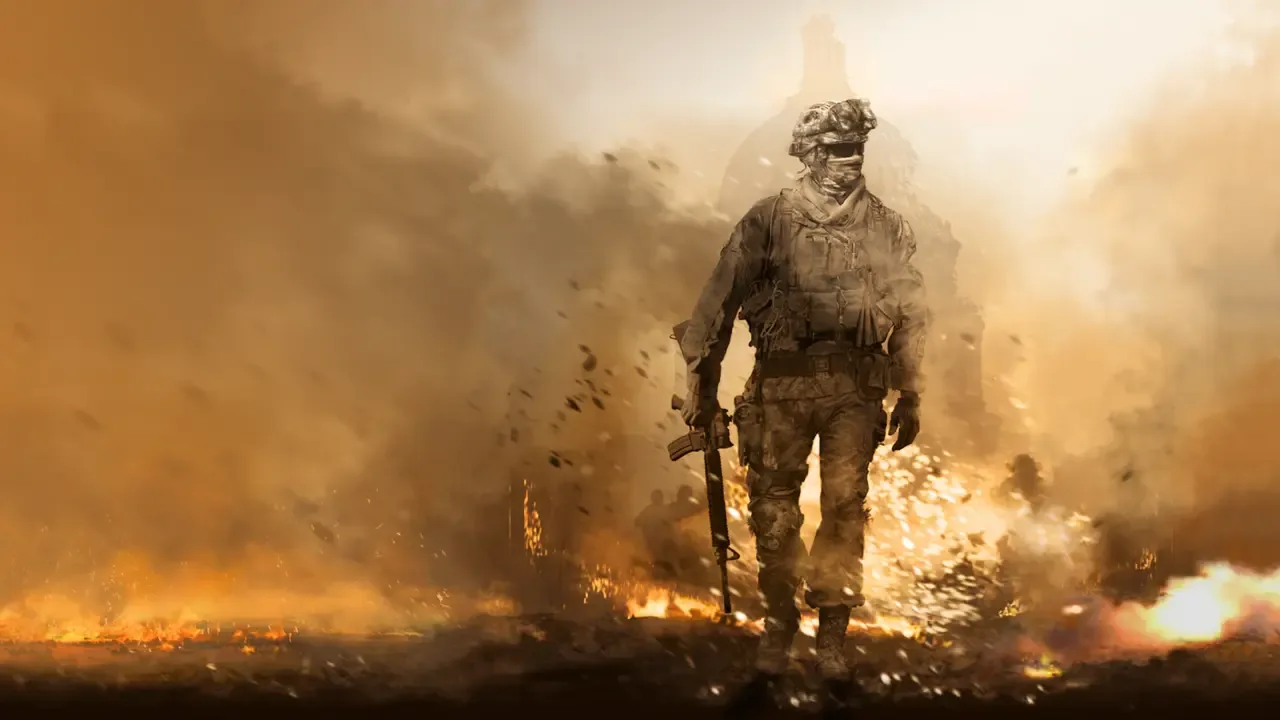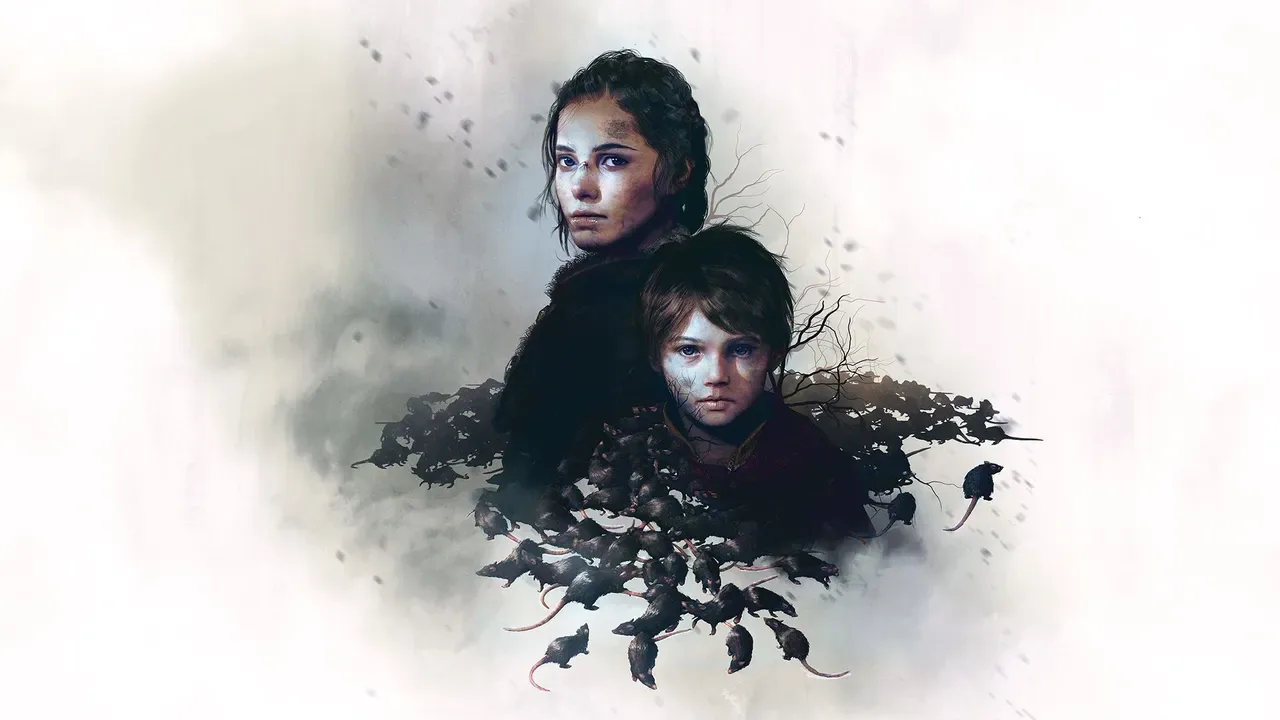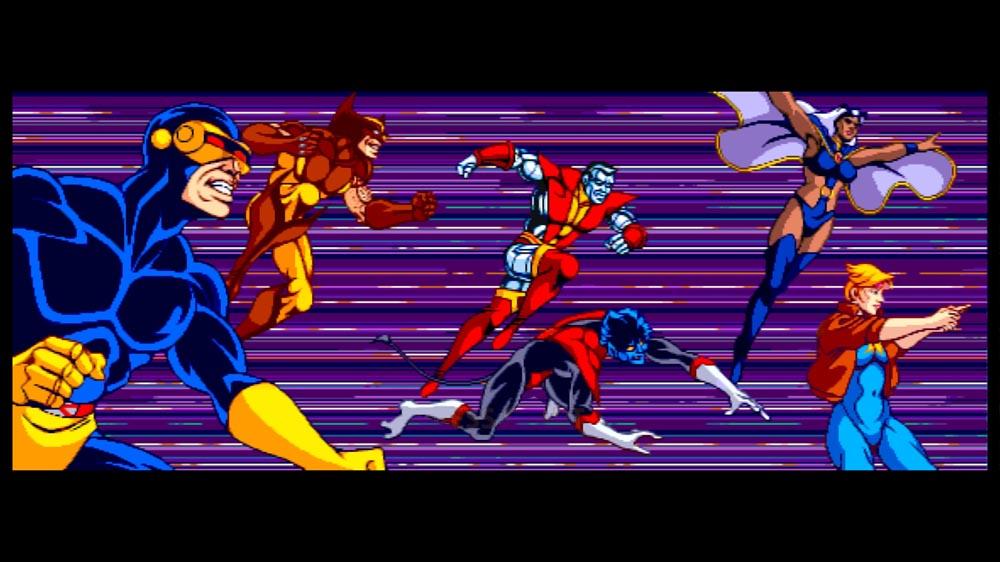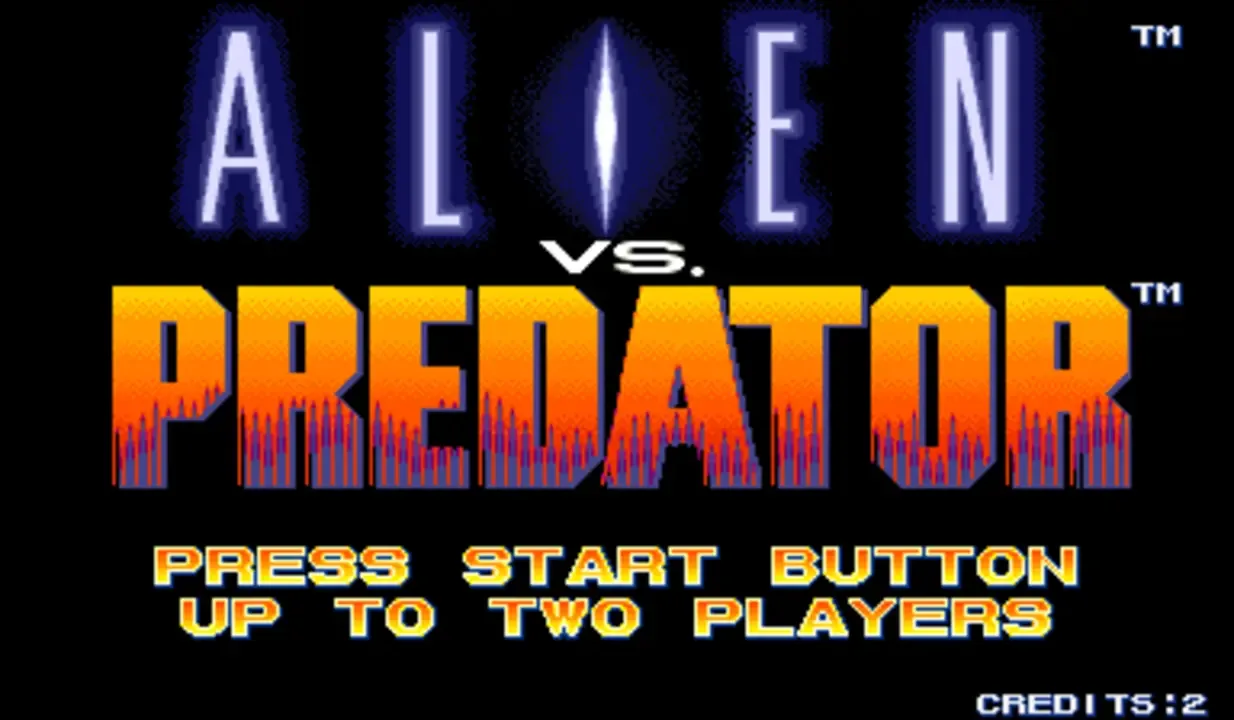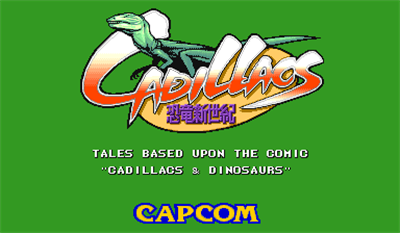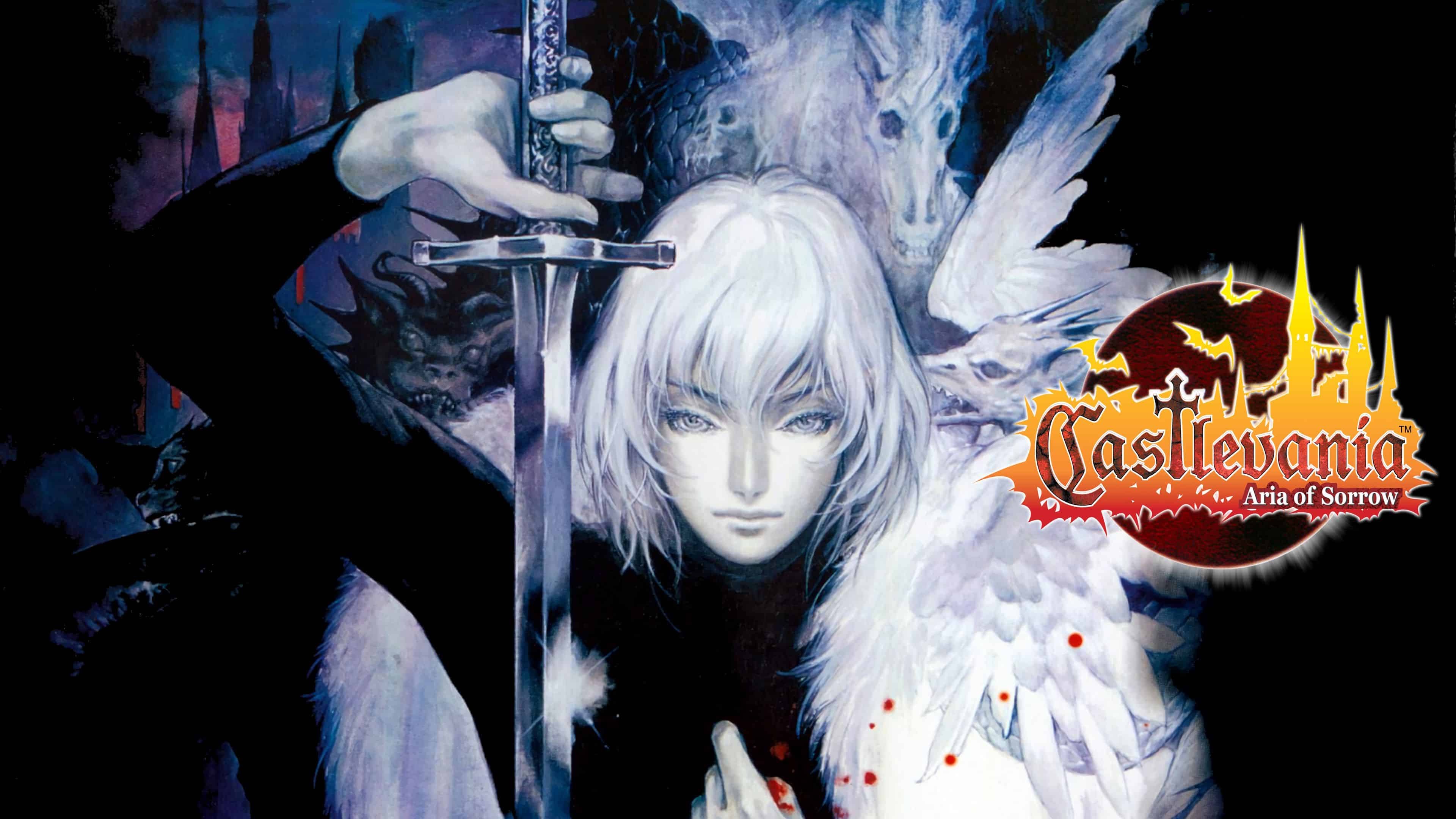4 Yrs✓#
f_n_c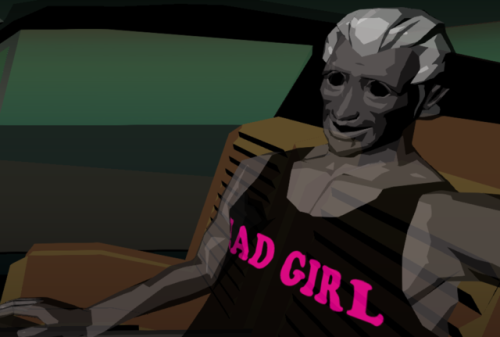
4 Yrs✓#
UPDATE #9
Hello everyone! After some well deserved vacation I'm back in the flat and hot Lombardy, but at least I have some games to play.
STORY AND PRESENTATION
I admit that I tried to play Salt and Sanctuary (SaS from now on) at least twice, but I stopped around the first boss. The game wasn't gripping enough, sadly. But third's time the charm, and this last attempt was completely different.
SaS is a 2D soulslike game with some platforming elements. In its mechanics, it follows Dark Souls closely, almost like a carbon copy. After the mandatory character creation where you select an appearance and a class, you are tasked with defending a princess traveling towards a nearby realm by ship to marry a noble and forge an alliance. The ship is attacked by an eldritch horror almost impossible to beat, and your character is shipwrecked on a strange island. From now on, the story is told through short dialogues and environmental storytelling, while your character travels into dark and gloomy environments. The game delivers its narrative exactly like Dark Souls, so it is very difficult to grasp all the information hidden in descriptions and environmental details. I know that this approach leaves a magic aura of mystery and awe, but I would rather have known all the details behind the bosses and the environments without resorting to external sources. This is mostly a personal preference though; probably a lot of people are very happy with this stylistic choice.
Talking about the artistic design, I don't like the way human characters look in this game. They are overly stylized and clash with the rest of the game elements. On the other hand, the enemies and the environments are really well-drawn and inspired. In my opinion, the game is much more gritty than Dark Souls (1), with hanged people in a lot of areas and gory monster designs. The armor and the weapons are also very inspired, and it is always fun to find new sets. The music is great and not very invasive, even if there are only a few tracks in the game.
GAMEPLAY AND TECHNICAL ASPECTS
The gameplay is just 2D Dark Souls; there's not a lot to say about the gameplay. Bonfires, limited healing, covenants, statistics, weapon scaling, encumberance, miracles, magic. The game differentiates in some minor aspects, but the feeling to play a clone is strong and constant. The basic gameplay formula works though, so I can't complain. You have a nice choice of armors (light and heavy), weapons, shields, and magic powers. Different playstiles would change drastically the feel of the game, so the variety is just on point.
The biggest difference is represented by the advancement of the character. At every level up, you gain a point to spend in an expansive skill tree that grants you both statistic increases and the ability to use stronger weapons and armor effectively. Compared to Dark Souls, it constrains the growth of the character by linking the upgrades to a defined path, so it is more difficult to screw up and create a bad build. I kind of like this approach; it visualizes your progress in a nice way and is well-presented.
SaS is a challenging game, but not too difficult. If you make a good build, the enemies will be a joke, and only some later bosses will require a good knowledge of all the game systems. I would have liked more challenge, but I used a very strong build, so probably the game is more difficult with other weapons. The small platform sections can be brutal though, and in the optional areas, it can become almost frustrating.
FINAL CONSIDERATIONS
I really liked Dark Souls 1, so I liked also SaS. It clones the formula, introducing an interesting world and some new mechanics. The artistic department is good, and the game plays well with a controller. Playing with a keyboard is doable, but much more difficult. Sadly, this game has some glaring balancing issues. The developers tried to fix them with the enhanced mode, but the problems remained. Heavy armor is almost useless; high-level armor is scarce and almost useless since it weighs too much. Strength-based weapons are satisfying but too powerful, while other weapons feel too weak. With a little more balancing, it could have been a perfect game, but it is also a phenomenal game in this state.
A little final rant on Epic Games. This is the first game that I played fully through the Epic platform, since I obtained it for free. Almost every time I wanted to play, my account was disconnected from the Windows app, and I needed to do the login process from scratch. This is a minor nuisance, but in a world where steam is a well-oiled machine, you don't have much margin for error. Compared to Steam, the experience was awful. I will never buy something from the Epic Store for sure. At least they give away free games, but they are the only thing that compel me to use their horrible launcher.
MY BUILD
If anyone wants to play this game but hasn't any idea on the build to play, I can suggest mine. It is very effective and fun, fitting a new player like me like a glove.
I used Greathammers and Greatswords, fully developing both their upgrade paths. Together, they can cover both slash and strike damage, allowing them to always exploit specific enemy weaknesses. I used mainly greatswords though; they were a little bit stronger, and it was easier to find the material to transmute them into high-level weapons. Both weapons were used always two-handed, so I could stop the Strength development to 35.
I choose to fully develop the Light Armor path instead of the logical Heavy Armor. The game is rather easy, and poising or tanking damage was not very fun, so I switched almost immediately to the Light Armor. Both the weapons of the build are very heavy, so without very light armor, you won't be able to have a usable dodge.
Following these three paths to the end (Sword, Greathammer/Greataxes, and Armor) will leave you with more than 35 Strength, and a decent Willpower and Endurance. To allow fast rolling, you should invest additional level-ups in leveling the Endurance, but adding some points also to Willpower is not a bad idea. You can refund all the Dexterity skills and also some strength nodes to lower your strength to the 35 softcap.
I used the Beggar Light Armor set almost all the game, upgrading it a lot. Towards the end of the game, it allowed me to fast roll with the Greatsword, which is something remarkable. For specific bosses with strong elemental attacks, I used a mismatch of Light Armor to maximize the specific element defense, even if it sacrificed some physical defense. For the transmutation path, I went Kurekimoa -> Jaws of Death -> Scharfrichter for the Greatswords, while for the Greathammers I used the Warhammer -> Obsidian Pillar -> Trinity Scepter. I mainly attached Mossy Charms to both weapons, which were switched to elemental damage charms for some bosses. I used different ring sets depending on the boss.
-------------------------------------------------------------------------------------------------------------------------------------------------------------------------------------------------------------------------
I decided that the poor Layton was rotting in my backlog for too long, so I esclusively played that for some time to finish it. I completed the main story, but the game is fun, so probably I will finish almost all the puzzles.
I also made some little progress with Daggerfall. I had some adventures in the Wrothgarian Mountains, and I have found even some pieces of Dwarven equipment. The game is fun for now, but the worst sprawling dungeons are still ahead. Running around in snowclad cities is very atmospheric, and the game has a particular, unique charm.
Hello everyone! After some well deserved vacation I'm back in the flat and hot Lombardy, but at least I have some games to play.
Salt and Sanctuary - PC (Epic Store free game)
SCORE: 9/10
STORY AND PRESENTATION
I admit that I tried to play Salt and Sanctuary (SaS from now on) at least twice, but I stopped around the first boss. The game wasn't gripping enough, sadly. But third's time the charm, and this last attempt was completely different.
SaS is a 2D soulslike game with some platforming elements. In its mechanics, it follows Dark Souls closely, almost like a carbon copy. After the mandatory character creation where you select an appearance and a class, you are tasked with defending a princess traveling towards a nearby realm by ship to marry a noble and forge an alliance. The ship is attacked by an eldritch horror almost impossible to beat, and your character is shipwrecked on a strange island. From now on, the story is told through short dialogues and environmental storytelling, while your character travels into dark and gloomy environments. The game delivers its narrative exactly like Dark Souls, so it is very difficult to grasp all the information hidden in descriptions and environmental details. I know that this approach leaves a magic aura of mystery and awe, but I would rather have known all the details behind the bosses and the environments without resorting to external sources. This is mostly a personal preference though; probably a lot of people are very happy with this stylistic choice.
Talking about the artistic design, I don't like the way human characters look in this game. They are overly stylized and clash with the rest of the game elements. On the other hand, the enemies and the environments are really well-drawn and inspired. In my opinion, the game is much more gritty than Dark Souls (1), with hanged people in a lot of areas and gory monster designs. The armor and the weapons are also very inspired, and it is always fun to find new sets. The music is great and not very invasive, even if there are only a few tracks in the game.
GAMEPLAY AND TECHNICAL ASPECTS
The gameplay is just 2D Dark Souls; there's not a lot to say about the gameplay. Bonfires, limited healing, covenants, statistics, weapon scaling, encumberance, miracles, magic. The game differentiates in some minor aspects, but the feeling to play a clone is strong and constant. The basic gameplay formula works though, so I can't complain. You have a nice choice of armors (light and heavy), weapons, shields, and magic powers. Different playstiles would change drastically the feel of the game, so the variety is just on point.
The biggest difference is represented by the advancement of the character. At every level up, you gain a point to spend in an expansive skill tree that grants you both statistic increases and the ability to use stronger weapons and armor effectively. Compared to Dark Souls, it constrains the growth of the character by linking the upgrades to a defined path, so it is more difficult to screw up and create a bad build. I kind of like this approach; it visualizes your progress in a nice way and is well-presented.
SaS is a challenging game, but not too difficult. If you make a good build, the enemies will be a joke, and only some later bosses will require a good knowledge of all the game systems. I would have liked more challenge, but I used a very strong build, so probably the game is more difficult with other weapons. The small platform sections can be brutal though, and in the optional areas, it can become almost frustrating.
FINAL CONSIDERATIONS
I really liked Dark Souls 1, so I liked also SaS. It clones the formula, introducing an interesting world and some new mechanics. The artistic department is good, and the game plays well with a controller. Playing with a keyboard is doable, but much more difficult. Sadly, this game has some glaring balancing issues. The developers tried to fix them with the enhanced mode, but the problems remained. Heavy armor is almost useless; high-level armor is scarce and almost useless since it weighs too much. Strength-based weapons are satisfying but too powerful, while other weapons feel too weak. With a little more balancing, it could have been a perfect game, but it is also a phenomenal game in this state.
A little final rant on Epic Games. This is the first game that I played fully through the Epic platform, since I obtained it for free. Almost every time I wanted to play, my account was disconnected from the Windows app, and I needed to do the login process from scratch. This is a minor nuisance, but in a world where steam is a well-oiled machine, you don't have much margin for error. Compared to Steam, the experience was awful. I will never buy something from the Epic Store for sure. At least they give away free games, but they are the only thing that compel me to use their horrible launcher.
MY BUILD
If anyone wants to play this game but hasn't any idea on the build to play, I can suggest mine. It is very effective and fun, fitting a new player like me like a glove.
I used Greathammers and Greatswords, fully developing both their upgrade paths. Together, they can cover both slash and strike damage, allowing them to always exploit specific enemy weaknesses. I used mainly greatswords though; they were a little bit stronger, and it was easier to find the material to transmute them into high-level weapons. Both weapons were used always two-handed, so I could stop the Strength development to 35.
I choose to fully develop the Light Armor path instead of the logical Heavy Armor. The game is rather easy, and poising or tanking damage was not very fun, so I switched almost immediately to the Light Armor. Both the weapons of the build are very heavy, so without very light armor, you won't be able to have a usable dodge.
Following these three paths to the end (Sword, Greathammer/Greataxes, and Armor) will leave you with more than 35 Strength, and a decent Willpower and Endurance. To allow fast rolling, you should invest additional level-ups in leveling the Endurance, but adding some points also to Willpower is not a bad idea. You can refund all the Dexterity skills and also some strength nodes to lower your strength to the 35 softcap.
I used the Beggar Light Armor set almost all the game, upgrading it a lot. Towards the end of the game, it allowed me to fast roll with the Greatsword, which is something remarkable. For specific bosses with strong elemental attacks, I used a mismatch of Light Armor to maximize the specific element defense, even if it sacrificed some physical defense. For the transmutation path, I went Kurekimoa -> Jaws of Death -> Scharfrichter for the Greatswords, while for the Greathammers I used the Warhammer -> Obsidian Pillar -> Trinity Scepter. I mainly attached Mossy Charms to both weapons, which were switched to elemental damage charms for some bosses. I used different ring sets depending on the boss.
-------------------------------------------------------------------------------------------------------------------------------------------------------------------------------------------------------------------------
CURRENTLY PLAYING
- Professor Layton and the Diabolical box - Nintendo 3DS (DS Mode)
- The Elder Scrolls 2: Daggerfall - PC
I decided that the poor Layton was rotting in my backlog for too long, so I esclusively played that for some time to finish it. I completed the main story, but the game is fun, so probably I will finish almost all the puzzles.
I also made some little progress with Daggerfall. I had some adventures in the Wrothgarian Mountains, and I have found even some pieces of Dwarven equipment. The game is fun for now, but the worst sprawling dungeons are still ahead. Running around in snowclad cities is very atmospheric, and the game has a particular, unique charm.
4 Yrs✓#
f_n_c
4 Yrs✓#
UPDATE #10
THE GAME
I think that everyone on this site has at least heard of Layton and its games, so I won't introduce the series as a whole. I played the first game some years ago, and I quite enjoyed it; it was a nice refreshing experience compared to the things that I normally play. I know that is not optimal, but I played it on my phone in short bursts, something that has fragmented a lot of the whole experience. I played this installation of the series on a 3DS, luckily. The experience was similar to the phone though: discontinuous play when I was bored of other games. Even if I wasn't very dedicated to this game, I never lost track of what I had to do—something remarkable sign of a well-developed game.
Let's start with the most critical point of the game: the story. It starts as a nice murder mystery and has some sections aboard a train to finally land in the mysterious town of Foolsense. The town nails the atmosphere perfectly, and its inhabitants are well characterized, being similar to the first game but with a nice twist that keeps the situation engaging. Sadly, the game crashes incredibly in its ending. It is moving and heartfelt, but the final twist was utterly nonsensical, even for the Layton standads. The ending leaves a bad aftertaste and has partly ruined my personal enjoyment of the plot. Luckily, the art style is amazing, like the first game, and the addition of more animated cutscenes is definitely welcome.
SPOILER OF THE ENDINGS OF THE FIRST TWO LAYTON GAMES
Even the end of the first game was crazy, with the whole town population being very complex animatronics. But even if this twist was overly exaggerated, it didn't destroy totally the continuity of the story. Being Foolsense and its people all in the mind of Layton and the other main characters, all the sections of the game that take place in the city have zero sense.
The puzzles are definitely an improvement compared to the first game. They are very creative and sometimes disguise well what is a simple mathematical problem at its core, with answers that rarely are far-fetched or not logical. The integration of the puzzles with the story is also more organic; the game clearly shows that the developers have made a lot of experience with the first game and improved in almost all fields. This game also adds some long-term puzzles that can be solved only by gaining the right elements by... completing other normal puzzles. This is an incentive to play more simple puzzles outside the main story, and they are mostly interesting and well-developed. My favorite one was the tea-time: Layton gains tea ingredients by solving puzzles, and they can be used together to brew some teas by following the suggestions of the people of Foolsense. The dialogue of this macro puzzle is especially fun, and it is heartwarming to help everyone by just brewing a cup of tea out of nowhere.
FINAL CONSIDERATIONS
The Diabolical Box is more advanced mechanically compared with the previous episode, but has a story that doesn't quite feel right. It's not a perfect game and represents two steps forward but one backward compared to the Curious Village, and I feel that the developers will have nailed down the formula with the third game. I suggest everyone give this series a shot; it can be a rather fun diversive compared to other more mainstream types of games.
-------------------------------------------------------------------------------------------------------------------------------------------------------------------------------------------------------------------------
I joined the temple of Akatosh and the Knights of the Rose with my Redonarn Dunmer Daggerfall character. I'm trying to roleplay a bit, and I'm having quite some fun. Joining Wayrest was a no-brainer as a Dark Elf, but I'm not fully convinced by my choice. Knowing Helseth and Barenziah from Morrowind, probably I will be backstabbed soon.
I started also Donkey Kong country completely blind. It was on my backlog for quite some time, but I never pulled the trigger. I went in expecting a Mario-like challenge, but it's much more difficult. On the other hand, it looks and sounds incredible for a SNES game, and I'm always eager to play it.
Professor Layton and the Diabolical Box - DS
SCORE: 8.5/10
THE GAME
I think that everyone on this site has at least heard of Layton and its games, so I won't introduce the series as a whole. I played the first game some years ago, and I quite enjoyed it; it was a nice refreshing experience compared to the things that I normally play. I know that is not optimal, but I played it on my phone in short bursts, something that has fragmented a lot of the whole experience. I played this installation of the series on a 3DS, luckily. The experience was similar to the phone though: discontinuous play when I was bored of other games. Even if I wasn't very dedicated to this game, I never lost track of what I had to do—something remarkable sign of a well-developed game.
Let's start with the most critical point of the game: the story. It starts as a nice murder mystery and has some sections aboard a train to finally land in the mysterious town of Foolsense. The town nails the atmosphere perfectly, and its inhabitants are well characterized, being similar to the first game but with a nice twist that keeps the situation engaging. Sadly, the game crashes incredibly in its ending. It is moving and heartfelt, but the final twist was utterly nonsensical, even for the Layton standads. The ending leaves a bad aftertaste and has partly ruined my personal enjoyment of the plot. Luckily, the art style is amazing, like the first game, and the addition of more animated cutscenes is definitely welcome.
SPOILER OF THE ENDINGS OF THE FIRST TWO LAYTON GAMES
Even the end of the first game was crazy, with the whole town population being very complex animatronics. But even if this twist was overly exaggerated, it didn't destroy totally the continuity of the story. Being Foolsense and its people all in the mind of Layton and the other main characters, all the sections of the game that take place in the city have zero sense.
The puzzles are definitely an improvement compared to the first game. They are very creative and sometimes disguise well what is a simple mathematical problem at its core, with answers that rarely are far-fetched or not logical. The integration of the puzzles with the story is also more organic; the game clearly shows that the developers have made a lot of experience with the first game and improved in almost all fields. This game also adds some long-term puzzles that can be solved only by gaining the right elements by... completing other normal puzzles. This is an incentive to play more simple puzzles outside the main story, and they are mostly interesting and well-developed. My favorite one was the tea-time: Layton gains tea ingredients by solving puzzles, and they can be used together to brew some teas by following the suggestions of the people of Foolsense. The dialogue of this macro puzzle is especially fun, and it is heartwarming to help everyone by just brewing a cup of tea out of nowhere.
FINAL CONSIDERATIONS
The Diabolical Box is more advanced mechanically compared with the previous episode, but has a story that doesn't quite feel right. It's not a perfect game and represents two steps forward but one backward compared to the Curious Village, and I feel that the developers will have nailed down the formula with the third game. I suggest everyone give this series a shot; it can be a rather fun diversive compared to other more mainstream types of games.
-------------------------------------------------------------------------------------------------------------------------------------------------------------------------------------------------------------------------
CURRENTLY PLAYING
- Donkey Kong Country - Emulated
- The Elder Scrolls 2: Daggerfall - PC
I joined the temple of Akatosh and the Knights of the Rose with my Redonarn Dunmer Daggerfall character. I'm trying to roleplay a bit, and I'm having quite some fun. Joining Wayrest was a no-brainer as a Dark Elf, but I'm not fully convinced by my choice. Knowing Helseth and Barenziah from Morrowind, probably I will be backstabbed soon.
I started also Donkey Kong country completely blind. It was on my backlog for quite some time, but I never pulled the trigger. I went in expecting a Mario-like challenge, but it's much more difficult. On the other hand, it looks and sounds incredible for a SNES game, and I'm always eager to play it.
4 Yrs✓#
f_n_c
4 Yrs✓#
UPDATE #11
I've been pretty busy lately thanks to the transition between university life and work, but I'm doing fine. Sadly, I hadn't enough time to keep the same 2-week distance between the blog posts, but I'm sure that this meaty update will make up for the slight loss.
INTRODUCTION
My first TES game was Oblivion. Shortly after finishing it, I started to get interested in the franchise and discovered Daggerfall. There was always something that piqued my attention in this title: the big snowy cities, the procedurally generated landmass, or the sprawling dungeons. Sadly, the original game is buggy and not very convenient to play on modern systems, and after some play sessions I decided to put it away. Fast forward to a year ago, I discovered the Daggerfall Unity remake, and I was blown away. The remake completely adapts the game infrastructure to modern systems, fixing bugs and adding mod support. A year after some on-off playing, I decided to commit fully to the game and play it until completion, and here we are. From now on, I'll consider only the Unity remake, since this is the version that I've actually completed, and I think that today there is no reason to play the original version.
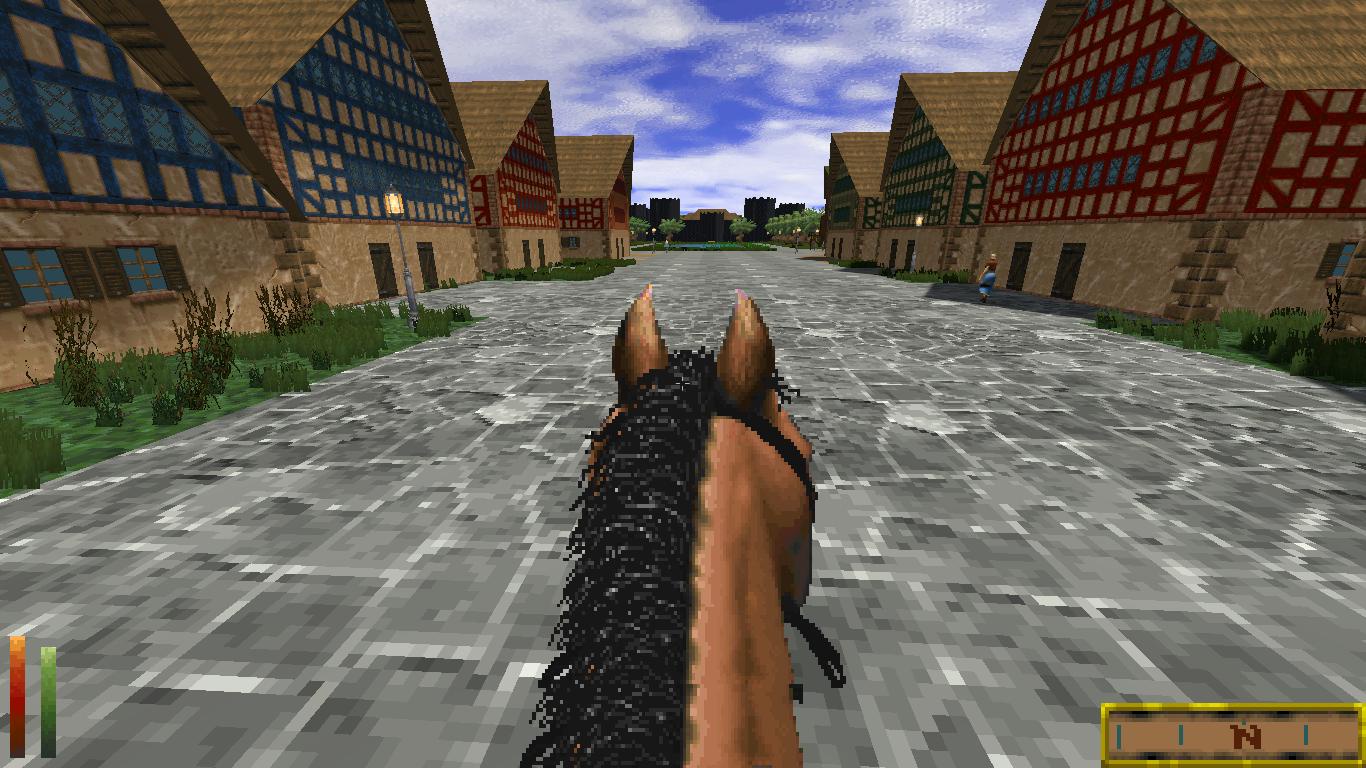
The main avenue of Daggerfall City, with its castle looming in the distance
Daggerfall is the apex of a certain RPG philosophy of expansive dungeon crawlers. It was so ambitious that a lot of unfinished content was cut in the final build, and Bethesda nearly went bankrupt after the development. Widely different from the following installments, Daggerfall is a unique beast that in a lot of aspects is also a upgrade of Arena, reusing some assets and the general gameplay concept.
STORY AND LORE
The game is set a lot of years before the beloved Skyrim, in a time when the Septim Empire was still unite but weak, and the emperor wrestled to keep it together. The player is an agent sent directly from the Emperor to the Iliac Bay region (between High Rock and Hammerfell) in order to put to rest the ghost of the king of Daggerfall, who was recently slain in a war against High Rock for the island of Betony. Once arrived, the agent found itself in a complex web of political intrigue between the six main powers of the region that comprehended the legitimate kingdoms: a mysterious lich, the king of orcs, and Mannimarco, the greatest necromancer of Tamriel.
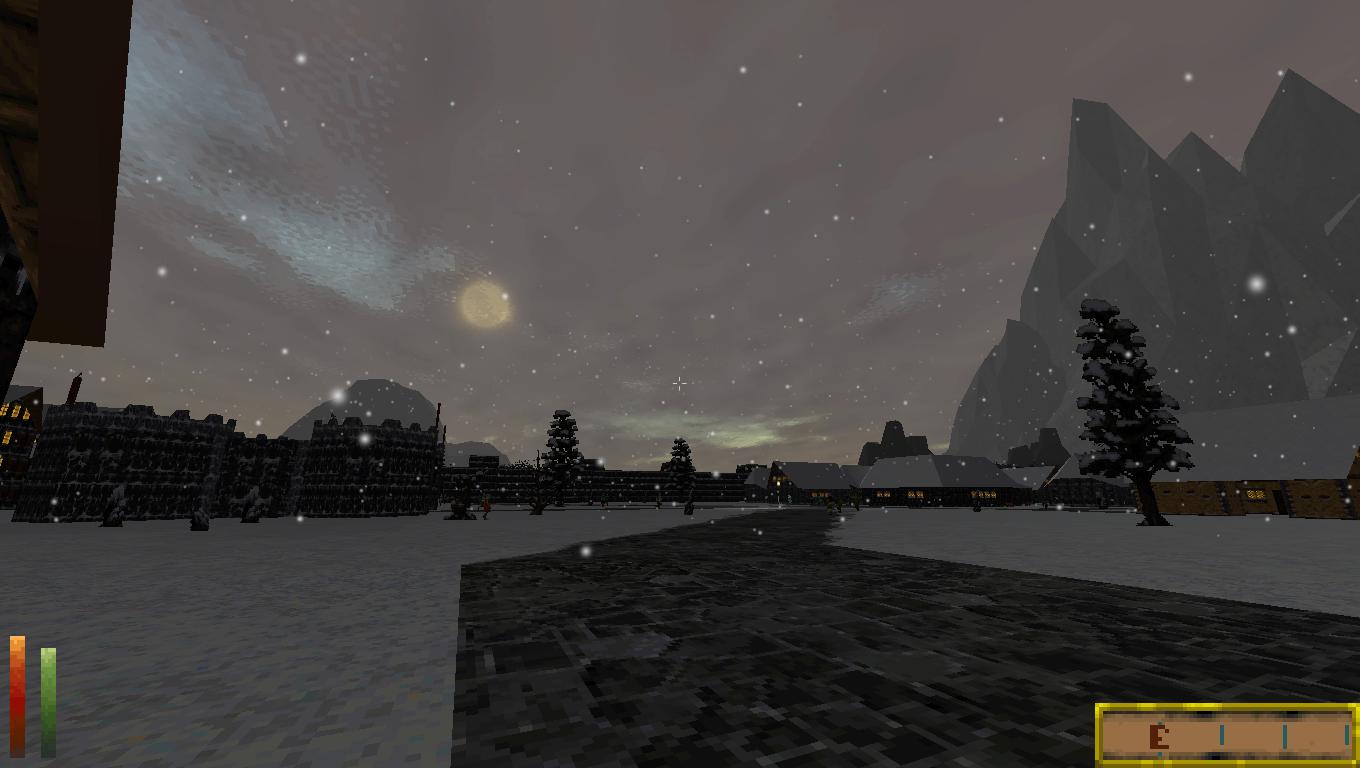
A nice small city in winter
The game plot, compared to the "seek the magical artifacts to beat the warlock usurper of the emperor" of Arena, has a very complex and more mature plot, with a lot of factions acting only for their own self-interest. Daggerfall makes the player not feel as a hero like the later games, but only as a cog in an enormous machination that could be steered in a certain direction. It's certainly a fresh perspective that feels unique in the series. On the other hand, you are treated as a sort of errand boy for the whole game, and the missions are almost all going into dungeons to make a favor to a faction leader. When this game was produced, the TES lore was still not formed, so it has a different feel compared to later games. It has a more classical fantasy vibe, with Khajiit represented as humans with tails, no playable orcs, and a less otherwordly plot.
GAMEPLAY AND TECHNOLOGY
Every element of the later games is present here: equipment based on material quality, attributes, magic, horseriding, dungeons, guilds, and even playable undead creatures. You can even buy a house or a ship, and fast travel takes a belivable amount of time that can change dynamically based on the player's choices. The world has festivities with effects on the gameplay, Daedra Lords summoning on certain days, and a reputation system that tracks an enormous amount of micro-factions. It's incredible how much content the developers managed to cram into a single game.
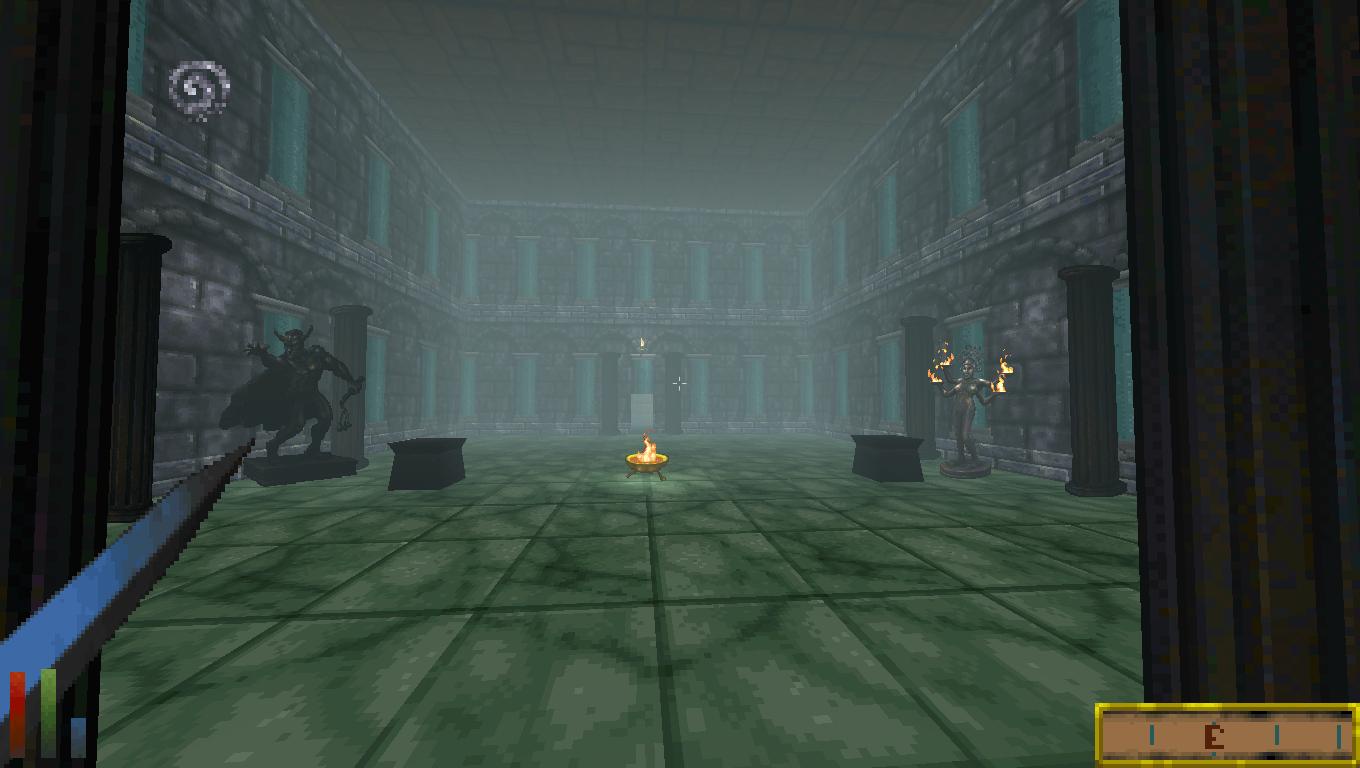
The hand-crafted interior of a dungeon
You start by creating a character with a very complete character editor that opens up a lot of roleplaying possibilities. You can select a plethora of advantages or disadvantages that make the character easier or harder to level up in order to balance the progression. The combat is similar to later entries, and you can create your own spells like in Morrowind. The game has a strong emphasis on dungeon crawling; almost all missions send the character into some type of dungeon. The dungeons are all procedurally generated by sticking together different handcrafted parts, called blocks. The main quest dungeon uses a mix of common blocks and handcrafted unique blocks to make their exploration a special part of gameplay. Cities are built similarly with handcrafted blocks; the only truly randomly generated environment is the wilderness. Exploring the dungeons is a lot of fun, but when you memorize the layout of the common blocks and how to navigate them, the exploration becomes suddenly trivial.
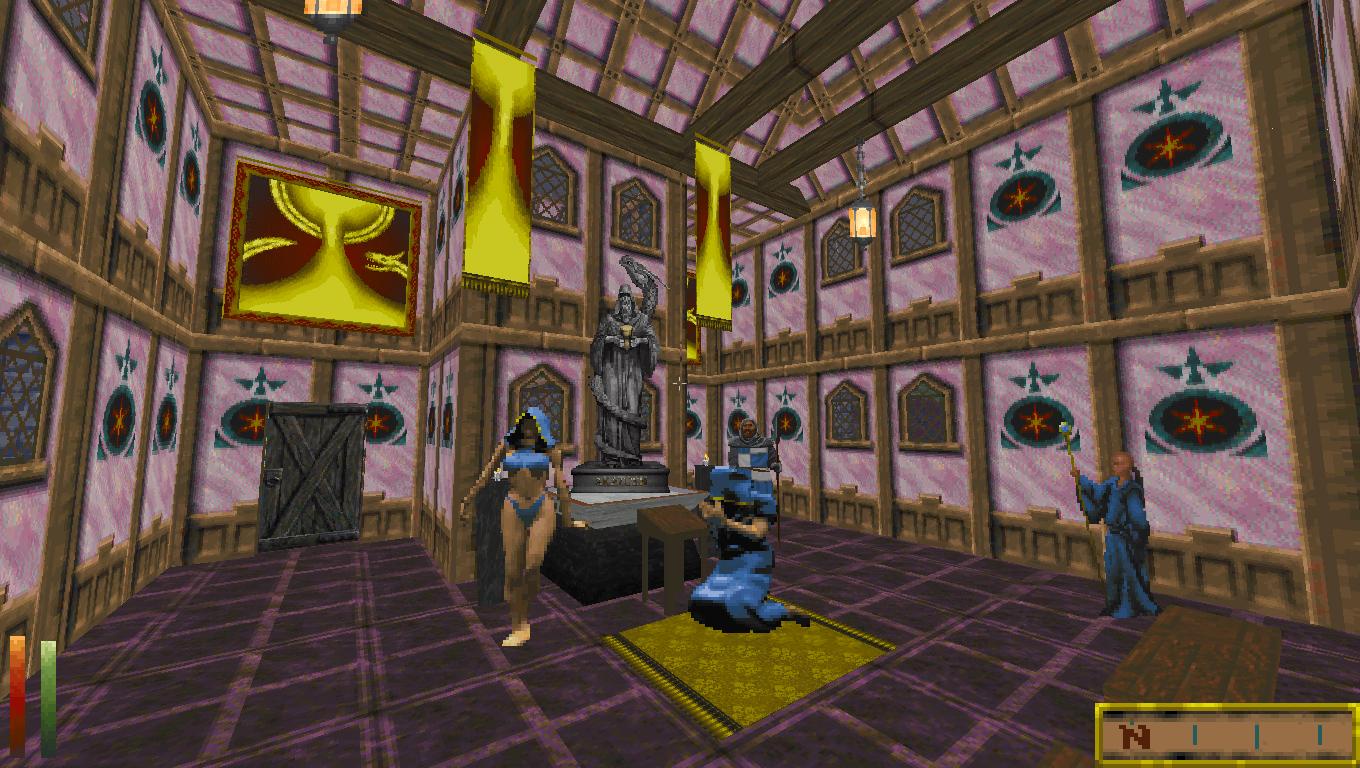
The internal chamber of an Akatosh temple
There are the classic guilds to join, different temples dedicated to a specific divinity, and knightly orders. Even if these organizations are widely different, the quests all feel the same, sadly. The fact that all secondary missions must be random and that almost all require dungeon crawling of some sort makes all very similar and allows for low structure variety. When I arrived to the last part of the game, I was master of the fighter guild, but I had no incentive to grow my rank with other secondary factions. Every faction grants particular bonuses and services to members of a certain rank, further differentiating them. The whole secondary quest structure feels two steps ahead; sadly, it isn't translated into great gameplay.
FINAL CONSIDERATIONS
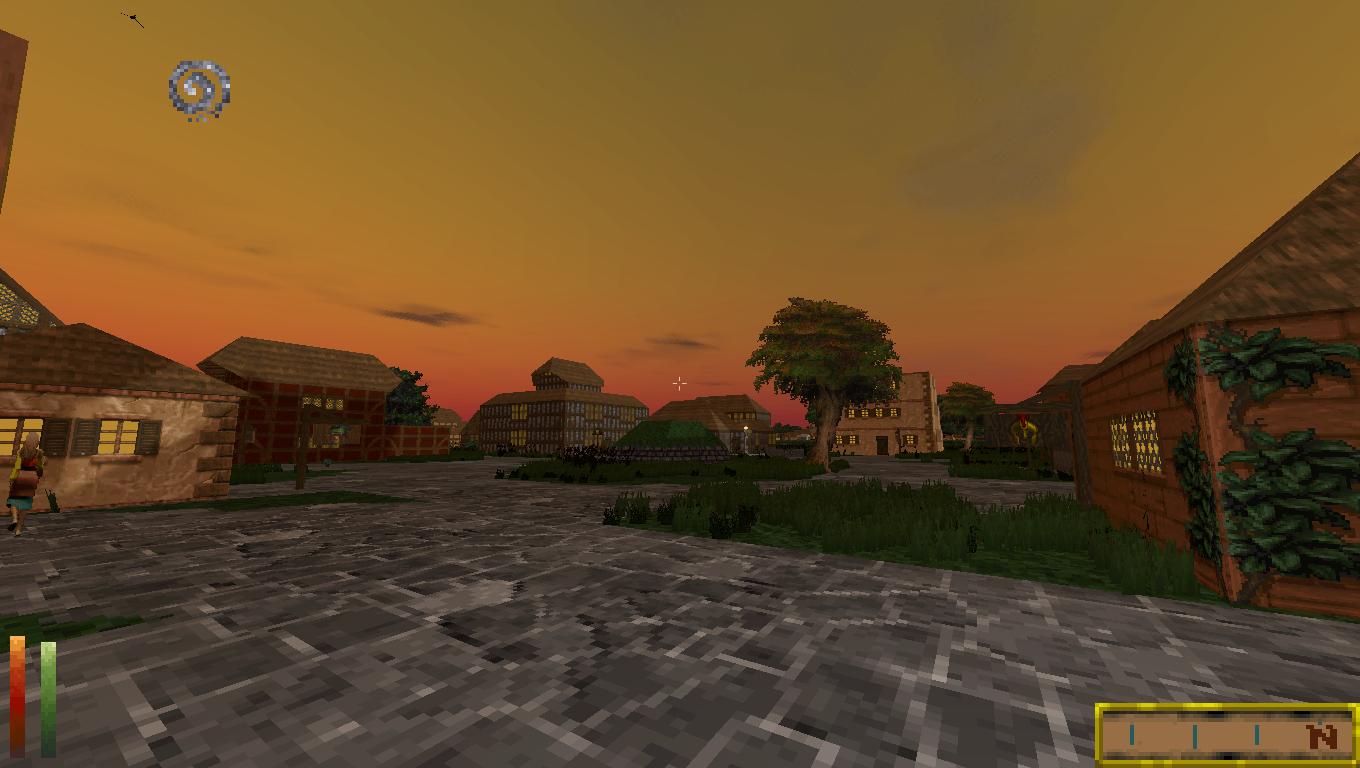
Mods can add a true skybox and a variety of different weathers
I definitely enjoyed my time in Daggerfall; it was quite an experience. I played a Dark Elf Crusader through the whole game, and it proved perfect to breeze through the whole game. The Unity version is wonderful, and mods help a lot with immersion and quality of life, enhancing almost any particular of the game. Sadly, it is very long and can be really tedious after some time since the secondary missions are too random to be a worthy investment of time aside from leveling up. Since both the remake and the original game are free, there are no reasons not to try it.
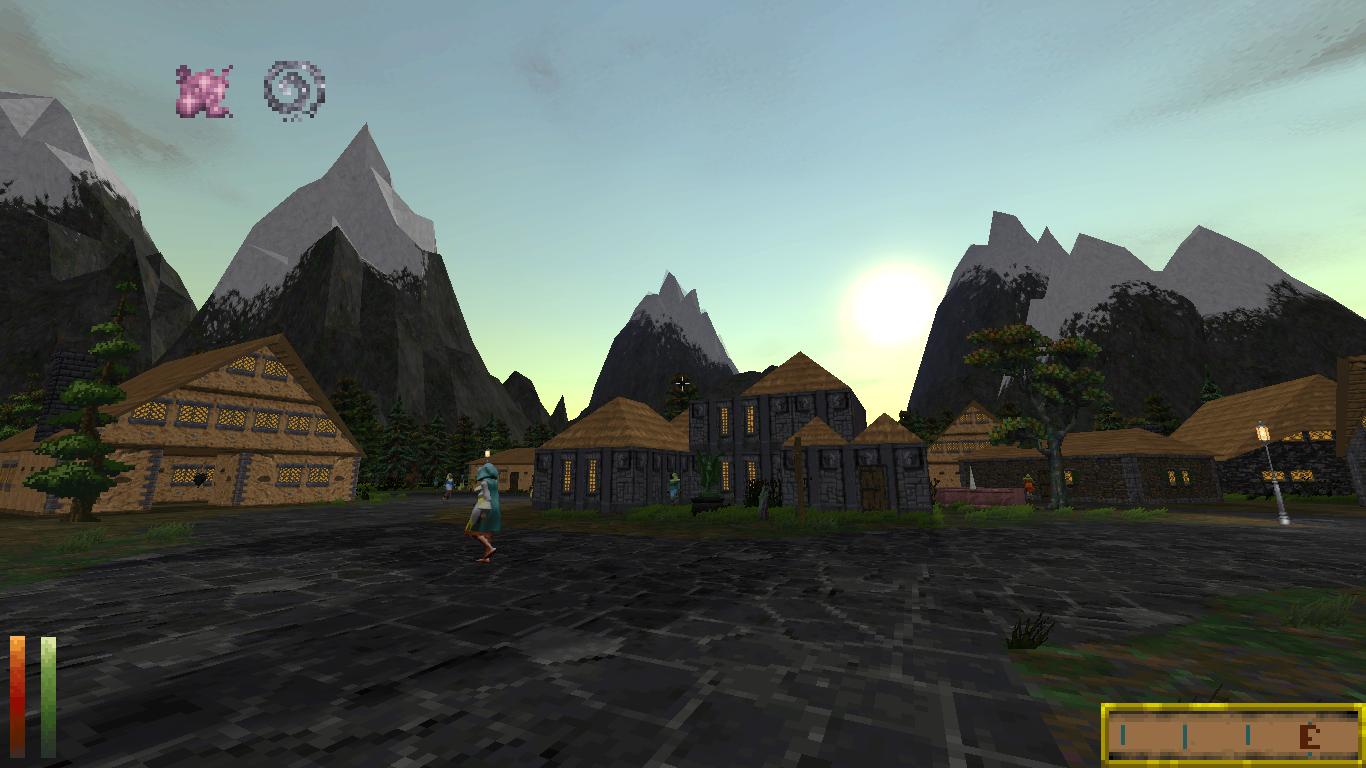
A small temple-village of the Wrothgarian Mountains, chosen by my character as its final resting point.
-------------------------------------------------------------------------------------------------------------------------------------------------------------------------------------------------------------------------
Donkey Kong is very difficult, but I manage to do a little progress every time I play it.
I started also Killer 7. The gameplay is strange and questionable, but the batshit insane story is something unique. I'll see if it will keep to entertain me also after some hours of gameplay.
The Elder Scrolls 2: Daggerfall Unity - PC (Free)
SCORE: 8.5/10
I've been pretty busy lately thanks to the transition between university life and work, but I'm doing fine. Sadly, I hadn't enough time to keep the same 2-week distance between the blog posts, but I'm sure that this meaty update will make up for the slight loss.
INTRODUCTION
My first TES game was Oblivion. Shortly after finishing it, I started to get interested in the franchise and discovered Daggerfall. There was always something that piqued my attention in this title: the big snowy cities, the procedurally generated landmass, or the sprawling dungeons. Sadly, the original game is buggy and not very convenient to play on modern systems, and after some play sessions I decided to put it away. Fast forward to a year ago, I discovered the Daggerfall Unity remake, and I was blown away. The remake completely adapts the game infrastructure to modern systems, fixing bugs and adding mod support. A year after some on-off playing, I decided to commit fully to the game and play it until completion, and here we are. From now on, I'll consider only the Unity remake, since this is the version that I've actually completed, and I think that today there is no reason to play the original version.

The main avenue of Daggerfall City, with its castle looming in the distance
Daggerfall is the apex of a certain RPG philosophy of expansive dungeon crawlers. It was so ambitious that a lot of unfinished content was cut in the final build, and Bethesda nearly went bankrupt after the development. Widely different from the following installments, Daggerfall is a unique beast that in a lot of aspects is also a upgrade of Arena, reusing some assets and the general gameplay concept.
STORY AND LORE
The game is set a lot of years before the beloved Skyrim, in a time when the Septim Empire was still unite but weak, and the emperor wrestled to keep it together. The player is an agent sent directly from the Emperor to the Iliac Bay region (between High Rock and Hammerfell) in order to put to rest the ghost of the king of Daggerfall, who was recently slain in a war against High Rock for the island of Betony. Once arrived, the agent found itself in a complex web of political intrigue between the six main powers of the region that comprehended the legitimate kingdoms: a mysterious lich, the king of orcs, and Mannimarco, the greatest necromancer of Tamriel.

A nice small city in winter
The game plot, compared to the "seek the magical artifacts to beat the warlock usurper of the emperor" of Arena, has a very complex and more mature plot, with a lot of factions acting only for their own self-interest. Daggerfall makes the player not feel as a hero like the later games, but only as a cog in an enormous machination that could be steered in a certain direction. It's certainly a fresh perspective that feels unique in the series. On the other hand, you are treated as a sort of errand boy for the whole game, and the missions are almost all going into dungeons to make a favor to a faction leader. When this game was produced, the TES lore was still not formed, so it has a different feel compared to later games. It has a more classical fantasy vibe, with Khajiit represented as humans with tails, no playable orcs, and a less otherwordly plot.
GAMEPLAY AND TECHNOLOGY
Every element of the later games is present here: equipment based on material quality, attributes, magic, horseriding, dungeons, guilds, and even playable undead creatures. You can even buy a house or a ship, and fast travel takes a belivable amount of time that can change dynamically based on the player's choices. The world has festivities with effects on the gameplay, Daedra Lords summoning on certain days, and a reputation system that tracks an enormous amount of micro-factions. It's incredible how much content the developers managed to cram into a single game.

The hand-crafted interior of a dungeon
You start by creating a character with a very complete character editor that opens up a lot of roleplaying possibilities. You can select a plethora of advantages or disadvantages that make the character easier or harder to level up in order to balance the progression. The combat is similar to later entries, and you can create your own spells like in Morrowind. The game has a strong emphasis on dungeon crawling; almost all missions send the character into some type of dungeon. The dungeons are all procedurally generated by sticking together different handcrafted parts, called blocks. The main quest dungeon uses a mix of common blocks and handcrafted unique blocks to make their exploration a special part of gameplay. Cities are built similarly with handcrafted blocks; the only truly randomly generated environment is the wilderness. Exploring the dungeons is a lot of fun, but when you memorize the layout of the common blocks and how to navigate them, the exploration becomes suddenly trivial.

The internal chamber of an Akatosh temple
There are the classic guilds to join, different temples dedicated to a specific divinity, and knightly orders. Even if these organizations are widely different, the quests all feel the same, sadly. The fact that all secondary missions must be random and that almost all require dungeon crawling of some sort makes all very similar and allows for low structure variety. When I arrived to the last part of the game, I was master of the fighter guild, but I had no incentive to grow my rank with other secondary factions. Every faction grants particular bonuses and services to members of a certain rank, further differentiating them. The whole secondary quest structure feels two steps ahead; sadly, it isn't translated into great gameplay.
FINAL CONSIDERATIONS

Mods can add a true skybox and a variety of different weathers
I definitely enjoyed my time in Daggerfall; it was quite an experience. I played a Dark Elf Crusader through the whole game, and it proved perfect to breeze through the whole game. The Unity version is wonderful, and mods help a lot with immersion and quality of life, enhancing almost any particular of the game. Sadly, it is very long and can be really tedious after some time since the secondary missions are too random to be a worthy investment of time aside from leveling up. Since both the remake and the original game are free, there are no reasons not to try it.

A small temple-village of the Wrothgarian Mountains, chosen by my character as its final resting point.
-------------------------------------------------------------------------------------------------------------------------------------------------------------------------------------------------------------------------
CURRENTLY PLAYING
- Killer 7 - PC
- Donkey Kong Country - SNES (Emulated)
Donkey Kong is very difficult, but I manage to do a little progress every time I play it.
I started also Killer 7. The gameplay is strange and questionable, but the batshit insane story is something unique. I'll see if it will keep to entertain me also after some hours of gameplay.
4 Yrs✓#
f_n_c
4 Yrs✓#
UPDATE #12
INTRODUCTION
Donkey Kong Country (DKC from now on) was a game that always interested me. I liked Donkey Kong in the Mario spinoff games, and the screenshots seemed promising. I knew also that some popular song samples were extracted from its OST and that it used a particular graphic technology. But time is scarce, and I never had the occasion to play DKC until now. I expected a casual platformer like the Mario games, but I was so wrong.
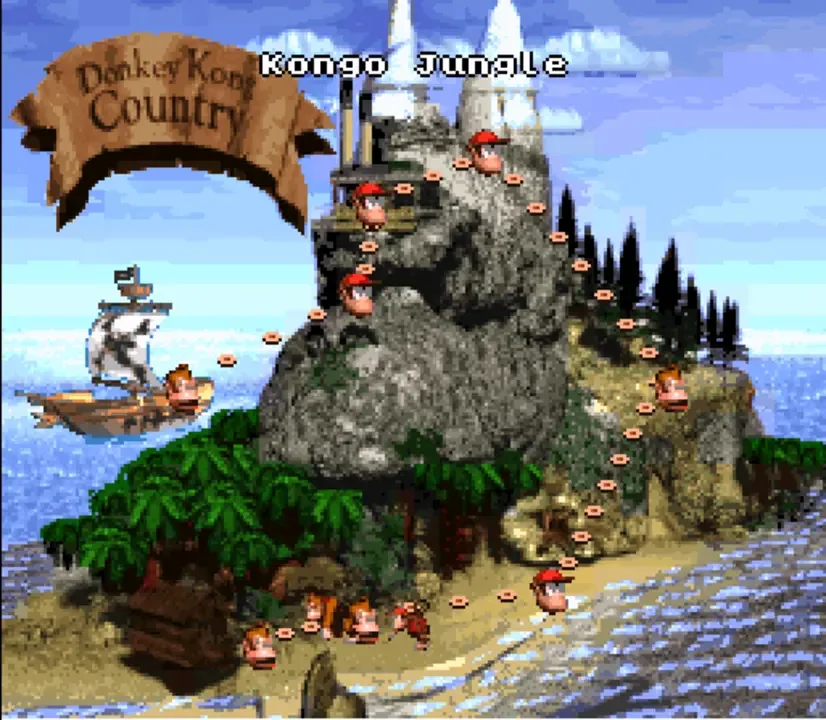
The overwold map of the game, its shape resembles something familiar...
GAMEPLAY AND TECHNICAL CONSIDERATIONS
This is a SNES game, even if it seems something more akin to PS1. This game used 2D versions of 3D models to give the impression of 3D graphics on the SNES, actually circumventing its big shortcomings regarding polygons. With the help of the famous 3D additional chip Mode 7, the game could wrap 2D textures on low-polygon 3D objects and create the technical marvel that everyone can see on screen. Today it feels pretty dated, but I think that the art direction and the particular way in which everything looks grant the whole game a particular charm. The first level in particular, representing the jungle next to Donkey Kong's hut, is a masterpiece and introduces the whole game in a fantastic manner.
The soundtrack follows the same strategy, offering complex and crispy sound samples that stand out in the whole sample-based sound landscape of SNES games. Using a strong string bass, catchy percussive sounds, and rich synths, the composer has created a dynamic atmosphere that can range from jazz-like tunes to otherworld synth-based melodies. I still listen to some tracks of the OST long after I have finished the game, and for my person, that is definitely something since I rarely listen to OSTs at all.
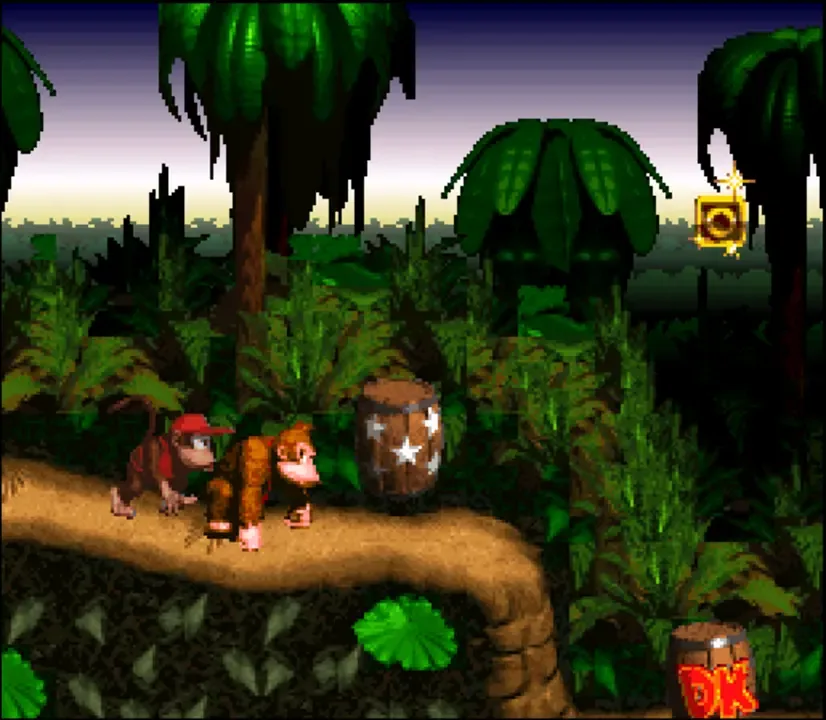
A screenshot of the first level of the game
But what about the gameplay? The graphics and OST are important, but in the end, in a platformer game, it is the gameplay loop that brings the cake home. In my modest opinion, the game structure has aged a bit, but it is still ok. Traversing the levels is still fun, and the higher levels require quite a few skill to be completed. The player can freely switch between Donkey Kong and Diddy Kong; the first one is more nimble, while the second has an additional attack that can knock off nearby walking enemies and defeat all the enemies while Diddy bounces on the tougher ones. Playing one or the other has few differences, and I played roughly the two characters for the same time. Sometimes, the characters can ride some animal friends found in wooden crates, which grants them some special abilities. They offer a welcome addition to the normal gameplay, but their sections are just a fun addition that doesn't impact too much on the whole game.
The levels are pretty varied, even if towards the end you've seen all the possible level types and you traverse environments that are just palette-swapped assets of older levels. I also found the bosses fun but not very characterized, being almost all oversize versions of normal enemies. One of them is a flying barrel, without any clear explanation.
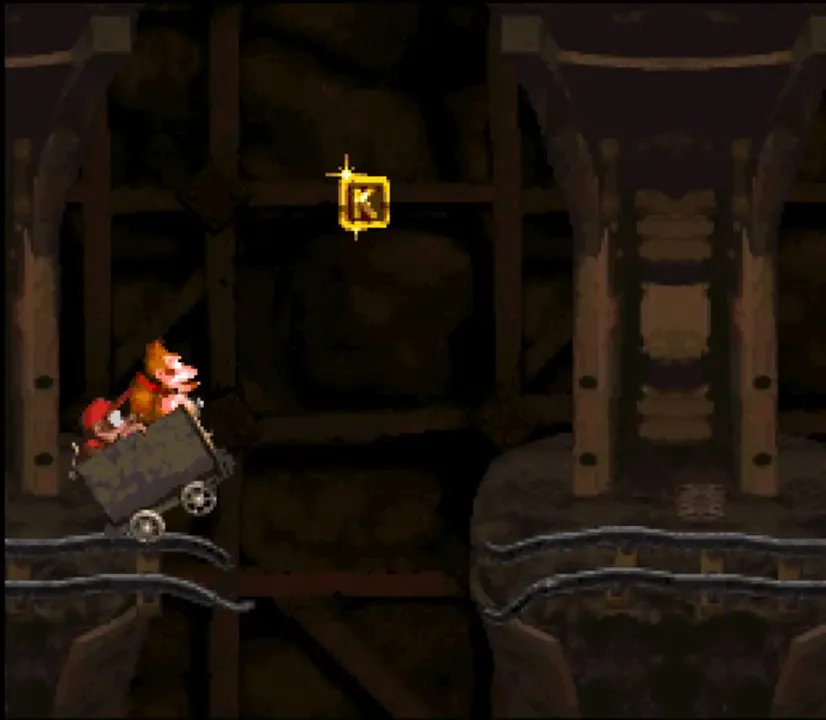
I genuinely hated the mine cart section. It was hard, too different from the rest of the game and too long
You defeat the enemies by jumping on them like Mario or rolling during the first frames of the running sequence. Even if you have more ways to defeat enemies compared to normal Mario games, their positioning and their special abilities keep the whole affair very challenging. I died quite some times in a few sections, and sometimes it wasn't very fun to repeat the same section over and over. I am ok with high-difficulty games, but I think that this one in particular is tedious in some parts. The camera doesn't help either, leaving off-screen important details that could cost you a life and panning out in some bizarre ways. This is surely linked to some Mode 7 limitations, but it still hurts the overall experience. I had a sort of "quick load" after every death, so I think that with normal play the experience is a little less enjoyable (at least for my tastes).
WRAP-UP
If this game has a true highlight, it is the character of Cranky Kong. You encounter him in its cabin once per world, and he gives you some tips while copiously breaking the fourth wall by complaining about the game's good graphics and low difficulty compared to old 8-bit games. I found him, together with the whole Kong crew, hilarious and well-characterized.
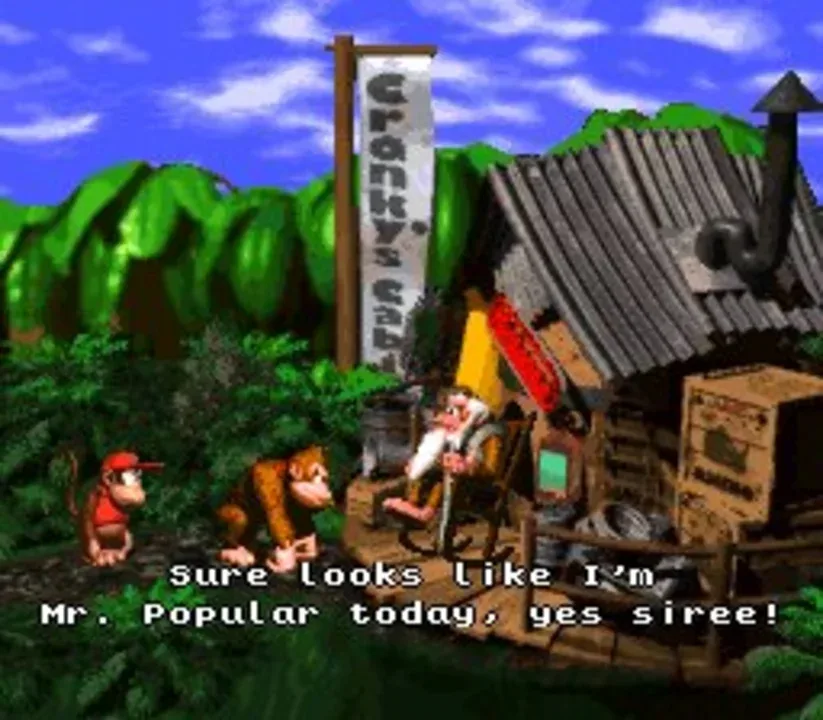
The old Cranky in all its glory
In the end, DKC is a fun game, rewarding but difficult. I enjoyed my time with it, but I don't know if I will play it again. I will play for sure the other installments of the series, even if I know that almost all are harder compared to the original game. Personal experience aside, I think that this game was a masterpiece when it was released, and it is worth playing for its historical significance alone. Or at least listen to its OST through Youtube and dance to the astounding DK jungle theme.
-------------------------------------------------------------------------------------------------------------------------------------------------------------------------------------------------------------------------
I have a new profile picture Killer-7 related, so it means that I'm really enjoying that insane game. This character, Travis, is fantastic and almost comples me to buy a black tanktop with a neon-colored random word.
I also found Fuel in a flea market and immediately bought it, since it is delisted from all the online stores and buying a physical copy is the only legal way to play it. It's fun, but the races seems either too easy or really too hard. It's not great technically, but driving around its gargantuan open-world has its charm.
Donkey Kong Country - Emulated
SCORE: 8.5/10
INTRODUCTION
Donkey Kong Country (DKC from now on) was a game that always interested me. I liked Donkey Kong in the Mario spinoff games, and the screenshots seemed promising. I knew also that some popular song samples were extracted from its OST and that it used a particular graphic technology. But time is scarce, and I never had the occasion to play DKC until now. I expected a casual platformer like the Mario games, but I was so wrong.

The overwold map of the game, its shape resembles something familiar...
GAMEPLAY AND TECHNICAL CONSIDERATIONS
This is a SNES game, even if it seems something more akin to PS1. This game used 2D versions of 3D models to give the impression of 3D graphics on the SNES, actually circumventing its big shortcomings regarding polygons. With the help of the famous 3D additional chip Mode 7, the game could wrap 2D textures on low-polygon 3D objects and create the technical marvel that everyone can see on screen. Today it feels pretty dated, but I think that the art direction and the particular way in which everything looks grant the whole game a particular charm. The first level in particular, representing the jungle next to Donkey Kong's hut, is a masterpiece and introduces the whole game in a fantastic manner.
The soundtrack follows the same strategy, offering complex and crispy sound samples that stand out in the whole sample-based sound landscape of SNES games. Using a strong string bass, catchy percussive sounds, and rich synths, the composer has created a dynamic atmosphere that can range from jazz-like tunes to otherworld synth-based melodies. I still listen to some tracks of the OST long after I have finished the game, and for my person, that is definitely something since I rarely listen to OSTs at all.

A screenshot of the first level of the game
But what about the gameplay? The graphics and OST are important, but in the end, in a platformer game, it is the gameplay loop that brings the cake home. In my modest opinion, the game structure has aged a bit, but it is still ok. Traversing the levels is still fun, and the higher levels require quite a few skill to be completed. The player can freely switch between Donkey Kong and Diddy Kong; the first one is more nimble, while the second has an additional attack that can knock off nearby walking enemies and defeat all the enemies while Diddy bounces on the tougher ones. Playing one or the other has few differences, and I played roughly the two characters for the same time. Sometimes, the characters can ride some animal friends found in wooden crates, which grants them some special abilities. They offer a welcome addition to the normal gameplay, but their sections are just a fun addition that doesn't impact too much on the whole game.
The levels are pretty varied, even if towards the end you've seen all the possible level types and you traverse environments that are just palette-swapped assets of older levels. I also found the bosses fun but not very characterized, being almost all oversize versions of normal enemies. One of them is a flying barrel, without any clear explanation.

I genuinely hated the mine cart section. It was hard, too different from the rest of the game and too long
You defeat the enemies by jumping on them like Mario or rolling during the first frames of the running sequence. Even if you have more ways to defeat enemies compared to normal Mario games, their positioning and their special abilities keep the whole affair very challenging. I died quite some times in a few sections, and sometimes it wasn't very fun to repeat the same section over and over. I am ok with high-difficulty games, but I think that this one in particular is tedious in some parts. The camera doesn't help either, leaving off-screen important details that could cost you a life and panning out in some bizarre ways. This is surely linked to some Mode 7 limitations, but it still hurts the overall experience. I had a sort of "quick load" after every death, so I think that with normal play the experience is a little less enjoyable (at least for my tastes).
WRAP-UP
If this game has a true highlight, it is the character of Cranky Kong. You encounter him in its cabin once per world, and he gives you some tips while copiously breaking the fourth wall by complaining about the game's good graphics and low difficulty compared to old 8-bit games. I found him, together with the whole Kong crew, hilarious and well-characterized.

The old Cranky in all its glory
In the end, DKC is a fun game, rewarding but difficult. I enjoyed my time with it, but I don't know if I will play it again. I will play for sure the other installments of the series, even if I know that almost all are harder compared to the original game. Personal experience aside, I think that this game was a masterpiece when it was released, and it is worth playing for its historical significance alone. Or at least listen to its OST through Youtube and dance to the astounding DK jungle theme.
-------------------------------------------------------------------------------------------------------------------------------------------------------------------------------------------------------------------------
CURRENTLY PLAYING
- Killer 7 - PC
- Fuel - Xbox One
I have a new profile picture Killer-7 related, so it means that I'm really enjoying that insane game. This character, Travis, is fantastic and almost comples me to buy a black tanktop with a neon-colored random word.
I also found Fuel in a flea market and immediately bought it, since it is delisted from all the online stores and buying a physical copy is the only legal way to play it. It's fun, but the races seems either too easy or really too hard. It's not great technically, but driving around its gargantuan open-world has its charm.
4 Yrs✓#
f_n_c
4 Yrs✓#
UPDATE #13
INTRODUCTION
Suda51 maybe is not one of the biggest names of the video game industry looking only at game sales, but his name was always associated with crazy and wildly unique games. Killer7 was his first game to be released also in North America, and it gave him a solid base to build on its success outside Japan. Developed originally for Gamecube as the last title of the famous Capcom Five and published also for PS2, this game was bashed at first from critics, but today has a cult following and is one of the most beloved Suda51 games. This game was re-released some years ago for PC (the version that I have played personally), making it accessible to a wider audience by eliminating the need for emulation.
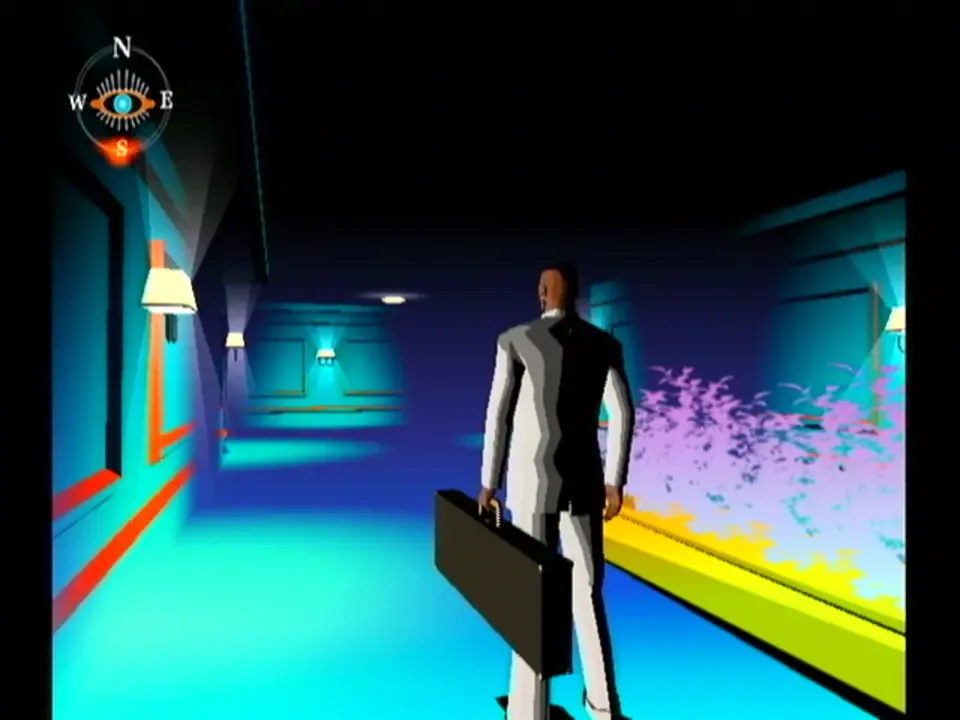
Garcian Smith, a very special personality that carries around costantly a misterious suitcase
I was always interested in Suda51 games; they are an odd mix of unique design choices and violence that appeal a lot to me. I played The Killer is Dead some years ago, but I wasn't completely satisfied. The plot was crazy and didn't give any clear answer, and behind a stellar presentation there was a pretty bland game. I liked it for what it was nevertheless, and I was compelled sooner or later to buy also Killer7.
STORY AND PRESENTATION
The game follows the adventures of an assassin group called Killer7, made of seven different people controlled by Harman, an old man in a wheelchair that fights with an enormous sniper rifle. These assassins are multiple physical personalities that exist together in a single body, and the "active" physical presence can be changed through TVs and security cameras. Every member of the outfit has a distinct personality and appearance and fights using different weapons from the rest of the group. Their main enemies are Heaven Smile, a terrorist organization that infects common people, mutating them into monsters that carry out suicide attacks against their targets and laugh maniacally. They are created by Kun-Lan, a superhuman that is both an old friend and main rival of Harman. The group can also see and listen to the ghosts of dead people, who often offer advice on the puzzles scattered through the game or strategies to kill the different Heaven Smiles. Among them the best is definitely Travis, the first victim of the group that manifests itself with a black tank top with always a different word on it.
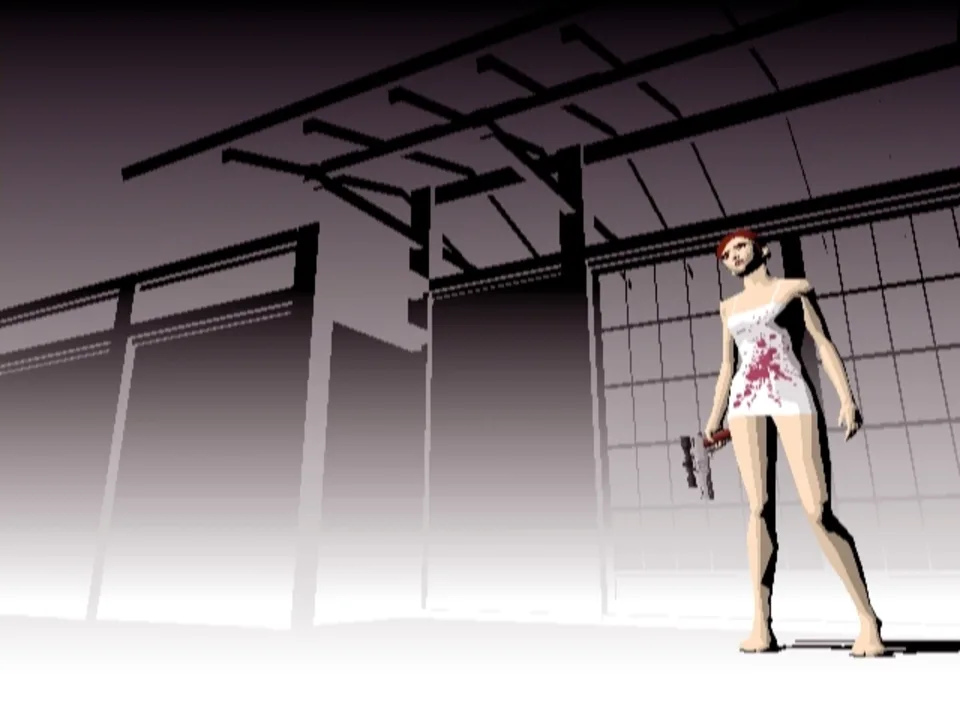
Kaede Smith, the only woman of the group that carries a scoped pistol
If you feel overwhelmed by this short recap, I have to inform you that everything is contained in the first hour of gameplay. The plot becomes quickly a complex and convoluted political thriller, set in a world apparently in total peace but that lives with the fear of terrorism and has banned globally the internet and air travel. The main political intrigue is set around the US and Japan, where the first is a shady global superpower and the second is a dying state on the verge of disappearance. Even if the plot is very complex and didn't deliver all the key information to fully understand it, it is definitely deep and interesting, and most of it can be unveiled by analyzing all the dialogues present in the game.
As you can see from the screenshots, the game has a very distinctive and aggressive appearance through cell-shading and the use of plain color textures. This art direction cannot satisfy everyone, but it definitely helps to create a cohesive look that remains impressed in the mind of the player. It really helps to mask the age of the game and the lack of polygons compared to modern standards: the technical age can be seen only in the rare, big, open spaces, where the lack of detail is really noticeable. The menus are also highly stylized, and the game is full of amazing little details. For example, the personalities slightly change their appearance from mission to mission, and they also change their short dialogue played in the character selection screen. Remaining in the audio department, the sound effects are good and the music is phenomenal. Centered around dance and electronic music, all the tracks are incredibly well made. The game has even two versions of the difficulty selection screen, one for each difficulty.
GAMEPLAY AND TECHNICAL ASPECTS
This game is a bizarre mix of a rail shooter with a visual novel, sprinkled by Resident Evil-like puzzles. The result is not great, at least in my opinion. You control one personality at a time, and you can change almost freely between them. You move your character manually on predefinite rails in 3D environments, and every time you reach a fork in the path, your character stops until you click on the path you choose. You interact in the same way with the environment to solve the puzzles. By holding down a button, you can enter into aim mode and shoot your gun, and you're always warned by a creepy laughter when you need to activate this mode. You can't move during aiming; you can only shoot, reload, or use the character's special ability. Heaven Smiles are invisible and invulnerable at first; you need to scan them with another button to harm them and aim to their weak points.
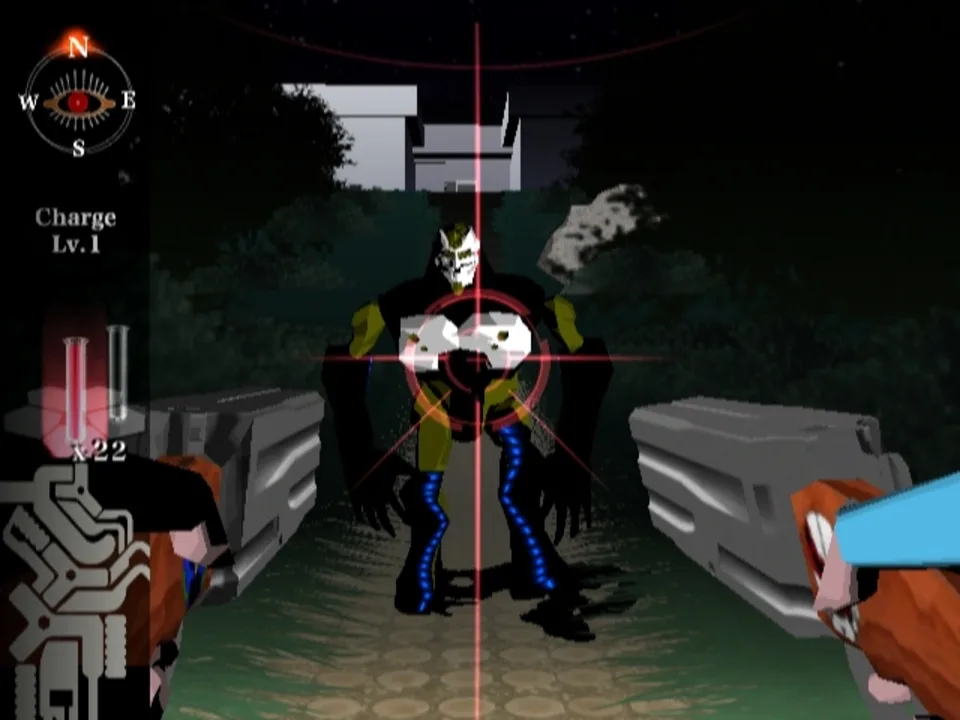
The aim mode of Mask, a badass Luchador that fights with two grenade launchers
The fighting sections are not very bad since there are a lot of different enemies and every one needs a specific tactic or character to be eliminated. Sadly, they are the only type of action you get for the whole game, and the gameplay elements are too simple to entertain for the whole length of the experience. The whole control scheme is very strange, and it takes some time to get used to. But the worst part are the strange puzzles, which seem to really be developed by an insane person. They range from "use an obvious object present in your inventory" to "take notes on a long list of documents or images scattered around the level and answer very specific questions about them." Especially this second type is very tedious, since navigating the levels through the various trail branches is very slow.
Aside from the dated but well-masked graphics, there are few technical things to talk about. The game runs smoothly, but I find the PC port really bad. The game features some animated cutscenes that are not remastered at all and look really old even on my low-end laptop. The game was simply ported and not adapted at all to the new platform, since when a game references a button, it reports the PS2 equivalent and not the keyboard, and the options are accessed through an external tool window. A more thought-out conversion could have definitely benefitted immensely to the game.
CONCLUSION
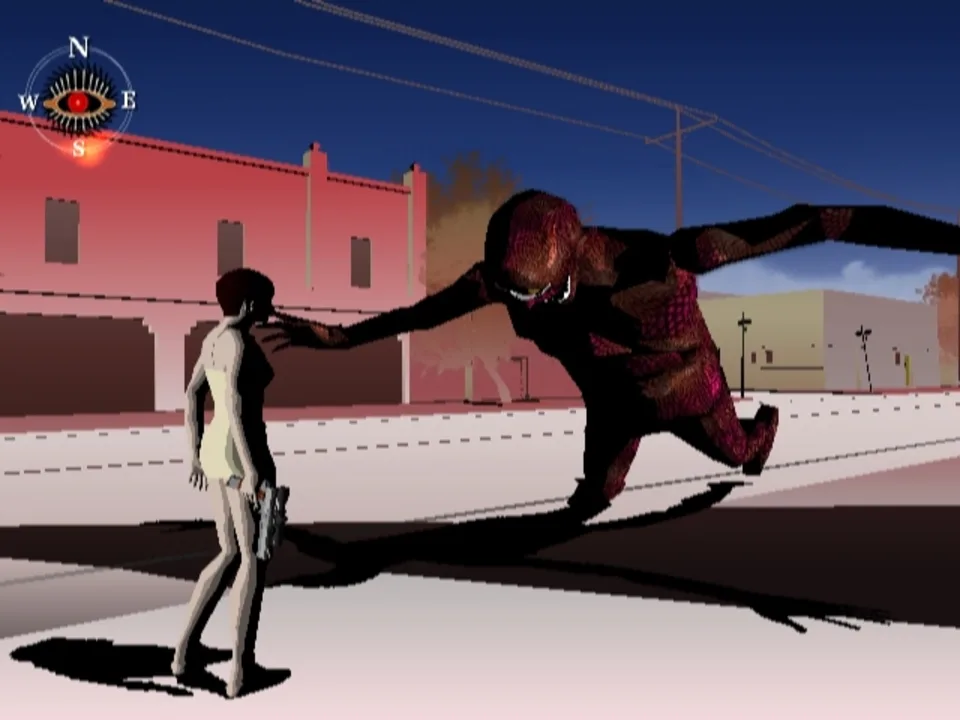
A giant Heaven Smile, encountered only in this level, in the process of falling on the poor Kaede
Is Killer7 a masterpiece? Definitely not. Its gameplay is nothing special, and almost something that must be done between the cutscenes that move forward the plot. It is definitely a game to be experienced at least once if you're into strange and messed up stories. It is an audiovisual experience rather than a game, a vicious attack on two of your senses that leaves your brain stunned and eager for more. It directly jumps into my list of 30 favorite games, and it will probably remain there for a long time.
-------------------------------------------------------------------------------------------------------------------------------------------------------------------------------------------------------------------------
Fuel has almost burned myself out. It is fun on short bursts, but nothing more. Probably I will soon be satisfied and ready to write a review.
I have also just started RDR today. It's great to return to the wild frontier after RDR2, and I'm eager to see if it will match the incredible quality of the second installment of the series.
Killer7 - PC
SCORE: 8/10
INTRODUCTION
Suda51 maybe is not one of the biggest names of the video game industry looking only at game sales, but his name was always associated with crazy and wildly unique games. Killer7 was his first game to be released also in North America, and it gave him a solid base to build on its success outside Japan. Developed originally for Gamecube as the last title of the famous Capcom Five and published also for PS2, this game was bashed at first from critics, but today has a cult following and is one of the most beloved Suda51 games. This game was re-released some years ago for PC (the version that I have played personally), making it accessible to a wider audience by eliminating the need for emulation.

Garcian Smith, a very special personality that carries around costantly a misterious suitcase
I was always interested in Suda51 games; they are an odd mix of unique design choices and violence that appeal a lot to me. I played The Killer is Dead some years ago, but I wasn't completely satisfied. The plot was crazy and didn't give any clear answer, and behind a stellar presentation there was a pretty bland game. I liked it for what it was nevertheless, and I was compelled sooner or later to buy also Killer7.
STORY AND PRESENTATION
The game follows the adventures of an assassin group called Killer7, made of seven different people controlled by Harman, an old man in a wheelchair that fights with an enormous sniper rifle. These assassins are multiple physical personalities that exist together in a single body, and the "active" physical presence can be changed through TVs and security cameras. Every member of the outfit has a distinct personality and appearance and fights using different weapons from the rest of the group. Their main enemies are Heaven Smile, a terrorist organization that infects common people, mutating them into monsters that carry out suicide attacks against their targets and laugh maniacally. They are created by Kun-Lan, a superhuman that is both an old friend and main rival of Harman. The group can also see and listen to the ghosts of dead people, who often offer advice on the puzzles scattered through the game or strategies to kill the different Heaven Smiles. Among them the best is definitely Travis, the first victim of the group that manifests itself with a black tank top with always a different word on it.

Kaede Smith, the only woman of the group that carries a scoped pistol
If you feel overwhelmed by this short recap, I have to inform you that everything is contained in the first hour of gameplay. The plot becomes quickly a complex and convoluted political thriller, set in a world apparently in total peace but that lives with the fear of terrorism and has banned globally the internet and air travel. The main political intrigue is set around the US and Japan, where the first is a shady global superpower and the second is a dying state on the verge of disappearance. Even if the plot is very complex and didn't deliver all the key information to fully understand it, it is definitely deep and interesting, and most of it can be unveiled by analyzing all the dialogues present in the game.
As you can see from the screenshots, the game has a very distinctive and aggressive appearance through cell-shading and the use of plain color textures. This art direction cannot satisfy everyone, but it definitely helps to create a cohesive look that remains impressed in the mind of the player. It really helps to mask the age of the game and the lack of polygons compared to modern standards: the technical age can be seen only in the rare, big, open spaces, where the lack of detail is really noticeable. The menus are also highly stylized, and the game is full of amazing little details. For example, the personalities slightly change their appearance from mission to mission, and they also change their short dialogue played in the character selection screen. Remaining in the audio department, the sound effects are good and the music is phenomenal. Centered around dance and electronic music, all the tracks are incredibly well made. The game has even two versions of the difficulty selection screen, one for each difficulty.
GAMEPLAY AND TECHNICAL ASPECTS
This game is a bizarre mix of a rail shooter with a visual novel, sprinkled by Resident Evil-like puzzles. The result is not great, at least in my opinion. You control one personality at a time, and you can change almost freely between them. You move your character manually on predefinite rails in 3D environments, and every time you reach a fork in the path, your character stops until you click on the path you choose. You interact in the same way with the environment to solve the puzzles. By holding down a button, you can enter into aim mode and shoot your gun, and you're always warned by a creepy laughter when you need to activate this mode. You can't move during aiming; you can only shoot, reload, or use the character's special ability. Heaven Smiles are invisible and invulnerable at first; you need to scan them with another button to harm them and aim to their weak points.

The aim mode of Mask, a badass Luchador that fights with two grenade launchers
The fighting sections are not very bad since there are a lot of different enemies and every one needs a specific tactic or character to be eliminated. Sadly, they are the only type of action you get for the whole game, and the gameplay elements are too simple to entertain for the whole length of the experience. The whole control scheme is very strange, and it takes some time to get used to. But the worst part are the strange puzzles, which seem to really be developed by an insane person. They range from "use an obvious object present in your inventory" to "take notes on a long list of documents or images scattered around the level and answer very specific questions about them." Especially this second type is very tedious, since navigating the levels through the various trail branches is very slow.
Aside from the dated but well-masked graphics, there are few technical things to talk about. The game runs smoothly, but I find the PC port really bad. The game features some animated cutscenes that are not remastered at all and look really old even on my low-end laptop. The game was simply ported and not adapted at all to the new platform, since when a game references a button, it reports the PS2 equivalent and not the keyboard, and the options are accessed through an external tool window. A more thought-out conversion could have definitely benefitted immensely to the game.
CONCLUSION

A giant Heaven Smile, encountered only in this level, in the process of falling on the poor Kaede
Is Killer7 a masterpiece? Definitely not. Its gameplay is nothing special, and almost something that must be done between the cutscenes that move forward the plot. It is definitely a game to be experienced at least once if you're into strange and messed up stories. It is an audiovisual experience rather than a game, a vicious attack on two of your senses that leaves your brain stunned and eager for more. It directly jumps into my list of 30 favorite games, and it will probably remain there for a long time.
-------------------------------------------------------------------------------------------------------------------------------------------------------------------------------------------------------------------------
CURRENTLY PLAYING
- Red Dead Redemption - Xbox One
- Fuel - Xbox One
Fuel has almost burned myself out. It is fun on short bursts, but nothing more. Probably I will soon be satisfied and ready to write a review.
I have also just started RDR today. It's great to return to the wild frontier after RDR2, and I'm eager to see if it will match the incredible quality of the second installment of the series.
4 Yrs✓#
f_n_c
4 Yrs✓#
UPDATE #14
I'm back just in time for the festive season! Work and random illinesses swallowed me the last month, but I hope to update the blog more consistently from now on. And now, let's get to the review.
INTRODUCTION, PLOT AND PRESENTATION
I'm a sucker for procedurally generated, immense but empty worlds. The sense of freedom and exploration of new places is something that I really cherish. So I knew Fuel, even if it is a pretty obscure driving game. Fuel pops up in every "Biggest Open World" video and article throughout the web, but very little information can be found online. Even if it is widely remembered, few people have played it for a simple reason: there is no way to legally play it besides owning an original Xbox 360/PS3/PC copy, since it is delisted from every digital store. So I was very lucky to find a very cheap copy in a local flea market, which gave me the possibility to finally try out the game.
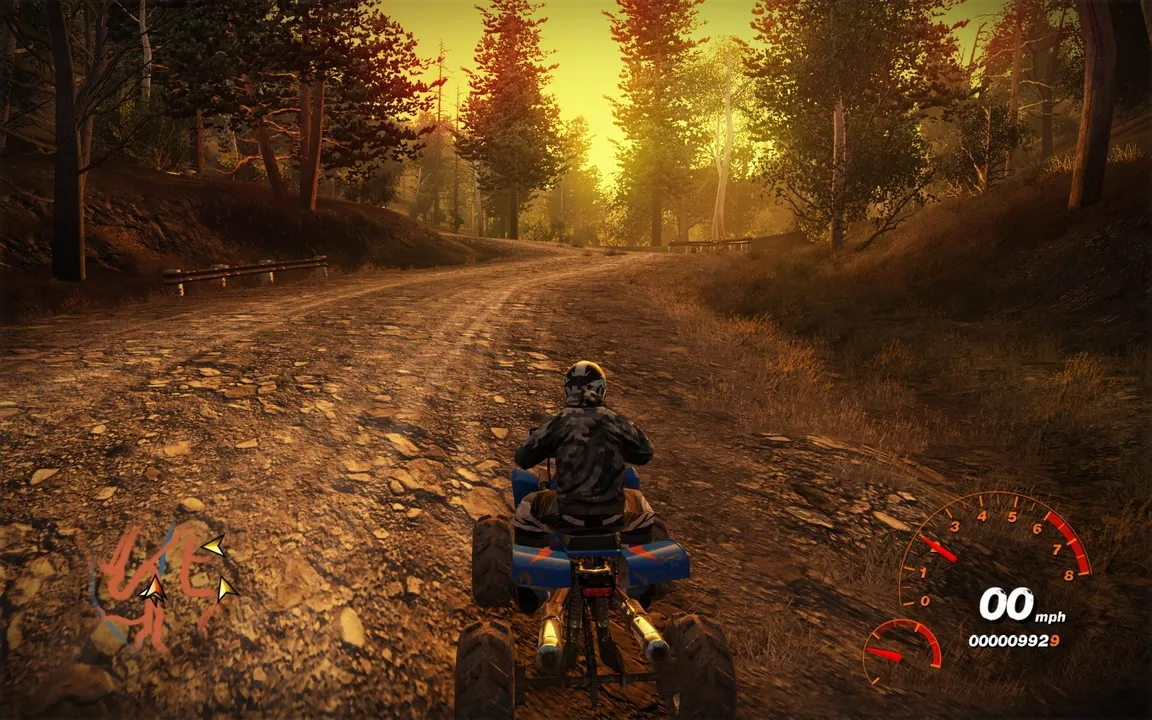
Fuel is a driving game set in a world ruined by climate change, where humanity has banned fuel as an energy source and lives in dome cities protected by the harsh environment. The remaining badlands are traversed by crazy pilots that fight and use the same fuel that the world has abandoned. This is the plot incipit of the game and also the whole plot. It is definitely not a story-driven game, and some lore is only there to justify the player's endless wandering in the wildlands. Fuel is definitely not a story-driven game, and some lore is only there to justify the player's endless wandering in the wildlands. On the other hand, the environment is built really well. Every biome is distinct and has peculiar characteristics that make it stand out among the others. Wide cliffs to climb, burned forest to traverse, and small rivers dot the landscape, while in particular places the player can also see a sunken and an abandoned city, an enormous wind turbine park, and much more else.
GAMEPLAY AND TECHNICAL ASPECTS
It's clear that the game relies heavily on its gameplay to sell. Fuel was developed by Asobo Studios, the same company that has also developed the most recent Microsoft Flight Simulator. And in fact, Fuel seems to be a game that wanted to be similar in concept to a flight simulator but is forced to be a racing game. The technology behind the semi-procedural world generation is awesome and really ahead of its time, but it seems that the company has spent the game budget almost exclusively on it.
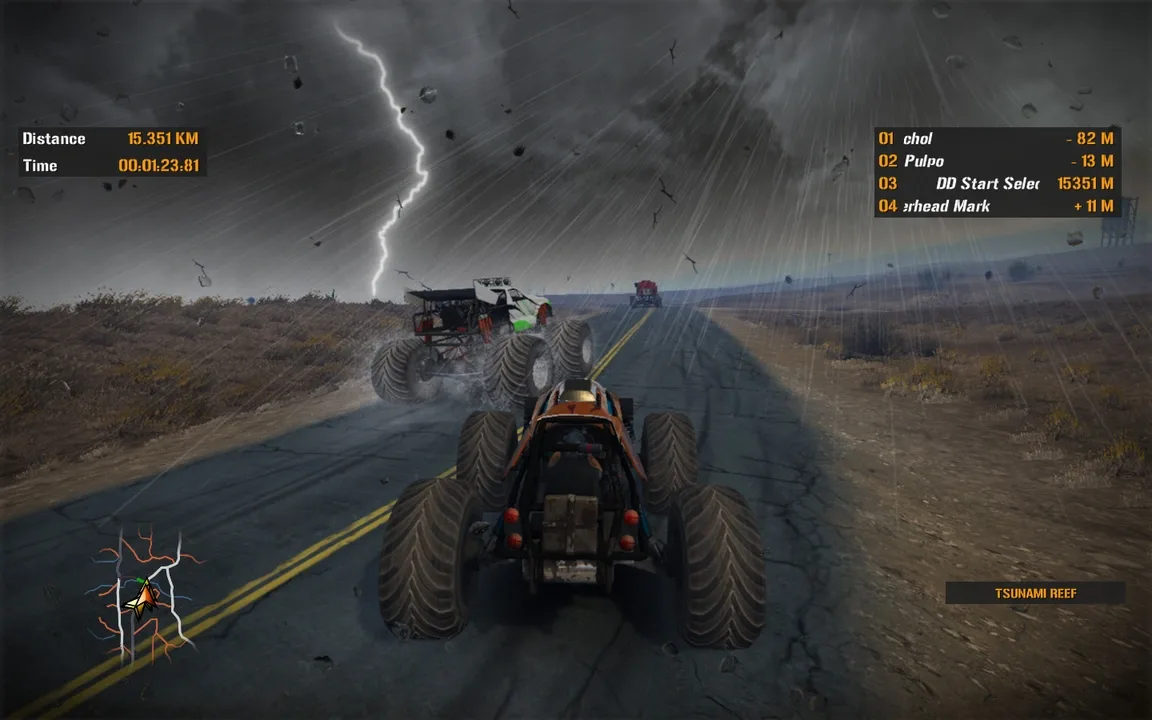
The map of the game is divided into areas, and for every area a base camp is built. The player can play races that give stars to unlock new camps with new races, or challenges, races with special rules that grant only a great amount of fuel (the game currency). You play races to unlock new races and do challenges when you need fuel to unlock more powerful vehicles. You can explore in free-roaming to find collectibles and new liveries for specific vehicles, but that's all the game has to offer.
Luckily, the driving aspect is much more convincing. The player can drive bikes, quads, cars, dune buggies, monster trucks, trucks, and some other classes. There is a huge variety in the vehicles, and every class drives differently from the others. Races locks the player into a specific class, but the player can change the vehicle it is driving on the fly from the pause menu. All the vehicles, especially the lighter ones, are prone to easily drifting in every corner, and controlling the drift is fun and satisfying. Sadly, the drivers AI during races is badly balanced, too easy on lower difficulties and prone to recovering large gaps at your first little mistake at higher difficulties.
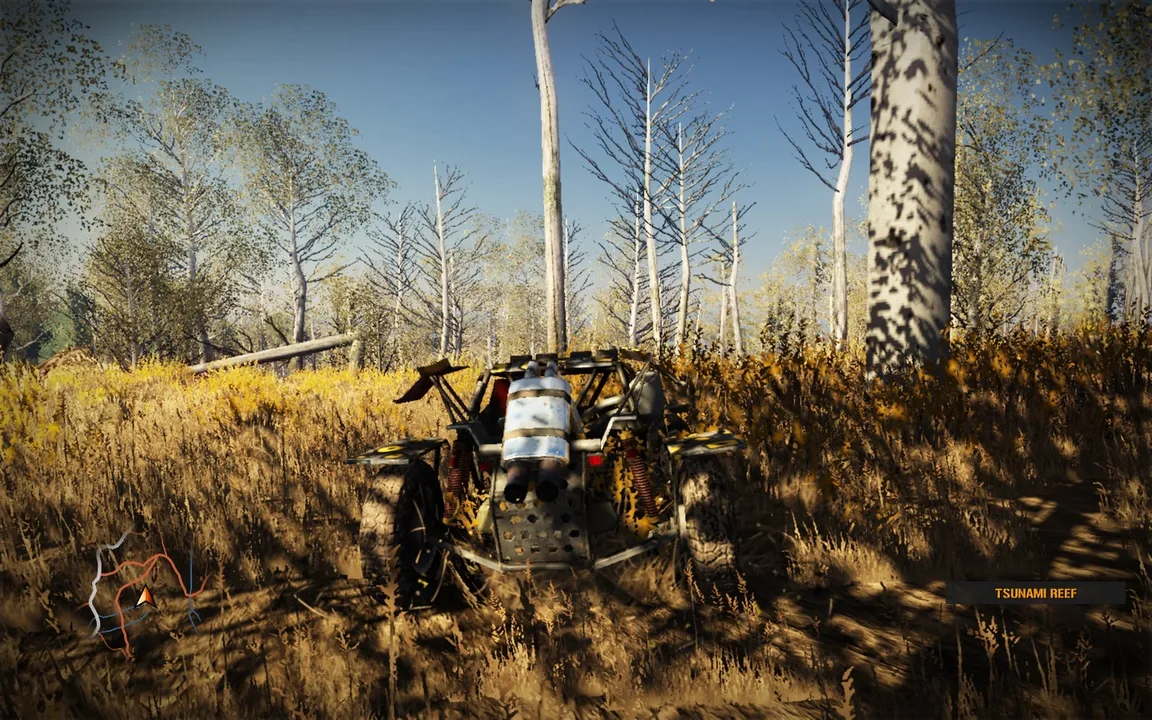
FINAL CONSIDERATIONS
Fuel is stuck in the limbo of middle games. The racing aspect is widely lacking, but exploring the enormous wasteland has always had an incredible charm. Is a game that needs to be played in short bursts as a filler and not in long and prolonged sessions. I still take it out sometimes to do a couple of races when I have limited game time, so it means something. It's sad that it is now delisted and almost forgotten, but that's just the way it is.
-------------------------------------------------------------------------------------------------------------------------------------------------------------------------------------------------------------------------
RDR is great. It's buggier and rougher than the second, but still epic. Now I've just started the final West Elizabeth chapter, and I'm thrilled to see how the epic story of John Marston ends.
I've finished also "Orwell: Keeping an Eye on You", so I'm currently without a second game to play. More updates soon!
I'm back just in time for the festive season! Work and random illinesses swallowed me the last month, but I hope to update the blog more consistently from now on. And now, let's get to the review.
Fuel - Xbox 360
SCORE: 6.5/10
INTRODUCTION, PLOT AND PRESENTATION
I'm a sucker for procedurally generated, immense but empty worlds. The sense of freedom and exploration of new places is something that I really cherish. So I knew Fuel, even if it is a pretty obscure driving game. Fuel pops up in every "Biggest Open World" video and article throughout the web, but very little information can be found online. Even if it is widely remembered, few people have played it for a simple reason: there is no way to legally play it besides owning an original Xbox 360/PS3/PC copy, since it is delisted from every digital store. So I was very lucky to find a very cheap copy in a local flea market, which gave me the possibility to finally try out the game.

Fuel is a driving game set in a world ruined by climate change, where humanity has banned fuel as an energy source and lives in dome cities protected by the harsh environment. The remaining badlands are traversed by crazy pilots that fight and use the same fuel that the world has abandoned. This is the plot incipit of the game and also the whole plot. It is definitely not a story-driven game, and some lore is only there to justify the player's endless wandering in the wildlands. Fuel is definitely not a story-driven game, and some lore is only there to justify the player's endless wandering in the wildlands. On the other hand, the environment is built really well. Every biome is distinct and has peculiar characteristics that make it stand out among the others. Wide cliffs to climb, burned forest to traverse, and small rivers dot the landscape, while in particular places the player can also see a sunken and an abandoned city, an enormous wind turbine park, and much more else.
GAMEPLAY AND TECHNICAL ASPECTS
It's clear that the game relies heavily on its gameplay to sell. Fuel was developed by Asobo Studios, the same company that has also developed the most recent Microsoft Flight Simulator. And in fact, Fuel seems to be a game that wanted to be similar in concept to a flight simulator but is forced to be a racing game. The technology behind the semi-procedural world generation is awesome and really ahead of its time, but it seems that the company has spent the game budget almost exclusively on it.

The map of the game is divided into areas, and for every area a base camp is built. The player can play races that give stars to unlock new camps with new races, or challenges, races with special rules that grant only a great amount of fuel (the game currency). You play races to unlock new races and do challenges when you need fuel to unlock more powerful vehicles. You can explore in free-roaming to find collectibles and new liveries for specific vehicles, but that's all the game has to offer.
Luckily, the driving aspect is much more convincing. The player can drive bikes, quads, cars, dune buggies, monster trucks, trucks, and some other classes. There is a huge variety in the vehicles, and every class drives differently from the others. Races locks the player into a specific class, but the player can change the vehicle it is driving on the fly from the pause menu. All the vehicles, especially the lighter ones, are prone to easily drifting in every corner, and controlling the drift is fun and satisfying. Sadly, the drivers AI during races is badly balanced, too easy on lower difficulties and prone to recovering large gaps at your first little mistake at higher difficulties.

FINAL CONSIDERATIONS
Fuel is stuck in the limbo of middle games. The racing aspect is widely lacking, but exploring the enormous wasteland has always had an incredible charm. Is a game that needs to be played in short bursts as a filler and not in long and prolonged sessions. I still take it out sometimes to do a couple of races when I have limited game time, so it means something. It's sad that it is now delisted and almost forgotten, but that's just the way it is.
-------------------------------------------------------------------------------------------------------------------------------------------------------------------------------------------------------------------------
CURRENTLY PLAYING
- Red Dead Redemption - Xbox 360
RDR is great. It's buggier and rougher than the second, but still epic. Now I've just started the final West Elizabeth chapter, and I'm thrilled to see how the epic story of John Marston ends.
I've finished also "Orwell: Keeping an Eye on You", so I'm currently without a second game to play. More updates soon!
4 Yrs✓#
f_n_c
4 Yrs✓#
UPDATE #15
YEARLY RECAP
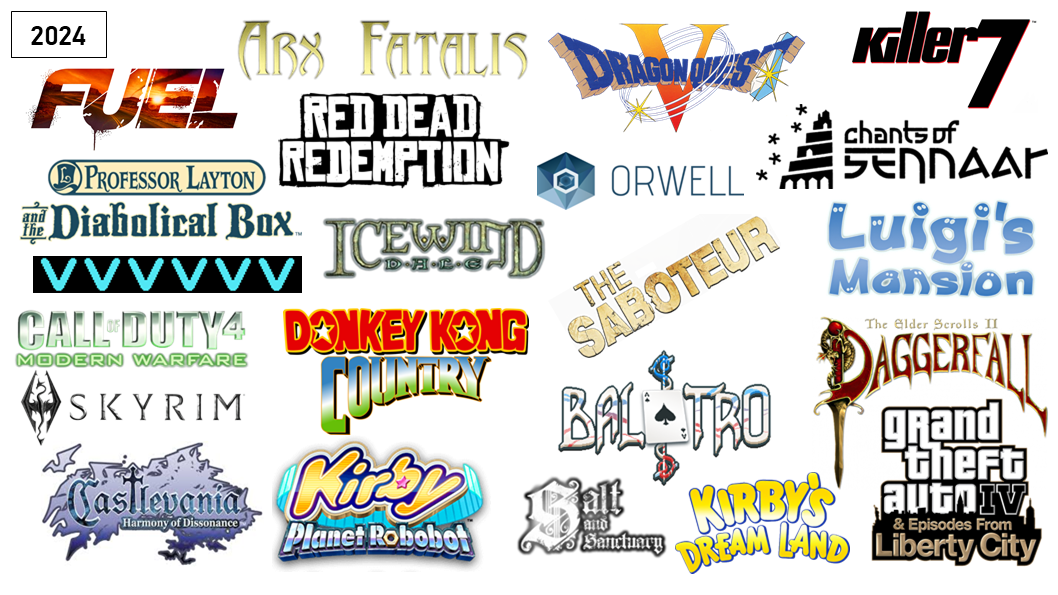
Inspired by Thranto (https://howlongtobeat.com/forum/thread/2322/1), I decided to make an infographic with all the logos of the games that I've played this year. I actually finished a lot of games, I'm impressed! I had also few time to game, probably I was just more focused into finishing the games rather than play around and abandon games halfway.
I actually played a lot of platformers (6, counting the Castlevania and Salt and Sanctuary as such) and RPGs (4). Instead of playing a Final Fantasy I decided to play Dragon Quest, but this year I definitely return to my old habits with FF IX or IV. Next year I will try to vary a little more the genre of the game that I play, I didn't know that my year was so focused on two genres until now.
The GOTY of my year is definitely Chants of Sennaar. It was a fantastic experience, perfect in every detail. The Rockstar duo (Red Dead Redemption and GTA IV + DLCs) take the rest of the podium, they were truly unique experiences.
The biggest delusions of this year instead are The Saboteur and Arx Fatalis. The first was too hyped for me, everywhere was called "a true hidden gem" and such, but it was only a mediocre game with a very great presentation. The second has an extremely interesting premise, but it fails to deliver a polished experience.
The next year I'm looking forward playing Modern Warfare 2, a Final Fantasy, Castlevania: Aria of Sorrow, and complete the Batman Arkham games with Asylum and Origins (which I already bought at a flea market). I also want to play something again on my Game Boy (probably TLoZ: Link's Awakening) and on my PSX (FF or Tomb Raider). I need also to play Baldur's Gate 2 sooner or later, to know the end of the story that I started with the first game some years ago.
That's all for this year! I haven't reviewed RDR and Orwell yet, so you know the topic of my next posts. I'll probably resurrect after New Year's Eve!
YEARLY RECAP

Inspired by Thranto (https://howlongtobeat.com/forum/thread/2322/1), I decided to make an infographic with all the logos of the games that I've played this year. I actually finished a lot of games, I'm impressed! I had also few time to game, probably I was just more focused into finishing the games rather than play around and abandon games halfway.
I actually played a lot of platformers (6, counting the Castlevania and Salt and Sanctuary as such) and RPGs (4). Instead of playing a Final Fantasy I decided to play Dragon Quest, but this year I definitely return to my old habits with FF IX or IV. Next year I will try to vary a little more the genre of the game that I play, I didn't know that my year was so focused on two genres until now.
The GOTY of my year is definitely Chants of Sennaar. It was a fantastic experience, perfect in every detail. The Rockstar duo (Red Dead Redemption and GTA IV + DLCs) take the rest of the podium, they were truly unique experiences.
The biggest delusions of this year instead are The Saboteur and Arx Fatalis. The first was too hyped for me, everywhere was called "a true hidden gem" and such, but it was only a mediocre game with a very great presentation. The second has an extremely interesting premise, but it fails to deliver a polished experience.
The next year I'm looking forward playing Modern Warfare 2, a Final Fantasy, Castlevania: Aria of Sorrow, and complete the Batman Arkham games with Asylum and Origins (which I already bought at a flea market). I also want to play something again on my Game Boy (probably TLoZ: Link's Awakening) and on my PSX (FF or Tomb Raider). I need also to play Baldur's Gate 2 sooner or later, to know the end of the story that I started with the first game some years ago.
That's all for this year! I haven't reviewed RDR and Orwell yet, so you know the topic of my next posts. I'll probably resurrect after New Year's Eve!
4 Yrs✓#
f_n_c
4 Yrs✓#
UPDATE #16
Here we are with the first retirement recorded on the blog. I rarely retire from games, since I generally document in advance what I buy and play to avoid wasting time. I thought that Indiana Jones was my piece of cake, but it was just too old to be enjoyable with my total inexperience in graphical adventures. The only old graphical adventure that I played in my whole life is Broken Sword, and the difficulty of Indiana Jones, paired with the awful and messy combat and almost lack of music, put me off. I'll play another graphical adventure soon, but for now I retire this one once I'm a little more experienced.
-------------------------------------------------------------------------------------------------------------------------------------------------------------------------------------------------------------------------
I have just to start Aria. I played the whole Metal Slug 1 in two small sittings with an average continue number. I'll probably review it when I finish the first three games, since I want to do a full mainline series playthrough.
Indiana Jones and the Last Crusade - PC (Amazon Prime Games)
SCORE: RETIRED
Here we are with the first retirement recorded on the blog. I rarely retire from games, since I generally document in advance what I buy and play to avoid wasting time. I thought that Indiana Jones was my piece of cake, but it was just too old to be enjoyable with my total inexperience in graphical adventures. The only old graphical adventure that I played in my whole life is Broken Sword, and the difficulty of Indiana Jones, paired with the awful and messy combat and almost lack of music, put me off. I'll play another graphical adventure soon, but for now I retire this one once I'm a little more experienced.
-------------------------------------------------------------------------------------------------------------------------------------------------------------------------------------------------------------------------
CURRENTLY PLAYING
- Castlevania: Aria of Sorrow - Xbox One
- Metal Slug 2 - Emulated
I have just to start Aria. I played the whole Metal Slug 1 in two small sittings with an average continue number. I'll probably review it when I finish the first three games, since I want to do a full mainline series playthrough.
4 Yrs✓#
f_n_c
4 Yrs✓#
UPDATE #17
New year, new reviews! I decided to change things a little bit, adding more information at the start and in the end. Hope you enjoy it!
INTRODUCTION
I admit that when I had to choose a genre for Orwell, I was conflicted. I identify with the genre "Textual Adventure," generally games like Zork and other interactive fiction. Then I added "Simulation," another long stretch, but that complemented well with the other genre. Because Orwell is a simulation, but of something that doesn't exist.
Orwell takes place in our world, but only fictional states are mentioned. One of these fictional nations, called only "the Nation," has developed a super-advanced spying tool that scrapes information from internet repositories to identify criminals and help with their capture. The player assumes the role of the first human operator of the system, which works in tandem with an overseer to collect information useful to capture the culprits of a terrorist attack. The plot develops fast from here, with a lot of plot twists. This game was originally released in an episodic form, and it shows. The game is divided into chapters, with a big cliffhanger at the end of each one that maintains the player's attention.
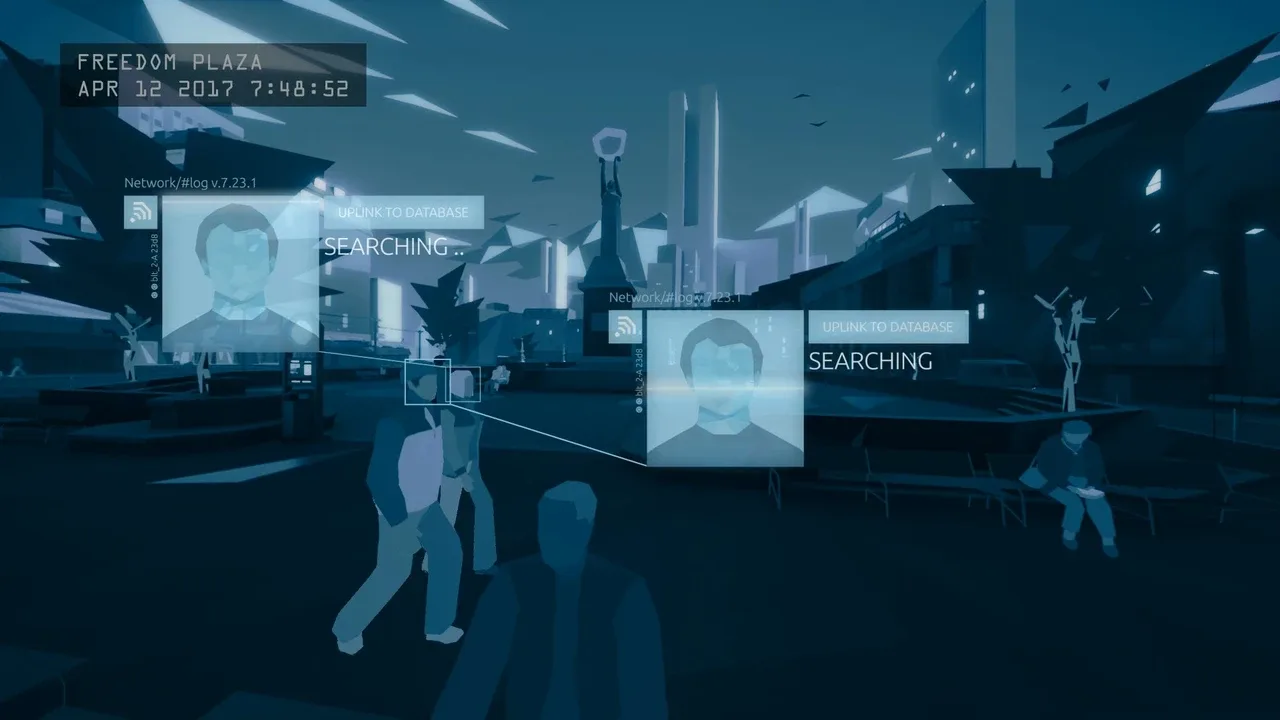
The starting cutscene, that shows the terrorist attack that starts the whole plot
GAMEPLAY
First of all, the game has an incredible UI. The player is a user of the Orwell surveillance system, and everything in the game (from the main menu) is styled to mimic a computer program. Here is an example of a typical game window:
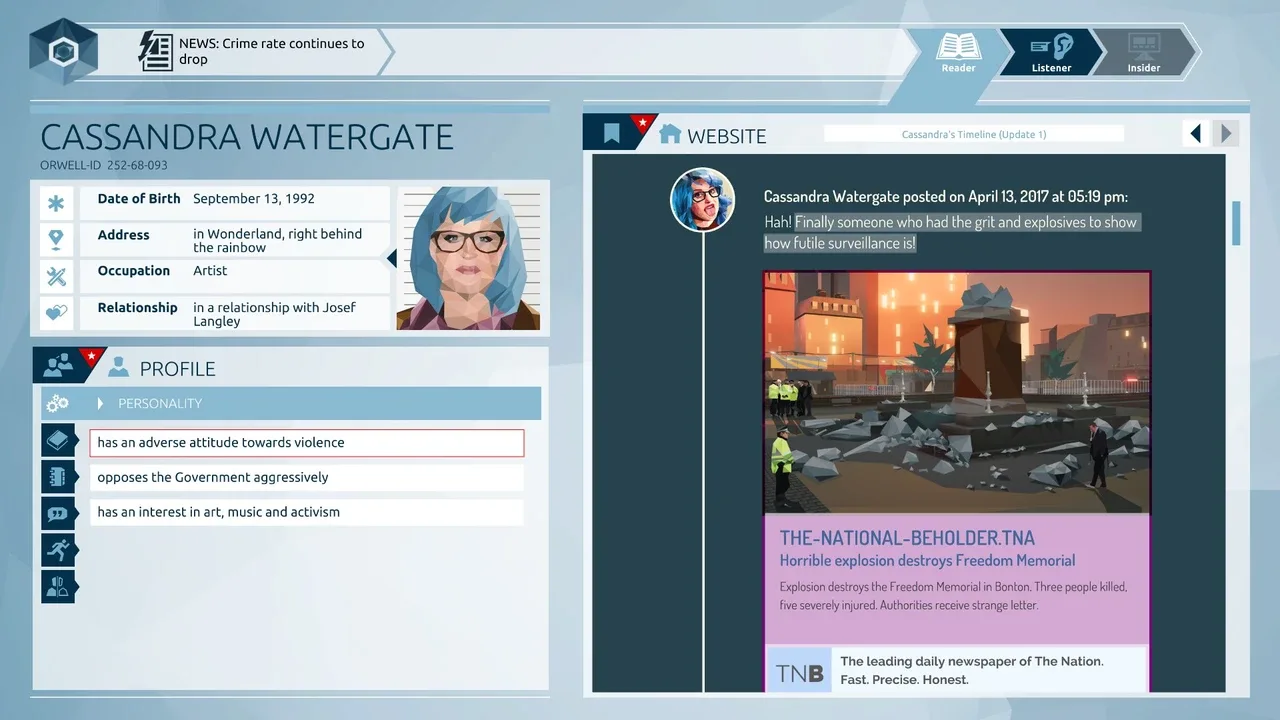
As you can see, on the right half of the screen there is the research tab, where you can explore websites and also listen to conversations between suspects and spy on their PCs when particular conditions are met. When an interesting chunk of information is found, it is highlighted, and the player can drag and drop it into the left half of the screen, where it is automatically transformed into new information on the bio of the relative character. Sometimes two different pieces of information conflict with each other, and the player must decide which is the true one to upload on the bio. When information is uploaded, it can't be canceled and can be "seen" also by the overseer, who often comments and gives the player new objectives.
The game is all here, in all its simplicity. The player can decide which information to upload and give to the overseer, thus condemning or absolving some characters on purpose. The player must transmit some key information in order to advance the plot, but even in the first chapter, the uploads chosen can change minor parts of the story. In the final chapter, the decisions taken in the previous ones have a direct impact, and the player can choose the final outcome of the game.
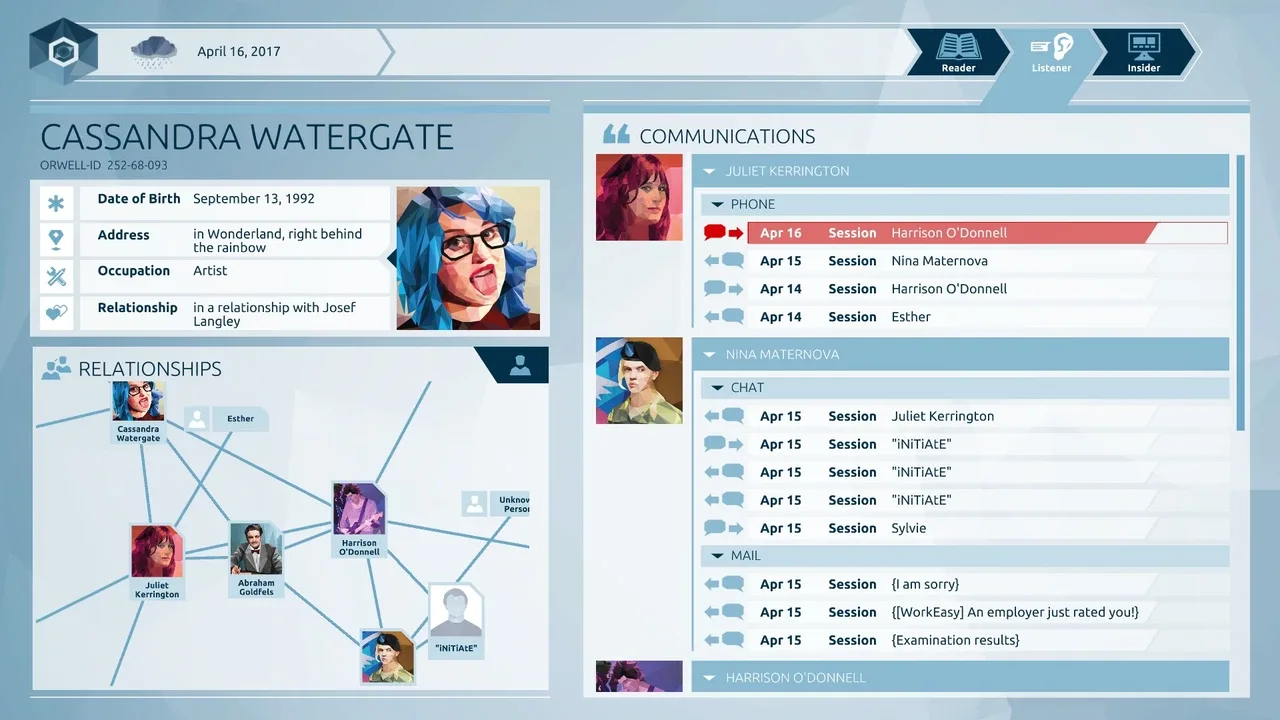
On the bottom-left there is also a cool net that shows relationships between all the characters of the game
I would have preferred a little more decisional power also in the first chapters, instead of deciding the whole plot with a unique final decision. On the other hand, managing such complexity could have been overwhelming for the developers, who probably have decided to play a safer route. There are no repercussions (aside from a scolding from your virtual overseer) when you give irrelevant information, and there is no scoring system. The only reward for your actions is the endings, which can change minimally depending on your overall choices.
FINAL CONSIDERATIONS
Orwell is a great game, but most importantly, it is an actual game. Even if everything is fictional, it highlights real problems in the relationship between humans and the web. Repressive systems, the online footprint that every person has, safety, and personal freedom are all widely discussed themes, but this game adds the interactivity and a rudimental player behavioral analysis to the equation, making them really stick. The player, through different publicly available sites, can tie different and unrelated information chunks together to tell a story, and framing someone as a possible terrorist is shockingly easy.
The plot is short but touches its themes really well, while the whole game is designed intelligently and doesn't overstay its welcome. I got the game for free, but it's often on sale for dirt cheap. Absolutely recommended!
FINAL SCORE: 8.5/10
-------------------------------------------------------------------------------------------------------------------------------------------------------------------------------------------------------------------------
Played just 5 minutes of Castlevania. Metal Slug 2 is better than the first, but the slowdowns from the middle game onwards are unbearable sadly. Thrilled to start the best Metal Slug game (and the only that I remember playing).
New year, new reviews! I decided to change things a little bit, adding more information at the start and in the end. Hope you enjoy it!
Orwell: Keeping an Eye on You - PC (Free Epic game)
Genre: Textual Adventure, Simulation
Developer/Year: Osmotic Studios, 2016
SCORE: 8.5/10
INTRODUCTION
I admit that when I had to choose a genre for Orwell, I was conflicted. I identify with the genre "Textual Adventure," generally games like Zork and other interactive fiction. Then I added "Simulation," another long stretch, but that complemented well with the other genre. Because Orwell is a simulation, but of something that doesn't exist.
Orwell takes place in our world, but only fictional states are mentioned. One of these fictional nations, called only "the Nation," has developed a super-advanced spying tool that scrapes information from internet repositories to identify criminals and help with their capture. The player assumes the role of the first human operator of the system, which works in tandem with an overseer to collect information useful to capture the culprits of a terrorist attack. The plot develops fast from here, with a lot of plot twists. This game was originally released in an episodic form, and it shows. The game is divided into chapters, with a big cliffhanger at the end of each one that maintains the player's attention.

The starting cutscene, that shows the terrorist attack that starts the whole plot
GAMEPLAY
First of all, the game has an incredible UI. The player is a user of the Orwell surveillance system, and everything in the game (from the main menu) is styled to mimic a computer program. Here is an example of a typical game window:

As you can see, on the right half of the screen there is the research tab, where you can explore websites and also listen to conversations between suspects and spy on their PCs when particular conditions are met. When an interesting chunk of information is found, it is highlighted, and the player can drag and drop it into the left half of the screen, where it is automatically transformed into new information on the bio of the relative character. Sometimes two different pieces of information conflict with each other, and the player must decide which is the true one to upload on the bio. When information is uploaded, it can't be canceled and can be "seen" also by the overseer, who often comments and gives the player new objectives.
The game is all here, in all its simplicity. The player can decide which information to upload and give to the overseer, thus condemning or absolving some characters on purpose. The player must transmit some key information in order to advance the plot, but even in the first chapter, the uploads chosen can change minor parts of the story. In the final chapter, the decisions taken in the previous ones have a direct impact, and the player can choose the final outcome of the game.

On the bottom-left there is also a cool net that shows relationships between all the characters of the game
I would have preferred a little more decisional power also in the first chapters, instead of deciding the whole plot with a unique final decision. On the other hand, managing such complexity could have been overwhelming for the developers, who probably have decided to play a safer route. There are no repercussions (aside from a scolding from your virtual overseer) when you give irrelevant information, and there is no scoring system. The only reward for your actions is the endings, which can change minimally depending on your overall choices.
FINAL CONSIDERATIONS
Orwell is a great game, but most importantly, it is an actual game. Even if everything is fictional, it highlights real problems in the relationship between humans and the web. Repressive systems, the online footprint that every person has, safety, and personal freedom are all widely discussed themes, but this game adds the interactivity and a rudimental player behavioral analysis to the equation, making them really stick. The player, through different publicly available sites, can tie different and unrelated information chunks together to tell a story, and framing someone as a possible terrorist is shockingly easy.
The plot is short but touches its themes really well, while the whole game is designed intelligently and doesn't overstay its welcome. I got the game for free, but it's often on sale for dirt cheap. Absolutely recommended!
FINAL SCORE: 8.5/10
-------------------------------------------------------------------------------------------------------------------------------------------------------------------------------------------------------------------------
CURRENTLY PLAYING
- Castlevania Aria of Sorrow - Xbox One
- Metal Slug 3 - Emulated
Played just 5 minutes of Castlevania. Metal Slug 2 is better than the first, but the slowdowns from the middle game onwards are unbearable sadly. Thrilled to start the best Metal Slug game (and the only that I remember playing).
4 Yrs✓#
f_n_c
4 Yrs✓#
UPDATE #18
INTRODUCTION
After Red Dead Redemption 2, everyone knows Red Dead Redemption (RDR), so I'll keep this review short and focused. RDR follows the adventures of John Marston, who is forced by the early federals to hunt his former outlaw companion to save his family.
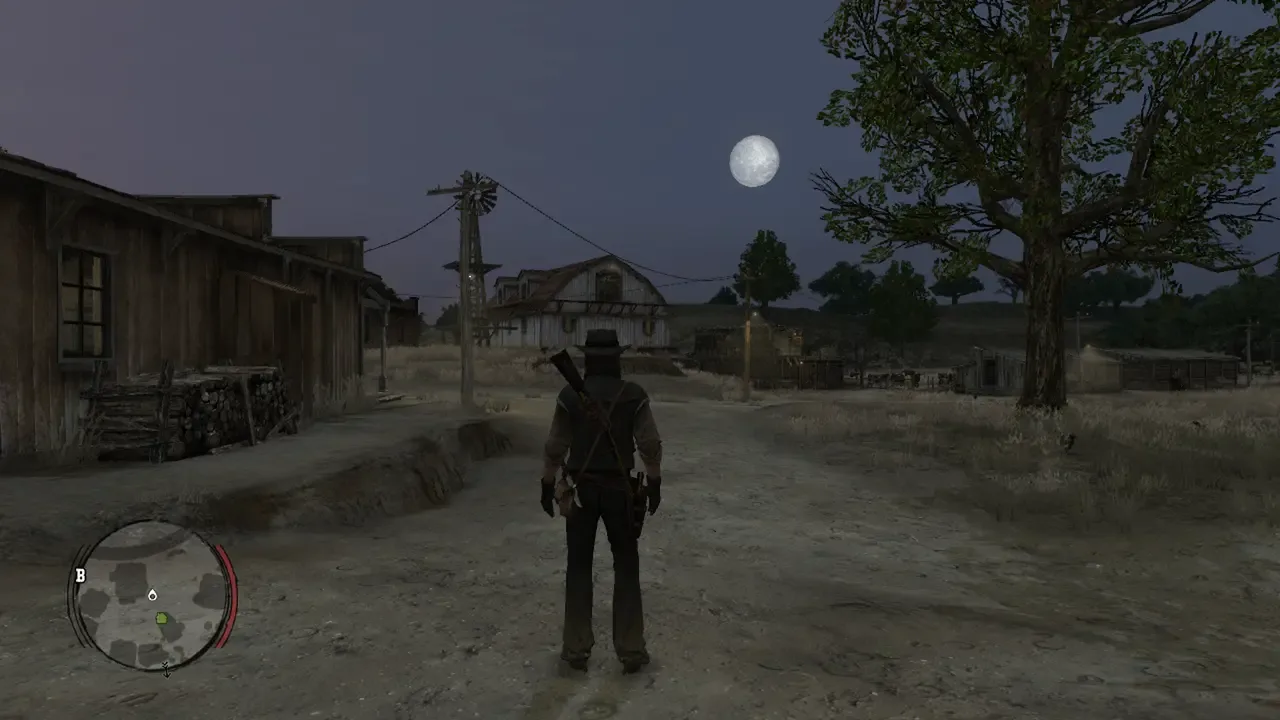
MacFarlane's Ranch, the first location of the game
I start by saying that the game hits definitely differently if you have played RDR 2 before, like me. You already know John and his family, his old gang, and all the backstory behind John's past. So a lot of the plot twists of the game fall relatively flat, but the plot remains solid as a rock. It has definitely a darker and more depressing tone compared to RDR 2, since the Wild West is not dying, but it's already rotting in its tomb.
GAMEPLAY AND TECHNICAL ASPECTS
After the first Rockstar's foray onto the PS3/Xbox 360 generation with GTA IV, they acquired experience and managed to understand what they did wrong and tried to correct it with mixed success. The two games actually share a lot, starting from the very dark story compared to Rockstar's standards. I loved every second of it, and ditching the multiple endings of GTA IV helped to create something that remains cohesive until the very end. The game develops John really well but doesn't have the deep cast characterization that made RDR 2 outstanding.
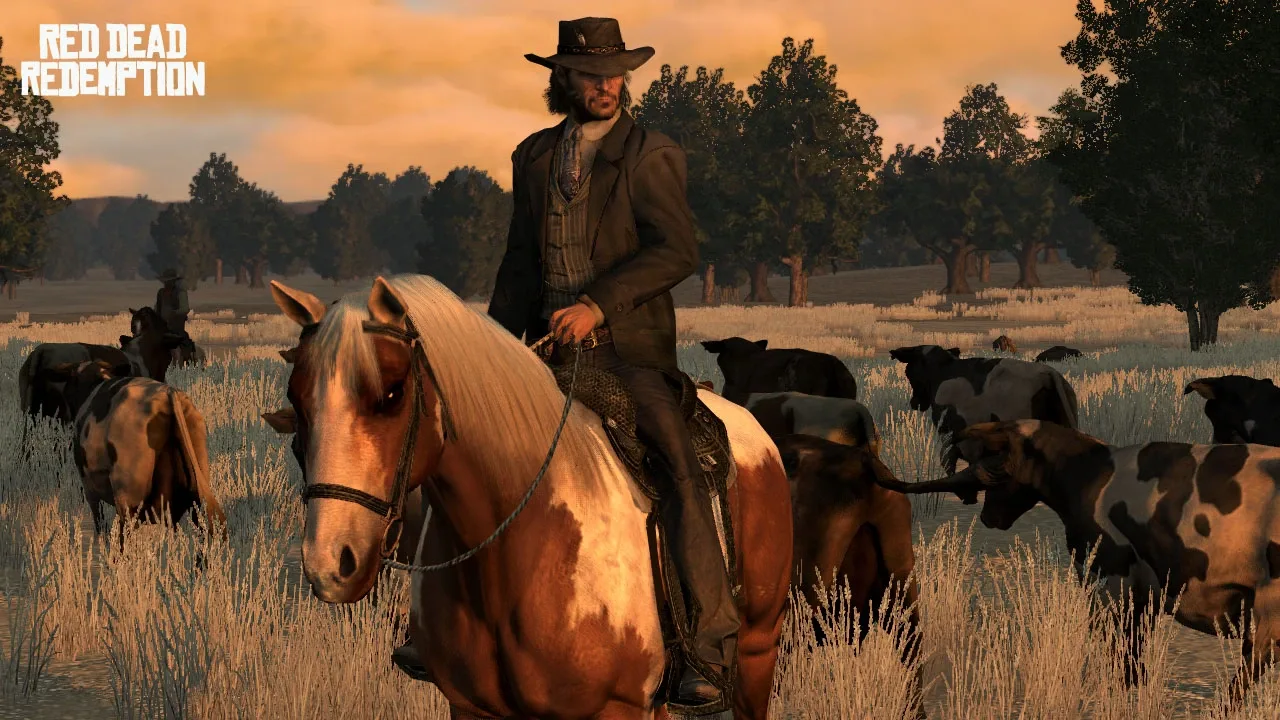
The game has some ranch-life related minigames, introduced with the first missions
The missions are fun and in full Rockstar style for the most part: drive, shoot, escape, and end. The game, using different mission types, really describes well the changes in John's life during the development of the plot, even if sometimes it sacrifices the fun by introducing rather boring missions. The secondary missions (strangers) are really depressing but well done, a definite tonal shift compared to GTA IV. Generally are very simple, constituting a small but welcome deviation from the main plot.
Aside from missions, there are a wide variety of minigames to do throughout the world (poker, liar's dice, arm wrestling, five-finger fillet, etc.) but they are fun only for a couple of plays. Marston can also hunt wanted men through wanted posters, but the system behind the activation of these missions is strange and unreliable since they appear semi-randomly on the map, and if you wait too long, they disappear. Sadly, after finishing the game and the stranger missions, the world seems empty, and there are few reasons to continue playing. Hunting, challenges, and unlockable outfits are a hit-or-miss and appeal only to hardcore collectors.
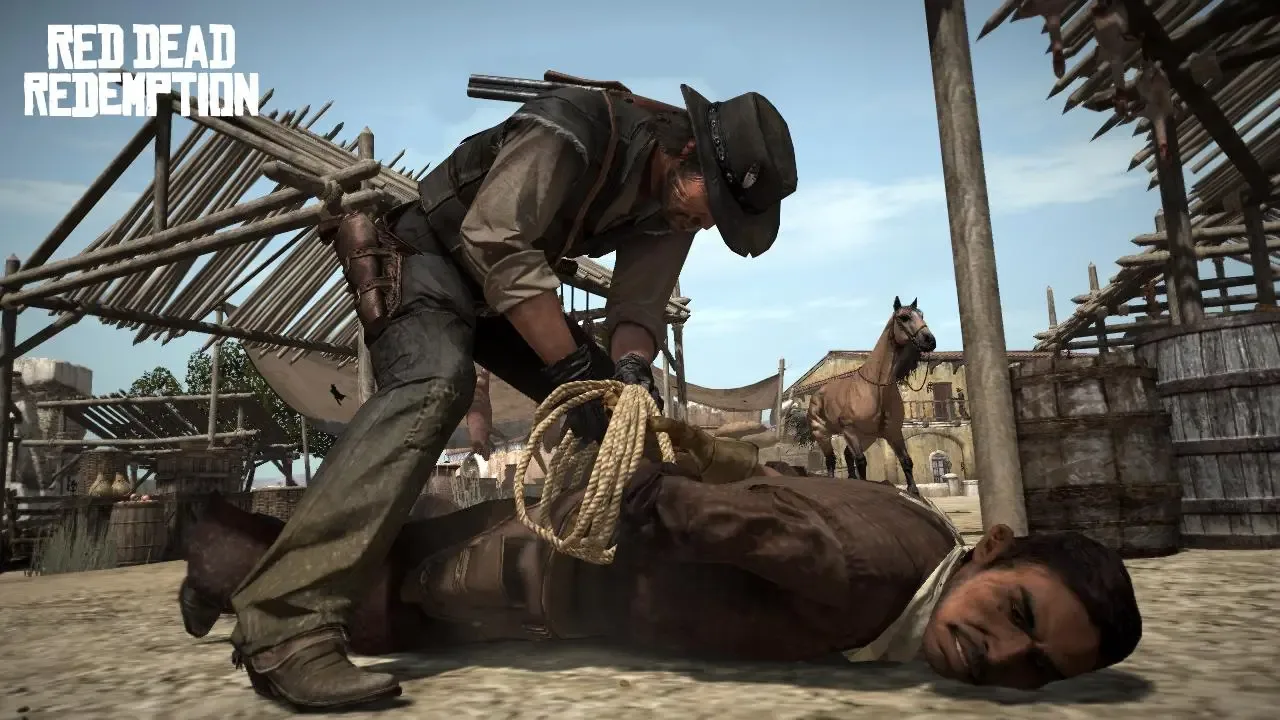
Marston can hogtie wanted criminals to deliver them alive to the law to gain a double pay
The gameplay is the classic GTA-style TPS perfected by Rockstar through the years. Mowing down scores of bad guys is always fun, and there is also a very wide choice of weapons, comparable to RDR 2. Often the game throws at the player an exaggerated number of enemies to ramp up the difficulty, which causes the problem common to all of Rockstar's production of a rift between the very serious narration and actual gameplay. Riding the horse is fun, and managing the stamina meter is a good compromise between realism and game mechanics, but the horses have severe AI problems when they are not mounted. I had two horses suiciding themselves by running towards Marston when called, only to take strange paths and end in chasms or water. The game feels rather unpolished at times, and on several occasions I was forced to load the game and lose all the progress of a mission due to fatal collision bugs.
Last, a small analysis on the soundtrack. Compared to RDR 2, it feels definitely like a smaller production with fewer country songs to highlight special parts of the plot. On the other hand, I think that the music themes are much better made compared to RDR 2, and they follow the player actions and travels brilliantly. The switch between the more western/country orchestration of the ambient music of the USA and the trumpet-driven orchestration of Mexican music is really awesome.
FINAL CONSIDERATIONS
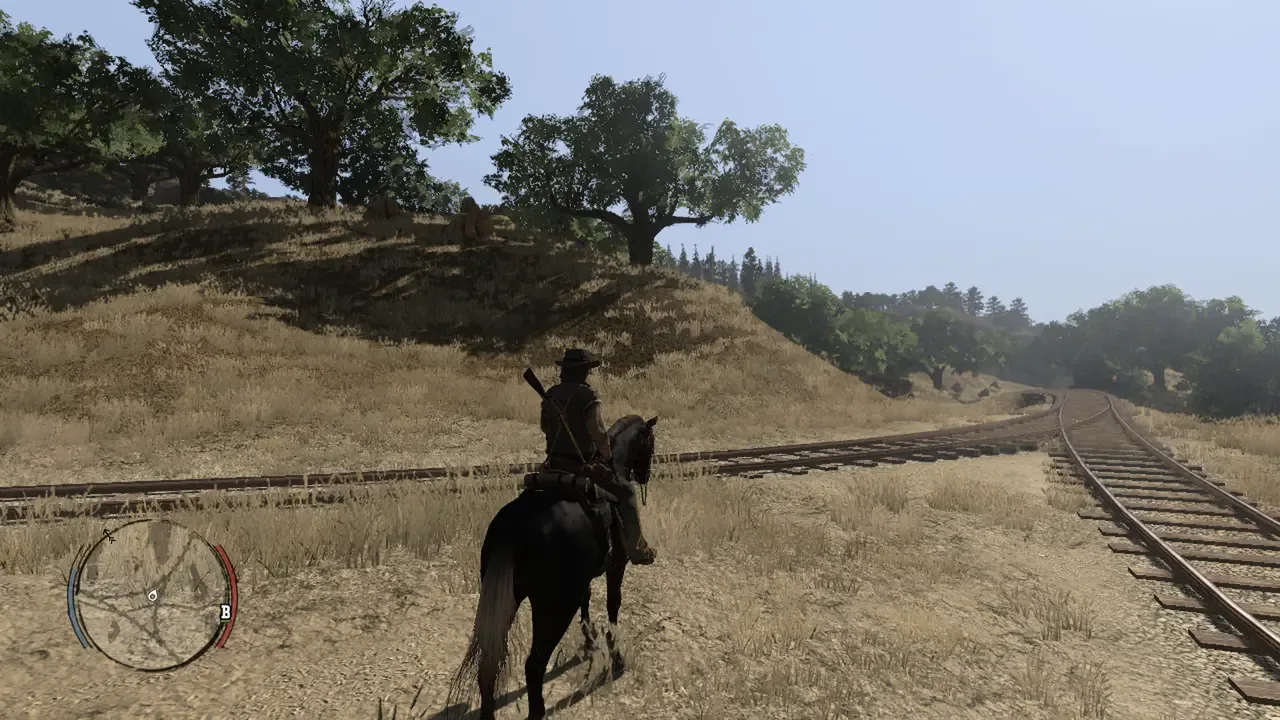
Graphically the game holds up well
RDR 1 ran so RDR 2 could be a high-speed train. Compared to the sequel, it is a definite step down, but comparing it with other 2010 games really puts some perspective. RDR is a unique experience that was unmatched at the time, which suffers from the chronic Rockstar problems. Graphically, it is still a marvel, and riding in the sunset with John Marston still evokes strong feelings despite the 15 years that have passed since its release. A classic of gaming that needs to be played regardless of preferences and prejudices on the western theme.
A final remark. I bought a cheap copy of the game online. It is outrageous that after the publication of the Switch version, the cost of the game was set at 30€ also on the other consoles. It is the same game as before, but Rockstar decided to raise the price regardless to adapt it to the Switch one. A true pity, and a big red flag on Rockstar's future, sadly.
FINAL SCORE: 9/10
-------------------------------------------------------------------------------------------------------------------------------------------------------------------------------------------------------------------------
SMT4 feels though but extremely modern, compared with the first one. I hope that my playthough won't end abruptly like the first one.
The Case of the Golden Idol is almost finished. Great, but some deductions feels too though. Extremely fresh and entertaining.
Red Dead Redemption - Xbox One
Genre: Open World Adventure, Third Person Shooter
Developer/Year: Rockstar North, 2010
SCORE: 9/10
INTRODUCTION
After Red Dead Redemption 2, everyone knows Red Dead Redemption (RDR), so I'll keep this review short and focused. RDR follows the adventures of John Marston, who is forced by the early federals to hunt his former outlaw companion to save his family.

MacFarlane's Ranch, the first location of the game
I start by saying that the game hits definitely differently if you have played RDR 2 before, like me. You already know John and his family, his old gang, and all the backstory behind John's past. So a lot of the plot twists of the game fall relatively flat, but the plot remains solid as a rock. It has definitely a darker and more depressing tone compared to RDR 2, since the Wild West is not dying, but it's already rotting in its tomb.
GAMEPLAY AND TECHNICAL ASPECTS
After the first Rockstar's foray onto the PS3/Xbox 360 generation with GTA IV, they acquired experience and managed to understand what they did wrong and tried to correct it with mixed success. The two games actually share a lot, starting from the very dark story compared to Rockstar's standards. I loved every second of it, and ditching the multiple endings of GTA IV helped to create something that remains cohesive until the very end. The game develops John really well but doesn't have the deep cast characterization that made RDR 2 outstanding.

The game has some ranch-life related minigames, introduced with the first missions
The missions are fun and in full Rockstar style for the most part: drive, shoot, escape, and end. The game, using different mission types, really describes well the changes in John's life during the development of the plot, even if sometimes it sacrifices the fun by introducing rather boring missions. The secondary missions (strangers) are really depressing but well done, a definite tonal shift compared to GTA IV. Generally are very simple, constituting a small but welcome deviation from the main plot.
Aside from missions, there are a wide variety of minigames to do throughout the world (poker, liar's dice, arm wrestling, five-finger fillet, etc.) but they are fun only for a couple of plays. Marston can also hunt wanted men through wanted posters, but the system behind the activation of these missions is strange and unreliable since they appear semi-randomly on the map, and if you wait too long, they disappear. Sadly, after finishing the game and the stranger missions, the world seems empty, and there are few reasons to continue playing. Hunting, challenges, and unlockable outfits are a hit-or-miss and appeal only to hardcore collectors.

Marston can hogtie wanted criminals to deliver them alive to the law to gain a double pay
The gameplay is the classic GTA-style TPS perfected by Rockstar through the years. Mowing down scores of bad guys is always fun, and there is also a very wide choice of weapons, comparable to RDR 2. Often the game throws at the player an exaggerated number of enemies to ramp up the difficulty, which causes the problem common to all of Rockstar's production of a rift between the very serious narration and actual gameplay. Riding the horse is fun, and managing the stamina meter is a good compromise between realism and game mechanics, but the horses have severe AI problems when they are not mounted. I had two horses suiciding themselves by running towards Marston when called, only to take strange paths and end in chasms or water. The game feels rather unpolished at times, and on several occasions I was forced to load the game and lose all the progress of a mission due to fatal collision bugs.
Last, a small analysis on the soundtrack. Compared to RDR 2, it feels definitely like a smaller production with fewer country songs to highlight special parts of the plot. On the other hand, I think that the music themes are much better made compared to RDR 2, and they follow the player actions and travels brilliantly. The switch between the more western/country orchestration of the ambient music of the USA and the trumpet-driven orchestration of Mexican music is really awesome.
FINAL CONSIDERATIONS

Graphically the game holds up well
RDR 1 ran so RDR 2 could be a high-speed train. Compared to the sequel, it is a definite step down, but comparing it with other 2010 games really puts some perspective. RDR is a unique experience that was unmatched at the time, which suffers from the chronic Rockstar problems. Graphically, it is still a marvel, and riding in the sunset with John Marston still evokes strong feelings despite the 15 years that have passed since its release. A classic of gaming that needs to be played regardless of preferences and prejudices on the western theme.
A final remark. I bought a cheap copy of the game online. It is outrageous that after the publication of the Switch version, the cost of the game was set at 30€ also on the other consoles. It is the same game as before, but Rockstar decided to raise the price regardless to adapt it to the Switch one. A true pity, and a big red flag on Rockstar's future, sadly.
FINAL SCORE: 9/10
-------------------------------------------------------------------------------------------------------------------------------------------------------------------------------------------------------------------------
CURRENTLY PLAYING
- Shin Megami Tensei 4 - 3DS
- The Case of the Golden Idol - PC
SMT4 feels though but extremely modern, compared with the first one. I hope that my playthough won't end abruptly like the first one.
The Case of the Golden Idol is almost finished. Great, but some deductions feels too though. Extremely fresh and entertaining.
4 Yrs✓#
f_n_c
4 Yrs✓#
UPDATE #19
I'm still here! I had not a lot motivation to write these months but now I'm back, and I have some games to review so brace yourselves.
THE GAME
I played the Arkham series in reverse order, starting with Knight and ending with Asylum. I went in without expecting much compared to the later installments, especially City, but I was wrong.
Asylum starts with the Joker arrested and stashed in the Batmobile while Batman is speeding towards Arkham Asylum. After a brief introduction during which the Joker is taken into custody, he is freed by a corrupted guard and plunges the whole island into chaos. Helped by some of the most famous Gotham City villains, he manages to drag Batman in a wild goose chase around the whole island.
First of all, Asylum has the best story and atmosphere of all the Arkham games. The island oozes personality, with different, believable buildings and a sprawling underground. Batman is pestered continuously by the Joker, who sends him communications through TVs and loudspeakers. Mark Hamill is an incredible Joker, and also the other actors do a good job. The island is decadent and dark, with big open spaces stalked by snipers that act as hubs between the more railroaded and closed buildings.
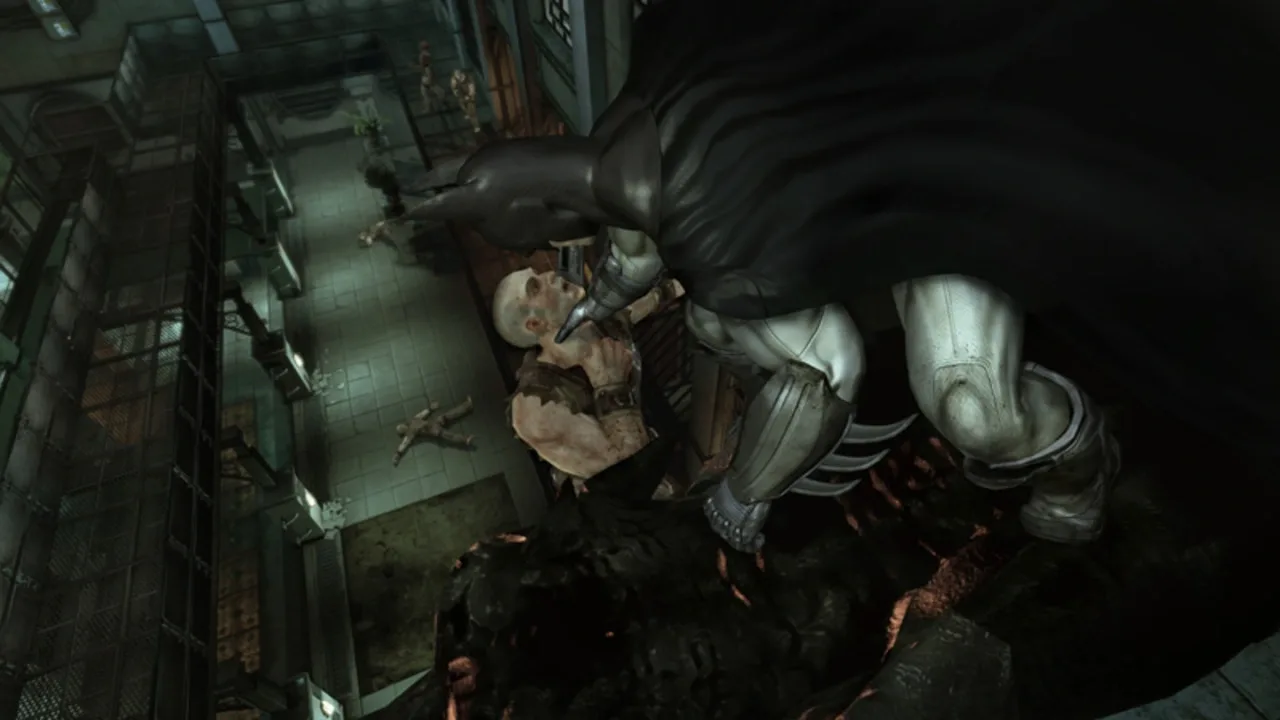
Leaving people hanging from stone gargoyles instill palpable fear in the enemies
The gameplay has all the elements of the famous Rocksteady formula: beatings with multiple thugs, stealth sections and exploration with hidden riddler thropies that can be accessed through the unlocked gadgets. The stealth sections were my favourite, since seeing the thugs descend gradually into panic as Batman takes out their mates gives the right "unstoppable dark force" feeling generally associated to the superhero. The game really balances the adventure and horror, with a lone Batman trapped in a island where the villains have the upper hand. Some sections, like the ones induced by Scarecrow's fear gas are brilliant, and create some welcome breaks from the normal action
Speaking of gadgets, having a more railroaded experience compared to later entries gives the game a slight metroidvania feel, with areas that can't be accessed until the story gives the Batman the right gadget. The upgrades for the gadgets and Batman sadly are not very interesting, and they are chosen from a simple horizontal list. Every gadget has its own function that is exploited also in the boss fights, that are varied and sometimes introduce also some specific gimmicks to surprise the player. The boss fights are on the easy side, while some stealth sections towards the end require some tries to be completed.
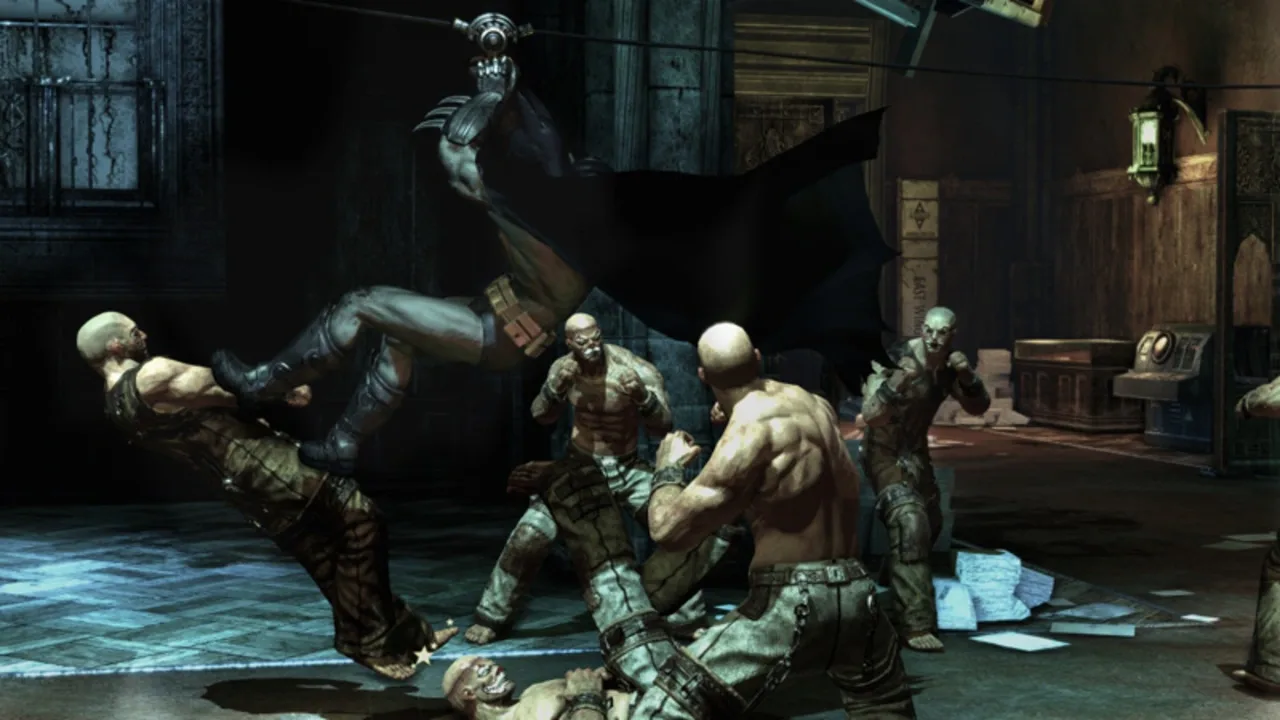
Fighting multiple thugs at the same time is not very difficult, but keeping the combo multiplier active requires some effort
FINAL CONSIDERATIONS
Asylum is a fantastic game, laser-focused on fun that doesn't sidetrack or dilute its formula too much. It could seem short, but it has a balanced difficulty and doesn't overstay its welcome. I had the GOTY edition, but it adds only a couple of forgettable challenge maps. Sadly, at least for me, aside from the Riddler's trophies hunt and the main game, there isn't much content, and the challenges are not really worth more than a couple of minutes. Definitely recommended to anyone, especially to those that have played only the more recent games. The graphic holds up really well also today, and the island is wisely divided into areas that don't make the necessary content loadings too cumbersome.
FINAL SCORE: 9/10
-------------------------------------------------------------------------------------------------------------------------------------------------------------------------------------------------------------------------
Shin Megami Tensei is going well, but it's a strange game. I love it and it's similar to the first one, but it has also a lot of little flaws that are impossible to ignore.
Gunslinger is actually brilliant. A game that uses its tight budget in an extremely intelligent matter, delivering a top experience without too much funds. Fast and fun, the only flaw for now is that the main character's accent and his fast diction make the narration difficult to follow for a non native english speaker as me.
I'm still here! I had not a lot motivation to write these months but now I'm back, and I have some games to review so brace yourselves.
Batman: Arkham Asylum GOTY - PS3
Genre: Beat 'em up adventure
Developer/Year: Rocksteady, 2009
SCORE: 9/10
THE GAME
I played the Arkham series in reverse order, starting with Knight and ending with Asylum. I went in without expecting much compared to the later installments, especially City, but I was wrong.
Asylum starts with the Joker arrested and stashed in the Batmobile while Batman is speeding towards Arkham Asylum. After a brief introduction during which the Joker is taken into custody, he is freed by a corrupted guard and plunges the whole island into chaos. Helped by some of the most famous Gotham City villains, he manages to drag Batman in a wild goose chase around the whole island.
First of all, Asylum has the best story and atmosphere of all the Arkham games. The island oozes personality, with different, believable buildings and a sprawling underground. Batman is pestered continuously by the Joker, who sends him communications through TVs and loudspeakers. Mark Hamill is an incredible Joker, and also the other actors do a good job. The island is decadent and dark, with big open spaces stalked by snipers that act as hubs between the more railroaded and closed buildings.

Leaving people hanging from stone gargoyles instill palpable fear in the enemies
The gameplay has all the elements of the famous Rocksteady formula: beatings with multiple thugs, stealth sections and exploration with hidden riddler thropies that can be accessed through the unlocked gadgets. The stealth sections were my favourite, since seeing the thugs descend gradually into panic as Batman takes out their mates gives the right "unstoppable dark force" feeling generally associated to the superhero. The game really balances the adventure and horror, with a lone Batman trapped in a island where the villains have the upper hand. Some sections, like the ones induced by Scarecrow's fear gas are brilliant, and create some welcome breaks from the normal action
Speaking of gadgets, having a more railroaded experience compared to later entries gives the game a slight metroidvania feel, with areas that can't be accessed until the story gives the Batman the right gadget. The upgrades for the gadgets and Batman sadly are not very interesting, and they are chosen from a simple horizontal list. Every gadget has its own function that is exploited also in the boss fights, that are varied and sometimes introduce also some specific gimmicks to surprise the player. The boss fights are on the easy side, while some stealth sections towards the end require some tries to be completed.

Fighting multiple thugs at the same time is not very difficult, but keeping the combo multiplier active requires some effort
FINAL CONSIDERATIONS
Asylum is a fantastic game, laser-focused on fun that doesn't sidetrack or dilute its formula too much. It could seem short, but it has a balanced difficulty and doesn't overstay its welcome. I had the GOTY edition, but it adds only a couple of forgettable challenge maps. Sadly, at least for me, aside from the Riddler's trophies hunt and the main game, there isn't much content, and the challenges are not really worth more than a couple of minutes. Definitely recommended to anyone, especially to those that have played only the more recent games. The graphic holds up really well also today, and the island is wisely divided into areas that don't make the necessary content loadings too cumbersome.
FINAL SCORE: 9/10
-------------------------------------------------------------------------------------------------------------------------------------------------------------------------------------------------------------------------
CURRENTLY PLAYING
- Shin Megami Tensei 4 - 3DS
- Call of Juarez: Gunslinger - Amazon Luna
Shin Megami Tensei is going well, but it's a strange game. I love it and it's similar to the first one, but it has also a lot of little flaws that are impossible to ignore.
Gunslinger is actually brilliant. A game that uses its tight budget in an extremely intelligent matter, delivering a top experience without too much funds. Fast and fun, the only flaw for now is that the main character's accent and his fast diction make the narration difficult to follow for a non native english speaker as me.
4 Yrs✓#
f_n_c
4 Yrs✓#
UPDATE #20
Review number 20! Quite a milestone.
INTRODUCTION AND GAMEPLAY
Dredge was maybe the biggest indie surprise of 2023, gaining a massive following and an almost unanimous good consensus. I love Lovecraftian horror, and this game was given for free with my Prime subscription. In addition, it was also available on Amazon Luna, representing the perfect occasion to test the service.
In Dredge the player is a fisherman, crashing his boat in a strange archipelago. A small boat is given to the player along with a debt to repay fishing. Fish during the day is safe, but during the night more valuable fish appear. The night tends also to increase the panic meter of the player, and having high panic means that it's more probable to be attacked by a Lovecraftian abomination. Obviously, the game after the first introductory phases pushes you to go out during the night, and the player is forced to take some calculated risks.
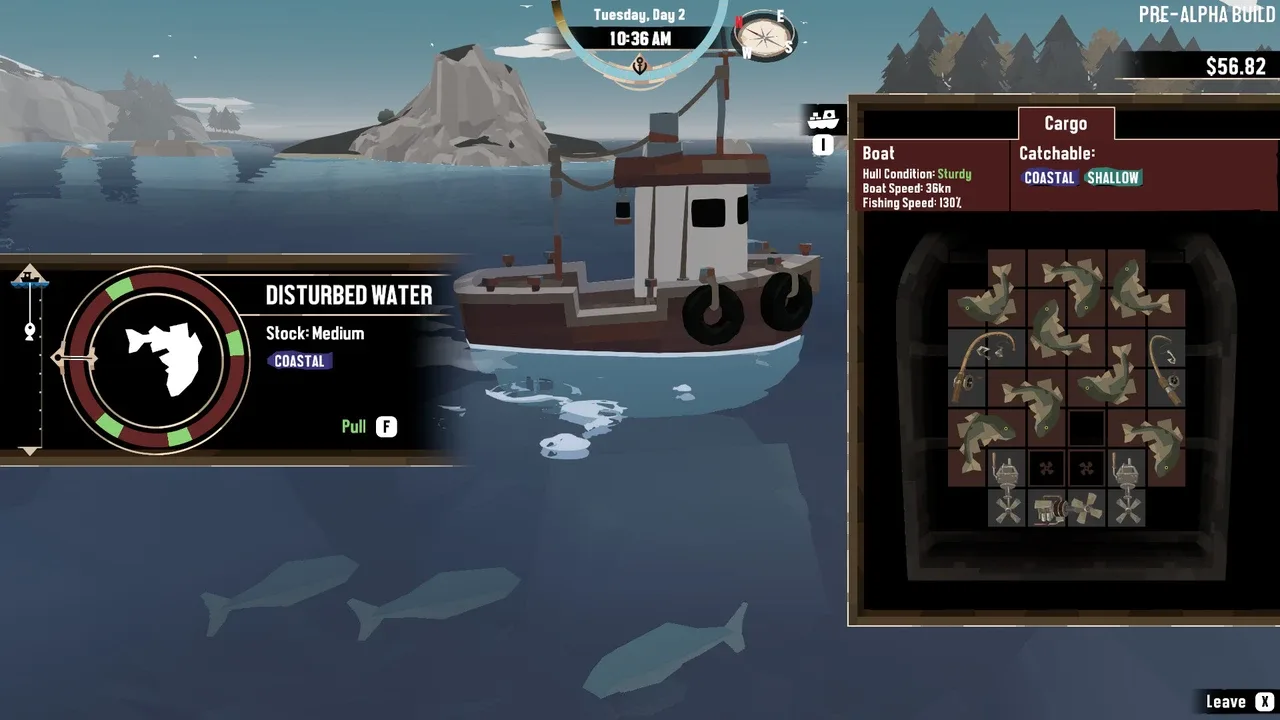
You can actually fish without interacting with the relative minigame, but being good leads also to much faster fishing times
Fishing is managed by a QTE minigame, and caught fish and boat upgrades must be fit into a grid in a minigame that is similar to some Professor Layton puzzles. The core gameplay loop of exploring, fishing, and upgrading the boat is solid and fun, even in the later parts of the game. The environmental hazards are easy to predict but don't leave room for error, even if the punishing aspect is mild, thus creating a rather easy game.
The story is mildly interesting but acts only as an excuse to explore the various areas of the archipelago, and the cast of characters is quite varied, but few interactions are possible. The game presents a series of side quests, but they are almost all fetch quests where particular fish are required that get old soon. There is obviously an encyclopedia to fill with all the fish present in game, and some particular lovecraftian mutation varieties are quite rare and difficult to find.
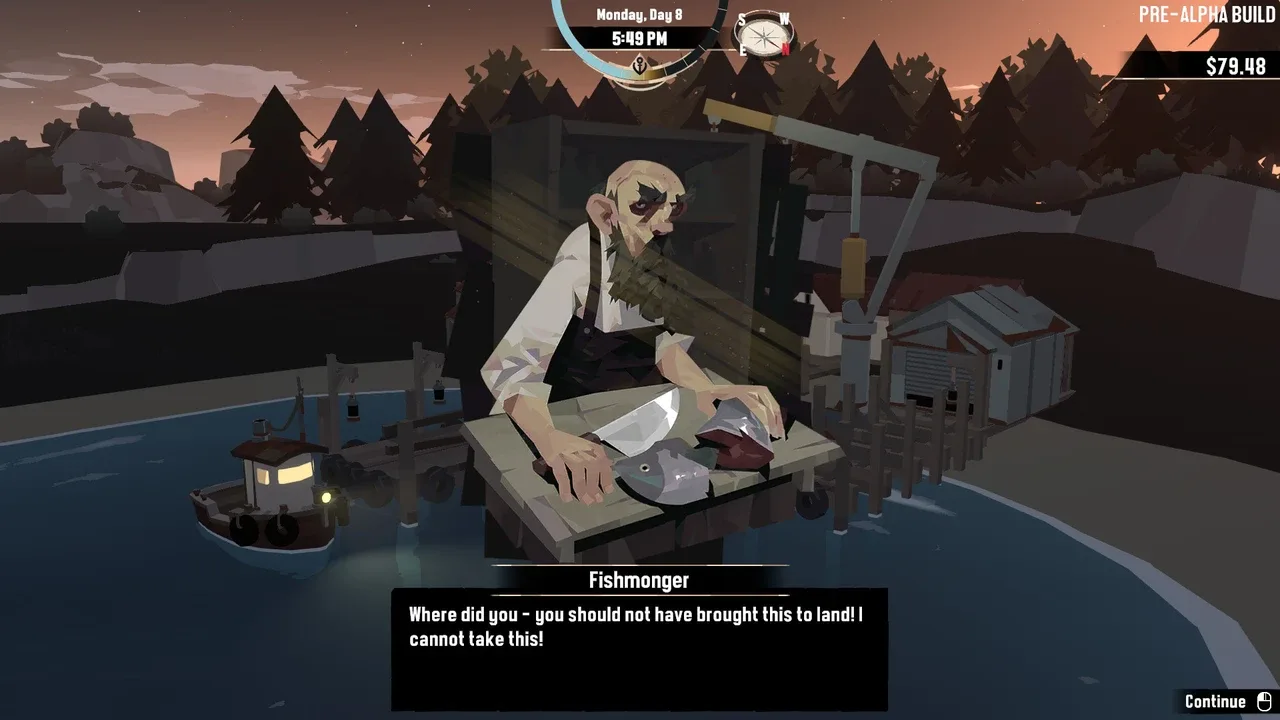
The first fishmonger has a rather unsettling appearance
The game has a simple but impactful graphic, and the various archipelago areas are well characterized and unique. Where the game shines is in the drawing of fishes, objects, and characters: they all have a coherent style, and particularly the Lovecraftian fishes and some characters are really unsettling. The music is surprisingly good, a mix of seafaring and mysterious tunes. Technically, the game is simple and really stable, with no bugs whatsoever. It is definitely made for mouse and keyboard, but the console controls are quite good.
FINAL CONSIDERATIONS
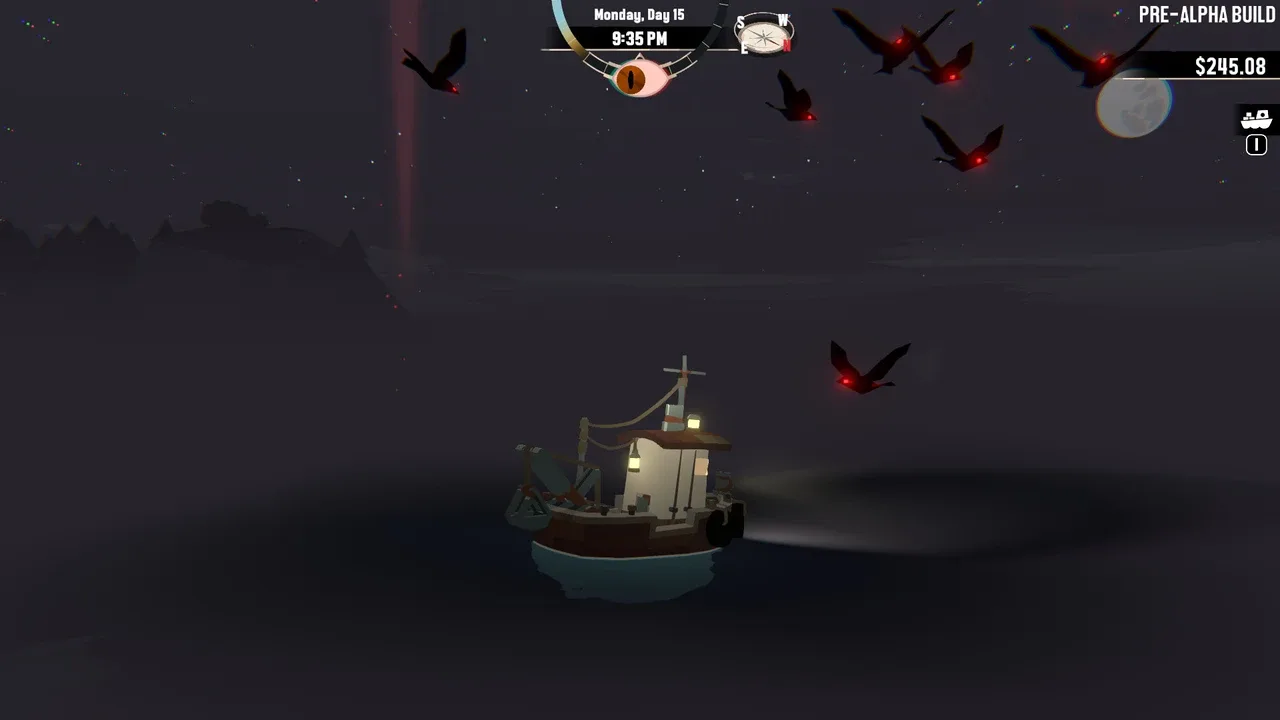
Demonic crows that steal your fish are only one type of creatures that can attack the player
Dredge is like a breath of fresh air in the video game industry. It has its flaws, mainly repetitive side quests and a rather easy final game part, but its originality really makes the flaws fall into the background. It was the most discussed game of 2023 for a really good reason after all. I suggest it to anyone; don't let the fishing aspect of the game fool you. I hate fishing but love this game. Even if creatures of the deep stalk your boat almost continually, it is a pretty chill game, perfect to be played alongside a podcast or in small slices of time.
FINAL SCORE: 9/10
-------------------------------------------------------------------------------------------------------------------------------------------------------------------------------------------------------------------------
Going steady with SMT IV, now I0m in the last third of the game.
Just started NFS: MW 05 and already beaten some Blacklist rivals. The game is old and the yellow filter is not the best artistic choice, and the FMV cutscenes aged in a horrible way. But is so much fun going around winning races and tuning your car. The italian spirit prevailed, and when I saw the Fiat Punto between the starter cars I couldn't resist.
Review number 20! Quite a milestone.
Dredge - Amazon Luna
Genre: Fishing simulator, adventure, horror
Developer/Year: Black Salt Games, 2023
SCORE: 9/10
INTRODUCTION AND GAMEPLAY
Dredge was maybe the biggest indie surprise of 2023, gaining a massive following and an almost unanimous good consensus. I love Lovecraftian horror, and this game was given for free with my Prime subscription. In addition, it was also available on Amazon Luna, representing the perfect occasion to test the service.
In Dredge the player is a fisherman, crashing his boat in a strange archipelago. A small boat is given to the player along with a debt to repay fishing. Fish during the day is safe, but during the night more valuable fish appear. The night tends also to increase the panic meter of the player, and having high panic means that it's more probable to be attacked by a Lovecraftian abomination. Obviously, the game after the first introductory phases pushes you to go out during the night, and the player is forced to take some calculated risks.

You can actually fish without interacting with the relative minigame, but being good leads also to much faster fishing times
Fishing is managed by a QTE minigame, and caught fish and boat upgrades must be fit into a grid in a minigame that is similar to some Professor Layton puzzles. The core gameplay loop of exploring, fishing, and upgrading the boat is solid and fun, even in the later parts of the game. The environmental hazards are easy to predict but don't leave room for error, even if the punishing aspect is mild, thus creating a rather easy game.
The story is mildly interesting but acts only as an excuse to explore the various areas of the archipelago, and the cast of characters is quite varied, but few interactions are possible. The game presents a series of side quests, but they are almost all fetch quests where particular fish are required that get old soon. There is obviously an encyclopedia to fill with all the fish present in game, and some particular lovecraftian mutation varieties are quite rare and difficult to find.

The first fishmonger has a rather unsettling appearance
The game has a simple but impactful graphic, and the various archipelago areas are well characterized and unique. Where the game shines is in the drawing of fishes, objects, and characters: they all have a coherent style, and particularly the Lovecraftian fishes and some characters are really unsettling. The music is surprisingly good, a mix of seafaring and mysterious tunes. Technically, the game is simple and really stable, with no bugs whatsoever. It is definitely made for mouse and keyboard, but the console controls are quite good.
FINAL CONSIDERATIONS

Demonic crows that steal your fish are only one type of creatures that can attack the player
Dredge is like a breath of fresh air in the video game industry. It has its flaws, mainly repetitive side quests and a rather easy final game part, but its originality really makes the flaws fall into the background. It was the most discussed game of 2023 for a really good reason after all. I suggest it to anyone; don't let the fishing aspect of the game fool you. I hate fishing but love this game. Even if creatures of the deep stalk your boat almost continually, it is a pretty chill game, perfect to be played alongside a podcast or in small slices of time.
FINAL SCORE: 9/10
-------------------------------------------------------------------------------------------------------------------------------------------------------------------------------------------------------------------------
CURRENTLY PLAYING
- Shin Megami Tensei IV - 3DS
- Need For Speed: Most Wanted (2005) - PC
Going steady with SMT IV, now I0m in the last third of the game.
Just started NFS: MW 05 and already beaten some Blacklist rivals. The game is old and the yellow filter is not the best artistic choice, and the FMV cutscenes aged in a horrible way. But is so much fun going around winning races and tuning your car. The italian spirit prevailed, and when I saw the Fiat Punto between the starter cars I couldn't resist.
4 Yrs✓#
f_n_c
4 Yrs✓#
UPDATE #21
I had the urge to replay Metal Slug. I don't know; it just happened. Having them all easily available through emulation and being fast, light-hearted games, there was nothing holding me back.
METAL SLUG 1

Metal Slug 1, the start of a legend. Metal Slug (MS from now on) is a very famous saga, but it's worth doing a little introduction nevertheless. All the games of the mainline series are run and gun, where you control a soldier fighting against soldiers and any type of oddity. You can select different characters and guide them through a plethora of levels, exquisitely painted through one of the finest pixel art of the Neo Geo era. The main character can shoot on the 4 main axes, walk and jump on platforms, and drive different vehicles. Long-bearded POWs and a female soldier wandering with an enormous backpack can give to the player upgrades. The games don't do anything groundbreaking compared to similar titles available at the time, but they are so polished graphically and mechanically that they made it stand out over a lot of the competitors.
Metal Slug 1 in particular has a lot of differences compared to the later entries of the franchise. First of all, it's a lot more grounded. Yes, you fight enemy soldiers vaguely resembling the nazis and comically over-the-top vehicles with gigantic weapons mounted on them, but there are almost no supernatural enemies. There is also one vehicle to drive (the famous Metal Slug), which is a wheeled tank with turrets that can shoot in all directions and that can do small and funny jumps in the air. On the other hand, regarding weapons, some are missing compared to the later entries but almost all the iconic ones are present.
The levels are great, even if they are linear compared to MS. The set pieces start in a forest and touch cities, valleys full of snow, and military bases. The bosses are well designed, even if a few of them are quite easy. Actually, it's an easy game compared to the rest of the series, and I managed to beat it with the lowest credit input in the series. Overall, it is a very solid, albeit short, game that poses a solid basis to build a very important franchise in the history of video games.
FINAL SCORE: 8/10
METAL SLUG 2
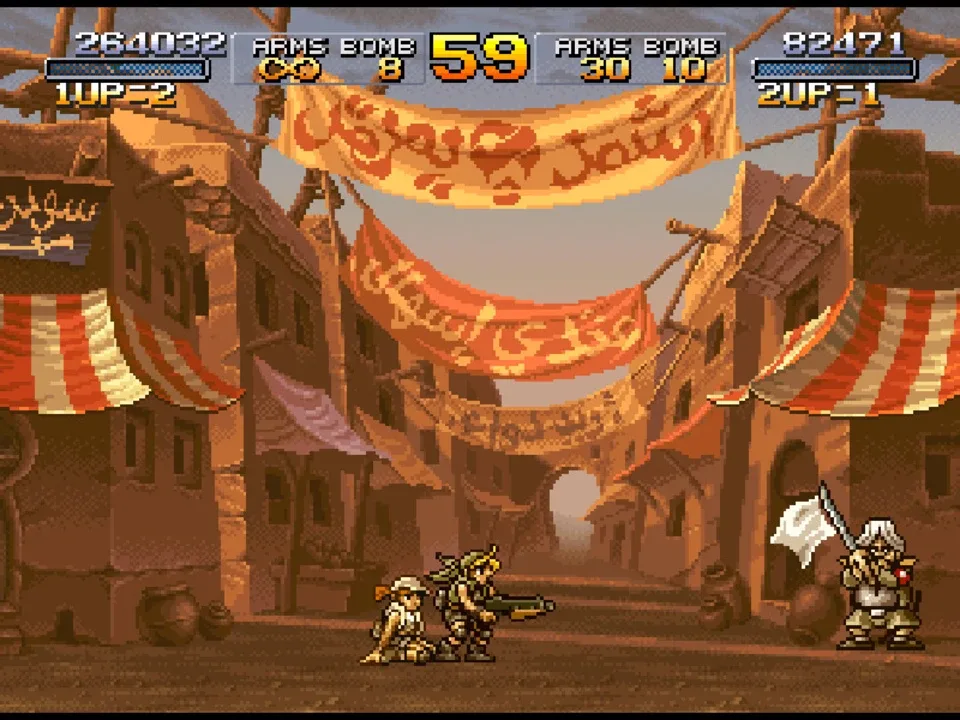
Metal Slug 2 adds a ton of innovation to the already fun MS 1. There are more weapons and, most importantly, new vehicles that make the whole experience extremely more fun. In addition, the main character can also be transformed under certain conditions, modifying the way it moves and shoots. For example, it can become a zombie or a mummy when hit by the relative enemy, or become fat when it eats too much of the food disseminated through the level in order to give the player bonus points for its final score.
The levels and the bosses are also much more inspired compared with the first entry, spanning from an Arab city to a pyramid, ending in Hong Kong and in the ocean. Here the enemies are much more varied: the first ones are the soldiers of the first game, but other supernatural entities are introduced until a final great climax, in which the rebel soldiers and the main character fight the aliens that kidnapped the evil general and threaten the whole earth. It is the most balanced entry of the original trilogy, and the gradual descent towards crazier enemies is well done and has left me amazed.
Sadly, the game suffers from an extreme frame rate problem. The game runs constantly on poor framerate, but the situation in the later levels with a lot of moving parts is atrocious. You can actually see the single frames play out one by one, like an extremely fast PowerPoint presentation. Playing it on an emulator surely hasn't helped, but since the game is notorious for suffering from framerate issues, I think the situation with the original hardware isn't much different. SNK has also published an updated version (X) with an improved framerate but sadly has added a lot of small changes that make the update more akin to a soft remake than a simple fix.
FINAL SCORE: 7/10
METAL SLUG 3
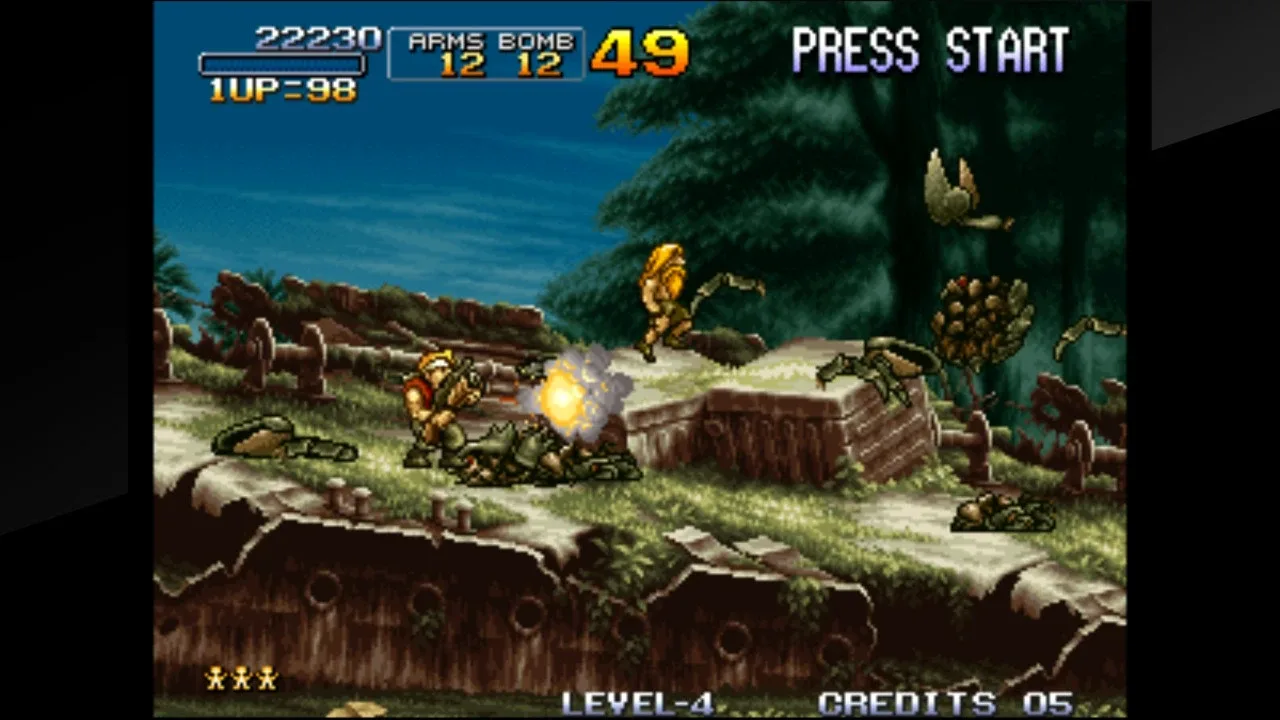
This is considered the best game of the series. For sure, it is the best game of the first trilogy. Even the few drops of realism are thrown out of the window by MS 3, and the team chooses to offer a wild, crazy ride. In the first level, you fight giant crabs that shoot exploding balls from their claws, and it only gets more insane from that. Aliens, ancient divinities, zombies—there isn't anything that the small pistol of the main characters can't kill. The game takes its already high stakes and makes them even higher, both in terms of "plot" and content.
There are more weapons, but most importantly, there are a lot of different vehicles, some even level-specific. The game doesn't innovate the formula much compared to the second installment, but it refines the formula to distill the perfect Metal Slug experience. The team also fixed the horrendous lags of the second game, and even if the stability isn't perfect in all the situations, at least the whole game is playable without considerable problems.
Sadly, I had a very big problem with the last stage of the game. After a skirmish with the rebel army, the main character rides a rocket to the alien mothership to kill their queen in a final fight that happens mid-air while falling towards the sea. Don't get me wrong, the whole section is epic and unique, almost a whole MS game inside another game. But it's so damn long, and some parts of it are just corridors full of enemies that shoot oversized projectiles, making the whole affair annoying in some sections. Nevertheless, this doesn't ruin the experience, but only adds a sad stroke to a very good picture.
FINAL SCORE: 8.5/10
FINAL CONSIDERATIONS
Please, just play Metal Slug if you haven't done it already. It's iconic, short, and very fun. Even if you are very bad with run and guns, you can still pump in credits and see the end. The whole trilogy is much shorter than most of the modern games and can offer a short burst of wild fun. The first one is so engaging that I almost finished it another time after my first completion; I was truly hooked. Another extremely good part that I haven't already mentioned is the sound effects design. The OST is good but serviceable, but the sound effects are extremely good. The "Thank You!" that the POWs make when they are rescued, or the "Mission Start" sound, is permanently fixed into my mind.
Definitely a must-play for everyone.
-------------------------------------------------------------------------------------------------------------------------------------------------------------------------------------------------------------------------
Finally finished Shin Megami Tensei IV. Good game, but dragged a lot in the end and to watch the "true" ending I was forced to complete a whole bunch of boring sidequests.
I play NfS rarely, but it's still fun. Racing and tuning the car never gets old, at least for now.
I started also COD: MW2 and played until "No Russian". A great cinemathographic campaign, that refined by miles the first game. I hope that the rest of the game will be on the same level. After the scare of the terror attacks of the last decade and the current situation with Russia these games feel definitely different.
Metal Slug 1 + 2 + 3 - Neo Geo (Emulated)
Genre: Run and Gun
Developer/Year: Nazca Corporation (SNK), 1196 - 1998 - 2000
I had the urge to replay Metal Slug. I don't know; it just happened. Having them all easily available through emulation and being fast, light-hearted games, there was nothing holding me back.
METAL SLUG 1

Metal Slug 1, the start of a legend. Metal Slug (MS from now on) is a very famous saga, but it's worth doing a little introduction nevertheless. All the games of the mainline series are run and gun, where you control a soldier fighting against soldiers and any type of oddity. You can select different characters and guide them through a plethora of levels, exquisitely painted through one of the finest pixel art of the Neo Geo era. The main character can shoot on the 4 main axes, walk and jump on platforms, and drive different vehicles. Long-bearded POWs and a female soldier wandering with an enormous backpack can give to the player upgrades. The games don't do anything groundbreaking compared to similar titles available at the time, but they are so polished graphically and mechanically that they made it stand out over a lot of the competitors.
Metal Slug 1 in particular has a lot of differences compared to the later entries of the franchise. First of all, it's a lot more grounded. Yes, you fight enemy soldiers vaguely resembling the nazis and comically over-the-top vehicles with gigantic weapons mounted on them, but there are almost no supernatural enemies. There is also one vehicle to drive (the famous Metal Slug), which is a wheeled tank with turrets that can shoot in all directions and that can do small and funny jumps in the air. On the other hand, regarding weapons, some are missing compared to the later entries but almost all the iconic ones are present.
The levels are great, even if they are linear compared to MS. The set pieces start in a forest and touch cities, valleys full of snow, and military bases. The bosses are well designed, even if a few of them are quite easy. Actually, it's an easy game compared to the rest of the series, and I managed to beat it with the lowest credit input in the series. Overall, it is a very solid, albeit short, game that poses a solid basis to build a very important franchise in the history of video games.
FINAL SCORE: 8/10
METAL SLUG 2

Metal Slug 2 adds a ton of innovation to the already fun MS 1. There are more weapons and, most importantly, new vehicles that make the whole experience extremely more fun. In addition, the main character can also be transformed under certain conditions, modifying the way it moves and shoots. For example, it can become a zombie or a mummy when hit by the relative enemy, or become fat when it eats too much of the food disseminated through the level in order to give the player bonus points for its final score.
The levels and the bosses are also much more inspired compared with the first entry, spanning from an Arab city to a pyramid, ending in Hong Kong and in the ocean. Here the enemies are much more varied: the first ones are the soldiers of the first game, but other supernatural entities are introduced until a final great climax, in which the rebel soldiers and the main character fight the aliens that kidnapped the evil general and threaten the whole earth. It is the most balanced entry of the original trilogy, and the gradual descent towards crazier enemies is well done and has left me amazed.
Sadly, the game suffers from an extreme frame rate problem. The game runs constantly on poor framerate, but the situation in the later levels with a lot of moving parts is atrocious. You can actually see the single frames play out one by one, like an extremely fast PowerPoint presentation. Playing it on an emulator surely hasn't helped, but since the game is notorious for suffering from framerate issues, I think the situation with the original hardware isn't much different. SNK has also published an updated version (X) with an improved framerate but sadly has added a lot of small changes that make the update more akin to a soft remake than a simple fix.
FINAL SCORE: 7/10
METAL SLUG 3

This is considered the best game of the series. For sure, it is the best game of the first trilogy. Even the few drops of realism are thrown out of the window by MS 3, and the team chooses to offer a wild, crazy ride. In the first level, you fight giant crabs that shoot exploding balls from their claws, and it only gets more insane from that. Aliens, ancient divinities, zombies—there isn't anything that the small pistol of the main characters can't kill. The game takes its already high stakes and makes them even higher, both in terms of "plot" and content.
There are more weapons, but most importantly, there are a lot of different vehicles, some even level-specific. The game doesn't innovate the formula much compared to the second installment, but it refines the formula to distill the perfect Metal Slug experience. The team also fixed the horrendous lags of the second game, and even if the stability isn't perfect in all the situations, at least the whole game is playable without considerable problems.
Sadly, I had a very big problem with the last stage of the game. After a skirmish with the rebel army, the main character rides a rocket to the alien mothership to kill their queen in a final fight that happens mid-air while falling towards the sea. Don't get me wrong, the whole section is epic and unique, almost a whole MS game inside another game. But it's so damn long, and some parts of it are just corridors full of enemies that shoot oversized projectiles, making the whole affair annoying in some sections. Nevertheless, this doesn't ruin the experience, but only adds a sad stroke to a very good picture.
FINAL SCORE: 8.5/10
FINAL CONSIDERATIONS
Please, just play Metal Slug if you haven't done it already. It's iconic, short, and very fun. Even if you are very bad with run and guns, you can still pump in credits and see the end. The whole trilogy is much shorter than most of the modern games and can offer a short burst of wild fun. The first one is so engaging that I almost finished it another time after my first completion; I was truly hooked. Another extremely good part that I haven't already mentioned is the sound effects design. The OST is good but serviceable, but the sound effects are extremely good. The "Thank You!" that the POWs make when they are rescued, or the "Mission Start" sound, is permanently fixed into my mind.
Definitely a must-play for everyone.
-------------------------------------------------------------------------------------------------------------------------------------------------------------------------------------------------------------------------
CURRENTLY PLAYING
- Call of Duty: Modern Warfare 2 - PC
- Need for Speed: Most Wanted 2005 - PC
Finally finished Shin Megami Tensei IV. Good game, but dragged a lot in the end and to watch the "true" ending I was forced to complete a whole bunch of boring sidequests.
I play NfS rarely, but it's still fun. Racing and tuning the car never gets old, at least for now.
I started also COD: MW2 and played until "No Russian". A great cinemathographic campaign, that refined by miles the first game. I hope that the rest of the game will be on the same level. After the scare of the terror attacks of the last decade and the current situation with Russia these games feel definitely different.
4 Yrs✓#
f_n_c
4 Yrs✓#
UPDATE #22
INTRODUCTION
Point-and-click adventures are an old genre, today relegated to a few not very remarkable games. So it was really a surprise when The Case of the Golden Idol (CGL from now on) had great success some years ago, developing a strong following and funding two additional DLCs. CGL puts you in the shoes of... yourself, just trying to solve gruesome murder mysteries just for the pleasure of doing so.
GAMEPLAY
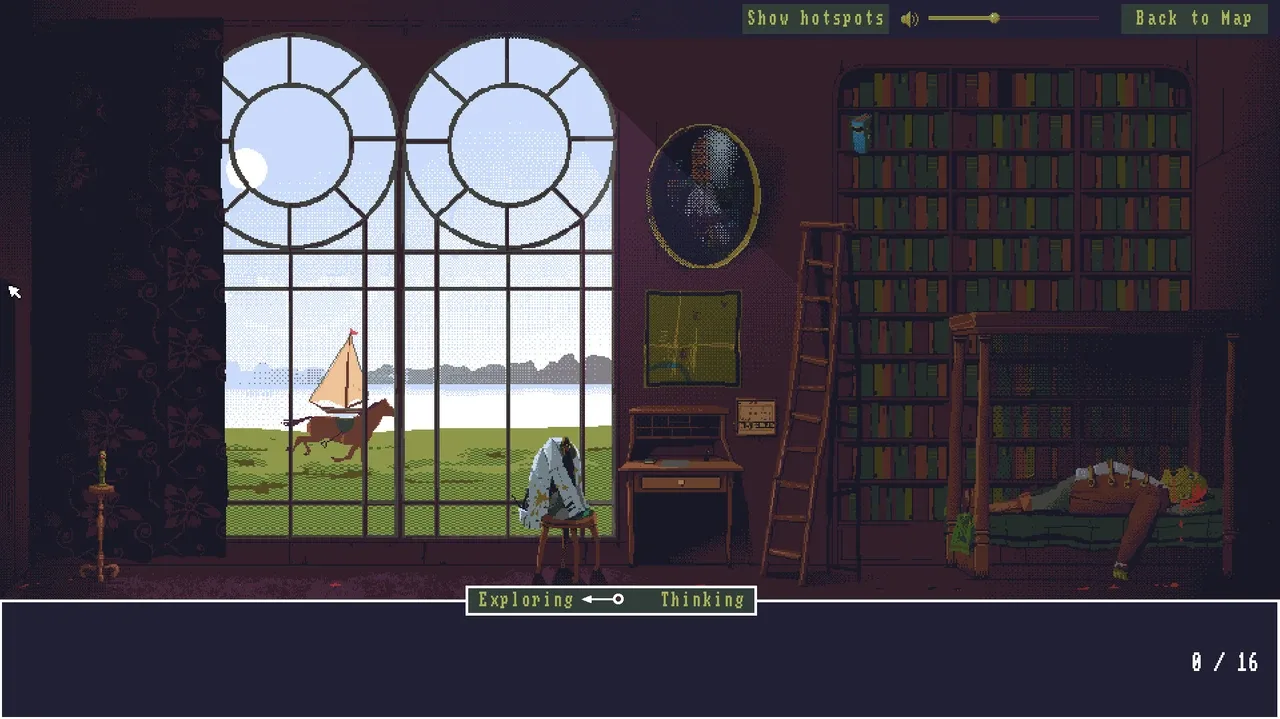
One of the starting mysteries, simple and composed by only one room
When you open a CGL case, you are thrown right into the action. You play with time frozen in an instant, exploring different rooms by clicking around the screen. The characters and the environment have short looped animations, but you'll stare at semi-static images for most of the game. You can interact with everything that is marked with a sparkle, which disappears in the highest (and pretty pointless) difficulty level. By interacting with someone, you can read a short sentence representing its speech and check what it has in its pockets. Sometimes the objects carried by a person are interactable, showing a detail or what's written on it. The first cases have only a few static screens with interactable objects, but further in the game the cases start to become very complex with a lot of different screens and objects.
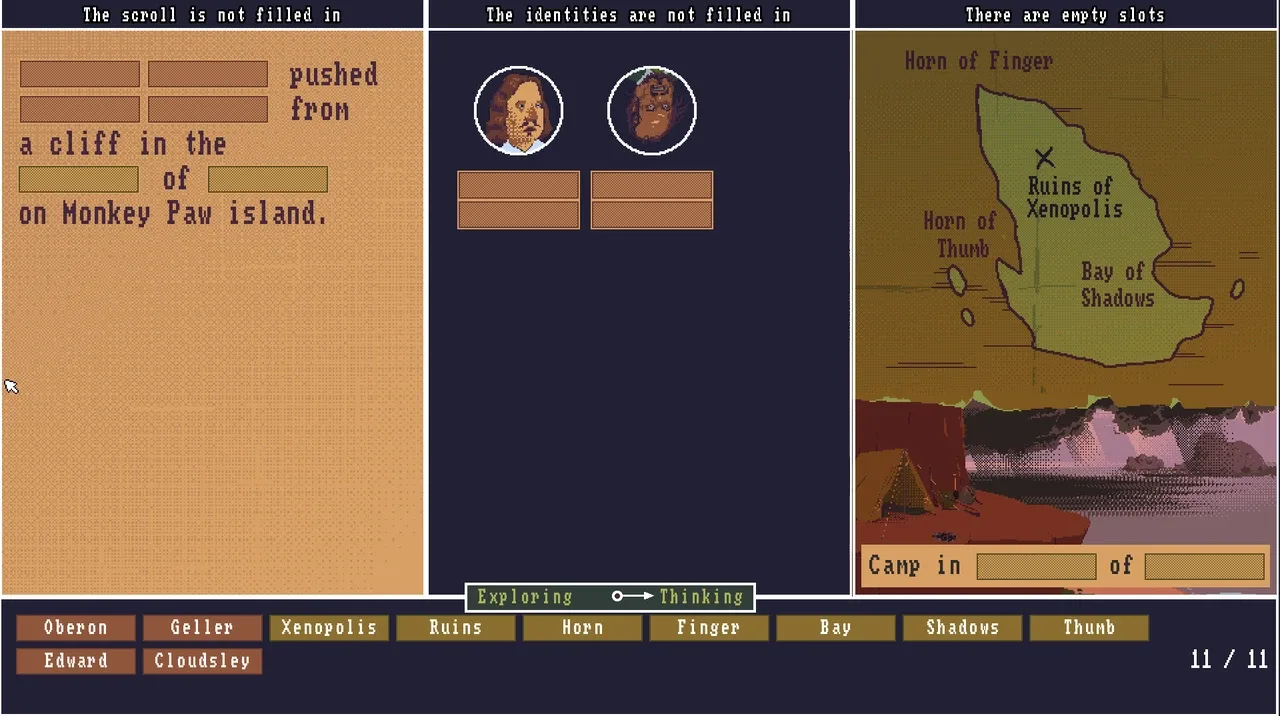
The thinking panel of the first murder
When you interact with a particular object or with an important word written on a document, it will add its relative keyword to the bottom of the screen. Collecting all the keywords is the first step to solving a mystery. At any time during the exploration, you can switch to the "Thinking" view, in which you connect the dots to solve the mystery. You can drag and drop the keywords to associate them with portraits (to identify everyone in the scene) in small intermediate puzzles that will add specific detail on a particular murder and in a precise description of the events depicted in the scene. The general workflow (at least for me) was to identify everyone, solve the specific puzzles, and then finally solve the mystery. The keywords are color-coded in categories that narrow down the keyword choice for each space, and the game tells you how many keywords you have still to discover.
STORY AND DESIGN
The game isn't easy, even with all these tips. Some cases will really test your wits, even too much. There are, in particular, two cases, one of which is the last one, which are incredibly difficult to solve without external help. They have you do incredible leaps of faith in your reasoning and are not logical at all. The whole game has a crazy logic (more on that later), but even in the strange world of CGL, some cases are just too much to be solved, in my opinion. On the other hand, the difficulty keeps the game rewarding through the whole experience and makes you feel very intelligent when you solve a case.
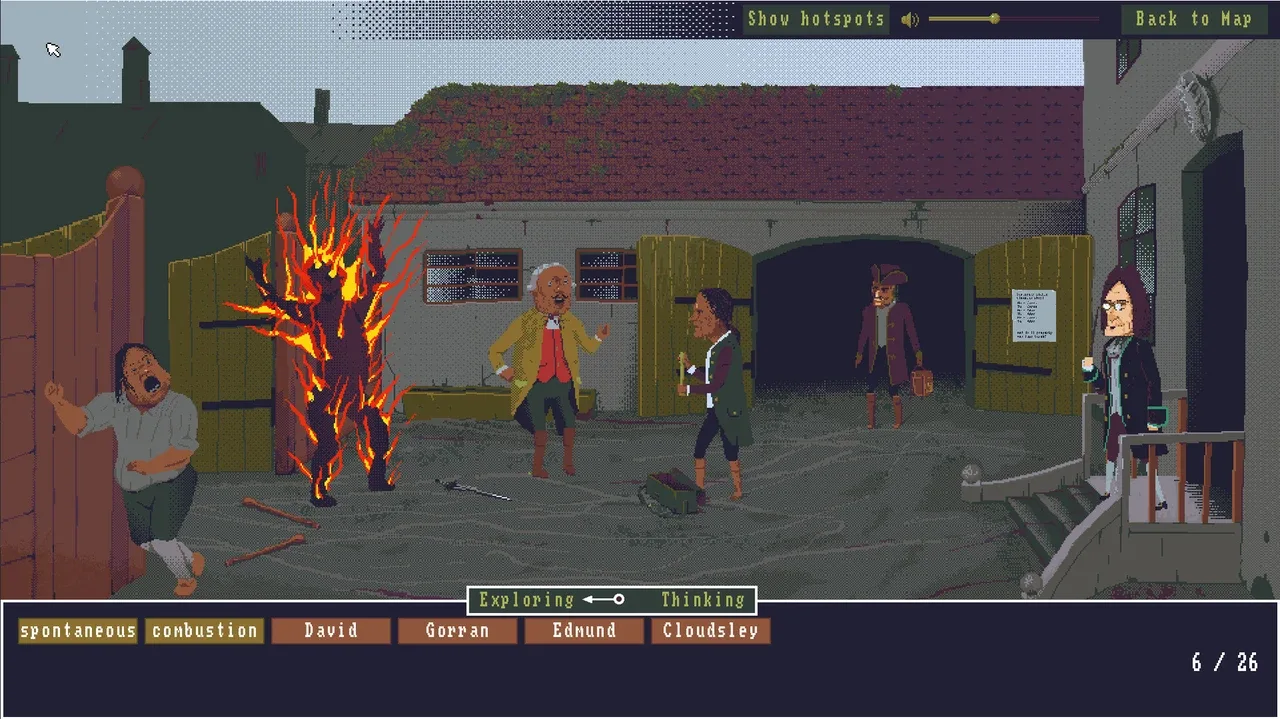
The power of the idol at work
The game feels very rewarding also because all the cases are short, self contained and self-explained stories, but linked to a wider transversal story. And the story, at least in my opinion, is the thing that sets apart CGL from other similar games. It is set in the eighteenth century, between England and some exotic and fictional countries. It starts as simple murders between family members to gain wealth and the control of a mysterious golden idol. In the third murder, the idol shows its powers, and from that point, the plot becomes increasingly crazy, adding some insane twists. A lot of characters from the third case onwards make recurrent appearances, and every case develops their personality and intertwined stories. The characters are well characterized and varied, coming from different social classes and having wildly different personalities. Since the story twists are the best thing in the game, I won't spoil anything, but the game deserves to be played (even with a guide by the laziest people) just for the story alone.
The game has a strange art style. The people in particular are very ugly and have a design that is very hit or miss, in my opinion. They remind me of the typical designs of characters of adult cartoon shows. I disliked a lot the artistic direction at first, but it grew on me, and I almost liked it towards the end. The backgrounds are a totally different thing. They are detailed and reminiscent of old graphical adventures, and some of them, in my opinion, are quite a joy to see. The soundtrack is also great; it uses really well synthetic and classic sounds of the instruments of the eighteenth century to create an eerie and ominous atmosphere that gives character to the various scenes without being annoying or repetitive.
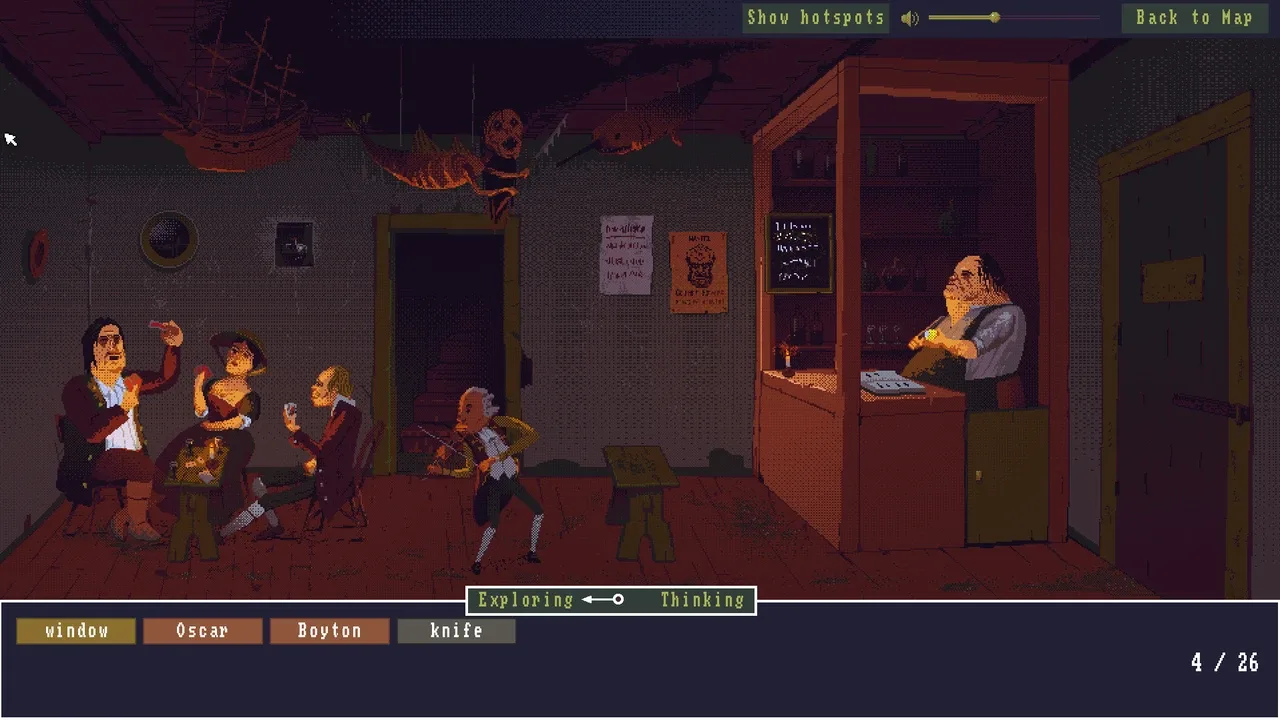
A fun evening in the tavern, complete with a corpse in one of the room upstairs
VERDICT
Just go to play CGL. If you are not fond of mysteries and brain-intensive games, use a guide and try to connect the story dots by yourself. CGL is an incredible game, created by a great mind that had no artistic constraints and went with just what it liked. The game feels very polished and simple, and everything works as intended. With few resources, it manages to create a remarkable experience, with funny characters that stick to the player's mind for a long time. Almost perfect; it went directly to the list of my most liked games.
FINAL SCORE: 9/10
-------------------------------------------------------------------------------------------------------------------------------------------------------------------------------------------------------------------------
I started A Plague Tale, since it was given to me from Amazon Prime some months ago. The story is acceptable and the environments are stunning. A great cinematographic experience, but sadly in the first half of the game the gameplay is too simple to be at the same level of the rest of the game.
I'm slowing continuing NFS, 1-2 races for session. Is a great filler for a short play.
The Case of the Golden Idol - PC
Genre: Point and click adventure
Developer/Year: Color Gray Games, 2022
Score: 9/10
INTRODUCTION
Point-and-click adventures are an old genre, today relegated to a few not very remarkable games. So it was really a surprise when The Case of the Golden Idol (CGL from now on) had great success some years ago, developing a strong following and funding two additional DLCs. CGL puts you in the shoes of... yourself, just trying to solve gruesome murder mysteries just for the pleasure of doing so.
GAMEPLAY

One of the starting mysteries, simple and composed by only one room
When you open a CGL case, you are thrown right into the action. You play with time frozen in an instant, exploring different rooms by clicking around the screen. The characters and the environment have short looped animations, but you'll stare at semi-static images for most of the game. You can interact with everything that is marked with a sparkle, which disappears in the highest (and pretty pointless) difficulty level. By interacting with someone, you can read a short sentence representing its speech and check what it has in its pockets. Sometimes the objects carried by a person are interactable, showing a detail or what's written on it. The first cases have only a few static screens with interactable objects, but further in the game the cases start to become very complex with a lot of different screens and objects.

The thinking panel of the first murder
When you interact with a particular object or with an important word written on a document, it will add its relative keyword to the bottom of the screen. Collecting all the keywords is the first step to solving a mystery. At any time during the exploration, you can switch to the "Thinking" view, in which you connect the dots to solve the mystery. You can drag and drop the keywords to associate them with portraits (to identify everyone in the scene) in small intermediate puzzles that will add specific detail on a particular murder and in a precise description of the events depicted in the scene. The general workflow (at least for me) was to identify everyone, solve the specific puzzles, and then finally solve the mystery. The keywords are color-coded in categories that narrow down the keyword choice for each space, and the game tells you how many keywords you have still to discover.
STORY AND DESIGN
The game isn't easy, even with all these tips. Some cases will really test your wits, even too much. There are, in particular, two cases, one of which is the last one, which are incredibly difficult to solve without external help. They have you do incredible leaps of faith in your reasoning and are not logical at all. The whole game has a crazy logic (more on that later), but even in the strange world of CGL, some cases are just too much to be solved, in my opinion. On the other hand, the difficulty keeps the game rewarding through the whole experience and makes you feel very intelligent when you solve a case.

The power of the idol at work
The game feels very rewarding also because all the cases are short, self contained and self-explained stories, but linked to a wider transversal story. And the story, at least in my opinion, is the thing that sets apart CGL from other similar games. It is set in the eighteenth century, between England and some exotic and fictional countries. It starts as simple murders between family members to gain wealth and the control of a mysterious golden idol. In the third murder, the idol shows its powers, and from that point, the plot becomes increasingly crazy, adding some insane twists. A lot of characters from the third case onwards make recurrent appearances, and every case develops their personality and intertwined stories. The characters are well characterized and varied, coming from different social classes and having wildly different personalities. Since the story twists are the best thing in the game, I won't spoil anything, but the game deserves to be played (even with a guide by the laziest people) just for the story alone.
The game has a strange art style. The people in particular are very ugly and have a design that is very hit or miss, in my opinion. They remind me of the typical designs of characters of adult cartoon shows. I disliked a lot the artistic direction at first, but it grew on me, and I almost liked it towards the end. The backgrounds are a totally different thing. They are detailed and reminiscent of old graphical adventures, and some of them, in my opinion, are quite a joy to see. The soundtrack is also great; it uses really well synthetic and classic sounds of the instruments of the eighteenth century to create an eerie and ominous atmosphere that gives character to the various scenes without being annoying or repetitive.

A fun evening in the tavern, complete with a corpse in one of the room upstairs
VERDICT
Just go to play CGL. If you are not fond of mysteries and brain-intensive games, use a guide and try to connect the story dots by yourself. CGL is an incredible game, created by a great mind that had no artistic constraints and went with just what it liked. The game feels very polished and simple, and everything works as intended. With few resources, it manages to create a remarkable experience, with funny characters that stick to the player's mind for a long time. Almost perfect; it went directly to the list of my most liked games.
FINAL SCORE: 9/10
-------------------------------------------------------------------------------------------------------------------------------------------------------------------------------------------------------------------------
CURRENTLY PLAYING
- A Plague Tale: Innocence - Amazon Luna
- Need for Speed: Most Wanted 2005 - PC
I started A Plague Tale, since it was given to me from Amazon Prime some months ago. The story is acceptable and the environments are stunning. A great cinematographic experience, but sadly in the first half of the game the gameplay is too simple to be at the same level of the rest of the game.
I'm slowing continuing NFS, 1-2 races for session. Is a great filler for a short play.
4 Yrs✓#
f_n_c
4 Yrs✓#
UPDATE #23
I played Call of Juarez: Bound in Blood for the first time when I was in high school, at a friend's house. I was thrilled, but the game fell off my radar pretty quickly. Fast forward to a month ago: Amazon was given to the Prime clients the whole CoJ saga on GOG, and Gunslinger was available also on Amazon Luna. I had at least to try it.
INTRODUCTION AND STORY
Gunslinger is a peculiar game. After the great Bound in Blood and the terrible Cartel, the Call of Juarez series was in shambles, and it had lost most of the commercial appeal that it previously had. The developers had to develop a game that could bring fans back to the series after the Cartel fiasco, but they had few resources to work on since Techland was moving toward much more profitable IPs like Dying Light. Throwing out the modern setting, which was definitely a mistake, the series returned to the classic Wild West FPS formula, but the developers knew that they had to do something new to gather back the lost fans.
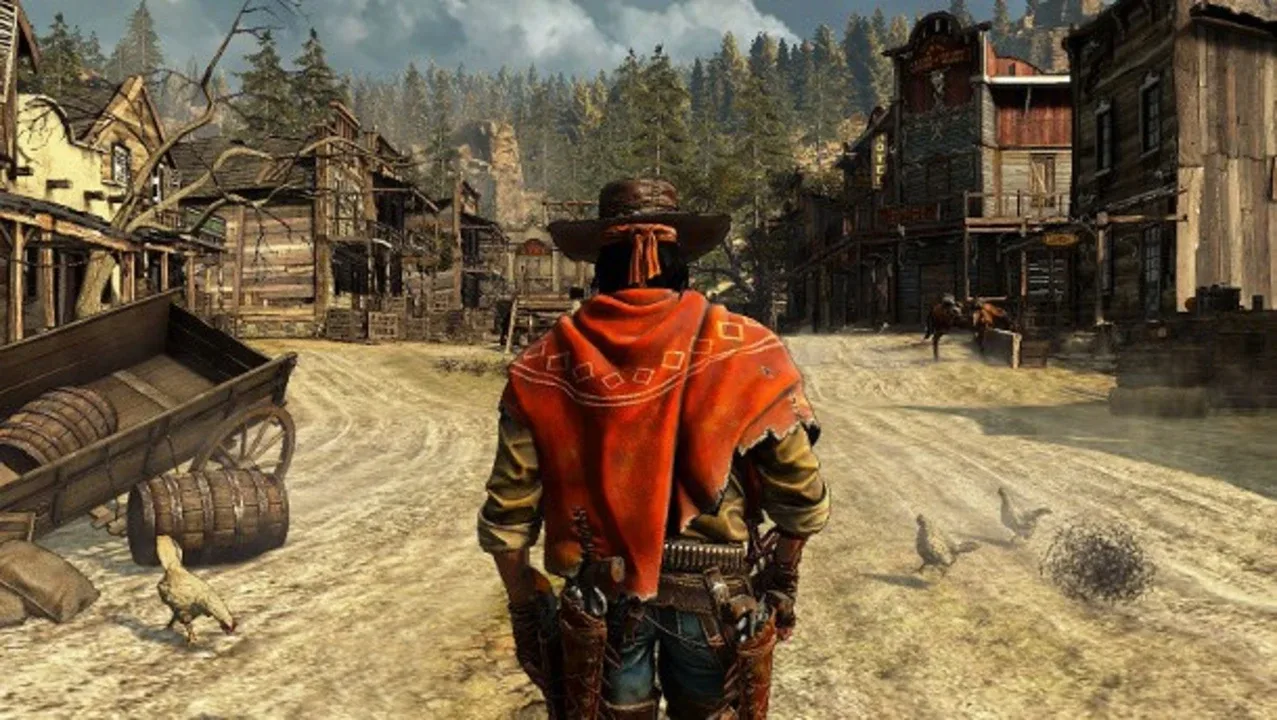
Silas Greaves, the main character of the game
Gunslinger follows the story of Silas Greaves, a criminal turned bounty hunter who exacts his revenge on some people. This is quite literal, since the player plays out the story of Greaves as he tells it to a small audience in a dirty saloon. This is the first brilliant idea that the developers had: instead of using the video game medium to tell a story, in Gunslinger the player lives a story as it is told through the video game medium. Greaves is an unreliable narrator, and he makes mistakes, corrects himself, and changes details as he sees fit during the game. This means that the player may be thrown into a fierce battle against endless Indians, only to hear Greaves saying that like a miracle he saw a way out and see literally the rock move in front of the player to create it. The game plays out a lot with this feature, both to create a particular, over-the-top atmosphere that still remains unmatched. Silas Greaves is an incredible narrator, both in the quality of his dubbing and in the writing of his long speeches, and the games remain lighthearted and fun the whole time.
All the classic Western tropes are touched on by the game: bank robberies, train assaults, duels, ghost towns, wild deserts, Indians, and untamed wild mountains. But the game uses the "Greaves telling a story" gimmick to introduce humorous twists or to make the player play out a single scene multiple times with things playing out in a different way as Greaves corrects what he or another character in the saloon had said just minutes earlier. The game is divided into short mission setpieces, that are grouped in episodes of 2-3 chapters. Every episode follows Greaves hunting a very famous Wild West outlaw like Billy the Kid, the Dalton Brothers, the Wild Bunch, and a lot of other famous people. The situations are always over the top, so much that the people that are in the game who listen to Silas' story often question the truth of his words. The story is not particularly brilliant, living on common tropes, but the way in which it is told makes it special.
GAMEPLAY AND TECHNICAL ASPECTS
Gunslinger is a classic FPS with a very fast pace and an arcade structure built on a point system that encourages fast and skill-based kills. The player can activate a slow motion that highlights enemies after a cooldown, and Greaves can dodge a fatal bullet with a quick-time event when the right gauge is filled. The weapons are divided into pistols (single or dual wielded), shotguns, and rifles, with a limited selection that fits the limited scope of the game. Every weapon feels radically different and has its own advantages and disadvantages, and everything is balanced in the right way. The game has three distinct but limited perk trees, that can be unlocked by spending the experience points gained during the various missions. I played the game on hard, and it is really hard. The challenge is welcome and gives the very short game (less than 10 hours of runtime) much more depth and replayability.
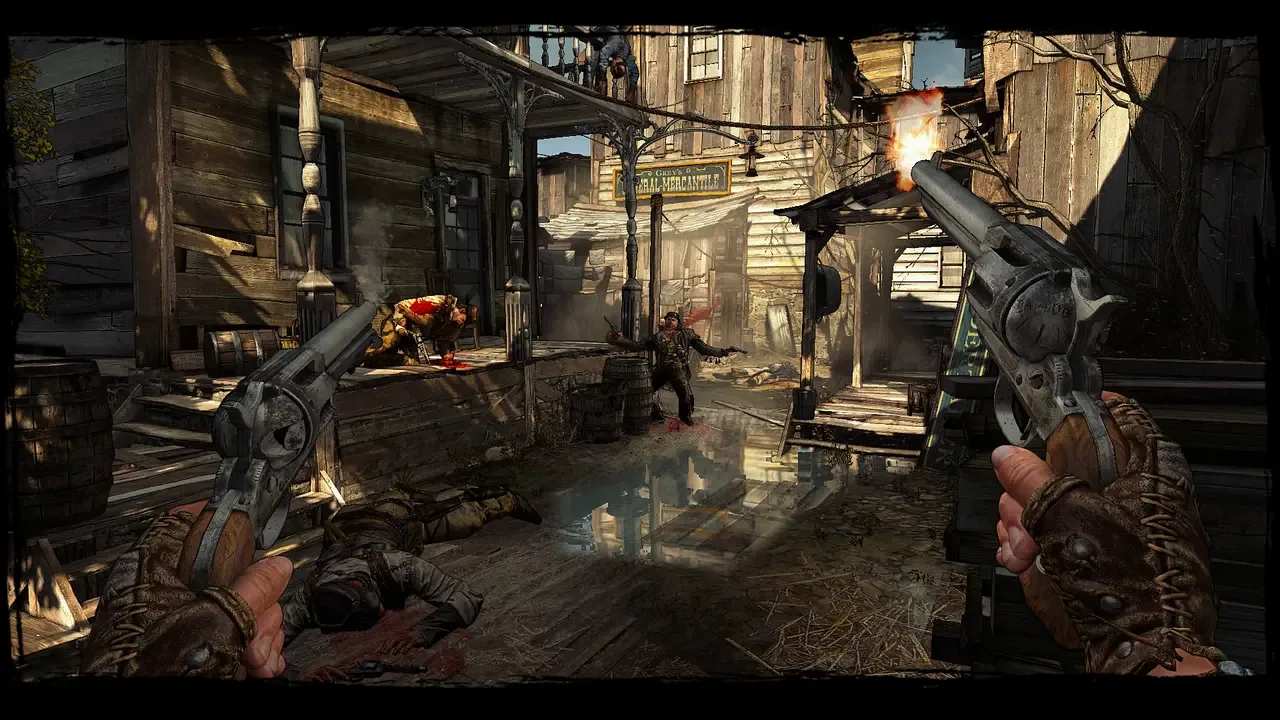
Dual wielding pistols is so much fun, and with a good aim is also deadly in the medium distance
The episodes (missions) are short and intense, and they are always concluded by a duel or a boss fight. The duels are intense and need a little practice to be concluded successfully. You control Silas's hand with A/D to keep it always ready over the gun and a reticle with the mouse to take aim and keep the moving enemy in focus. After some time you hear your heart pounding, and you can extract the weapon. The duel will be easier, but you will get less score since you killed the enemy in a dishonorable way. If you wait until the enemy draws to draw and you prepared well, you can shoot before the enemy and win the duel. The developers keep the duel fresh through the whole game by adding additional challenges every time, like dodging bullets, multiple enemies, and even a Mexican standoff. Boss fights, on the other hand, are much less fun, and they generally feature enemies with machine guns or overpowered versions of normal enemies that force the player to continue movement in order to not get obliterated. Sometimes they are very hard and frustrating, resulting more in a nuisance than a healthy challenge.
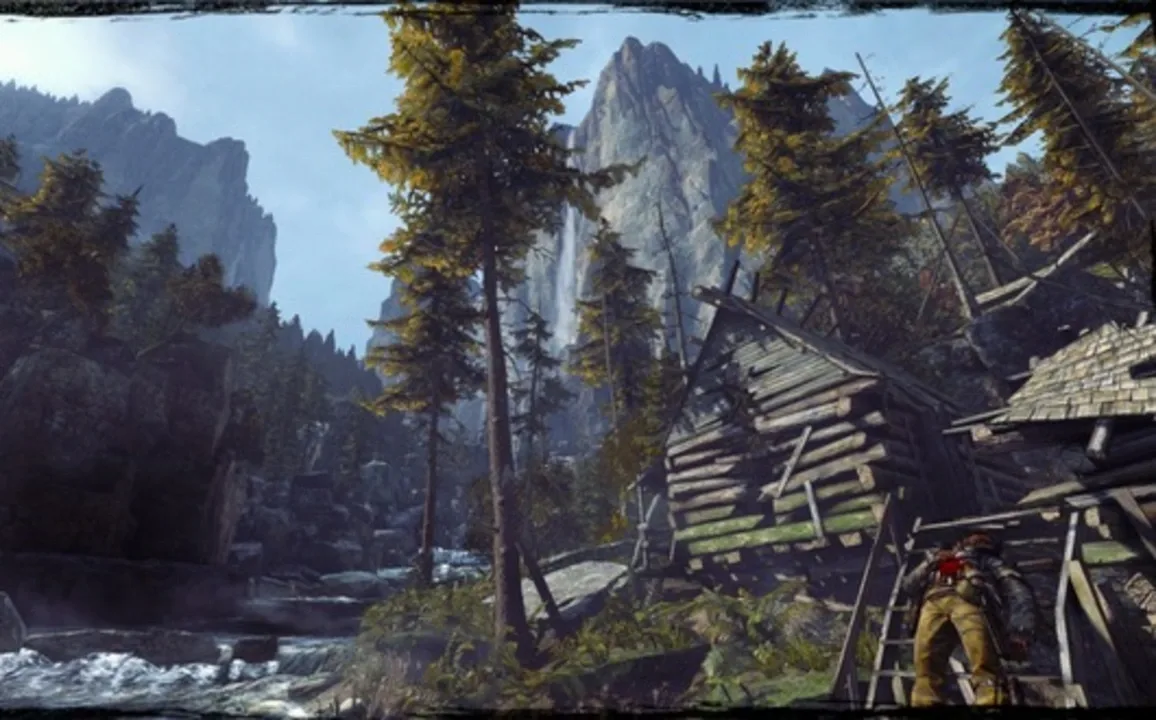
Even if it's old and recycles a lot of assets, the game can pull off some stunning views
Running on a tight budget, the developers had created big levels, and the players explored a small part of them in every mission, thus limiting a lot the burden of developing assets. The developers were smart, and the views are generally great, but it's impossible not to note that you are playing on the same map multiple times with only some small changes. In addition, the game has a strange way of rendering graphics and sometimes seems like the best-looking game of the generation, but more often the player sees a blurred slop in which it is difficult to discern precise details. The music is perfect for a stereotypical Western; it creates atmosphere, but it's serviceable and doesn't stick for long.
VERDICT
The game is solid and fluid. The art direction is peculiar but distinctive, even if Gunslinger is a great game, but not much else. It has a distinctive way to tell its story and uses its limited budget in an intelligent way, but that's all. The story is short, and even if the developers scattered secrets, added an extra difficulty, and coded different modes, I didn't feel the urge to replay the game. It's fun while it lasts, even if sometimes it's a little frustrating, and it subverts well the classical western tropes. The problem is that the experience as a whole doesn't stick; it is good but not good enough to make a lasting impression. It's sad that this is the last Call of Juarez game; probably another game with a higher budget could build on the big strengths of Gunslinger to create something memorable. Techland has moved away from the series and seems to have no intention of resurrecting it in any way.
If you get it for "free" like me, and you like the wild west theme, is a must play. Is a fun ride while it lasts, to be played without particular expectations.
FINAL SCORE: 7.5/10
-------------------------------------------------------------------------------------------------------------------------------------------------------------------------------------------------------------------------
Few progress with Most Wanted.
I got a Miyoo Mini Plus, I had my eyes on retroconsoles for quite some time now. I really like my purchase, it makes retro gaming much more faster and accessible. Castlevania AoS is great, only a little simple. The developers, after two decent entries on the GBA have really found the magic balance. It is not Symphony of the Night, but it's really good for now. I'm at the boss Legion, with roughly 50% of the castle discovered.
Call of Juarez: Gunslinger - PC (Amazon Luna)
Genre: First Person Shooter
Developer/Year: Techland, 2013
Score: 7.5/10
I played Call of Juarez: Bound in Blood for the first time when I was in high school, at a friend's house. I was thrilled, but the game fell off my radar pretty quickly. Fast forward to a month ago: Amazon was given to the Prime clients the whole CoJ saga on GOG, and Gunslinger was available also on Amazon Luna. I had at least to try it.
INTRODUCTION AND STORY
Gunslinger is a peculiar game. After the great Bound in Blood and the terrible Cartel, the Call of Juarez series was in shambles, and it had lost most of the commercial appeal that it previously had. The developers had to develop a game that could bring fans back to the series after the Cartel fiasco, but they had few resources to work on since Techland was moving toward much more profitable IPs like Dying Light. Throwing out the modern setting, which was definitely a mistake, the series returned to the classic Wild West FPS formula, but the developers knew that they had to do something new to gather back the lost fans.

Silas Greaves, the main character of the game
Gunslinger follows the story of Silas Greaves, a criminal turned bounty hunter who exacts his revenge on some people. This is quite literal, since the player plays out the story of Greaves as he tells it to a small audience in a dirty saloon. This is the first brilliant idea that the developers had: instead of using the video game medium to tell a story, in Gunslinger the player lives a story as it is told through the video game medium. Greaves is an unreliable narrator, and he makes mistakes, corrects himself, and changes details as he sees fit during the game. This means that the player may be thrown into a fierce battle against endless Indians, only to hear Greaves saying that like a miracle he saw a way out and see literally the rock move in front of the player to create it. The game plays out a lot with this feature, both to create a particular, over-the-top atmosphere that still remains unmatched. Silas Greaves is an incredible narrator, both in the quality of his dubbing and in the writing of his long speeches, and the games remain lighthearted and fun the whole time.
All the classic Western tropes are touched on by the game: bank robberies, train assaults, duels, ghost towns, wild deserts, Indians, and untamed wild mountains. But the game uses the "Greaves telling a story" gimmick to introduce humorous twists or to make the player play out a single scene multiple times with things playing out in a different way as Greaves corrects what he or another character in the saloon had said just minutes earlier. The game is divided into short mission setpieces, that are grouped in episodes of 2-3 chapters. Every episode follows Greaves hunting a very famous Wild West outlaw like Billy the Kid, the Dalton Brothers, the Wild Bunch, and a lot of other famous people. The situations are always over the top, so much that the people that are in the game who listen to Silas' story often question the truth of his words. The story is not particularly brilliant, living on common tropes, but the way in which it is told makes it special.
GAMEPLAY AND TECHNICAL ASPECTS
Gunslinger is a classic FPS with a very fast pace and an arcade structure built on a point system that encourages fast and skill-based kills. The player can activate a slow motion that highlights enemies after a cooldown, and Greaves can dodge a fatal bullet with a quick-time event when the right gauge is filled. The weapons are divided into pistols (single or dual wielded), shotguns, and rifles, with a limited selection that fits the limited scope of the game. Every weapon feels radically different and has its own advantages and disadvantages, and everything is balanced in the right way. The game has three distinct but limited perk trees, that can be unlocked by spending the experience points gained during the various missions. I played the game on hard, and it is really hard. The challenge is welcome and gives the very short game (less than 10 hours of runtime) much more depth and replayability.

Dual wielding pistols is so much fun, and with a good aim is also deadly in the medium distance
The episodes (missions) are short and intense, and they are always concluded by a duel or a boss fight. The duels are intense and need a little practice to be concluded successfully. You control Silas's hand with A/D to keep it always ready over the gun and a reticle with the mouse to take aim and keep the moving enemy in focus. After some time you hear your heart pounding, and you can extract the weapon. The duel will be easier, but you will get less score since you killed the enemy in a dishonorable way. If you wait until the enemy draws to draw and you prepared well, you can shoot before the enemy and win the duel. The developers keep the duel fresh through the whole game by adding additional challenges every time, like dodging bullets, multiple enemies, and even a Mexican standoff. Boss fights, on the other hand, are much less fun, and they generally feature enemies with machine guns or overpowered versions of normal enemies that force the player to continue movement in order to not get obliterated. Sometimes they are very hard and frustrating, resulting more in a nuisance than a healthy challenge.

Even if it's old and recycles a lot of assets, the game can pull off some stunning views
Running on a tight budget, the developers had created big levels, and the players explored a small part of them in every mission, thus limiting a lot the burden of developing assets. The developers were smart, and the views are generally great, but it's impossible not to note that you are playing on the same map multiple times with only some small changes. In addition, the game has a strange way of rendering graphics and sometimes seems like the best-looking game of the generation, but more often the player sees a blurred slop in which it is difficult to discern precise details. The music is perfect for a stereotypical Western; it creates atmosphere, but it's serviceable and doesn't stick for long.
VERDICT
The game is solid and fluid. The art direction is peculiar but distinctive, even if Gunslinger is a great game, but not much else. It has a distinctive way to tell its story and uses its limited budget in an intelligent way, but that's all. The story is short, and even if the developers scattered secrets, added an extra difficulty, and coded different modes, I didn't feel the urge to replay the game. It's fun while it lasts, even if sometimes it's a little frustrating, and it subverts well the classical western tropes. The problem is that the experience as a whole doesn't stick; it is good but not good enough to make a lasting impression. It's sad that this is the last Call of Juarez game; probably another game with a higher budget could build on the big strengths of Gunslinger to create something memorable. Techland has moved away from the series and seems to have no intention of resurrecting it in any way.
If you get it for "free" like me, and you like the wild west theme, is a must play. Is a fun ride while it lasts, to be played without particular expectations.
FINAL SCORE: 7.5/10
-------------------------------------------------------------------------------------------------------------------------------------------------------------------------------------------------------------------------
CURRENTLY PLAYING
- Castlevania: Aria of Sorrow - Emulated
- Need for Speed: Most Wanted 2005 - PC
Few progress with Most Wanted.
I got a Miyoo Mini Plus, I had my eyes on retroconsoles for quite some time now. I really like my purchase, it makes retro gaming much more faster and accessible. Castlevania AoS is great, only a little simple. The developers, after two decent entries on the GBA have really found the magic balance. It is not Symphony of the Night, but it's really good for now. I'm at the boss Legion, with roughly 50% of the castle discovered.
4 Yrs✓#
f_n_c
4 Yrs✓#
UPDATE #24
INTRODUCTION
Before Inscryption, there was Pony Island. I played Inscryption some years ago, and even if I didn't finish it since it wasn't really the game for me, I realized that it was the peak of years of experience in the field made by the developer with previous games. For every big, critically acclaimed title like Inscryption, there is at least a Pony Island, a partly successful attempt that has a peculiar spark in it but falls short and fails to completely deliver what was intended.
Even if I don't like horror and creepy games, I decided to give Pony Island a chance. Probably I was attracted by the very short run time.
REVIEW
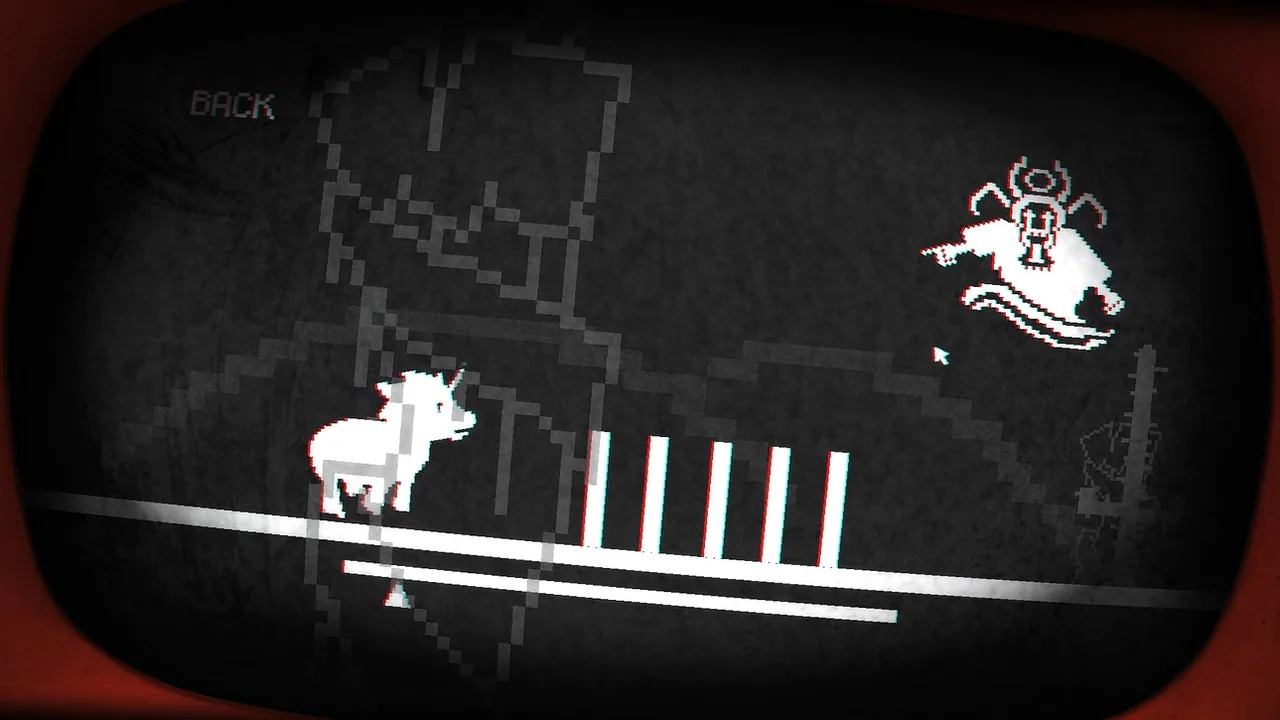
The game remains normal for maybe two minutes, then it becomes immediately creepy and strange.
Pony Island starts as a simple game where you control a pony and press the left mouse button to jump obstacles. This facade lasts maybe two minutes, and then the player is pushed into an unwinnable situation, and you start to be mocked by a dark presence inside the game. You quickly realize that the pony game is a gimmick, and you start to "hack" the game through puzzles to find the truth.
Pony Island is a gimmick game, but I hoped that the illusion of the cute pony game lasted a while longer. You are thrown almost immediately into a wild goose chase through different puzzles that continuously change the game and its rules and subvert the player's expectations. This is maybe the best part of the game: you will never know what awaits you, and the drastic gameplay changes help to keep everything fresh.
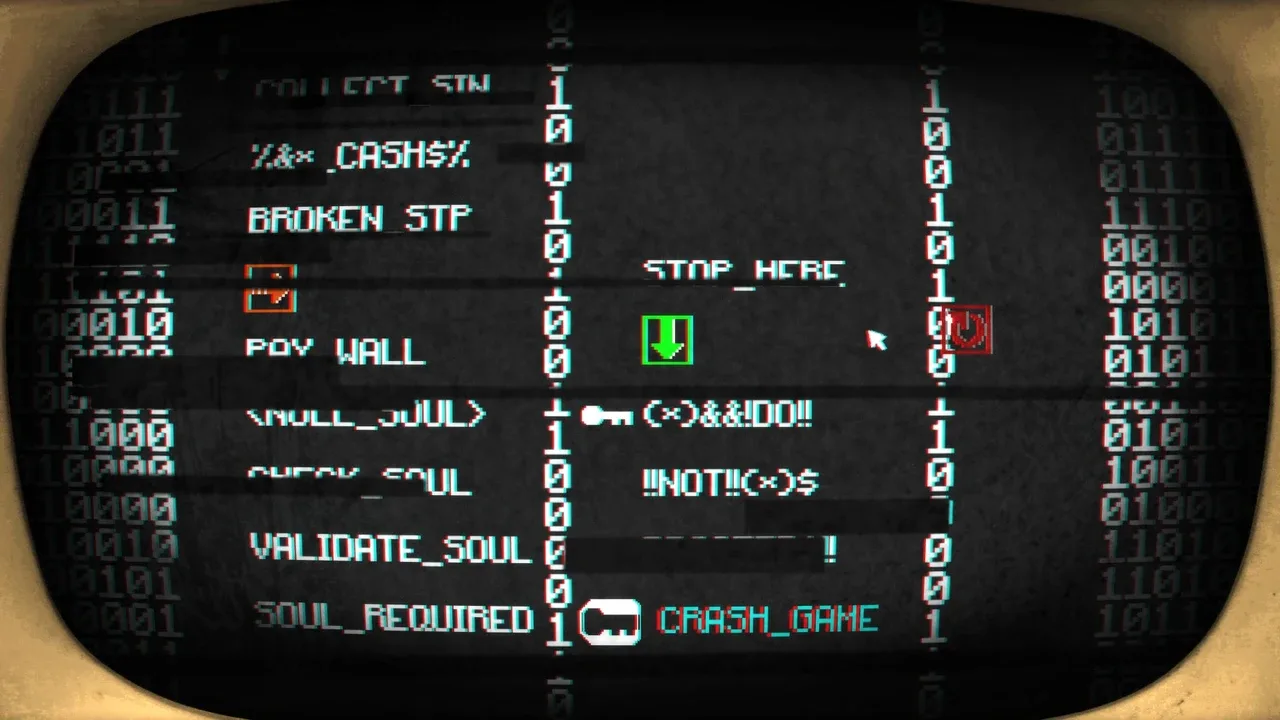
These types of puzzles are the most common in the game, and you just need to use logic to bring the key data from the starting point to the end
Mainly, the game is divided into simple puzzles and run-and-gun sections. The whole package is filled with the unsettling humor typical of the developer, here not much refined but very characteristic. The short runtime helps to keep everything focused; only two hours more would have resulted in a long slog. There are also some collectibles and an alternative ending, but after finishing the game one time, there are not a lot of incentives to keep playing. Once you know all the puzzle solutions and the gimmicks, there is not too much to do, and everything becomes repetitive very fast. From the technical standpoint, the game is basic but effective: made with Unity, the graphics are fairly simple, but the effects are cohesive and help to tell the story in an incredible way.
VERDICT
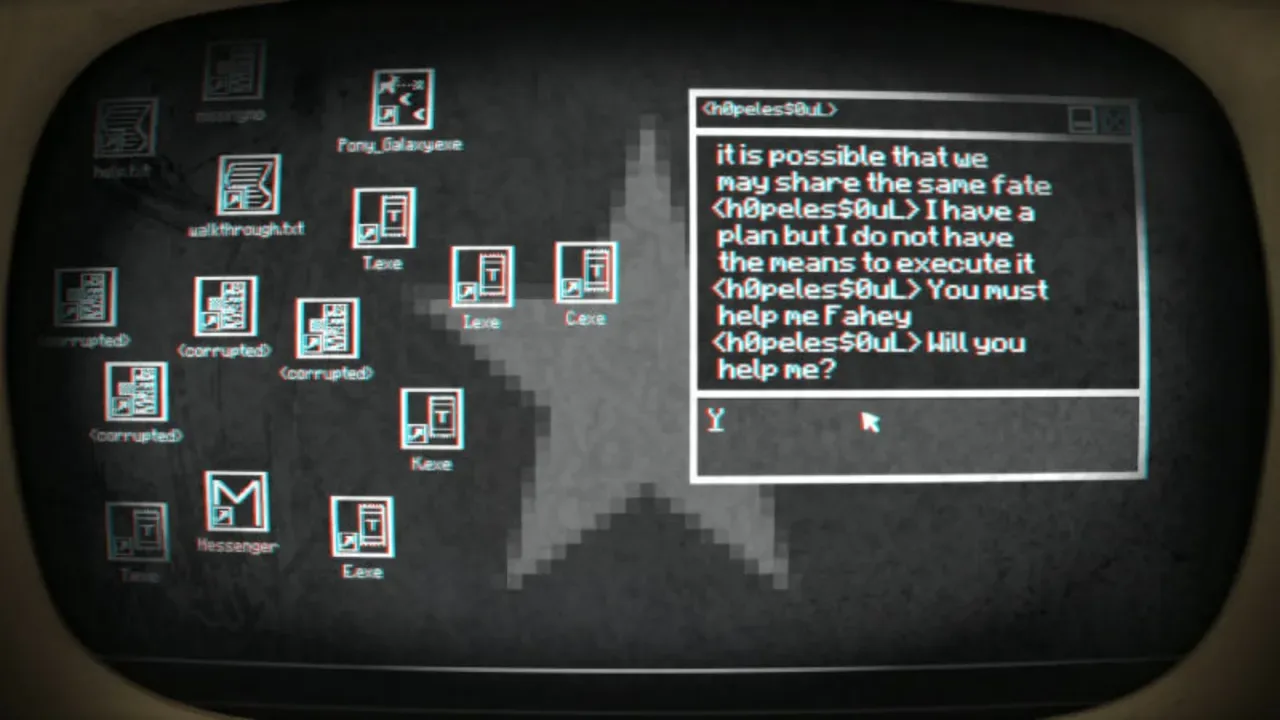
Sometimes the game asks you to explore a PC desktop, reminescing the first Windows versions
There is not too much to say without incurring spoilers. Playing the game and seeing all the different situations are the only things that make it worth playing, and spoilers will greatly ruin the whole experience. The game is as simple as that: half puzzle and half run-and-gun, with a crisp and interesting presentation and a fun and creepy story. It's a necessary embryonic stage of the refined and well-received Inscryption; there is not too much else to say. The short runtime helps a lot with the final score; it's such a tiny and innocuous game that is worth the few hours that it asks the player to live. Sadly, it failed to impress and make a lasting impression on me, and I felt that there was nothing behind the slick presentation. Probably this type of game is just not for me after all.
FINAL SCORE: 7.5/10
-------------------------------------------------------------------------------------------------------------------------------------------------------------------------------------------------------------------------
Most Wanted is definitely on hold until further notice.
I've completed a fast run of Victoria 2 starting with a small state in Africa. Maybe I'll do a review of it with an integrated AAR sometimes.
I've started A Link to the Past, and I'm loving it. Almost perfect. I was also carried away by some arcade games that I'm really digging lately. I've a renewed interest for beat 'em up, that I always disliked in the past. People change.
Pony Island - PC
Genre: Puzzle adventure
Developer/Year: Daniel Mullins Games, 2016
Score: 7.5/10
INTRODUCTION
Before Inscryption, there was Pony Island. I played Inscryption some years ago, and even if I didn't finish it since it wasn't really the game for me, I realized that it was the peak of years of experience in the field made by the developer with previous games. For every big, critically acclaimed title like Inscryption, there is at least a Pony Island, a partly successful attempt that has a peculiar spark in it but falls short and fails to completely deliver what was intended.
Even if I don't like horror and creepy games, I decided to give Pony Island a chance. Probably I was attracted by the very short run time.
REVIEW

The game remains normal for maybe two minutes, then it becomes immediately creepy and strange.
Pony Island starts as a simple game where you control a pony and press the left mouse button to jump obstacles. This facade lasts maybe two minutes, and then the player is pushed into an unwinnable situation, and you start to be mocked by a dark presence inside the game. You quickly realize that the pony game is a gimmick, and you start to "hack" the game through puzzles to find the truth.
Pony Island is a gimmick game, but I hoped that the illusion of the cute pony game lasted a while longer. You are thrown almost immediately into a wild goose chase through different puzzles that continuously change the game and its rules and subvert the player's expectations. This is maybe the best part of the game: you will never know what awaits you, and the drastic gameplay changes help to keep everything fresh.

These types of puzzles are the most common in the game, and you just need to use logic to bring the key data from the starting point to the end
Mainly, the game is divided into simple puzzles and run-and-gun sections. The whole package is filled with the unsettling humor typical of the developer, here not much refined but very characteristic. The short runtime helps to keep everything focused; only two hours more would have resulted in a long slog. There are also some collectibles and an alternative ending, but after finishing the game one time, there are not a lot of incentives to keep playing. Once you know all the puzzle solutions and the gimmicks, there is not too much to do, and everything becomes repetitive very fast. From the technical standpoint, the game is basic but effective: made with Unity, the graphics are fairly simple, but the effects are cohesive and help to tell the story in an incredible way.
VERDICT

Sometimes the game asks you to explore a PC desktop, reminescing the first Windows versions
There is not too much to say without incurring spoilers. Playing the game and seeing all the different situations are the only things that make it worth playing, and spoilers will greatly ruin the whole experience. The game is as simple as that: half puzzle and half run-and-gun, with a crisp and interesting presentation and a fun and creepy story. It's a necessary embryonic stage of the refined and well-received Inscryption; there is not too much else to say. The short runtime helps a lot with the final score; it's such a tiny and innocuous game that is worth the few hours that it asks the player to live. Sadly, it failed to impress and make a lasting impression on me, and I felt that there was nothing behind the slick presentation. Probably this type of game is just not for me after all.
FINAL SCORE: 7.5/10
-------------------------------------------------------------------------------------------------------------------------------------------------------------------------------------------------------------------------
CURRENTLY PLAYING
- The Legend of Zelda: A Link to the Past - SNES (Emulated)
- Arcade games - Arcade & Neo Geo
Most Wanted is definitely on hold until further notice.
I've completed a fast run of Victoria 2 starting with a small state in Africa. Maybe I'll do a review of it with an integrated AAR sometimes.
I've started A Link to the Past, and I'm loving it. Almost perfect. I was also carried away by some arcade games that I'm really digging lately. I've a renewed interest for beat 'em up, that I always disliked in the past. People change.
4 Yrs✓#
f_n_c
4 Yrs✓#
UPDATE #25
It was the start of the Covid period, and everyone in Italy was locked into their homes. Among the restless boredom, the university lessons through Teams and all the gym that I did in my bedroom to avoid getting too out of shape were playing distinctly two games: Yakuza 0 and the first Shin Megami Tensei. I played the SNES original version of Shin Megami Tensei (SMT from now on) emulated with RetroArch and patched to have integrated the English language. I dropped SMT 1 almost halfway through; it was old, a little clunky, and the restless and always present random encounters put a strain on my enjoyment of the game. Years before, I also played SMT: Devil Survivor on the NDS, but my R4 died before I finished it, and I never played it again. So my story with SMT is a little rough, and I abandoned for one reason or another two games. Since I modded my 3DS some time ago and I was intrigued by the fourth entry of the SMT franchise, one day I decided impulsively to play it, and here I am.
INTRODUCTION AND PLOT
Shin Megami Tensei IV is a JRPG developed by Atlus for the 3DS and never ported to other systems. Probably you know Atlus through Persona, the main selling JRPG of the franchise. Actually, Persona was once a spinoff of the SMT games that gained much more traction than the parent game, mainly thanks to its less grim story and its school life simulation elements. I actually don't like very much the "adolescents in a school with magic elements" trope very common in Japanese media, so I never really liked the Persona series. On the other hand, I always really liked the mainline SMT games, which fused classic mythology with an apocalyptic or post-apocalyptic story.
SMT games generally tell self-contained stories with different settings, but they all have some fixed points. They narrate the story of a group of young adults living in Tokyo who, in one way or another, gain a technological device running the "Demon Summoning Program", which makes them able to summon demons to fight for them. These demons are mythological figures taken from all around the world and can be fused together to get even stronger demons. In particular, SMT IV follows Flynn, a Samurai of the Eastern Kingdom of Mikado, a mediaeval-like theocracy where the population is rigidly divided into castes. Flynn will be chosen to wield an ancient artefact, which is just a big smart bracelet with the Demon Summoning Program installed, and adventure with some mates through a demon-infested underground called Naraku. Soon they will find that at the end of Naraku there is just the city of Tokyo, covered by a giant rock dome that plunged it into a demon-infested night apocalypse.
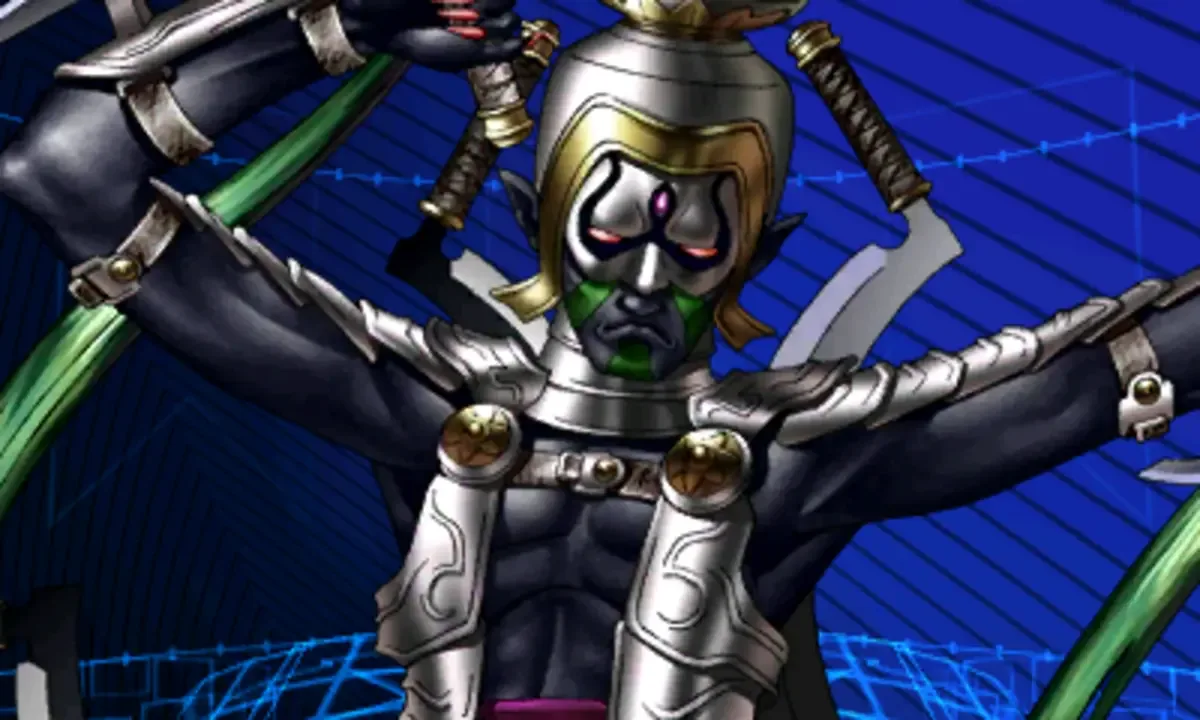
A demon, just obtained through the fusion of two other demons
Generally, the SMT games focus their attention on gameplay, leaving a barebones story. This time around I feel that it is a little bit different. SMT IV's story is interesting, and exploring Tokyo and knowing the truths about all its factions and the Kingdom of Mikado is engaging. SMT games make the player choose between three sides through some dialogue options to get a different ending: chaos, a world ruled by the strongest; law, a world where people live peacefully but are totally subjected to the will of the gods; and neutral, a refusal of the two previous alignments for something that is truly beneficial to humans as a whole. The three companions of Flynn act as the embodiment of one of these alignments, so they are very one-dimensional, especially near the end. Luckily the other characters are a little more complex and fit perfectly the role assigned to them. Depending on the choices made by the player, you can get one of the three different alignments: I did the neutral route, which was a little underwhelming. In addition, it was almost impossible to get without a guide and required finishing almost all the side quests, so it made me feel like I had done a lot of fruitless effort. On the other hand, the story as a whole is rather interesting and closes all the threads that it opens in the 40 hours of the game runtime, so it's a plus.
GAMEPLAY: FIGHTING AND EXPLORING
SMT IV is a JRPG with a modern sensibility. Monsters are visible in the 3D environment as glitchy figures. After each fight, you get a variable amount of experience depending on your level difference with the enemies; you can save anywhere and so on. At the heart is a classic turn-based JRPG, where you control Flynn and up to three demons summoned from your reserve, which act exactly as your character. The quality of life improvements, though, avoid grinding for experience and make the traversal of low-level areas less tedious thanks to the visible enemy encounters. You and your demons can attack physically, with a ranged (gun) attack, or through elemental magic. Hitting the enemy's weakness gives you one additional turn to act, and hitting an immunity makes you lose a turn. The heart of the game is all here: try to hit the enemy elemental weakness to get more turns while buffing yourself and debuffing the enemy. The foes fight following exactly the same rules, so if they hit with their attacks the weakness of your party, they get additional turns to act.
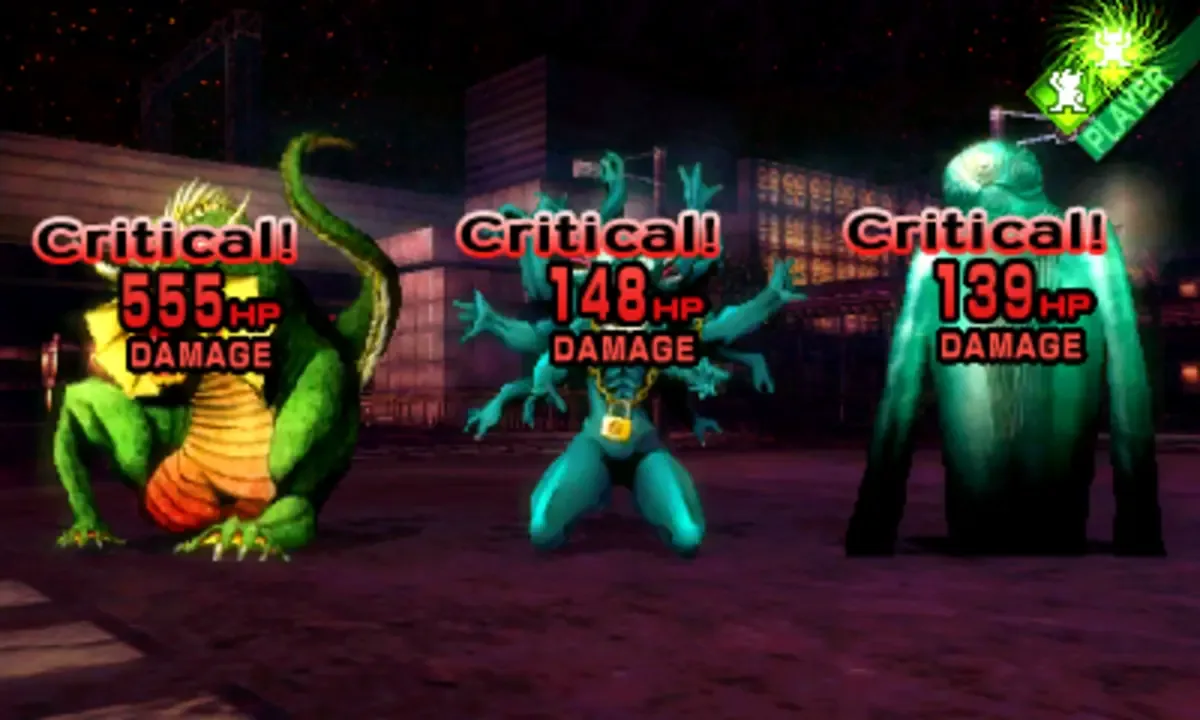
Here the player realized a critical hit, and got an additional turn (the flashing square on the top left of the screen)
Here it comes out one of the big flaws of the game: the combat system is tactical and interesting, but both the player and the enemies dish out too much damage compared to the health pools available. So the player can often kill the boss in one long turn, or lucky strikes of the enemies can result in a shower of free turns that wipe out the whole player's party. The balance is strange, and it results in a game that is either too easy or frustratingly difficult for the wrong reasons. Fusing the monsters and using them in battle is very fun, and hitting the weaknesses of the enemies feels rewarding, but the balance problems are impossible to overlook. In particular, the first hours of the game are brutally difficult since the range of demons that the player can fuse is limited, and the bosses require specific builds to avoid being annihilated in a few turns, and then the rest of the game offers almost no difficulty until the final boss difficulty spike. On the other hand, there are a lot of different demons to try with different stats and skillsets, and fusing them to gain more powerful demons is encouraged and helps to keep the battles fresh. Sadly, the demons have unique learned skillsets but their stats distributions are fixed in few different archetypes.
The player explores Mikado choosing the location to explore with a static menu, while Tokyo is explored moving around a token representing the whole party, and the dungeons and all the location of interest are all explored in third person controlling Flynn and moving him in 3D environments. The static menus last only few hours, and are almost negligible. The map of Tokyo is very detailed and beautiful to see, but it's very confusing to navigate. The points of interest have no labels, so you can't know what you are entering until you're actually inside, and there are a lot of different places with strange names (at least for an Italian). This result in a navigation mess: the characters will refer to very specific places and will sometimes give some vague locations, and the player is forced to running around in circles until it litterally stumbles on the right path. The Tokyo overworld map is a great nod to the first game that fills me with joy, but the game exploration could have been much better. Luckily exploring the 3D environments is fun, the direction to take is clear and tresure items are hidden everywhere.
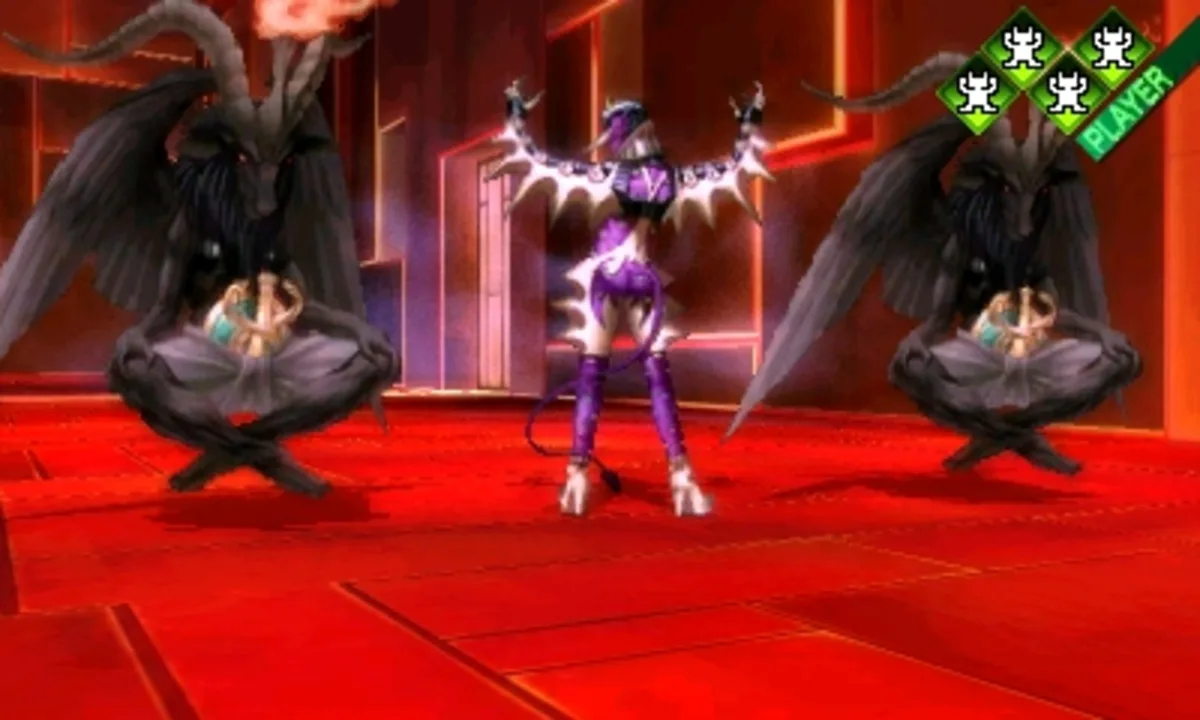
There are a lot of different demons in the game, for example here are Baphomet and another fallen angel taken from Christian mythology
Lying around Tokyo, there are a lot of optional dungeons (domains) and locations to explore. Most of them have just a little dialogue or are empty until the player accepts one of the secondary quests available in the safehouses scattered around. There are a lot of side quests, and as I said, most of them are required to get the neutral ending, which is considered the canonical conclusion of the game. The quests add some interesting lore and details to the game world, and some of them are chained together to tell the story of some secondary characters, but their structure is not very innovative. Most of the time they ask you to kill a particular boss demon or to retrieve a certain item in a domain. Even if the additional bosses are pretty inspired, the quests are almost impossible to complete as soon as they are available, and most of the time when the player returns to them, they are too easy. A real pity, and the obligation to finish most of them to get the canonic ending really drains out the fun of the late game.
GRAPHICS, MUSIC AND FINAL CONSIDERATIONS
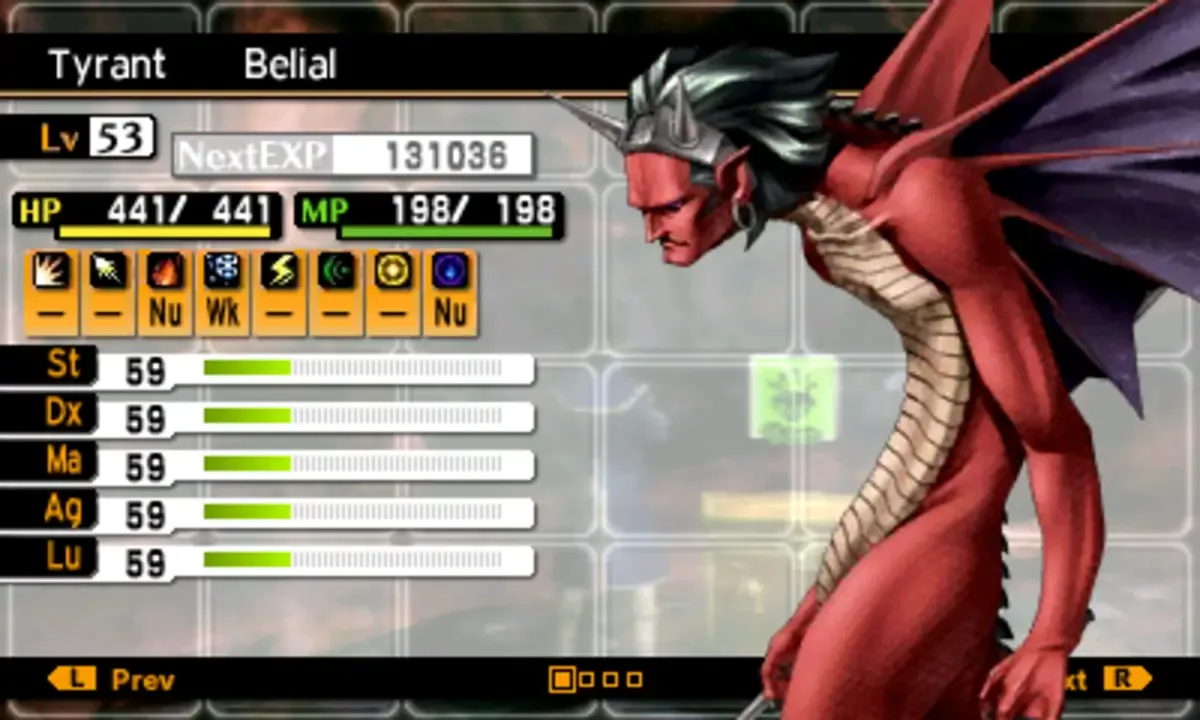
Every monster has a unique picture, and some of them have a pretty unique interpretation compared to the classical mythological iconography
The game boasts some of the most impressive 3D environments of the 3DS, detailed and with a great artistic direction. Exploring Tokyo is always interesting, and when ruined buildings and abandoned neighbourhoods start to feel stale, the game introduces otherworldly environments and hellish landscapes. The 2D drawings of characters and demons are really well done, and even the armour pieces can be seen on Flynn during the exploration of the 3D environments. The music, in addition, is phenomenal and mixes different genres while keeping a distinct personality. You will return for sure to listen to some tracks after you have finished the game; mark my words. They are just so catchy and well-orchestrated.
Even if I pointed out a lot of negative aspects, I can say that I liked this game a lot. I point out the cons mainly because this game could have been really a masterpiece, but the developers have made some pretty stupid mistakes, in my opinion. The fuse and fight formula of the demons, almost Pokémon-like, is addicting, and the game will keep the player glued for the whole 40 hours of runtime. It's very sad that this game, along with the sequel Apocalypse, was forgotten by Atlus and left without remasters or even porting to other more modern consoles. I feel that SMT IV is a perfect entry for someone to get into the franchise and could really have benefitted from a round of corrections to smooth out some of the rougher edges of the production. It remains a very solid work that is worth playing until the end and probably one of the highlights of the 3DS library.
FINAL SCORE: 7.5/10
-------------------------------------------------------------------------------------------------------------------------------------------------------------------------------------------------------------------------
A Link to the Past almost finished. A flawless game, nothing to add.
On the other hand, Crossed Swords is long as an arcade game but it drags far too long. Interesting, but very difficult and not fun for the whole runtime.
Shin Megami Tensei IV - 3DS
Genre: JRPG
Developer/Year: Atlus, 2013
Score: 7.5/10
It was the start of the Covid period, and everyone in Italy was locked into their homes. Among the restless boredom, the university lessons through Teams and all the gym that I did in my bedroom to avoid getting too out of shape were playing distinctly two games: Yakuza 0 and the first Shin Megami Tensei. I played the SNES original version of Shin Megami Tensei (SMT from now on) emulated with RetroArch and patched to have integrated the English language. I dropped SMT 1 almost halfway through; it was old, a little clunky, and the restless and always present random encounters put a strain on my enjoyment of the game. Years before, I also played SMT: Devil Survivor on the NDS, but my R4 died before I finished it, and I never played it again. So my story with SMT is a little rough, and I abandoned for one reason or another two games. Since I modded my 3DS some time ago and I was intrigued by the fourth entry of the SMT franchise, one day I decided impulsively to play it, and here I am.
INTRODUCTION AND PLOT
Shin Megami Tensei IV is a JRPG developed by Atlus for the 3DS and never ported to other systems. Probably you know Atlus through Persona, the main selling JRPG of the franchise. Actually, Persona was once a spinoff of the SMT games that gained much more traction than the parent game, mainly thanks to its less grim story and its school life simulation elements. I actually don't like very much the "adolescents in a school with magic elements" trope very common in Japanese media, so I never really liked the Persona series. On the other hand, I always really liked the mainline SMT games, which fused classic mythology with an apocalyptic or post-apocalyptic story.
SMT games generally tell self-contained stories with different settings, but they all have some fixed points. They narrate the story of a group of young adults living in Tokyo who, in one way or another, gain a technological device running the "Demon Summoning Program", which makes them able to summon demons to fight for them. These demons are mythological figures taken from all around the world and can be fused together to get even stronger demons. In particular, SMT IV follows Flynn, a Samurai of the Eastern Kingdom of Mikado, a mediaeval-like theocracy where the population is rigidly divided into castes. Flynn will be chosen to wield an ancient artefact, which is just a big smart bracelet with the Demon Summoning Program installed, and adventure with some mates through a demon-infested underground called Naraku. Soon they will find that at the end of Naraku there is just the city of Tokyo, covered by a giant rock dome that plunged it into a demon-infested night apocalypse.

A demon, just obtained through the fusion of two other demons
Generally, the SMT games focus their attention on gameplay, leaving a barebones story. This time around I feel that it is a little bit different. SMT IV's story is interesting, and exploring Tokyo and knowing the truths about all its factions and the Kingdom of Mikado is engaging. SMT games make the player choose between three sides through some dialogue options to get a different ending: chaos, a world ruled by the strongest; law, a world where people live peacefully but are totally subjected to the will of the gods; and neutral, a refusal of the two previous alignments for something that is truly beneficial to humans as a whole. The three companions of Flynn act as the embodiment of one of these alignments, so they are very one-dimensional, especially near the end. Luckily the other characters are a little more complex and fit perfectly the role assigned to them. Depending on the choices made by the player, you can get one of the three different alignments: I did the neutral route, which was a little underwhelming. In addition, it was almost impossible to get without a guide and required finishing almost all the side quests, so it made me feel like I had done a lot of fruitless effort. On the other hand, the story as a whole is rather interesting and closes all the threads that it opens in the 40 hours of the game runtime, so it's a plus.
GAMEPLAY: FIGHTING AND EXPLORING
SMT IV is a JRPG with a modern sensibility. Monsters are visible in the 3D environment as glitchy figures. After each fight, you get a variable amount of experience depending on your level difference with the enemies; you can save anywhere and so on. At the heart is a classic turn-based JRPG, where you control Flynn and up to three demons summoned from your reserve, which act exactly as your character. The quality of life improvements, though, avoid grinding for experience and make the traversal of low-level areas less tedious thanks to the visible enemy encounters. You and your demons can attack physically, with a ranged (gun) attack, or through elemental magic. Hitting the enemy's weakness gives you one additional turn to act, and hitting an immunity makes you lose a turn. The heart of the game is all here: try to hit the enemy elemental weakness to get more turns while buffing yourself and debuffing the enemy. The foes fight following exactly the same rules, so if they hit with their attacks the weakness of your party, they get additional turns to act.

Here the player realized a critical hit, and got an additional turn (the flashing square on the top left of the screen)
Here it comes out one of the big flaws of the game: the combat system is tactical and interesting, but both the player and the enemies dish out too much damage compared to the health pools available. So the player can often kill the boss in one long turn, or lucky strikes of the enemies can result in a shower of free turns that wipe out the whole player's party. The balance is strange, and it results in a game that is either too easy or frustratingly difficult for the wrong reasons. Fusing the monsters and using them in battle is very fun, and hitting the weaknesses of the enemies feels rewarding, but the balance problems are impossible to overlook. In particular, the first hours of the game are brutally difficult since the range of demons that the player can fuse is limited, and the bosses require specific builds to avoid being annihilated in a few turns, and then the rest of the game offers almost no difficulty until the final boss difficulty spike. On the other hand, there are a lot of different demons to try with different stats and skillsets, and fusing them to gain more powerful demons is encouraged and helps to keep the battles fresh. Sadly, the demons have unique learned skillsets but their stats distributions are fixed in few different archetypes.
The player explores Mikado choosing the location to explore with a static menu, while Tokyo is explored moving around a token representing the whole party, and the dungeons and all the location of interest are all explored in third person controlling Flynn and moving him in 3D environments. The static menus last only few hours, and are almost negligible. The map of Tokyo is very detailed and beautiful to see, but it's very confusing to navigate. The points of interest have no labels, so you can't know what you are entering until you're actually inside, and there are a lot of different places with strange names (at least for an Italian). This result in a navigation mess: the characters will refer to very specific places and will sometimes give some vague locations, and the player is forced to running around in circles until it litterally stumbles on the right path. The Tokyo overworld map is a great nod to the first game that fills me with joy, but the game exploration could have been much better. Luckily exploring the 3D environments is fun, the direction to take is clear and tresure items are hidden everywhere.

There are a lot of different demons in the game, for example here are Baphomet and another fallen angel taken from Christian mythology
Lying around Tokyo, there are a lot of optional dungeons (domains) and locations to explore. Most of them have just a little dialogue or are empty until the player accepts one of the secondary quests available in the safehouses scattered around. There are a lot of side quests, and as I said, most of them are required to get the neutral ending, which is considered the canonical conclusion of the game. The quests add some interesting lore and details to the game world, and some of them are chained together to tell the story of some secondary characters, but their structure is not very innovative. Most of the time they ask you to kill a particular boss demon or to retrieve a certain item in a domain. Even if the additional bosses are pretty inspired, the quests are almost impossible to complete as soon as they are available, and most of the time when the player returns to them, they are too easy. A real pity, and the obligation to finish most of them to get the canonic ending really drains out the fun of the late game.
GRAPHICS, MUSIC AND FINAL CONSIDERATIONS

Every monster has a unique picture, and some of them have a pretty unique interpretation compared to the classical mythological iconography
The game boasts some of the most impressive 3D environments of the 3DS, detailed and with a great artistic direction. Exploring Tokyo is always interesting, and when ruined buildings and abandoned neighbourhoods start to feel stale, the game introduces otherworldly environments and hellish landscapes. The 2D drawings of characters and demons are really well done, and even the armour pieces can be seen on Flynn during the exploration of the 3D environments. The music, in addition, is phenomenal and mixes different genres while keeping a distinct personality. You will return for sure to listen to some tracks after you have finished the game; mark my words. They are just so catchy and well-orchestrated.
Even if I pointed out a lot of negative aspects, I can say that I liked this game a lot. I point out the cons mainly because this game could have been really a masterpiece, but the developers have made some pretty stupid mistakes, in my opinion. The fuse and fight formula of the demons, almost Pokémon-like, is addicting, and the game will keep the player glued for the whole 40 hours of runtime. It's very sad that this game, along with the sequel Apocalypse, was forgotten by Atlus and left without remasters or even porting to other more modern consoles. I feel that SMT IV is a perfect entry for someone to get into the franchise and could really have benefitted from a round of corrections to smooth out some of the rougher edges of the production. It remains a very solid work that is worth playing until the end and probably one of the highlights of the 3DS library.
FINAL SCORE: 7.5/10
-------------------------------------------------------------------------------------------------------------------------------------------------------------------------------------------------------------------------
CURRENTLY PLAYING
- The Legend of Zelda: A Link to the Past - SNES (Emulated)
- Crossed Swords - Neo Geo (Emulated)
A Link to the Past almost finished. A flawless game, nothing to add.
On the other hand, Crossed Swords is long as an arcade game but it drags far too long. Interesting, but very difficult and not fun for the whole runtime.
4 Yrs✓#
f_n_c
4 Yrs✓#
UPDATE #26
A little more than a year ago I finished the first Modern Warfare game. I had quite some fun with it, even if it is a little outdated in design compared to the later entries. It poses the foundations for the two games to come, and the nuclear explosion representation is phenomenal, but in my opinion it lacked a few memorable moments. Since my first PS3 game was COD MW3 more than 10 years ago, I always wanted to know the events that led to the dramatic starting situation of MW3. Well, now it's time.
WARNING! SPOILERS FROM MW1 AHEAD. LIGHT SPOILERS OF THE FIRST FEW MWS MISSIONS. YOU ARE WARNED.
INTRODUCTION AND STORY
Call of Duty is a series that doesn't need much presentation. I played it a lot as a multiplayer shooter as a teen, but that side doesn't interest me anymore so I'll review only the campaign and the co-op special operations.
After the dramatic events of MW1, after Zakhaev's death, the world seemed wounded but on the recovery path. Instead, the Russian Ultranationalists, led by the terrorist Makarov, made Zakhaev a war hero and planned to spark a world conflict between the two superpowers of the USA and Russia. In this bleak scenario, the first missions of the campaign take place: after a training camp similar to the first mission of MW1, the player is thrown into a hot warzone in Afghanistan with the US Army and then on a frozen peak with Soap. MW2 doesn't hold any punches: the first missions are incredibly fast-paced and bring the player between different sceneries towards the gut punch of the (in)famous "No Russian" and the consequent Russian attack on the USA. Compared to the first game, MW2 creates very compelling characters and exploits intelligently built set pieces to bring forward a story reminiscent of the bombastic Michael Bay movies.
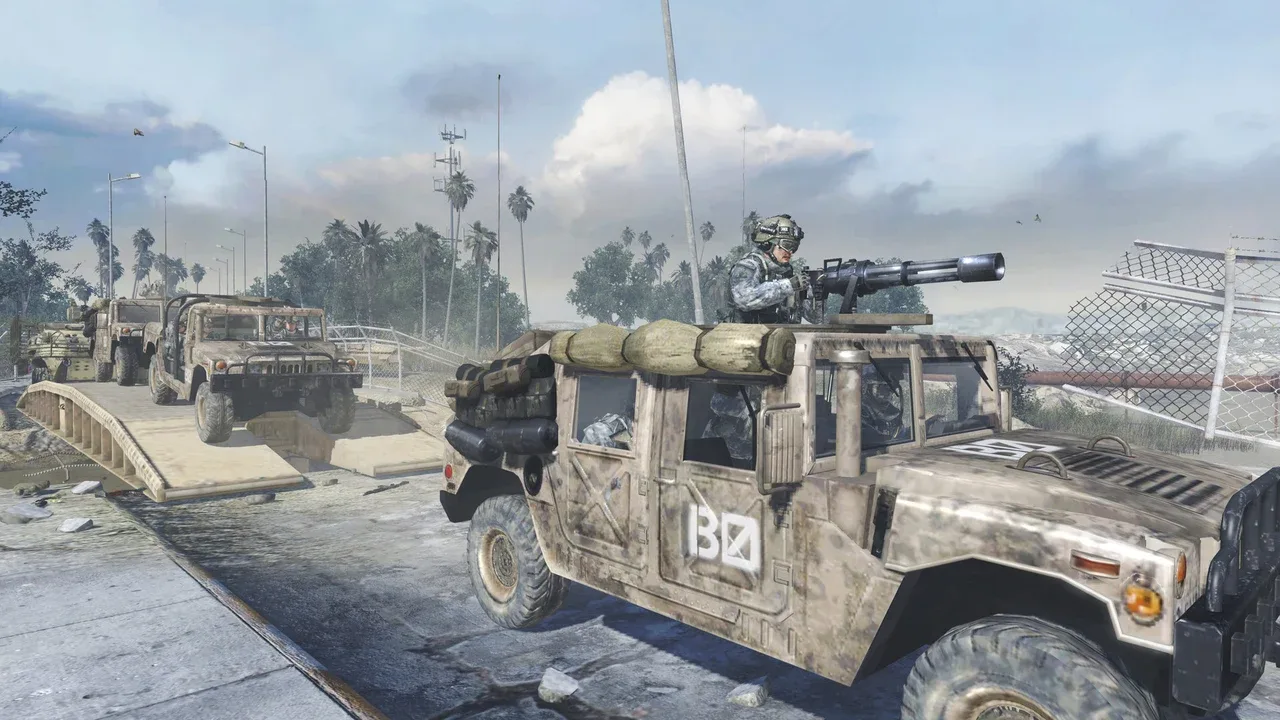
A convoy of US troops in Afghanistan, the true first mission of the game after the tutorial
From a common neighborhood of the East Coast ravaged by the Russian troops to exotic places in the eastern part of the world, MW2 knows how to impress the player. The story is functional and sets up perfectly the incredible action set pieces. Price, Soap, Roach, and Ghost will stand out from the rest of the characters more than in the first game, making the various plot twists much more impactful. Compared to the first two Black Ops, the story is less unique in themes and raw ideas, but being grounded in reality makes it much scarier, considering also the times we're in. The MW2 campaign is considered the best of the series for one reason: considering the story and the missions, probably the other games (except MW1) of the PS3 era are a little more interesting, but the flawless execution of MW2 makes it worth much more than the sum of its parts.
GAMEPLAY AND TECHNICAL ASPECTS
MW2, as all the other PS3 CoDs, have a lot of weapons that are really well characterized. Firing them is a pleasure, and is interesting also to see how well they are matched to the situations of the missions. For example, terrorists and gangs would have old weapons like the FAL, Uzis and AK-47 while the Russian and American armies have belivable assault rifles and sidearms. The player will split between the American army, starting always with similar standardized weapons, and the Task Force 141 of Price and Soap, which would use a wide variety of weapons. The LMGs feel heavy and powerful, the sniper rifles are very handy in some sections and some levels with small alleys make shotguns viable. Even if the player can't select freely the attachments for its weapons, there are a lot of them and the campaign makes them all playable at least once throughout the whole campaign. The player has to know how to use all the weapons effectively, since the difficulty is rather high and especially in the higher difficulty levels the enemies can hit very hard and leave very few room for error. The movement is free from all the additions of the later games, so the gunplay remains at the core of the experience.
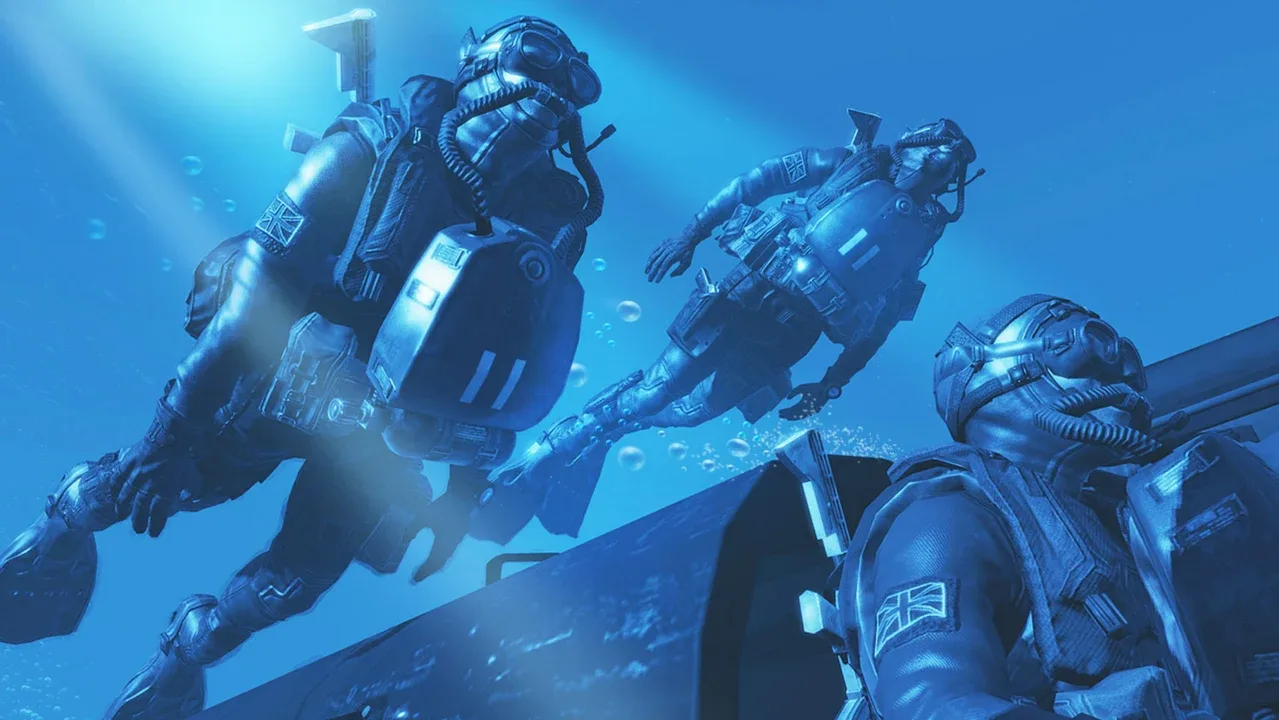
Out from a submarine to assault a Russian oil rig. Soap knows no rest
The game is rather old but uses its graphical capabilities with intelligence. The light and volumetric effects give life to a lot of scenes, and the lack of graphical fidelity compared to modern games is balanced by a consistent art direction. The areas may lack some details in some areas, but the player will traverse them so fast that they will seem perfect. I didn't have any problems regarding bugs and the general stability of the game, and the whole experience was definitely very smooth. The presentation videos between the missions put in to fill the loading times are wonderfully crafted and really helped with the immersion, something that denotes the attention to detail at all levels that Infinity Ward put into MW2. Last, I played only a few missions of the Special Ops, cooperative missions that recycle the campaign environments but ramp up the challenge dramatically. They are fun for what they are, but sometimes they are a little too punishing for my taste, and as a solo experience don't do enough to keep the player in the game. In this regard, in my opinion, the MW3 Special Ops are more refined and enjoyable also as a solo player.
VERDICT
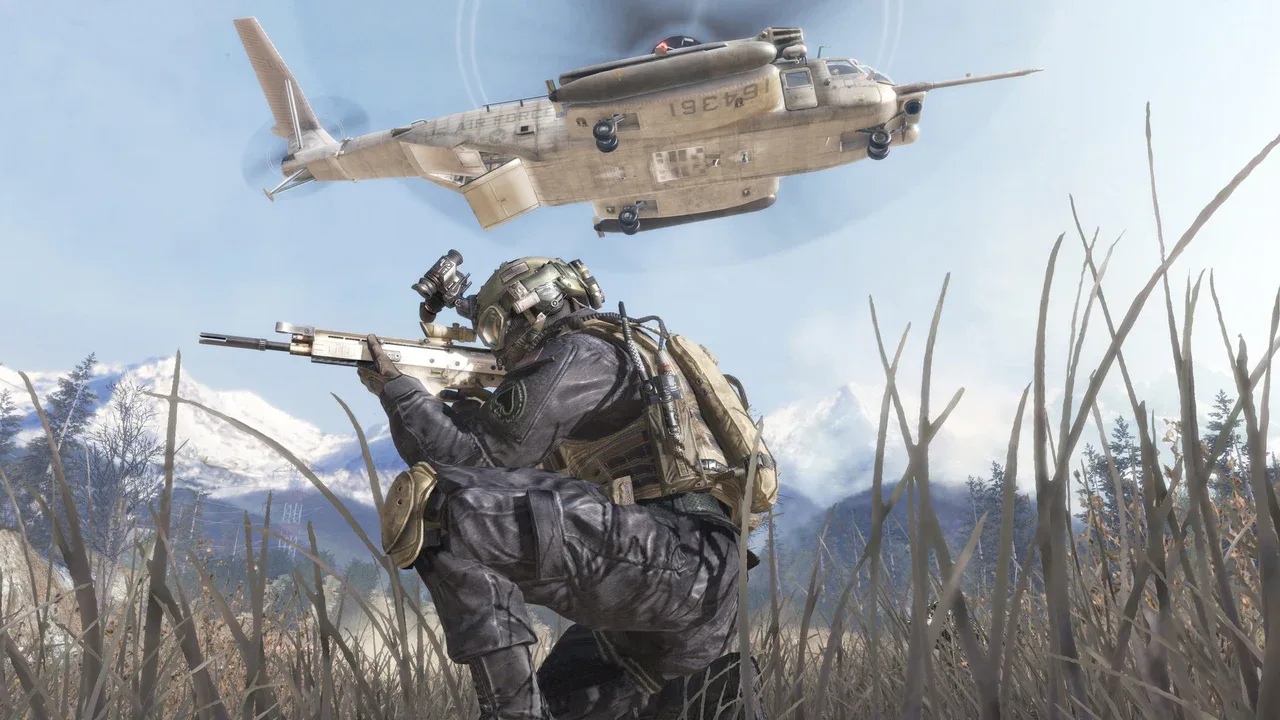
A peaceful retreat in the mountains south of Russia is the theater for a dramatic, final twist
Looking at the state of Call of Duty today, it seems strange that the new games belong to the same series as MW2. I'm not very updated on this, and the later entries seem a little better, but when I stopped playing CoD altogether in the final PS4/XBOX One era, the series seemed very distant from what made MW2 great. "No Russian" is a masterpiece, a visceral and disgusting flip of point of view that definitely carved a little space for MW2 in video game history. Aside from that, MW2's campaign is iconic and a milestone in the history of CoD. The game is not perfect, but it's the best product if you seek a short but intense adrenaline burst.
FINAL SCORE: 8.5/10
-------------------------------------------------------------------------------------------------------------------------------------------------------------------------------------------------------------------------
Layton games are special, simple but fun. Compared to the previous games, which seemed pretty normal and threw an unexpected, crazy event in the end, this game is batshit crazy from the start with the introduction of time travel. For now the only flaws are the puzzles, which are a little worse compared to the previous game.
Call of Duty: Modern Warfare 2 - PC
Genre: First Person Shooter
Developer/Year: Infinity Ward, 2009
Score: 8.5/10
A little more than a year ago I finished the first Modern Warfare game. I had quite some fun with it, even if it is a little outdated in design compared to the later entries. It poses the foundations for the two games to come, and the nuclear explosion representation is phenomenal, but in my opinion it lacked a few memorable moments. Since my first PS3 game was COD MW3 more than 10 years ago, I always wanted to know the events that led to the dramatic starting situation of MW3. Well, now it's time.
WARNING! SPOILERS FROM MW1 AHEAD. LIGHT SPOILERS OF THE FIRST FEW MWS MISSIONS. YOU ARE WARNED.
INTRODUCTION AND STORY
Call of Duty is a series that doesn't need much presentation. I played it a lot as a multiplayer shooter as a teen, but that side doesn't interest me anymore so I'll review only the campaign and the co-op special operations.
After the dramatic events of MW1, after Zakhaev's death, the world seemed wounded but on the recovery path. Instead, the Russian Ultranationalists, led by the terrorist Makarov, made Zakhaev a war hero and planned to spark a world conflict between the two superpowers of the USA and Russia. In this bleak scenario, the first missions of the campaign take place: after a training camp similar to the first mission of MW1, the player is thrown into a hot warzone in Afghanistan with the US Army and then on a frozen peak with Soap. MW2 doesn't hold any punches: the first missions are incredibly fast-paced and bring the player between different sceneries towards the gut punch of the (in)famous "No Russian" and the consequent Russian attack on the USA. Compared to the first game, MW2 creates very compelling characters and exploits intelligently built set pieces to bring forward a story reminiscent of the bombastic Michael Bay movies.

A convoy of US troops in Afghanistan, the true first mission of the game after the tutorial
From a common neighborhood of the East Coast ravaged by the Russian troops to exotic places in the eastern part of the world, MW2 knows how to impress the player. The story is functional and sets up perfectly the incredible action set pieces. Price, Soap, Roach, and Ghost will stand out from the rest of the characters more than in the first game, making the various plot twists much more impactful. Compared to the first two Black Ops, the story is less unique in themes and raw ideas, but being grounded in reality makes it much scarier, considering also the times we're in. The MW2 campaign is considered the best of the series for one reason: considering the story and the missions, probably the other games (except MW1) of the PS3 era are a little more interesting, but the flawless execution of MW2 makes it worth much more than the sum of its parts.
GAMEPLAY AND TECHNICAL ASPECTS
MW2, as all the other PS3 CoDs, have a lot of weapons that are really well characterized. Firing them is a pleasure, and is interesting also to see how well they are matched to the situations of the missions. For example, terrorists and gangs would have old weapons like the FAL, Uzis and AK-47 while the Russian and American armies have belivable assault rifles and sidearms. The player will split between the American army, starting always with similar standardized weapons, and the Task Force 141 of Price and Soap, which would use a wide variety of weapons. The LMGs feel heavy and powerful, the sniper rifles are very handy in some sections and some levels with small alleys make shotguns viable. Even if the player can't select freely the attachments for its weapons, there are a lot of them and the campaign makes them all playable at least once throughout the whole campaign. The player has to know how to use all the weapons effectively, since the difficulty is rather high and especially in the higher difficulty levels the enemies can hit very hard and leave very few room for error. The movement is free from all the additions of the later games, so the gunplay remains at the core of the experience.

Out from a submarine to assault a Russian oil rig. Soap knows no rest
The game is rather old but uses its graphical capabilities with intelligence. The light and volumetric effects give life to a lot of scenes, and the lack of graphical fidelity compared to modern games is balanced by a consistent art direction. The areas may lack some details in some areas, but the player will traverse them so fast that they will seem perfect. I didn't have any problems regarding bugs and the general stability of the game, and the whole experience was definitely very smooth. The presentation videos between the missions put in to fill the loading times are wonderfully crafted and really helped with the immersion, something that denotes the attention to detail at all levels that Infinity Ward put into MW2. Last, I played only a few missions of the Special Ops, cooperative missions that recycle the campaign environments but ramp up the challenge dramatically. They are fun for what they are, but sometimes they are a little too punishing for my taste, and as a solo experience don't do enough to keep the player in the game. In this regard, in my opinion, the MW3 Special Ops are more refined and enjoyable also as a solo player.
VERDICT

A peaceful retreat in the mountains south of Russia is the theater for a dramatic, final twist
Looking at the state of Call of Duty today, it seems strange that the new games belong to the same series as MW2. I'm not very updated on this, and the later entries seem a little better, but when I stopped playing CoD altogether in the final PS4/XBOX One era, the series seemed very distant from what made MW2 great. "No Russian" is a masterpiece, a visceral and disgusting flip of point of view that definitely carved a little space for MW2 in video game history. Aside from that, MW2's campaign is iconic and a milestone in the history of CoD. The game is not perfect, but it's the best product if you seek a short but intense adrenaline burst.
FINAL SCORE: 8.5/10
-------------------------------------------------------------------------------------------------------------------------------------------------------------------------------------------------------------------------
CURRENTLY PLAYING
- Professor Layton and the Unwound Future - 3DS (DS Mode)
Layton games are special, simple but fun. Compared to the previous games, which seemed pretty normal and threw an unexpected, crazy event in the end, this game is batshit crazy from the start with the introduction of time travel. For now the only flaws are the puzzles, which are a little worse compared to the previous game.
4 Yrs✓#
f_n_c
4 Yrs✓#
UPDATE #27
SPECIAL UPDATE: THE HALF-YEAR UPDATE!
Yes, I know, it's the middle of July, and we passed the precise half-year almost one month ago, but who cares! Now I've the time to update the blog.
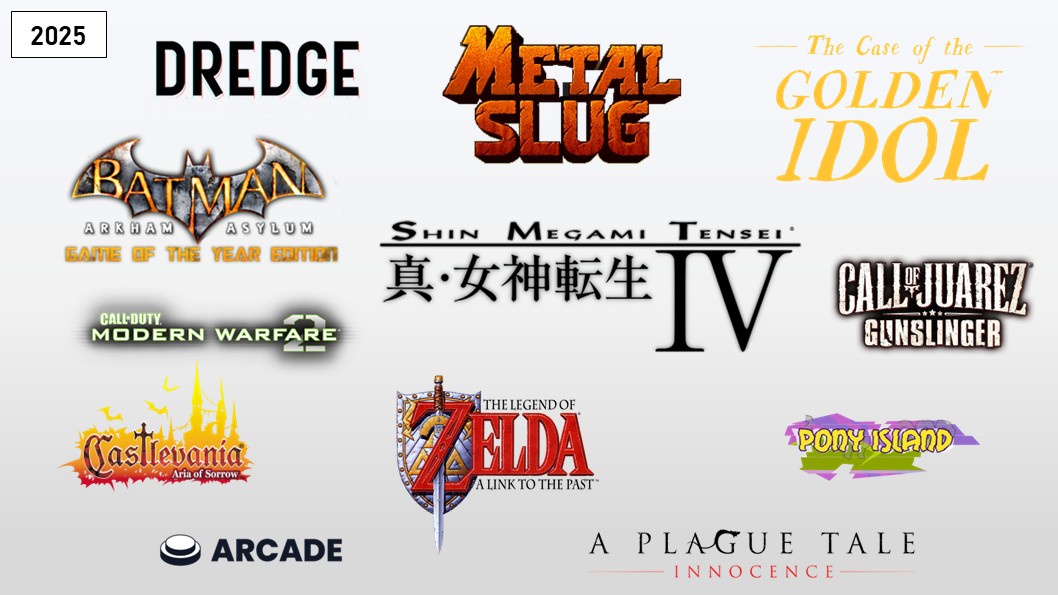
As you can see from the infographics, I managed to complete almost one game per month if you don't consider arcade games. I'm in the middle of my Metal Slug series playthrough, though, so it isn't a fully complete game either. All considered, I'm pretty happy with my year. One of the games, "The Case of the Golden Idol," managed also to enter in my list of 30 favorite games. I haven't played even a bad game; the worst from the list is Pony Island, but it's a solid game and is the worst only because the level is too high. Amazon Luna was a constant in these months, with three games finished (Call of Juarez: Gunslinger, A Plague Tale: Innocence, and Dredge); proving to be a reliable gaming platform.
Maybe the biggest disappointment of this year is Shin Megami Tensei IV. I had great expectations for it; it was a good RPG, and the demon-related mechanics were a blast, but it had too many flaws to consider it a great experience. I will play Apocalypse, maybe next year, since, everything considered, I had a good time with SMT IV, but I wished the developers didn't make the plethora of small mistakes in the original game.
This half year was also pretty varied; there aren't any games of the same genre. I want to play some big RPGs in the next half of the year, so I'm sure that the final result will not be as balanced as this one. Looking at my list of 2025 games made in January, I probably will miss only Baldur's Gate 2 since now I don't really want to play it in the next months, and I'm keeping some other games (FF IX, Max Payne, Ace Combat 3, and Arkham Origins) for the fall-winter season. Probably my next game after Professor Layton will be Fire Emblem, and probably I'll sidetrack to a Fallout game (I or New Vegas) after that. I played both these Fallout games some years ago, but I never finished them: I was stuck in an unwinnable situation in Fallout 1 without any saves to go back to, and I played New Vegas on Game Pass, and I stopped the subscription before finishing it. Maybe the next half of the year will be a luckier season for my Fallout playthroughs. :-)
SPECIAL UPDATE: THE HALF-YEAR UPDATE!
Yes, I know, it's the middle of July, and we passed the precise half-year almost one month ago, but who cares! Now I've the time to update the blog.

As you can see from the infographics, I managed to complete almost one game per month if you don't consider arcade games. I'm in the middle of my Metal Slug series playthrough, though, so it isn't a fully complete game either. All considered, I'm pretty happy with my year. One of the games, "The Case of the Golden Idol," managed also to enter in my list of 30 favorite games. I haven't played even a bad game; the worst from the list is Pony Island, but it's a solid game and is the worst only because the level is too high. Amazon Luna was a constant in these months, with three games finished (Call of Juarez: Gunslinger, A Plague Tale: Innocence, and Dredge); proving to be a reliable gaming platform.
Maybe the biggest disappointment of this year is Shin Megami Tensei IV. I had great expectations for it; it was a good RPG, and the demon-related mechanics were a blast, but it had too many flaws to consider it a great experience. I will play Apocalypse, maybe next year, since, everything considered, I had a good time with SMT IV, but I wished the developers didn't make the plethora of small mistakes in the original game.
This half year was also pretty varied; there aren't any games of the same genre. I want to play some big RPGs in the next half of the year, so I'm sure that the final result will not be as balanced as this one. Looking at my list of 2025 games made in January, I probably will miss only Baldur's Gate 2 since now I don't really want to play it in the next months, and I'm keeping some other games (FF IX, Max Payne, Ace Combat 3, and Arkham Origins) for the fall-winter season. Probably my next game after Professor Layton will be Fire Emblem, and probably I'll sidetrack to a Fallout game (I or New Vegas) after that. I played both these Fallout games some years ago, but I never finished them: I was stuck in an unwinnable situation in Fallout 1 without any saves to go back to, and I played New Vegas on Game Pass, and I stopped the subscription before finishing it. Maybe the next half of the year will be a luckier season for my Fallout playthroughs. :-)
4 Yrs✓#
f_n_c
4 Yrs✓#
UPDATE #28
Another Amazon Luna game. I noticed that A Plague Tale was released in 2019, but I never had any particular interest in it. Now that I had it with my Prime subscription, I was fascinated by the setting, and I decided to give it a chance. As a side note, playing adventure games like this on Amazon Luna is a great experience. These games work well both on a keyboard and on a pad, and it is very convenient to have the game accessible from any platform, from the PC to the smart TV.
THE STORY
Amicia and Hugo are two siblings, offspring of a local noble in 14th-century France. Amicia is a normal girl who suffers the absence of her parents, while Hugo is segregated in his quarters since he has a strange, unknown illness, and his mother stays with him all day trying to find a cure. The game opens with a tutorial where Amicia, her father, and her dog hunt in the wilderness surrounding the castle. But her dog is suddenly swallowed into the ground, and they are forced to run back to the castle. The castle is then assaulted by inquisitors searching for Hugo, who kill Amicia's parents and force the two siblings to escape to a nearby village. There they discover that the region is ravaged by plague, and the rats bringing it go out in the darkness in swarms, eating every living thing they encounter.
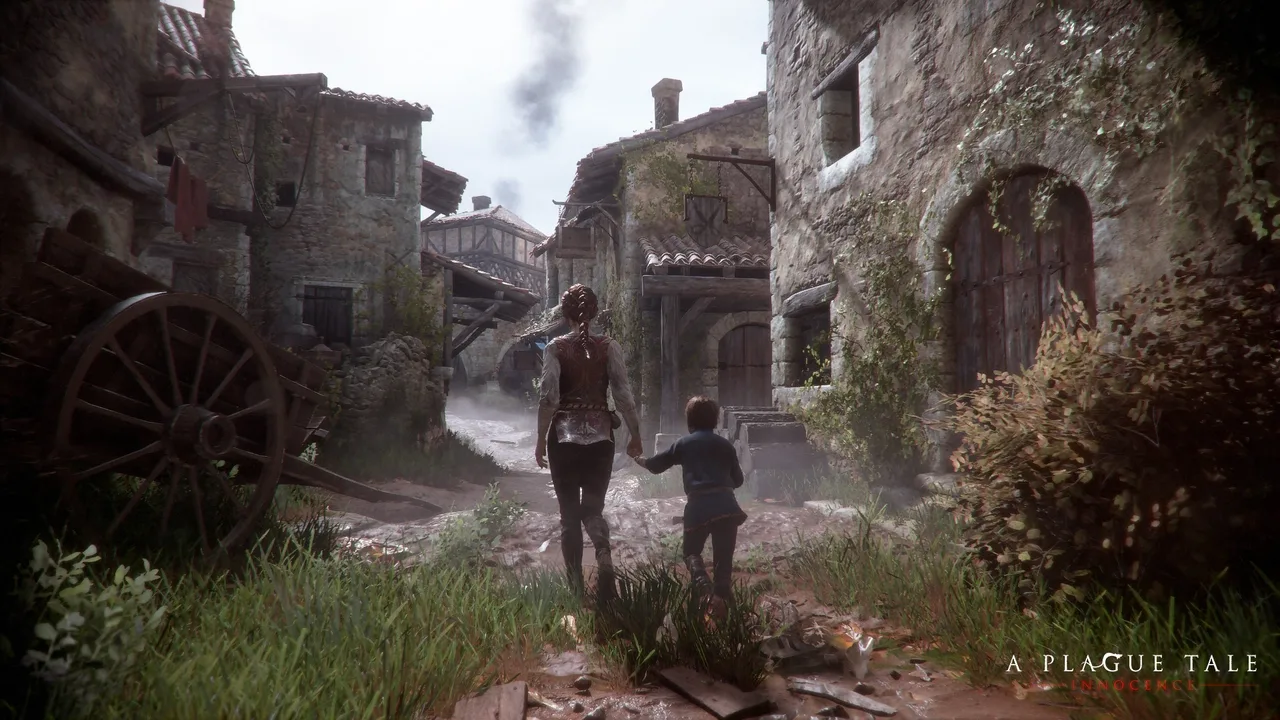
Amicia and Hugo exploring the small village near their castle
These are the premises of the first hour or so of the game. As you can see, the game has a historical setting, but it has a very heavy fantasy soul linked to the rat swarms, more terrible monsters than real animals, and the plague itself. This is a story-driven game where you play linearly on a straight path that brings you through the various chapters of the story, explained also through cutscenes. The story is not particularly complex, but it does its job efficiently. Amicia and Hugo are well characterized, and the player really connects with them through their misfortunes. There are a few other characters, two bad guys and some allies of the two siblings, who are not particularly brilliant but give a little bit of added variety to the narration. The game isn't called Innocence by Chance: Amicia and Hugo start as pure souls, young and innocent, but as the story progresses, the innocence is torn from them by the violence of the world. Amicia will be forced to kill to survive, and as the story progresses, she will be less and less reluctant to do so. Seeing the downward spiral of the two characters has a great emotive impact. In addition, the setting is also interesting; the plague paired with the Hundred Years' War generates some pretty interesting set pieces: a village with crazed residents, a battlefield littered by corpses, an abbey, an old castle, and a quarantined city.
I had a very big problem with the ending of the game though. I really don't like it, but I can't say more without spoilers.
ATTENTION: SPOILERS FROM THE END OF THE GAME!!
The whole game is about Amicia and Hugo fleeing from the rats and the soldiers trying to catch them. Killing is viewed as a negative action, twisting Amicia's mind, and the sense of dread and danger is always present. In the end, it is discovered that the plague is linked to Hugo's illness, and he can control the rats with magical powers. So they decide to go to the quarantined city, where the great inquisitor (the main antagonist) resides, to kill him. He wants to use powers similar to Hugo's to control the rats and gain more power. The problem is that the final assault on the city forces Amicia to kill waves of enemies, like in an action game, destroying the previous 9 hours of gameplay. And in the end, you face the inquisitor, completely covered by a swarm of rats that attacks you, creating big towers of rats that crash on Amicia. And Hugo sends rat tornadoes to him in order to expose his body. It is grotesque, but not in an unsettling, good way. It's just a lazy final boss, a comical exaggeration. It really ruins the whole game experience since it's at the end.
GAMEPLAY
At its core, Plague Tale is an adventure game with three pillars: cutscenes and story sections, stealth sections, and puzzle sections. Amicia has a sling at her disposal, which can be charged with different projectiles: normal projectiles to break things and kill people with their heads exposed, incendiary projectiles, water projectiles, and much more. The sling is used both to kill and distract people in the stealth section and to interact with the world in the puzzle sections. As soon as an enemy catches Amicia, she kills her in one blow, so it is very important to avoid contact with the enemies. Amicia also has some secondary tools, like pots that can be thrown to create noise or sleeping powder to take down enemies, but they are much less used than the sling.
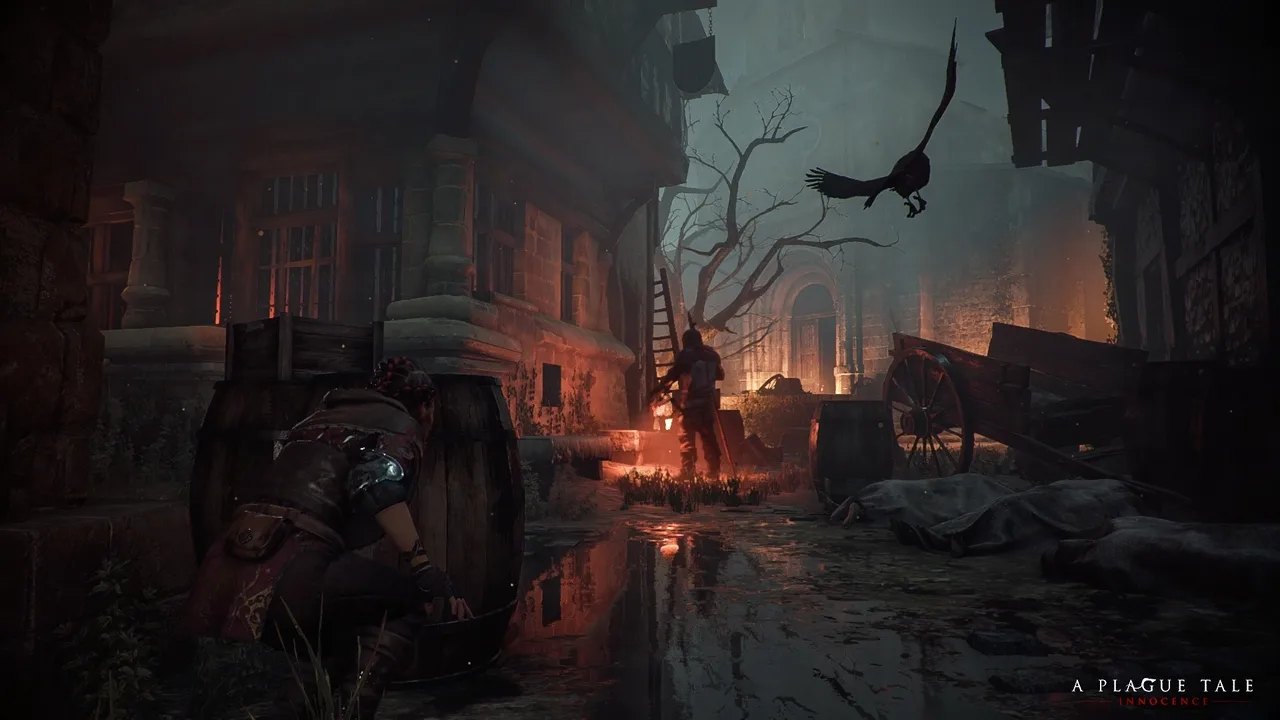
Interacting with light sources is very important in the stealth and puzzle sections
The stealth sections are very easy. There is often one obvious way to dispose of or go around enemies, and the game almost never rewards innovative approaches. The areas are often narrow, a little more than a corridor with some hiding places, further increasing the railroading. But on the other hand, it is very fun to use the sling and the other tools. Often rats are added to the equation: they swarm dark places, and they are stopped by light. So it will be convenient to break the lanterns in the hands of the enemies to let them be eaten by the rats, or often braziers and torches must be lit to progress further in some areas. The various projectiles for the sling are fun to use, but often there is only one obvious way to approach the stealth sections. There are also a few boss fights, but sadly most of them feel uninspired and out of place. There is also a crafting and upgrade system, but it isn't very impactful even if the resources are all well calibrated to let you upgrade everything at the medium level and only one item to the maximum level.
The puzzle sections, on the other hand, are braindead easy but at least tie nicely with the story and the environment, interrupting the tense stealth sections. In the puzzle areas there aren't generally any enemies besides the rats, and you have time to try to find a solution undisturbed. Generally, the puzzles boil down to breaking shining objects with the sling or interacting with the various light sources to create a light path between the rats. There are some optional puzzles that lead to collectibles, but there aren't many of them, and it's more a matter of noticing the branched path where they are rather than solving the puzzle.
GRAPHICS, MUSIC AND TECHNICAL ASPECTS
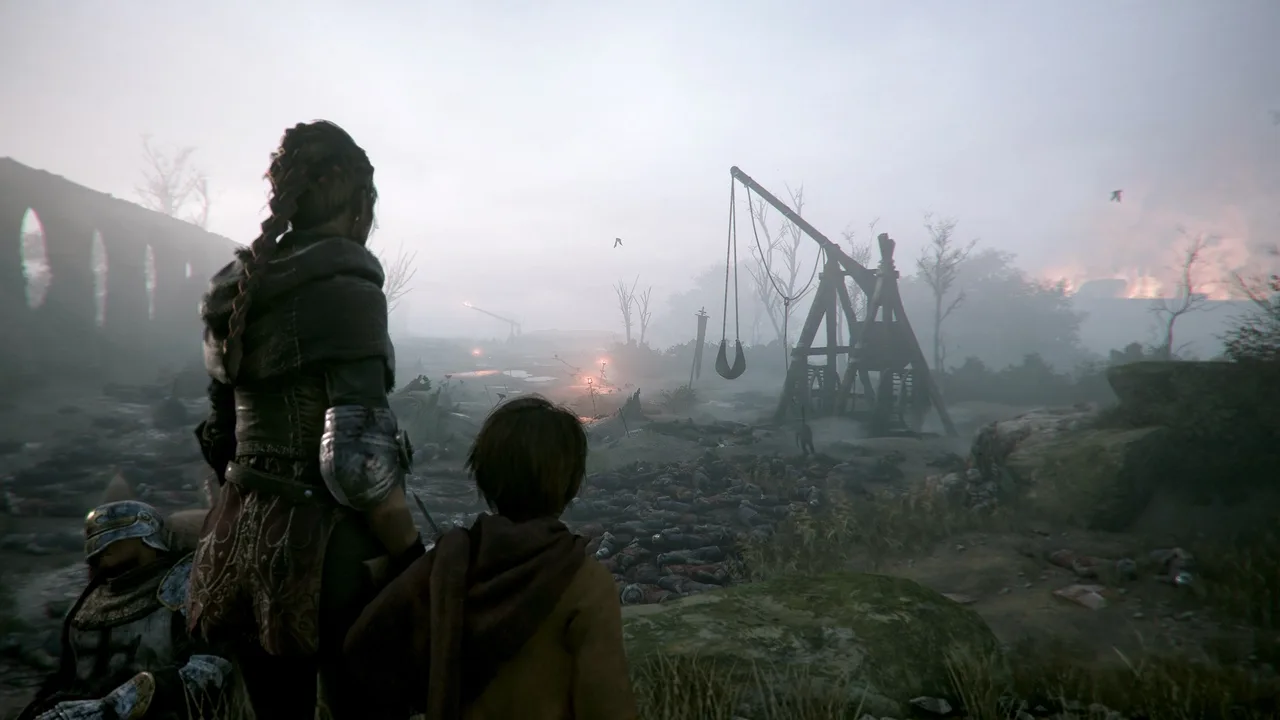
Traversing a ravaged battlefield is the most marketed and also the best section of the game
As can be seen from the screenshots, the game has gorgeous graphics. Especially the environments are a marvel to look at, and the developers really invested in the rendering of light and shadows, creating suggestive night environments. Both cities and more wild locations are well represented, but the urban environments simply give more opportunities to play with lights and reflections. Even on Amazon Luna, the game did not falter once and had a good performance. The design of the enemies, especially the inquisitors, is a little too over the top, but the game is a historical fantasy, so it's rather easy to accept that. The rats, on the other hand, steal the scene every time they are involved. They are a vicious, pulsating mass of thousands of little bodies, and when they are trapped under the light, they literally vanish, like creatures made of darkness. The swarms move in a credible way, and in the first sections of the game, when Amicia has few tools to contrast them, they are really fearsome.
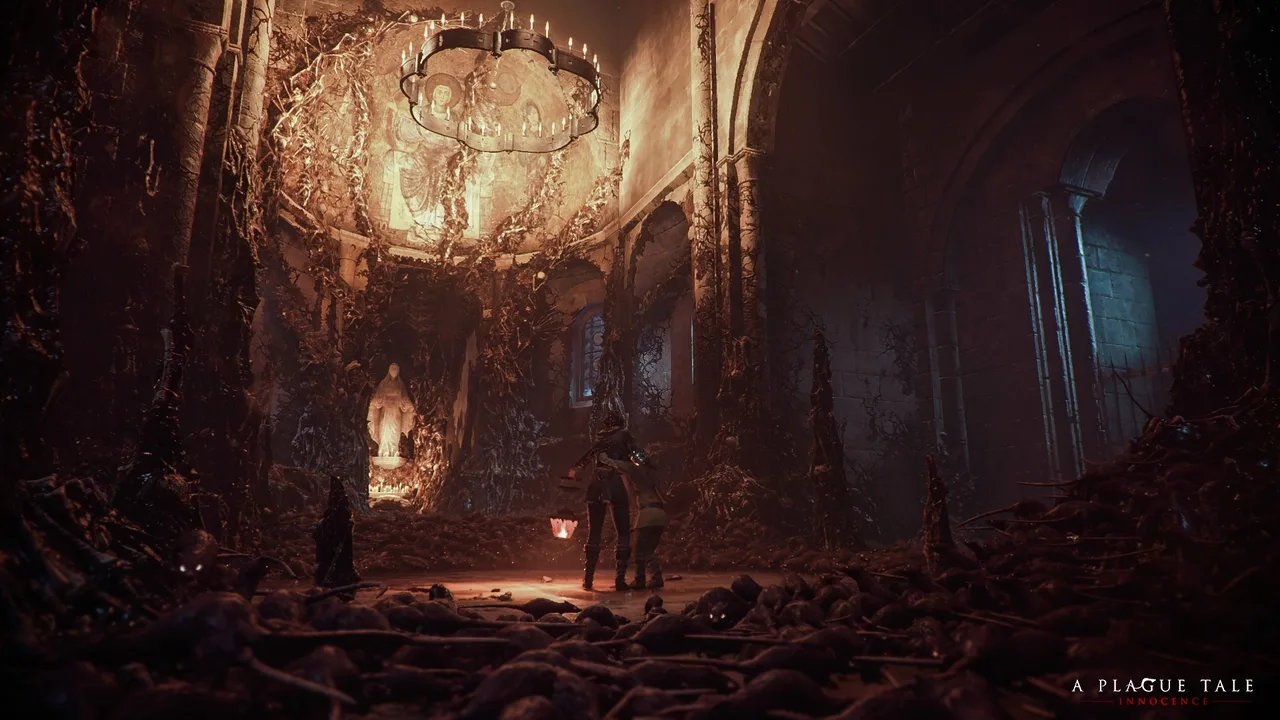
The rats create some disturbing flesh structures in their lairs
The sound, on the other hand, is divided between light and shadows. The music is made with orchestral pieces enhanced by subtle electronical pads and is minimal and effective. They fuse medieval themes with dark and brooding basslines, relying vastly on the violin family. The composer, Deriviere, really did an outstanding job in this department. Less exciting are the voices of the various characters in English. The French characters like Amicia and Hugo have a strong, stereotypical French accent that really ruins the immersion. Since I know a little bit of French, I switched the language, and the voice actor's work was great, but it didn't feel right for the British to speak another language. A hybrid dub would have definitely been the best option. In addition, the cutscene dialogue was badly mixed. It was almost muted compared to the SFX, a big flaw considering that A Plague Tale is a story-driven game. Fiddling with the audio options helps a little, but not enough to erase completely the flaw.
VERDICT
A game of light and shadows. The story is enjoyable, and the gameplay is simple and easy but really helps to concentrate on the story. Sadly, it feels a little unpolished, and the terrible ending really hampers the whole game. It feels like a missed masterpiece, but besides the obvious flaws, it is difficult to suggest how the game should be corrected to create a flawless experience. If the player can pass over the gameplay and connect with the two siblings through their misfortunes, like me, they are in for a great ride.
FINAL SCORE: 8/10
-------------------------------------------------------------------------------------------------------------------------------------------------------------------------------------------------------------------------
I caved in and started MW3. even if I played MW2 not so long ago. It was my first COD game, and having played the other games of the trilogy really puts everything in perspective. For now it hasn't the highs of MW2, but it's more consistent and really nails the cinemathograpic aspect.
Metroid Zero Mission is such a joy to play. Fast, fun to explore and easy to learn. Probably perfect as a first Metroid game.
New Super Mario Bros 2 is on hold now but it will be restarted as soon as I finish one of the above games. It's good, but almost a carbon copy of the first. But a mid Mario game is still a good game in absolute terms so who cares.
A Plague Tale: Innocence - Amazon Luna
Genre: Adventure, Stealth
Developer/Year: Asobo Studios, 2019
SCORE: 8/10
Another Amazon Luna game. I noticed that A Plague Tale was released in 2019, but I never had any particular interest in it. Now that I had it with my Prime subscription, I was fascinated by the setting, and I decided to give it a chance. As a side note, playing adventure games like this on Amazon Luna is a great experience. These games work well both on a keyboard and on a pad, and it is very convenient to have the game accessible from any platform, from the PC to the smart TV.
THE STORY
Amicia and Hugo are two siblings, offspring of a local noble in 14th-century France. Amicia is a normal girl who suffers the absence of her parents, while Hugo is segregated in his quarters since he has a strange, unknown illness, and his mother stays with him all day trying to find a cure. The game opens with a tutorial where Amicia, her father, and her dog hunt in the wilderness surrounding the castle. But her dog is suddenly swallowed into the ground, and they are forced to run back to the castle. The castle is then assaulted by inquisitors searching for Hugo, who kill Amicia's parents and force the two siblings to escape to a nearby village. There they discover that the region is ravaged by plague, and the rats bringing it go out in the darkness in swarms, eating every living thing they encounter.

Amicia and Hugo exploring the small village near their castle
These are the premises of the first hour or so of the game. As you can see, the game has a historical setting, but it has a very heavy fantasy soul linked to the rat swarms, more terrible monsters than real animals, and the plague itself. This is a story-driven game where you play linearly on a straight path that brings you through the various chapters of the story, explained also through cutscenes. The story is not particularly complex, but it does its job efficiently. Amicia and Hugo are well characterized, and the player really connects with them through their misfortunes. There are a few other characters, two bad guys and some allies of the two siblings, who are not particularly brilliant but give a little bit of added variety to the narration. The game isn't called Innocence by Chance: Amicia and Hugo start as pure souls, young and innocent, but as the story progresses, the innocence is torn from them by the violence of the world. Amicia will be forced to kill to survive, and as the story progresses, she will be less and less reluctant to do so. Seeing the downward spiral of the two characters has a great emotive impact. In addition, the setting is also interesting; the plague paired with the Hundred Years' War generates some pretty interesting set pieces: a village with crazed residents, a battlefield littered by corpses, an abbey, an old castle, and a quarantined city.
I had a very big problem with the ending of the game though. I really don't like it, but I can't say more without spoilers.
ATTENTION: SPOILERS FROM THE END OF THE GAME!!
The whole game is about Amicia and Hugo fleeing from the rats and the soldiers trying to catch them. Killing is viewed as a negative action, twisting Amicia's mind, and the sense of dread and danger is always present. In the end, it is discovered that the plague is linked to Hugo's illness, and he can control the rats with magical powers. So they decide to go to the quarantined city, where the great inquisitor (the main antagonist) resides, to kill him. He wants to use powers similar to Hugo's to control the rats and gain more power. The problem is that the final assault on the city forces Amicia to kill waves of enemies, like in an action game, destroying the previous 9 hours of gameplay. And in the end, you face the inquisitor, completely covered by a swarm of rats that attacks you, creating big towers of rats that crash on Amicia. And Hugo sends rat tornadoes to him in order to expose his body. It is grotesque, but not in an unsettling, good way. It's just a lazy final boss, a comical exaggeration. It really ruins the whole game experience since it's at the end.
GAMEPLAY
At its core, Plague Tale is an adventure game with three pillars: cutscenes and story sections, stealth sections, and puzzle sections. Amicia has a sling at her disposal, which can be charged with different projectiles: normal projectiles to break things and kill people with their heads exposed, incendiary projectiles, water projectiles, and much more. The sling is used both to kill and distract people in the stealth section and to interact with the world in the puzzle sections. As soon as an enemy catches Amicia, she kills her in one blow, so it is very important to avoid contact with the enemies. Amicia also has some secondary tools, like pots that can be thrown to create noise or sleeping powder to take down enemies, but they are much less used than the sling.

Interacting with light sources is very important in the stealth and puzzle sections
The stealth sections are very easy. There is often one obvious way to dispose of or go around enemies, and the game almost never rewards innovative approaches. The areas are often narrow, a little more than a corridor with some hiding places, further increasing the railroading. But on the other hand, it is very fun to use the sling and the other tools. Often rats are added to the equation: they swarm dark places, and they are stopped by light. So it will be convenient to break the lanterns in the hands of the enemies to let them be eaten by the rats, or often braziers and torches must be lit to progress further in some areas. The various projectiles for the sling are fun to use, but often there is only one obvious way to approach the stealth sections. There are also a few boss fights, but sadly most of them feel uninspired and out of place. There is also a crafting and upgrade system, but it isn't very impactful even if the resources are all well calibrated to let you upgrade everything at the medium level and only one item to the maximum level.
The puzzle sections, on the other hand, are braindead easy but at least tie nicely with the story and the environment, interrupting the tense stealth sections. In the puzzle areas there aren't generally any enemies besides the rats, and you have time to try to find a solution undisturbed. Generally, the puzzles boil down to breaking shining objects with the sling or interacting with the various light sources to create a light path between the rats. There are some optional puzzles that lead to collectibles, but there aren't many of them, and it's more a matter of noticing the branched path where they are rather than solving the puzzle.
GRAPHICS, MUSIC AND TECHNICAL ASPECTS

Traversing a ravaged battlefield is the most marketed and also the best section of the game
As can be seen from the screenshots, the game has gorgeous graphics. Especially the environments are a marvel to look at, and the developers really invested in the rendering of light and shadows, creating suggestive night environments. Both cities and more wild locations are well represented, but the urban environments simply give more opportunities to play with lights and reflections. Even on Amazon Luna, the game did not falter once and had a good performance. The design of the enemies, especially the inquisitors, is a little too over the top, but the game is a historical fantasy, so it's rather easy to accept that. The rats, on the other hand, steal the scene every time they are involved. They are a vicious, pulsating mass of thousands of little bodies, and when they are trapped under the light, they literally vanish, like creatures made of darkness. The swarms move in a credible way, and in the first sections of the game, when Amicia has few tools to contrast them, they are really fearsome.

The rats create some disturbing flesh structures in their lairs
The sound, on the other hand, is divided between light and shadows. The music is made with orchestral pieces enhanced by subtle electronical pads and is minimal and effective. They fuse medieval themes with dark and brooding basslines, relying vastly on the violin family. The composer, Deriviere, really did an outstanding job in this department. Less exciting are the voices of the various characters in English. The French characters like Amicia and Hugo have a strong, stereotypical French accent that really ruins the immersion. Since I know a little bit of French, I switched the language, and the voice actor's work was great, but it didn't feel right for the British to speak another language. A hybrid dub would have definitely been the best option. In addition, the cutscene dialogue was badly mixed. It was almost muted compared to the SFX, a big flaw considering that A Plague Tale is a story-driven game. Fiddling with the audio options helps a little, but not enough to erase completely the flaw.
VERDICT
A game of light and shadows. The story is enjoyable, and the gameplay is simple and easy but really helps to concentrate on the story. Sadly, it feels a little unpolished, and the terrible ending really hampers the whole game. It feels like a missed masterpiece, but besides the obvious flaws, it is difficult to suggest how the game should be corrected to create a flawless experience. If the player can pass over the gameplay and connect with the two siblings through their misfortunes, like me, they are in for a great ride.
FINAL SCORE: 8/10
-------------------------------------------------------------------------------------------------------------------------------------------------------------------------------------------------------------------------
CURRENTLY PLAYING
- Call of Duty: MW3 - PS3
- Metroid Zero Mission - GBA
- New Super Mario Bros 2 - 3DS
I caved in and started MW3. even if I played MW2 not so long ago. It was my first COD game, and having played the other games of the trilogy really puts everything in perspective. For now it hasn't the highs of MW2, but it's more consistent and really nails the cinemathograpic aspect.
Metroid Zero Mission is such a joy to play. Fast, fun to explore and easy to learn. Probably perfect as a first Metroid game.
New Super Mario Bros 2 is on hold now but it will be restarted as soon as I finish one of the above games. It's good, but almost a carbon copy of the first. But a mid Mario game is still a good game in absolute terms so who cares.
4 Yrs✓#
f_n_c
4 Yrs✓#
UPDATE #29
THIS POST MARKS TWO YEARS OF THIS BLOG! I WANT TO REALLY THANK ALL THE PEOPLE THAT HAVE READ IT THROUGH THESE YEARS.
I bought a Miyoo Mini Plus some time ago, mainly to play SNES and GB games on it. I never expected to like it, mainly because I wanted to try out a bunch of arcade games that I had never heard of. I put a romset on it, so I have a bunch of selected games already on it ready to be tried. Probably this had a big influence in pushing me out of my comfort zone. I started playing some beat 'em ups: I never liked them, but now I find them relaxing to play, providing a short and intense burst of gameplay. I started from three classics of the genre.
X-MEN (1992)
Magneto is marching on the city with an army of Sentinel robots, and the X-Men have to stop him. These are the premises for this game, simple and concise. The X-Men are and were widely known, and a beat 'em up doesn't need much in terms of story anyway. The player can control one character from a big roster of six: Wolverine, Cyclops, Storm, Nightcrawler, Colossus, and Dazzler. This was also the only arcade to allow six simultaneous players, and I think that in '92 that was a big selling point overshadowing many of the problems of this title.
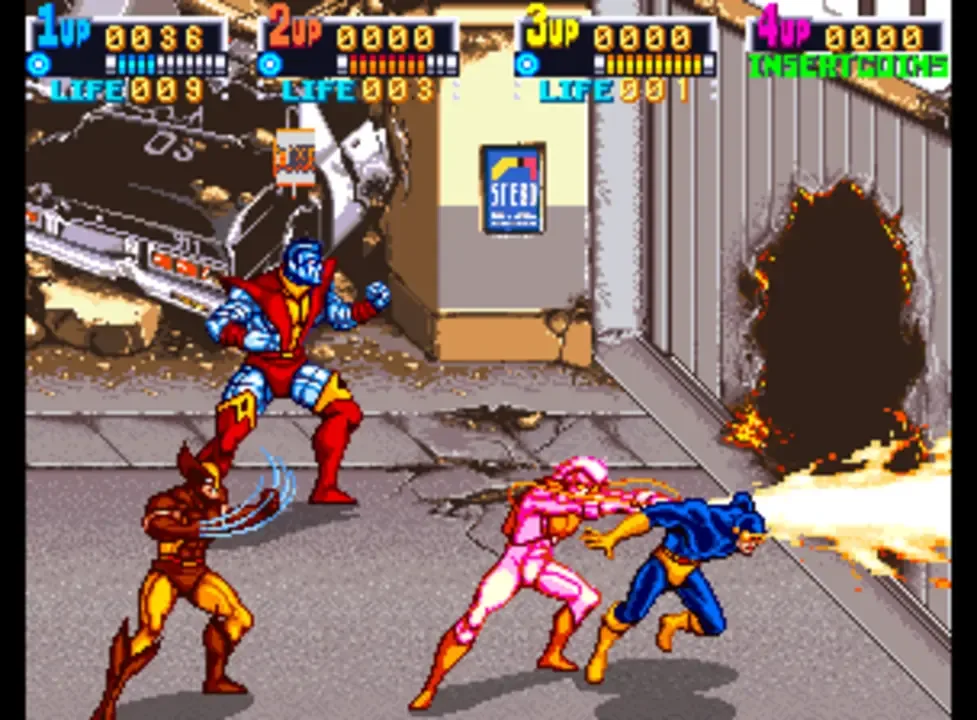
The first boss. From the images I imagine that the game is much better in co-op
The gameplay is standard from a beat 'em up perspective. The player can do a combo of punches with a button, jump and activate a special move with other two buttons. Every character have their special move and animations, but they don't differentiate much and the choice falls only on the one that you like more. There is quite a lot of enemy variety, but most of them are just the same model with a different color pattern, more health and sometimes a different signature move. There are few bosses taken from the villains of the comic, decently fun. In the end, there is a Magneto that talks with voice lines that are obviously cut and pasted to save memory space.
It's an ok game, not much more. It's colorful and full of enemies, and the voice lines are a bit choppy. Today it is decently fun for the hour it lasts and doesn't overstay its welcome, but there's not much more.
FINAL SCORE: 6.5/10
ALIEN VS. PREDATOR (1994)
Aliens arrive in the city, destroying everything. Only two predators, an enhanced soldier and a cyborg with a giant mechanical hand, dare to oppose them and vow to kill the queen. First of all, the cast of the four characters is diverse, and everyone has subtle differences that make them unique. Every character (bar the cyborg) starts with a melee weapon that is dropped when some health is lost. Obviously, the character hits harder and faster with the weapon and has access to more moves. The jump and the dash can be combined with the attack to unleash many different moves and traverse the screen in an instant. Every character has access to a gun that works slightly differently: the predator has shoulder energy guns that hit hard in an area but overheat quickly, the cyborg has a smart gun, and the soldier has an automatic pistol that must be reloaded while she stands still. Around the stages, in addition to the generic health refill and point objects, there are also some firearms that can be picked up and used.
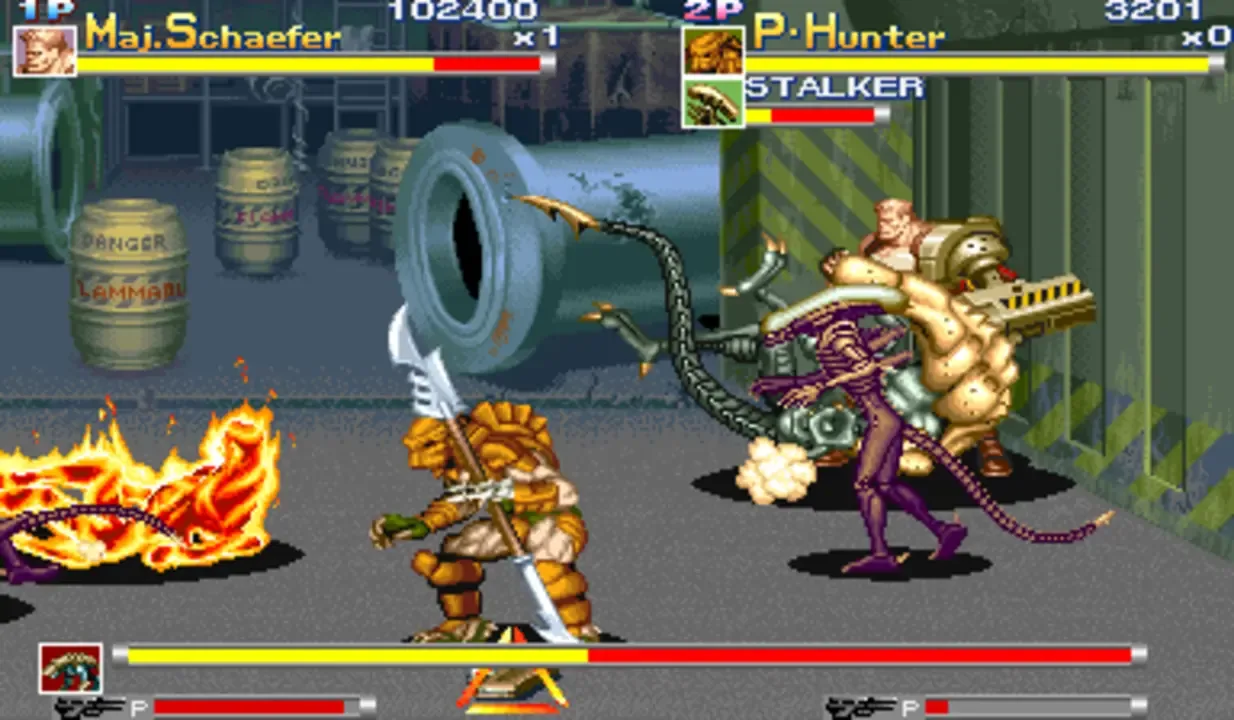
Playing a talking predator allied to other humans is strange, but the premise is quickly forgotten
This game really nails down the fighting gameplay. The predators especially are fast, hit hard, and their animations are spectacular. Every punch is satisfying, and the variety of enemies and bosses always creates different situations. Sadly, the music is rather forgettable, and the graphics are good, but the backgrounds are pretty uninspired and all feel the same. The game is rather long, and after the first alien queen boss fights, there are some additional levels where the characters face off against the evil Weyland-Yutani that brought the aliens to the earth. The games in the last levels swap out aliens for soldiers, keeping the situations fresh. There is also a convoy section where you need only to shoot aliens from an APC with a gun that never overheats, but it happens almost immediately (mission 3), when the fighting still feels fresh. A real shame.
I already played this game almost ten years ago, and today still feels fun. Definitely approved.
FINAL SCORE: 8.5/10
CADILLACS AND DINOSAURS
Capcom, with Alien vs. Predator, built on top of an almost perfect game, Cadillacs and Dinosaurs (CaD). They improved the formula but in the meantime missed some shots that made AvP a little lacking compared to its predecessor. In CaD the player can select to play as Jack Cadillac or one of his friends, every one excelling in a particular fighting area. After a cataclysmic event, humanity spent hundreds of years underground, and when they returned to the surface, they found it drastically changed and still inhabited by dinosaurs. The premise can sound really silly, but it works. Jack lives in his garage, where he tunes the various cars that are found around, that is, on the mainland near the City in the Sea, a big American metropolis that was completely flooded and is now inhabited as a modern Venice. It is in the City in the Sea that the game starts, fighting some black market gangs. After them there are seven more stages where Jack and his crew fight poachers, mutated abominations, and other enemies. The titular dinosaurs appear as neutral characters, hitting the enemies and the player indiscriminately. The game supports three simultaneous players, and the good amount of enemies on screen and often neutral dinosaurs keep a fun mess.
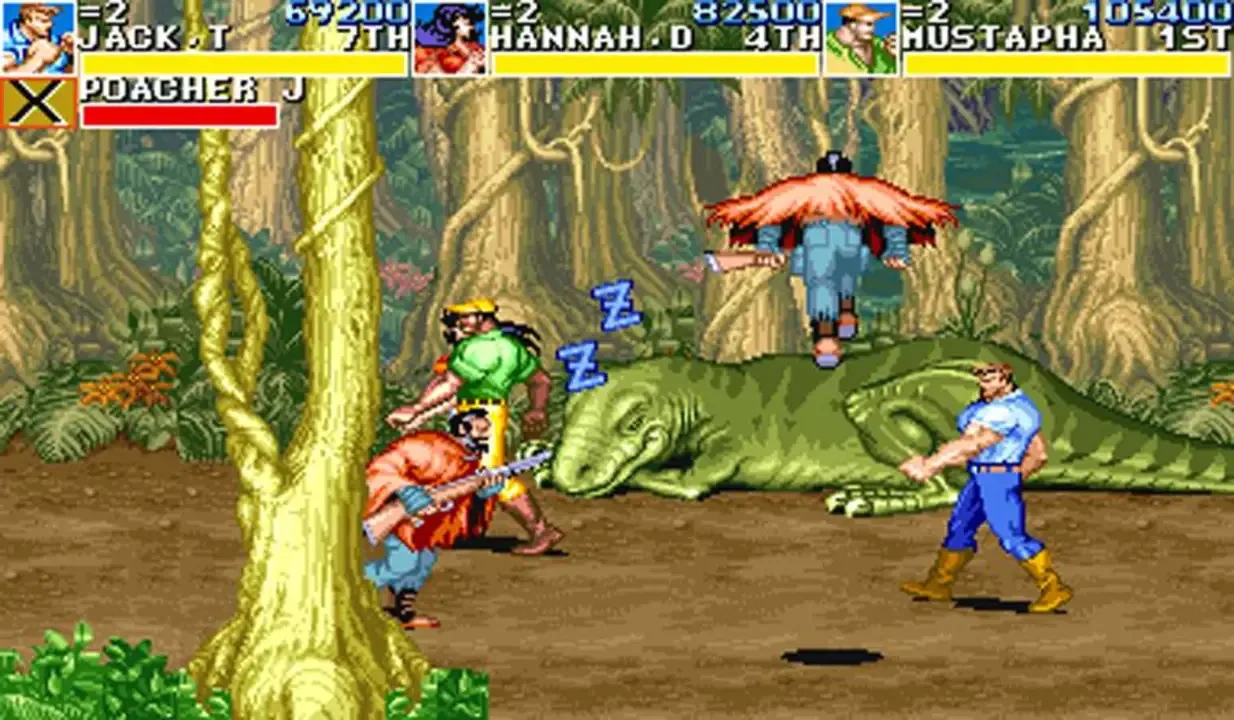
Sometimes dinosaurs sleeps until they are waken up by someone
The characters have different fighting styles and special moves, and often they can use weapons scattered around until the bullets run out. The truth is that CaD doesn't do anything revolutionary or unique, but it does it so well that it is almost perfect. The soundtrack is good, characters and backgrounds are exquisitely drawn, and fighting feels balanced and rewarding. It doesn't reach the level of AvP for sure, but it is a mere inch from it. The strange and unique premise really works well even today and makes this game feel unique in a sea of similar titles that literally flooded the market in those years. The length is just right, and the bosses are varied and pose the right challenge.
A must-play. Maybe you don't like beat 'em ups, or maybe you dislike old games. But CaD is almost a required play for everyone. I played it three times, two with only one character and one run with the two remaining characters. It's so good that I also started to read the original comic, Xenozoic Tales.
FINAL SCORE: 9.5/10
-------------------------------------------------------------------------------------------------------------------------------------------------------------------------------------------------------------------------
I wanted to play an RPG and I had some Fallout nostalgia, so I downloaded the GOG copy that I got with Amazon Prime and started playing it. I have already passed the point in which I was stuck the previous gameplay. It's really dated and the time limit is a real nuisance, but after the first hours it opens up and becomes really fun.
Almost no progress with NSMB 2, but sometimes I play one level or two.
THIS POST MARKS TWO YEARS OF THIS BLOG! I WANT TO REALLY THANK ALL THE PEOPLE THAT HAVE READ IT THROUGH THESE YEARS.
I bought a Miyoo Mini Plus some time ago, mainly to play SNES and GB games on it. I never expected to like it, mainly because I wanted to try out a bunch of arcade games that I had never heard of. I put a romset on it, so I have a bunch of selected games already on it ready to be tried. Probably this had a big influence in pushing me out of my comfort zone. I started playing some beat 'em ups: I never liked them, but now I find them relaxing to play, providing a short and intense burst of gameplay. I started from three classics of the genre.
X-MEN (1992)
X-Men - Arcade
Genre: Beat 'em up
Developer/Year: Konami, 1992
Score: 6.5/10
Magneto is marching on the city with an army of Sentinel robots, and the X-Men have to stop him. These are the premises for this game, simple and concise. The X-Men are and were widely known, and a beat 'em up doesn't need much in terms of story anyway. The player can control one character from a big roster of six: Wolverine, Cyclops, Storm, Nightcrawler, Colossus, and Dazzler. This was also the only arcade to allow six simultaneous players, and I think that in '92 that was a big selling point overshadowing many of the problems of this title.

The first boss. From the images I imagine that the game is much better in co-op
The gameplay is standard from a beat 'em up perspective. The player can do a combo of punches with a button, jump and activate a special move with other two buttons. Every character have their special move and animations, but they don't differentiate much and the choice falls only on the one that you like more. There is quite a lot of enemy variety, but most of them are just the same model with a different color pattern, more health and sometimes a different signature move. There are few bosses taken from the villains of the comic, decently fun. In the end, there is a Magneto that talks with voice lines that are obviously cut and pasted to save memory space.
It's an ok game, not much more. It's colorful and full of enemies, and the voice lines are a bit choppy. Today it is decently fun for the hour it lasts and doesn't overstay its welcome, but there's not much more.
FINAL SCORE: 6.5/10
ALIEN VS. PREDATOR (1994)
Alien vs. Predator - Arcade
Genre: Beat 'em up
Developer/Year: Capcom,1994
Score: 8.5/10
Aliens arrive in the city, destroying everything. Only two predators, an enhanced soldier and a cyborg with a giant mechanical hand, dare to oppose them and vow to kill the queen. First of all, the cast of the four characters is diverse, and everyone has subtle differences that make them unique. Every character (bar the cyborg) starts with a melee weapon that is dropped when some health is lost. Obviously, the character hits harder and faster with the weapon and has access to more moves. The jump and the dash can be combined with the attack to unleash many different moves and traverse the screen in an instant. Every character has access to a gun that works slightly differently: the predator has shoulder energy guns that hit hard in an area but overheat quickly, the cyborg has a smart gun, and the soldier has an automatic pistol that must be reloaded while she stands still. Around the stages, in addition to the generic health refill and point objects, there are also some firearms that can be picked up and used.

Playing a talking predator allied to other humans is strange, but the premise is quickly forgotten
This game really nails down the fighting gameplay. The predators especially are fast, hit hard, and their animations are spectacular. Every punch is satisfying, and the variety of enemies and bosses always creates different situations. Sadly, the music is rather forgettable, and the graphics are good, but the backgrounds are pretty uninspired and all feel the same. The game is rather long, and after the first alien queen boss fights, there are some additional levels where the characters face off against the evil Weyland-Yutani that brought the aliens to the earth. The games in the last levels swap out aliens for soldiers, keeping the situations fresh. There is also a convoy section where you need only to shoot aliens from an APC with a gun that never overheats, but it happens almost immediately (mission 3), when the fighting still feels fresh. A real shame.
I already played this game almost ten years ago, and today still feels fun. Definitely approved.
FINAL SCORE: 8.5/10
CADILLACS AND DINOSAURS
Cadillacs and Dinosaurs - Arcade
Genre: Beat 'em up
Developer/Year: Capcom,1993
Score: 8.5/10
Capcom, with Alien vs. Predator, built on top of an almost perfect game, Cadillacs and Dinosaurs (CaD). They improved the formula but in the meantime missed some shots that made AvP a little lacking compared to its predecessor. In CaD the player can select to play as Jack Cadillac or one of his friends, every one excelling in a particular fighting area. After a cataclysmic event, humanity spent hundreds of years underground, and when they returned to the surface, they found it drastically changed and still inhabited by dinosaurs. The premise can sound really silly, but it works. Jack lives in his garage, where he tunes the various cars that are found around, that is, on the mainland near the City in the Sea, a big American metropolis that was completely flooded and is now inhabited as a modern Venice. It is in the City in the Sea that the game starts, fighting some black market gangs. After them there are seven more stages where Jack and his crew fight poachers, mutated abominations, and other enemies. The titular dinosaurs appear as neutral characters, hitting the enemies and the player indiscriminately. The game supports three simultaneous players, and the good amount of enemies on screen and often neutral dinosaurs keep a fun mess.

Sometimes dinosaurs sleeps until they are waken up by someone
The characters have different fighting styles and special moves, and often they can use weapons scattered around until the bullets run out. The truth is that CaD doesn't do anything revolutionary or unique, but it does it so well that it is almost perfect. The soundtrack is good, characters and backgrounds are exquisitely drawn, and fighting feels balanced and rewarding. It doesn't reach the level of AvP for sure, but it is a mere inch from it. The strange and unique premise really works well even today and makes this game feel unique in a sea of similar titles that literally flooded the market in those years. The length is just right, and the bosses are varied and pose the right challenge.
A must-play. Maybe you don't like beat 'em ups, or maybe you dislike old games. But CaD is almost a required play for everyone. I played it three times, two with only one character and one run with the two remaining characters. It's so good that I also started to read the original comic, Xenozoic Tales.
FINAL SCORE: 9.5/10
-------------------------------------------------------------------------------------------------------------------------------------------------------------------------------------------------------------------------
CURRENTLY PLAYING
- Fallout - PC
- New Super Mario Bros 2 - 3DS
I wanted to play an RPG and I had some Fallout nostalgia, so I downloaded the GOG copy that I got with Amazon Prime and started playing it. I have already passed the point in which I was stuck the previous gameplay. It's really dated and the time limit is a real nuisance, but after the first hours it opens up and becomes really fun.
Almost no progress with NSMB 2, but sometimes I play one level or two.
4 Yrs✓#
f_n_c
4 Yrs✓#
UPDATE #30
INTRODUCTION
Before Aria of Sorrow (AoS), there were two Castlevania games on the GBA: Circle of the Moon and Harmony of Dissonance. The first was more similar gameplay-wise to the punishing classic games but had a lot of problems, while the second was more similar to Symphony of the Night but had a lackluster map, and it was definitely too easy. It took two games for Iga and his team to adjust the aim, but finally they hit the jackpot with AoS. Even if it falls a little short compared to Symphony of the Night, it remains one of the best Castlevania games, and my playthrough definitely confirmed that.
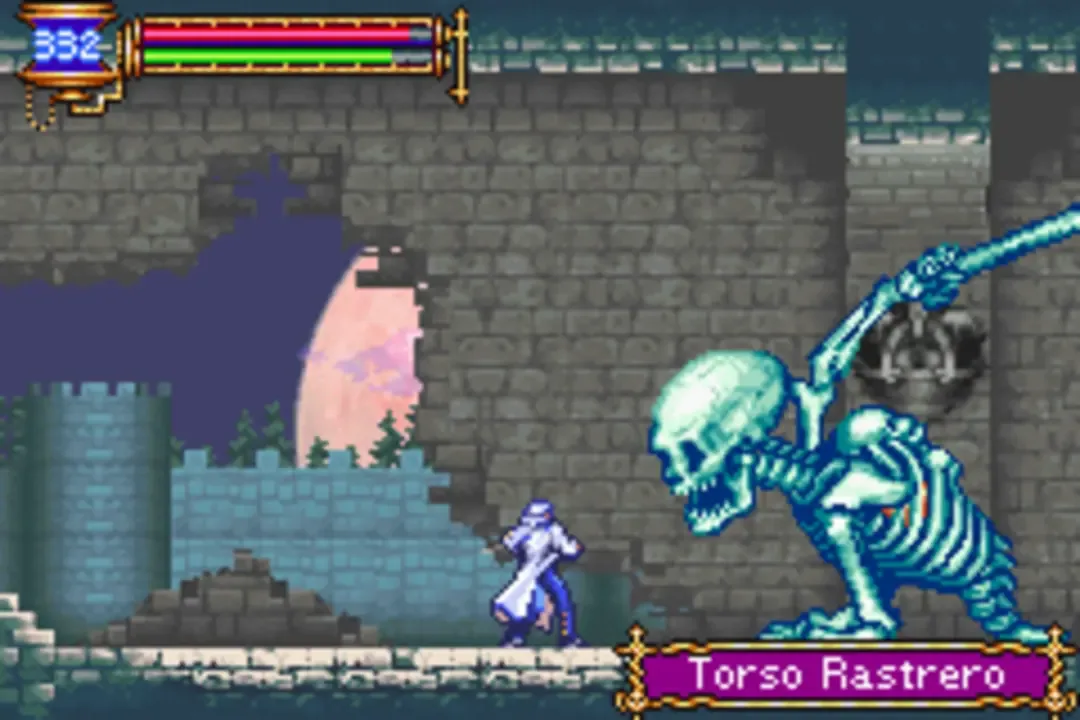
The first boss is big, simple but starts the game with the right foot
In AoS the player controls Soma Cruz, a student that is dragged with his girlfriend into Dracula's castle during an eclipse. Dracula was definitely killed in 1999, but dark forces are working to resurrect its dark power. Like all the other Castlevania games, the plot isn't anything to write home about, but at least Aria tries to spin the classic formula around like Harmony of Dissonance, removing Dracula as the main antagonist to build a plot around his resurrection. Even if there is not a lot of variety in terms of bosses and they are a little bit uninspired, the plot in the final sections of the game justifies some pretty cool fights.
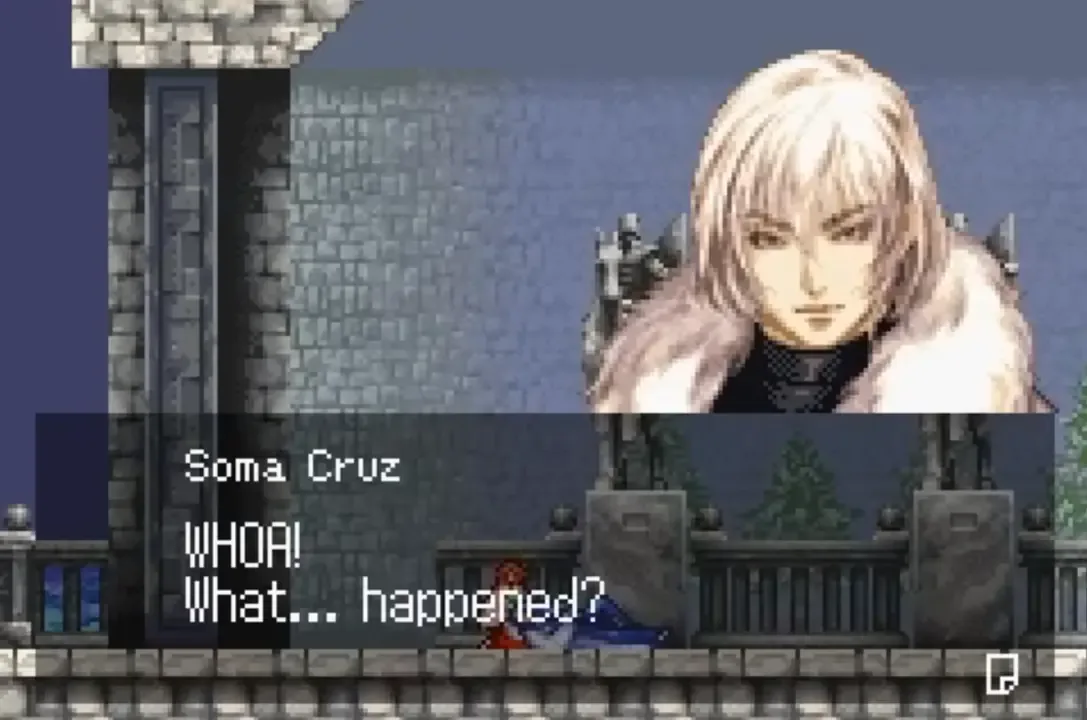
The story is narrated through dialogue and some portaits, exquisitely drawn
SPOILERS FROM THE END OF THE GAME!
The fight against the last Belmont is phenomenal and almost cancels all the previous lackluster fights. Also the final fight against Chaos is original, even if it is so chaotic to be less fun compared to Belmont.
END OF THE SPOILERS
GAMEPLAY
AoS is a classic Metroidvania, with platformer gameplay linked to upgrades that improve the capacity of the main character to explore the map. It has also a RPG-like system with statistics modified by level-ups and equipment. First of all, the upgrades aren't bad and are definitely well placed, but they are definitely less fun compared to Symphony. I can't definitely place my finger on one thing exactly, but using them to explore in Symphony was definitely more rewarding. Also the map was definitely more inspired in Symphony, but it is a masterpiece difficult to replicate, and AoS retains a very high level nevertheless. Compared to the other games on the system, there is an abyss in the quality and fun of exploration and upgrades. The enemies are a lot and very inspired, and even if few are recycled by changing their palette, this exploit is limited and doesn't impact in the final quality of the game.
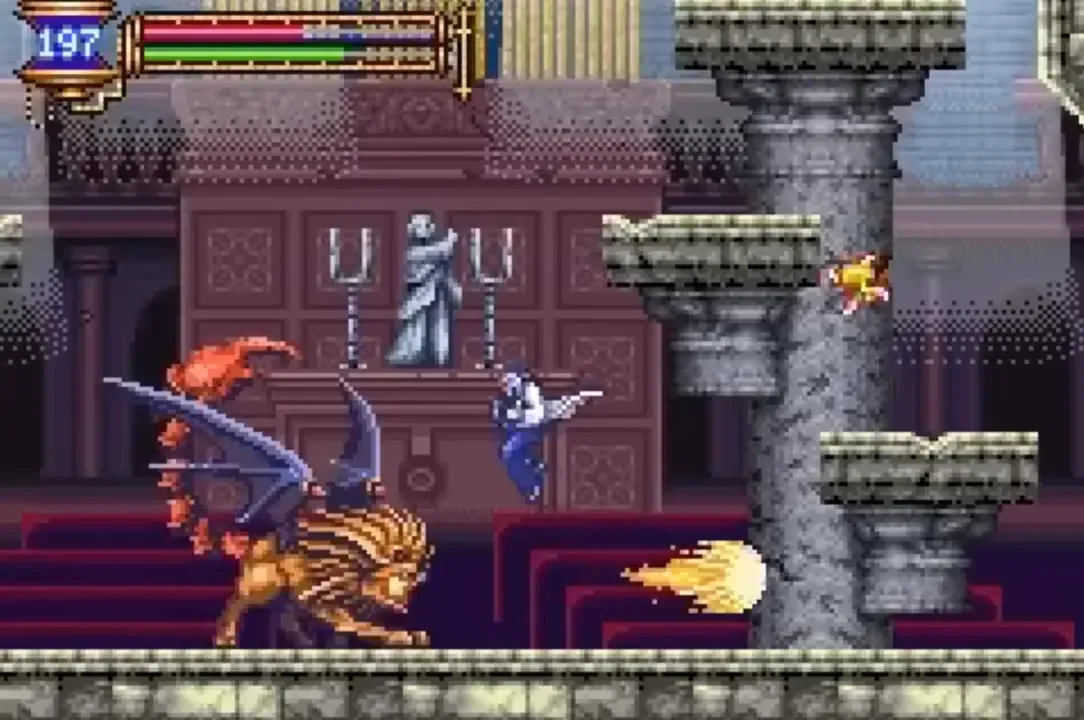
The bossess are uninspired, but at least the various arenas are very cool
The game uses a system of weapons equal to Symphony, equally well made. Maybe there is a little bit too much focus on swords, but the variety and the rate of acquisition are perfectly balanced to keep the situation varied. Since the flying enemies are particularly annoying, upward slashing swords are the most useful, but towards the end of the game, Soma has enough mobility to use effectively almost everything. The strongest weapon is well hidden in a secret area, not difficult to find if you know where to search but difficult to figure out otherwise. There are enough armors, even if they don't have particular modifiers that passively change the gameplay rules, and there are few accessories, but this isn't very important.
The classic sub-weapon system, after two games in which it was redundant and not very useful, was finally scrapped in favor of an almost completely new system. In this game Soma can collect the souls of the enemies that he kills in order to acquire new skills. The souls are divided by color: red skills are active skills that are used to deal damage, blue skills are active skills used defensively, and yellow skills are passive skills that are powerful but pretty scarce and difficult to acquire. The player can freely equip one skill per type and swap them in any situation through the menu. This system is perfect, since it encourages trying out different combinations without punishing the player for having equipped a sub-optimal combination. The only flaw, in my opinion, is that the souls are acquired randomly by killing the right enemies, with the probability controlled by the luck skill. Having to kill the same enemy multiple times to farm a soul is never fun, and even if it doesn't reach the ridiculous low probabilities of the card system of Circle of the Moon, it remains definitely a nuisance.
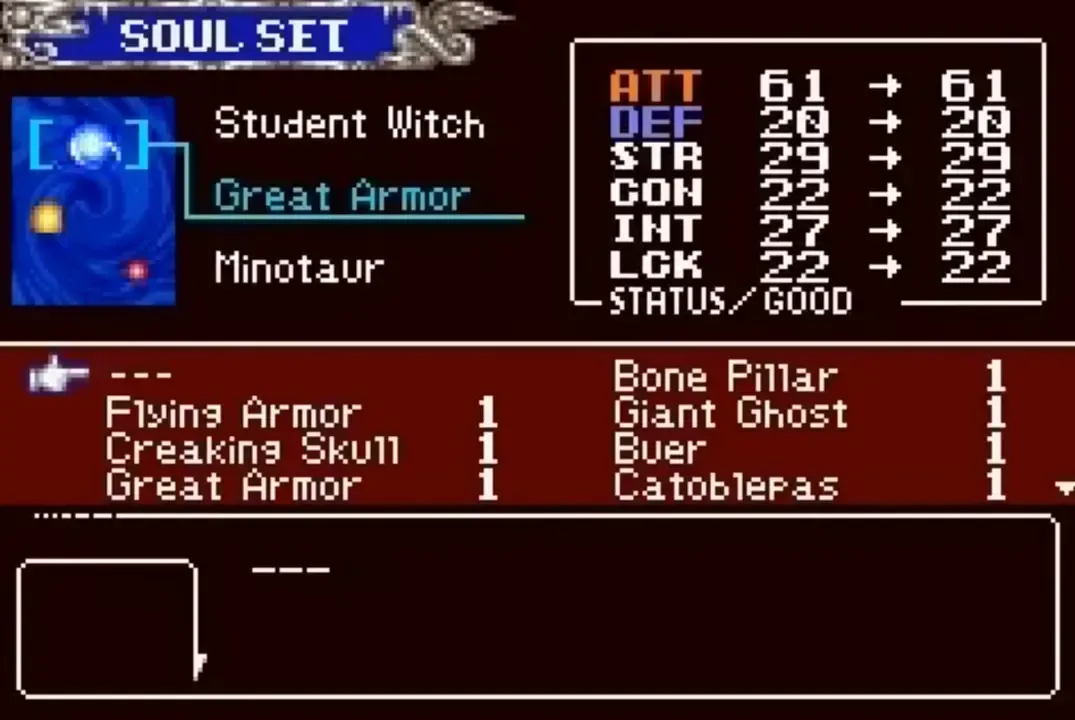
The souls menu is fast and intuitive, and shows immediately how the passive skills affect Soma's statistics
GRAPHICS, MUSIC AND FINAL CONSIDERATIONS
After two games, Konami's team finally nailed the graphics on the GBA. The first game had darker tones, fitting but difficult to see in the non-backlit screen of the first GBA. To compensate, Harmony had very bright, almost neon-like colors, definitely too vivid even if I personally dig the acid art style. Finally, Aria managed to nail down the right style, readable on the old screens but still balanced on more modern systems. Obviously if you emulate the game or you play it through the Collection, the palette doesn't change the experience on modern monitors, but it is important to keep the technology of the time in mind to understand the developer's choices and understand why Aria was a great accomplishment.Also Aria's music is great, they luckily fixed Harmony's low quality to create some great tunes, despite the obvious limitations of the GBA.
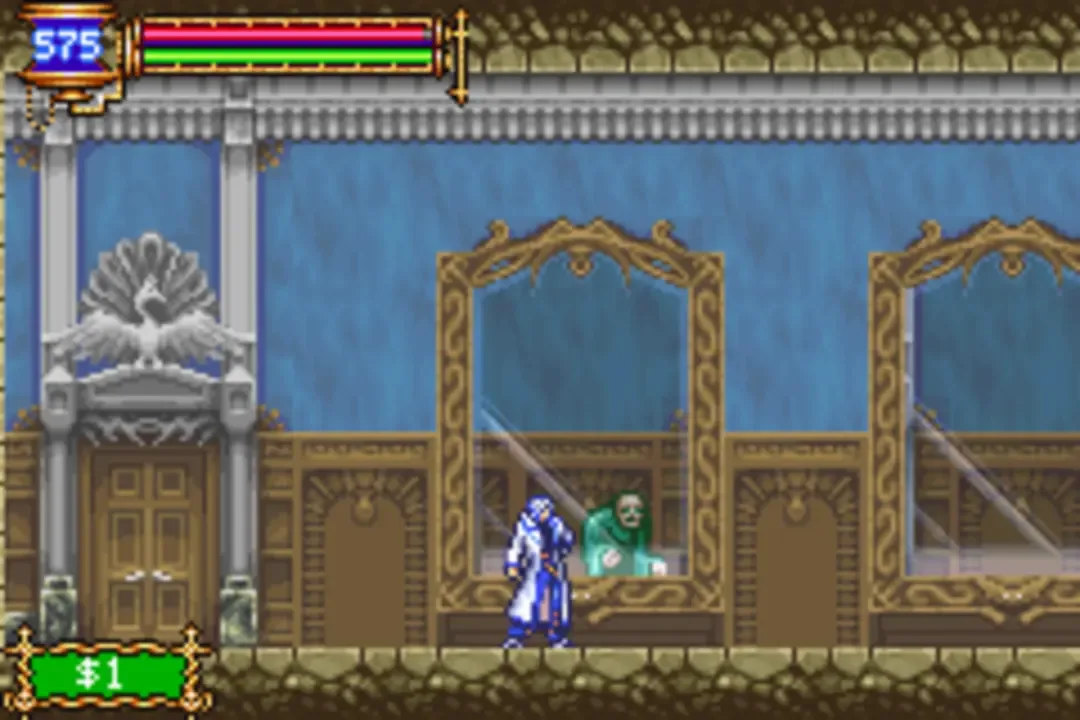
Soma is reflected by all the glasses in Dracula's castle, but sometimes his reflection is distorted: if you stop for a moment, it becomes a moster that attacks Soma
AoS is a great Metroidvania and a phenomenal game. It has some small flaws that make it not perfect and just a step under Symphony of the Night, but it remains one of the best Metroidvanias ever made and one of the must-play Castlevania games. I still believe that the combination Rondo + Symphony remains the best way to approach the series for a newcomer, but Aria is also a strong contender. Its only problem is that if it is played before the other GBA titles, it can make the other GBA Castlevanias a little bit lackluster and suck out some enjoyment.
FINAL SCORE: 9/10
-------------------------------------------------------------------------------------------------------------------------------------------------------------------------------------------------------------------------
I've beaten the third gym in X. The game is much better than I was expecting, and that's a huge plus. The new pokemon are good, even if I prefer the earlier generations. I'm forcing myself to keep at least three new pokemon in my team, and I'm building a pretty balanced team. The only downsides for now are the pacing and the difficulty. The pacing seems off, putting too much levels and time between the first and the second gym. The difficulty is also all over the place, sometimes some random trainers are harder than gym leaders. We'll see if these feelings will remain for the rest of the game.
I've played some levels of NSMB2, but not much.
Castlevania: Aria of Sorrow - GBA (Emulated)
Genre: Metroidvania
Developer/Year: Konami, 2003
SCORE: 9/10
INTRODUCTION
Before Aria of Sorrow (AoS), there were two Castlevania games on the GBA: Circle of the Moon and Harmony of Dissonance. The first was more similar gameplay-wise to the punishing classic games but had a lot of problems, while the second was more similar to Symphony of the Night but had a lackluster map, and it was definitely too easy. It took two games for Iga and his team to adjust the aim, but finally they hit the jackpot with AoS. Even if it falls a little short compared to Symphony of the Night, it remains one of the best Castlevania games, and my playthrough definitely confirmed that.

The first boss is big, simple but starts the game with the right foot
In AoS the player controls Soma Cruz, a student that is dragged with his girlfriend into Dracula's castle during an eclipse. Dracula was definitely killed in 1999, but dark forces are working to resurrect its dark power. Like all the other Castlevania games, the plot isn't anything to write home about, but at least Aria tries to spin the classic formula around like Harmony of Dissonance, removing Dracula as the main antagonist to build a plot around his resurrection. Even if there is not a lot of variety in terms of bosses and they are a little bit uninspired, the plot in the final sections of the game justifies some pretty cool fights.

The story is narrated through dialogue and some portaits, exquisitely drawn
SPOILERS FROM THE END OF THE GAME!
The fight against the last Belmont is phenomenal and almost cancels all the previous lackluster fights. Also the final fight against Chaos is original, even if it is so chaotic to be less fun compared to Belmont.
END OF THE SPOILERS
GAMEPLAY
AoS is a classic Metroidvania, with platformer gameplay linked to upgrades that improve the capacity of the main character to explore the map. It has also a RPG-like system with statistics modified by level-ups and equipment. First of all, the upgrades aren't bad and are definitely well placed, but they are definitely less fun compared to Symphony. I can't definitely place my finger on one thing exactly, but using them to explore in Symphony was definitely more rewarding. Also the map was definitely more inspired in Symphony, but it is a masterpiece difficult to replicate, and AoS retains a very high level nevertheless. Compared to the other games on the system, there is an abyss in the quality and fun of exploration and upgrades. The enemies are a lot and very inspired, and even if few are recycled by changing their palette, this exploit is limited and doesn't impact in the final quality of the game.

The bossess are uninspired, but at least the various arenas are very cool
The game uses a system of weapons equal to Symphony, equally well made. Maybe there is a little bit too much focus on swords, but the variety and the rate of acquisition are perfectly balanced to keep the situation varied. Since the flying enemies are particularly annoying, upward slashing swords are the most useful, but towards the end of the game, Soma has enough mobility to use effectively almost everything. The strongest weapon is well hidden in a secret area, not difficult to find if you know where to search but difficult to figure out otherwise. There are enough armors, even if they don't have particular modifiers that passively change the gameplay rules, and there are few accessories, but this isn't very important.
The classic sub-weapon system, after two games in which it was redundant and not very useful, was finally scrapped in favor of an almost completely new system. In this game Soma can collect the souls of the enemies that he kills in order to acquire new skills. The souls are divided by color: red skills are active skills that are used to deal damage, blue skills are active skills used defensively, and yellow skills are passive skills that are powerful but pretty scarce and difficult to acquire. The player can freely equip one skill per type and swap them in any situation through the menu. This system is perfect, since it encourages trying out different combinations without punishing the player for having equipped a sub-optimal combination. The only flaw, in my opinion, is that the souls are acquired randomly by killing the right enemies, with the probability controlled by the luck skill. Having to kill the same enemy multiple times to farm a soul is never fun, and even if it doesn't reach the ridiculous low probabilities of the card system of Circle of the Moon, it remains definitely a nuisance.

The souls menu is fast and intuitive, and shows immediately how the passive skills affect Soma's statistics
GRAPHICS, MUSIC AND FINAL CONSIDERATIONS
After two games, Konami's team finally nailed the graphics on the GBA. The first game had darker tones, fitting but difficult to see in the non-backlit screen of the first GBA. To compensate, Harmony had very bright, almost neon-like colors, definitely too vivid even if I personally dig the acid art style. Finally, Aria managed to nail down the right style, readable on the old screens but still balanced on more modern systems. Obviously if you emulate the game or you play it through the Collection, the palette doesn't change the experience on modern monitors, but it is important to keep the technology of the time in mind to understand the developer's choices and understand why Aria was a great accomplishment.Also Aria's music is great, they luckily fixed Harmony's low quality to create some great tunes, despite the obvious limitations of the GBA.

Soma is reflected by all the glasses in Dracula's castle, but sometimes his reflection is distorted: if you stop for a moment, it becomes a moster that attacks Soma
AoS is a great Metroidvania and a phenomenal game. It has some small flaws that make it not perfect and just a step under Symphony of the Night, but it remains one of the best Metroidvanias ever made and one of the must-play Castlevania games. I still believe that the combination Rondo + Symphony remains the best way to approach the series for a newcomer, but Aria is also a strong contender. Its only problem is that if it is played before the other GBA titles, it can make the other GBA Castlevanias a little bit lackluster and suck out some enjoyment.
FINAL SCORE: 9/10
-------------------------------------------------------------------------------------------------------------------------------------------------------------------------------------------------------------------------
CURRENTLY PLAYING
- Pokémon X - 3DS
- New Super Mario Bros 2 - 3DS
I've beaten the third gym in X. The game is much better than I was expecting, and that's a huge plus. The new pokemon are good, even if I prefer the earlier generations. I'm forcing myself to keep at least three new pokemon in my team, and I'm building a pretty balanced team. The only downsides for now are the pacing and the difficulty. The pacing seems off, putting too much levels and time between the first and the second gym. The difficulty is also all over the place, sometimes some random trainers are harder than gym leaders. We'll see if these feelings will remain for the rest of the game.
I've played some levels of NSMB2, but not much.
4 Yrs✓#
f_n_c
4 Yrs✓#
UPDATE #31
I've played three new arcade games, one beat 'em up and two driving games. The best thing about playing arcade games is that I can play everything grabs my attention and finishing it, since the time investment is always one hour or less. This time the games are a little more obscure and forgotten.
Super Sprint is a top-down racing game published in 1986 as an arcade game and ported to a plethora of systems and home computers. In the game you control a car, and you race against other cars in a circuit. What makes this game special is the control scheme: one button to accelerate and the arrows (or the wheel of the arcade game) to turn. You need to carefully control the gas to smoothly pass the various corners of the track without bouncing against the wall. It is not a difficult game, but completing a race without bumping against a wall is not easy and creates a comic effect when played with other people.
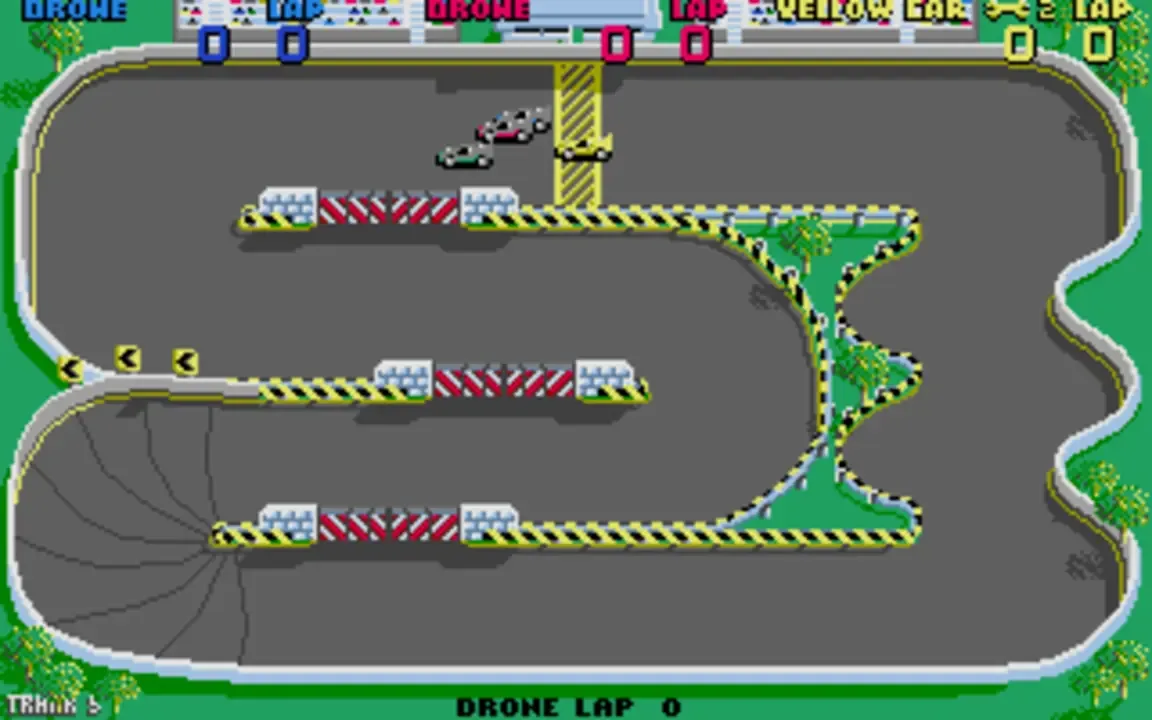
Some tracks have also shortcuts and moving parts
The game is all here. Complete the races in first place to play without pumping additional credits, and play on all the tracks until you start again from the first. Once in a while after different races you're offered an upgrade for your car that simply enhances speed, handling, or acceleration. Some tracks also have jumps, shortcuts that open and close rhythmically, and bridges that destroy your car if you fall off. Today can be seen as simplistic and derivative in an era where we have mobile games much more complex than this. But this game is simple, raw fun, probably better if played with friends. I found it relaxing and entertaining for a small amount of time. Definitely suggested, it is the perfect game when a very short time is available to play.
FINAL SCORE: 7.5/10
This game is a huge disappointment. TMNT: Turtles in Time is a very famous beat 'em up in which you control the titular turtles. After some levels, Shredder sends the turtles back in time, and the rest of the game is spent traversing various eras to return to the present and beat Shredder. The plot is nothing to speak about, but at least it gives an excuse to present a wide array of different environments. The design of the various levels is definitely the main selling point of the game, paired with the colorful graphics. The environments are very different and add some small gameplay details, and while the enemies are always the same, they enter the stage with different methods, which is always fun and comic to watch.
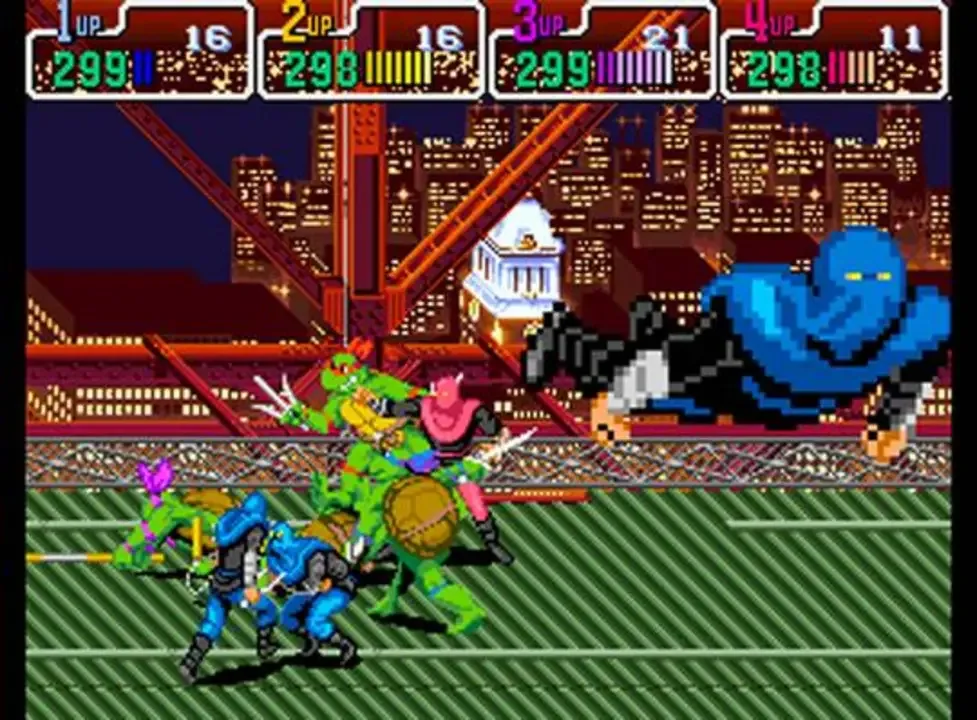
Sometimes the turtles will throw enemies against the screen with a comic-like effect
Sadly the graphics, together with the good music, are the only positive aspects of the game. The gameplay is a classic for the beat 'em up genre, without a lot of options. The only highlight is the opportunity to throw the enemies "against the screen," like is shown in the picture at the top. Sadly, you never feel fully in control of the turtle you've selected: throws are executed randomly in a combo, and often the situation seems to slip from your fingers. Pair this with a brutal, unfair difficulty, and you have a perfect coin-eater ready to suck in the kids' quarters. Sadly, today the difficulty feels cheap and doesn't add anything to the experience. The controls also feel very floaty, and punching the enemies isn't as satisfying as it should have been. The bosses also don't feel very inspired, and I felt that the game had overstayed its welcome.
At least the level in the future has a top-notch presentation, and I understand why it is regarded as a classic. But it feels very badly aged.
FINAL SCORE: 6.5/10
More than 50 years ago a race was held in Italy every year, called the 1000 Miglia. In this race, the drivers (often paired with a navigator) will race across Italy on plains, hills, and the Apennines to make a circle between Brescia and Rome. The race was very dangerous and was cancelled after some serious crashes (you can see one represented in the movie Ferrari), but it remained in the hearts of racing fans and inspired also this game. Mille Miglia 2 is a racing game in which you control a car, and you need to finish the various stages across Italy in time to continue without spending credits. There are also other racers, but to pass, you need only to arrive before the clock runs out. The other drivers are more of a nuisance and give only more points if overtaken and a little static image with a historical photo if you win the stage. This game is pretty obscure, and it is easy to understand why it was forgotten in the sea of arcade games. Regardless of that, it is a solid game that is worthy to be played and finished at least one time.
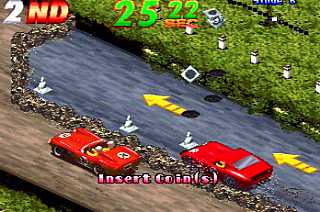
It was difficult to find gameplay screenshots of this game.
After selecting a car from a good variety of licensed vehicles, impressing for the time, you select a stage and you start to race. The stages cover from the start to the finish of this iconic race, showing fast but colorful and realistic urban and natural environments. Racing is simple, and you just need to find the right strategy to play with the accelerator to drift in the various corners. The car physics is not very intuitive at first, but after some races it's easy to understand it. The later stages are pretty challenging, and it's difficult to finish before the time limit without a good execution. The historical photos scattered as prizes for winning and other small details show that the team really liked the original source materials and tried to pay homage to them with this game. The music is forgettable, but the races have a fun speaker that comments on the start and some bits of the race with a nasal voice. Definitely the most surprising game of all the arcade games tried, fun and fast with a good difficulty curve.
FINAL SCORE: 7.5/10
-------------------------------------------------------------------------------------------------------------------------------------------------------------------------------------------------------------------------
My team is now complete and fully evolved in Pokémon X, and I'm approaching the last gym. The event chain that leads to the capture of the cover legendary pokemon is maybe the first disappointing thing in this game. Is too fast, the main villain has such random motivations compared to N and everything feels rushed. Luckily Kalos is such a great region to play in.
No progress on NSMB2.
Arcade Paradise is great. Everything is made in a way that is always fun, from collecting the trash to playing the fictional games. A real game that puts the game part in videogames on the spot, it's a game that maybe you forget two seconds after it's finished but is just a joy to play.
I've played three new arcade games, one beat 'em up and two driving games. The best thing about playing arcade games is that I can play everything grabs my attention and finishing it, since the time investment is always one hour or less. This time the games are a little more obscure and forgotten.
Super Sprint - Arcade (Emulated)
Genre: Racing
Developer/Year: Atari Games, 1986
SCORE: 7.5/10
Super Sprint is a top-down racing game published in 1986 as an arcade game and ported to a plethora of systems and home computers. In the game you control a car, and you race against other cars in a circuit. What makes this game special is the control scheme: one button to accelerate and the arrows (or the wheel of the arcade game) to turn. You need to carefully control the gas to smoothly pass the various corners of the track without bouncing against the wall. It is not a difficult game, but completing a race without bumping against a wall is not easy and creates a comic effect when played with other people.

Some tracks have also shortcuts and moving parts
The game is all here. Complete the races in first place to play without pumping additional credits, and play on all the tracks until you start again from the first. Once in a while after different races you're offered an upgrade for your car that simply enhances speed, handling, or acceleration. Some tracks also have jumps, shortcuts that open and close rhythmically, and bridges that destroy your car if you fall off. Today can be seen as simplistic and derivative in an era where we have mobile games much more complex than this. But this game is simple, raw fun, probably better if played with friends. I found it relaxing and entertaining for a small amount of time. Definitely suggested, it is the perfect game when a very short time is available to play.
FINAL SCORE: 7.5/10
Teenage Mutant Ninja Turtles: Turtles in Time - Arcade (Emulated)
Genre: Beat 'em Up
Developer/Year: Konami, 1991
SCORE: 7/10
This game is a huge disappointment. TMNT: Turtles in Time is a very famous beat 'em up in which you control the titular turtles. After some levels, Shredder sends the turtles back in time, and the rest of the game is spent traversing various eras to return to the present and beat Shredder. The plot is nothing to speak about, but at least it gives an excuse to present a wide array of different environments. The design of the various levels is definitely the main selling point of the game, paired with the colorful graphics. The environments are very different and add some small gameplay details, and while the enemies are always the same, they enter the stage with different methods, which is always fun and comic to watch.

Sometimes the turtles will throw enemies against the screen with a comic-like effect
Sadly the graphics, together with the good music, are the only positive aspects of the game. The gameplay is a classic for the beat 'em up genre, without a lot of options. The only highlight is the opportunity to throw the enemies "against the screen," like is shown in the picture at the top. Sadly, you never feel fully in control of the turtle you've selected: throws are executed randomly in a combo, and often the situation seems to slip from your fingers. Pair this with a brutal, unfair difficulty, and you have a perfect coin-eater ready to suck in the kids' quarters. Sadly, today the difficulty feels cheap and doesn't add anything to the experience. The controls also feel very floaty, and punching the enemies isn't as satisfying as it should have been. The bosses also don't feel very inspired, and I felt that the game had overstayed its welcome.
At least the level in the future has a top-notch presentation, and I understand why it is regarded as a classic. But it feels very badly aged.
FINAL SCORE: 6.5/10
Mille Miglia 2: The Great 1000 Miles Rally - Arcade (Emulated)
Genre: Racing
Developer/Year: Kaneko, 1994
SCORE: 7.5/10
More than 50 years ago a race was held in Italy every year, called the 1000 Miglia. In this race, the drivers (often paired with a navigator) will race across Italy on plains, hills, and the Apennines to make a circle between Brescia and Rome. The race was very dangerous and was cancelled after some serious crashes (you can see one represented in the movie Ferrari), but it remained in the hearts of racing fans and inspired also this game. Mille Miglia 2 is a racing game in which you control a car, and you need to finish the various stages across Italy in time to continue without spending credits. There are also other racers, but to pass, you need only to arrive before the clock runs out. The other drivers are more of a nuisance and give only more points if overtaken and a little static image with a historical photo if you win the stage. This game is pretty obscure, and it is easy to understand why it was forgotten in the sea of arcade games. Regardless of that, it is a solid game that is worthy to be played and finished at least one time.

It was difficult to find gameplay screenshots of this game.
After selecting a car from a good variety of licensed vehicles, impressing for the time, you select a stage and you start to race. The stages cover from the start to the finish of this iconic race, showing fast but colorful and realistic urban and natural environments. Racing is simple, and you just need to find the right strategy to play with the accelerator to drift in the various corners. The car physics is not very intuitive at first, but after some races it's easy to understand it. The later stages are pretty challenging, and it's difficult to finish before the time limit without a good execution. The historical photos scattered as prizes for winning and other small details show that the team really liked the original source materials and tried to pay homage to them with this game. The music is forgettable, but the races have a fun speaker that comments on the start and some bits of the race with a nasal voice. Definitely the most surprising game of all the arcade games tried, fun and fast with a good difficulty curve.
FINAL SCORE: 7.5/10
-------------------------------------------------------------------------------------------------------------------------------------------------------------------------------------------------------------------------
CURRENTLY PLAYING
- Pokémon X - 3DS
- New Super Mario Bros 2 - 3DS
- Arcade Paradise - Amazon Luna
My team is now complete and fully evolved in Pokémon X, and I'm approaching the last gym. The event chain that leads to the capture of the cover legendary pokemon is maybe the first disappointing thing in this game. Is too fast, the main villain has such random motivations compared to N and everything feels rushed. Luckily Kalos is such a great region to play in.
No progress on NSMB2.
Arcade Paradise is great. Everything is made in a way that is always fun, from collecting the trash to playing the fictional games. A real game that puts the game part in videogames on the spot, it's a game that maybe you forget two seconds after it's finished but is just a joy to play.
